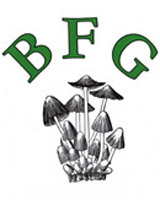Members’ Finds, Jan to June 2022
Following the success and popularity of our experimental Members' Finds project introduced in 2020 and continued through 2021, here is our new page for Jan to June 2022 to which members are again invited to contribute. We are starting afresh with a new species list, so please email Penny photos of anything you find - even of species already on previous lists. Try to illustrate all aspects of the fruit body, also remember not to reduce the photo size and to include the date, site, substrate, habitat plus any other useful features such as size, smell, etc. All extra clues are vital when identifying solely from photos. Ideally, try to collect at least one specimen and retain in a pot until you've heard back from Penny in case it might be needed for further investigation - records of rarities are of no use without voucher material as we have discovered to our cost previously.
HAPPY HUNTING!
•  Only entries marked with this symbol have been microscopically examined. There is no guarantee on identifications made of entries lacking this symbol though all photos are checked and selected by Penny to the best of her ability. Basic accompanying notes are also Penny's.
Only entries marked with this symbol have been microscopically examined. There is no guarantee on identifications made of entries lacking this symbol though all photos are checked and selected by Penny to the best of her ability. Basic accompanying notes are also Penny's.
•  Entries marked with this symbol have been confirmed or identified using DNA sequencing.
Entries marked with this symbol have been confirmed or identified using DNA sequencing.
A regularly updated list of entries is provided in a choice of Latin binomial or English common names to facilitate the location of a particular species. There is also now a Masterlist available to facilitate previous locations of a particular species within the Finds pages.
Click on thumbnail to see full size
For the complete and regularly updated list of entries click Latin or English
For the LATIN MASTERLIST of Members' Finds since its inception click Masterlist.pdf Masterlist.xls
Contributors / Photographers: Allan, Paul; Catterson, John; Cullington, Penny; Dodd, Andrew; Dodsworth, Joanna; Ebdon, Sarah; Ewan, Jackie; Fletcher, Neil; Launder, Jesper; Jones, Mick; Ness, Russell; Pitwell, Ann; Schafer, Derek; Seward, Linda; Simpson, Bob; Soler, Claudi; Townsend, Phil; Webb, Barry; Williams, Claire; Wills, Jim.
Entries with a green background indicate rare sightings 18 |
Entries with a yellow background indicate species new to Buckinghamshire 13
|
Entries with a blue background indicate species new to UK 0
|
June 29th 2022
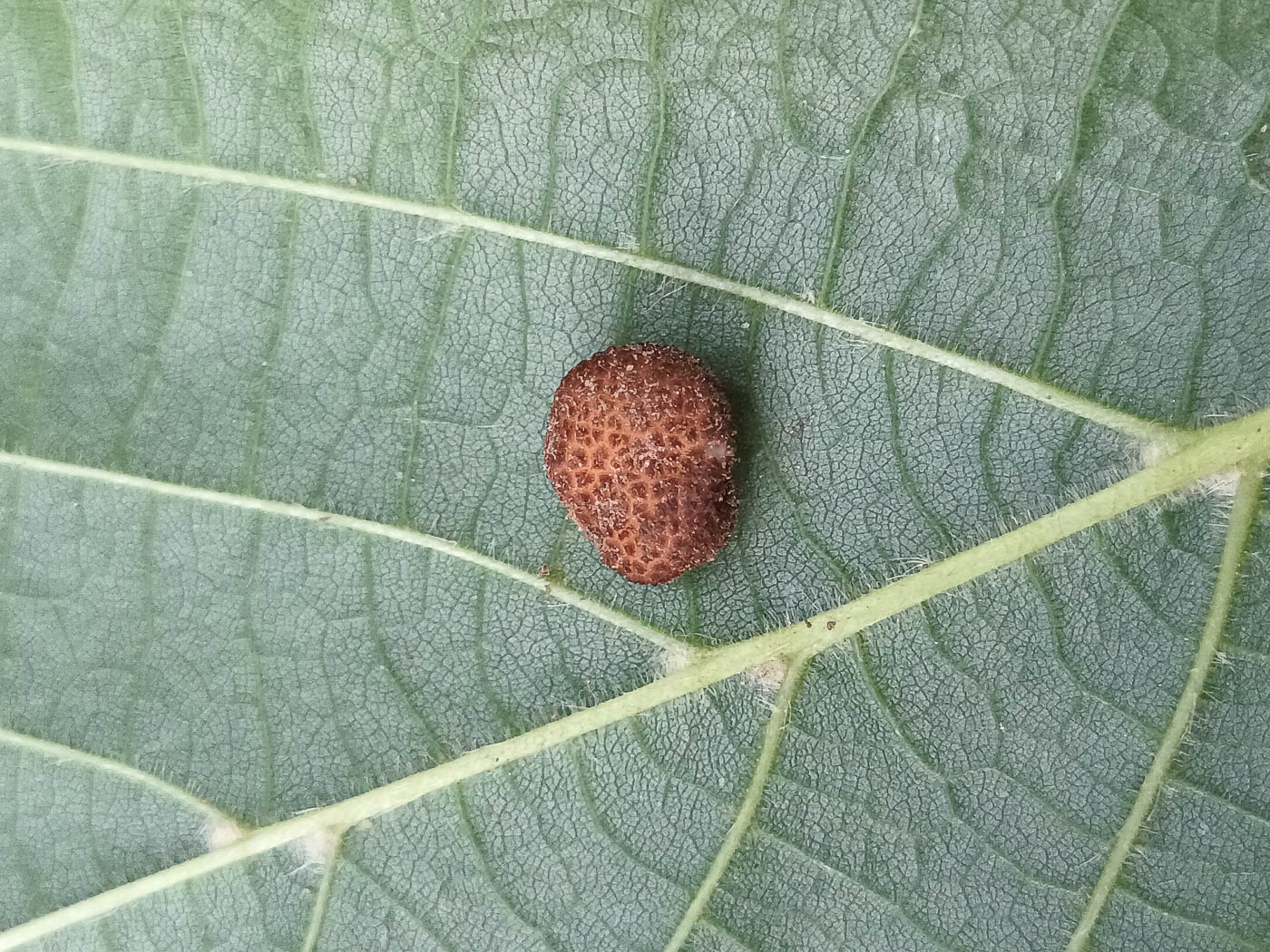 |
June 29th Balsamia platyspora (A truffle species with no common name) 
In his Jordans garden Jesper Launder found this small and distinctive truffle under the same Lime tree where he found it last July. (See in Finds 2021 July 9th). His find last year was only the second county record for the species though it's probably not that rare but most mycologists (Penny included) don't think to look for truffle species nor are very sure how to go about doing so. Balsamia is one of the Ascomycete truffle genera though others belong with the Basidiomycetes.
|
June 25th 2022
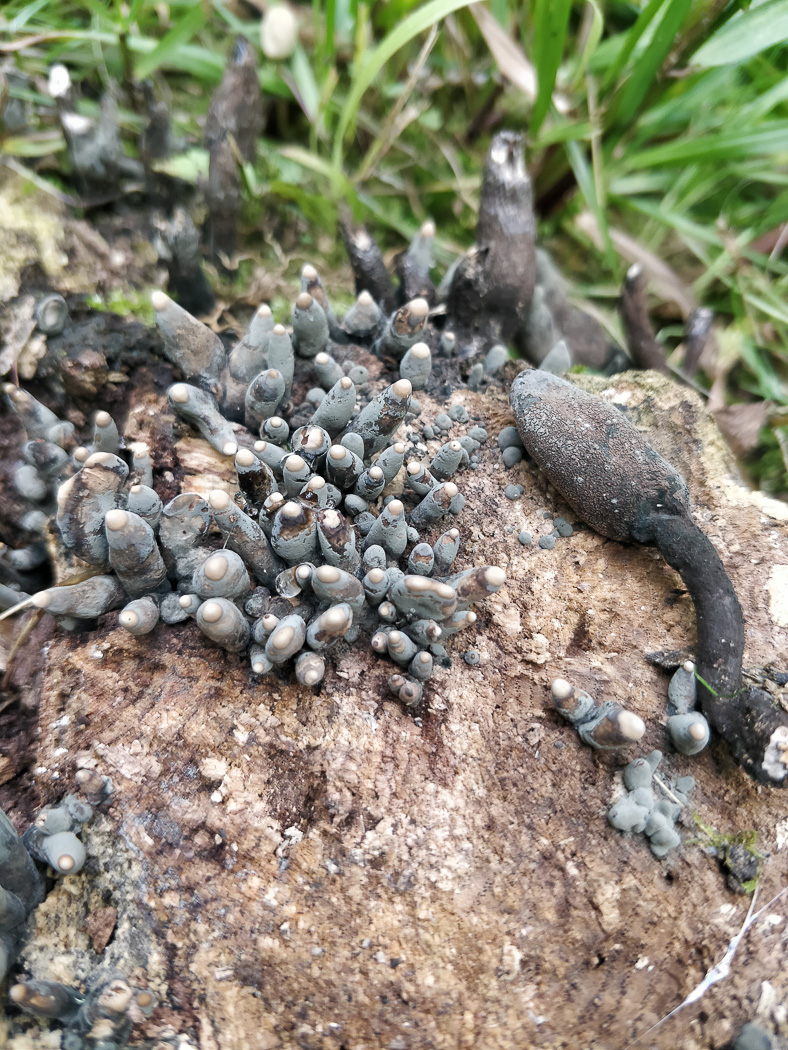 |
June 25th Xylaria polymorpha / longipes (Dead Man's / Moll's Fingers)
In Salden Wood Bob Simpson noticed this immature cluster of fruitbodies growing on a deciduous stump. It is often difficult to split these two very similar Pyrenomycete Asco species which can look extremely similar, the only safe way being a comparison of their spore sizes: those of the commoner X. polymorpha being much larger. However, in immature collections such as this it is likely that the spores will not be sufficiently developed to help!
|
June 24th 2022
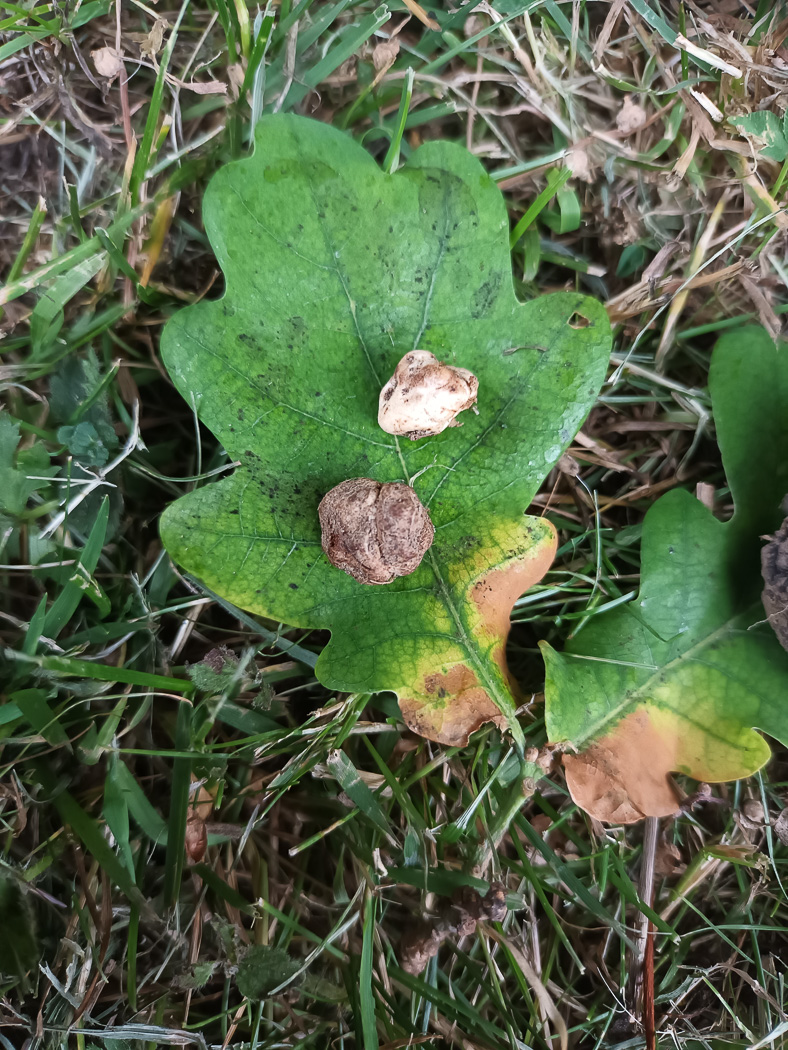 |
June 24th Russula cerea (a very rare truffle with no common name) 
In Jordans village Jesper Launder knows of an Oak which regularly produces Summer Truffles (see entry below) but on his visit today he also found this real rarity, located in bare soil amongst the grass by the strong fruity aroma he detected. The hypogeous (underground) genus Gymnomyces, which included this species, has now been transferred - rather surprisingly - to Russula, the evidence for this being DNA based backed up by its spores which are identical to those found in Russula: not only typically covered in warts or spines but also strongly amyloid (turning black in the reagent Melzers - Iodine based). When Jesper sent her his photos, Carol Hobart (hypogeous fungi expert) said she has yet to find this species in Britain, and there are very few UK records. This was an exciting find and the identification has now been confirmed with sequencing.
|
 |
June 24th Tuber aestivum (Summer Truffle) 
Under Oak in Jordans village Jesper Launder found this species by searching in the numerous holes underneath it. Three specimens were found though only one was in good nick (the larger fruitbody seen here). The species is probably much more common in the area than we realise - we just don't know where or how to find it! (See above for the identity of the smaller truffles seen here.)
|
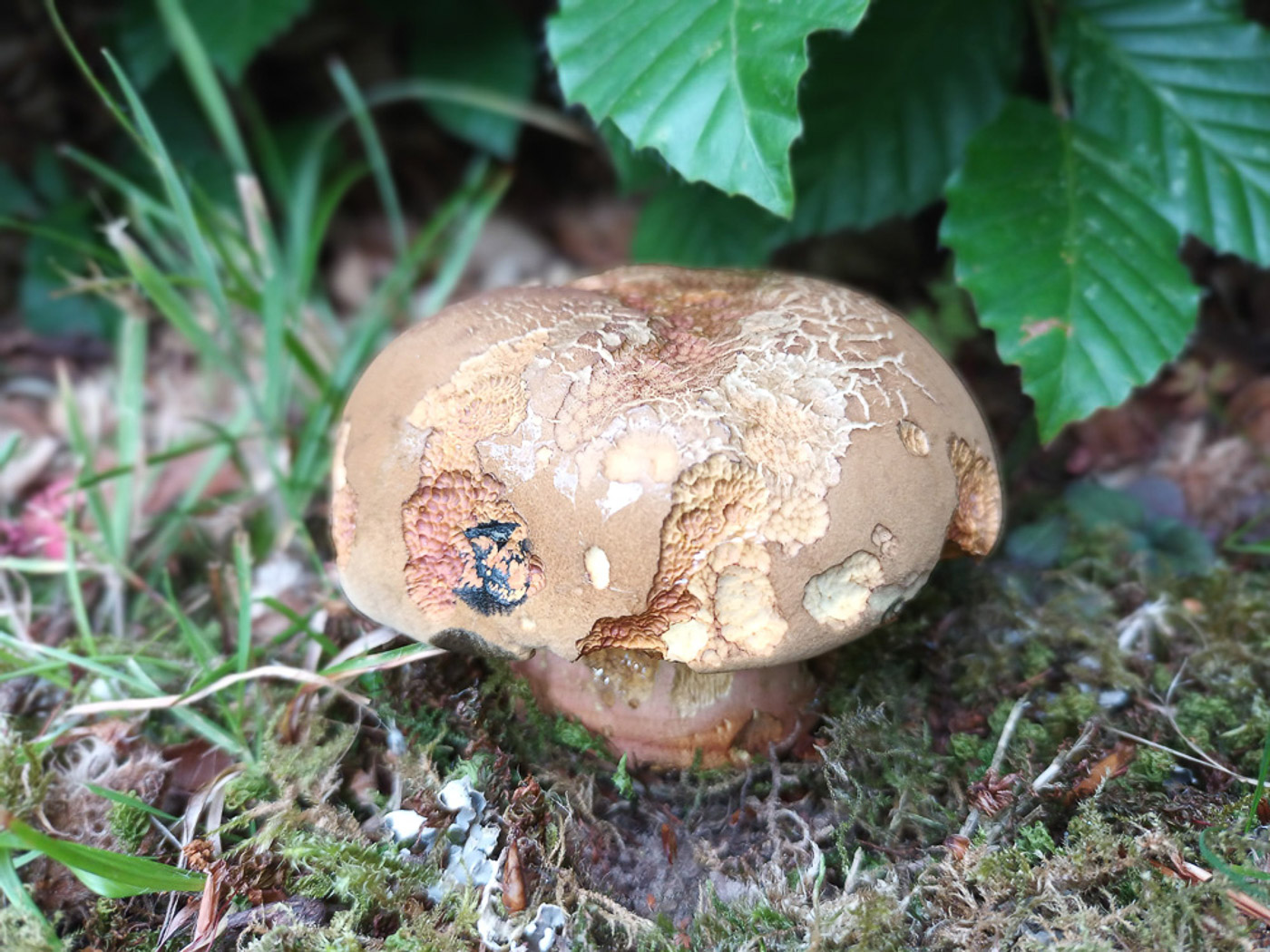
 |
June 24th Neoboletus xanthopus (False Yellow Bolete?) 
In Jordans village under Oak and Beech Jesper Launder found this very rare Bolete - new to the county and only recently confirmed as British. He's been finding it in this spot for several years and pondering over its identity which, however, has now been confirmed by Geoffrey Kibby and other European experts. This species, first described in 2014, is a sister species and very similar to the common Neoboletus luridiformis - previously B. erythropus and known to be a species complex, and is possibly the same as what was known as B. erythropus var. discolor (hence the ? after it's common English name above). It shares the strongly blueing flesh and red pores with its commoner sister species but has a paler yellowish stem which lacks the distinct reticulation, also the pores tend to turn yellow at the cap edge. The collection will be sequenced and is an important find though possibly may be less rare than thought due to it being easily mistaken for N. luridiformis.
|
June 22nd 2022
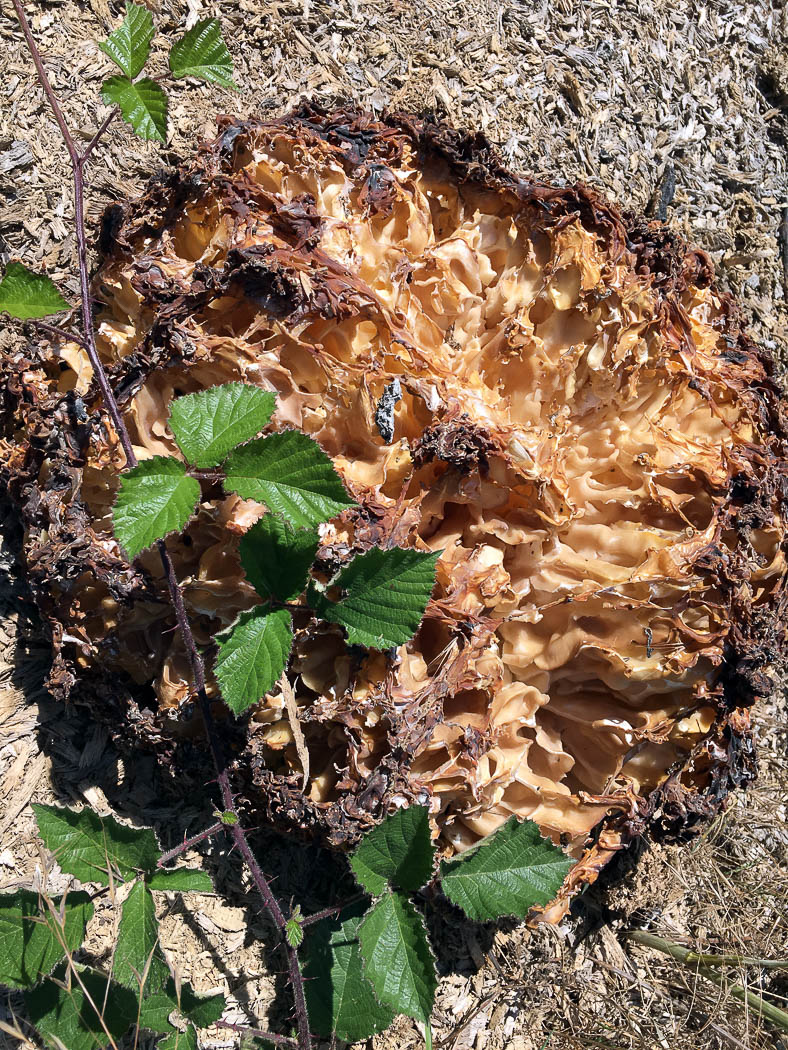 |
June 22nd Daleomyces phillipsii (Bonfire Cauliflower) 
At Wotton Park Estate Joanna Dodsworth spotted what she assumed had to be Sparassis crispa (Cauliflower Fungus) on a woodchip pile under Oak. She knew that the species occurs at the base of conifers but felt it just had to be that from its very distinctive appearance. Her photo, when sent to Penny and Derek, aroused suspicions that it was more likely to be S. brevipes - rare but occurring with deciduous trees, especially Oak. So we asked for samples to check and to have sequenced. However, when Derek checked a sample with a scope he was amazed to find not basidia but asci, i.e. this was an ascomycete and not related to Sparassis at all! In fact a drop of Melzers on the slide turned the asci tips bright blue - a sure sign that this was a species of Peziza, unlikely though it may seem. So this amazing Cauliflower lookalike is what was previously known as Peziza proteana var. sparassoides, though now with the new name given above. It is considered rare and normally appears on old bonfire sites in late Autumn or Winter, so a sample will be sequenced to confirm its identity as this interesting find is in mid-summer and on woodchip! We have just two previous county records (under its previous name): one in Jan 2001 and one in Nov 1978.
|
June 20th 2022
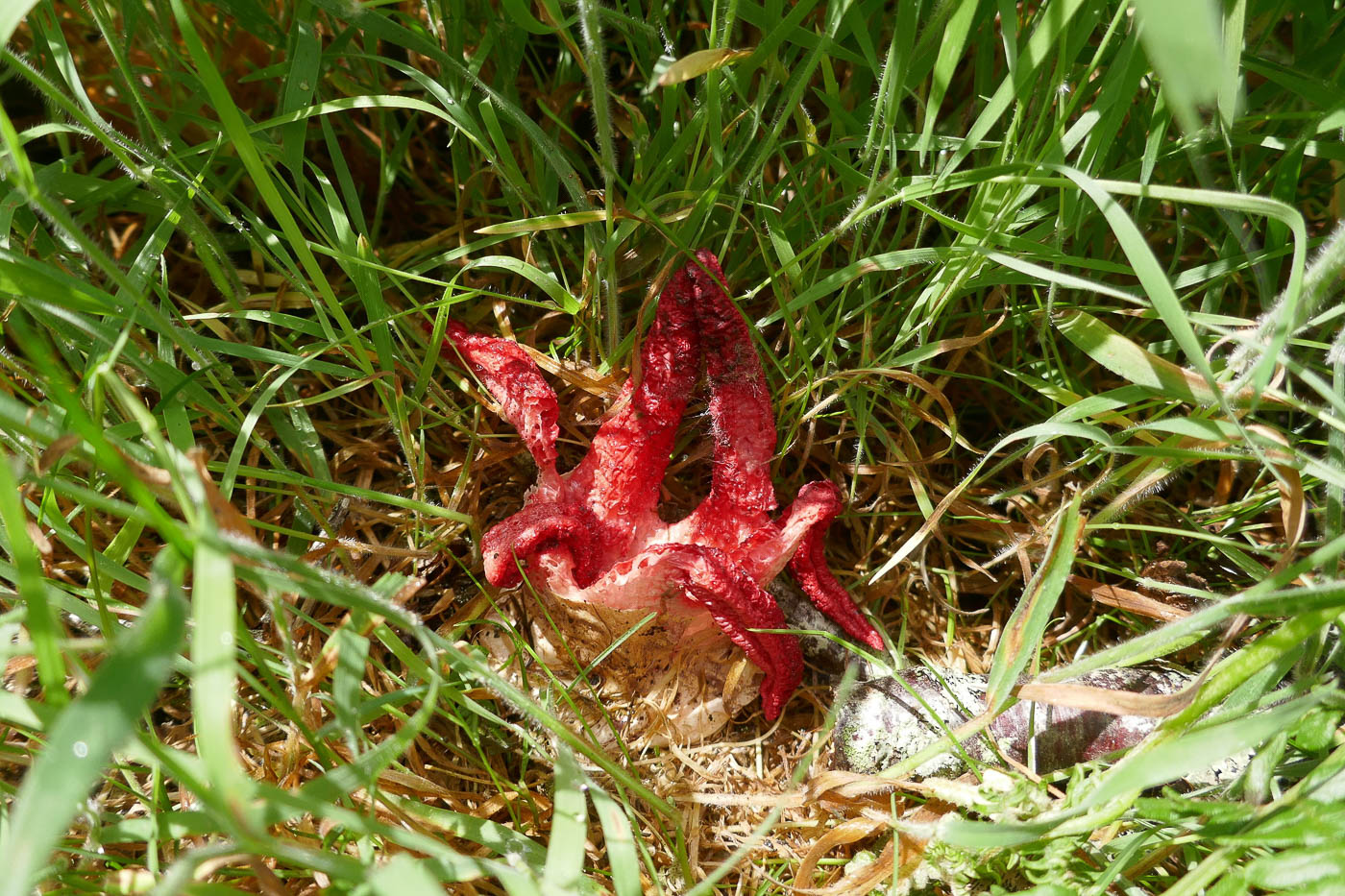 |
June 20th Clathrus archeri (Devil's Fingers)
This bizarre and unmistakable species is already making an appearance at Stampwell Farm, sent in by Jackie Ewan (though past its best when she discovered it). It was under bracken in the sheep paddock where she first found it here back in October 2020. This is our earliest record though it was new to the county when found in Naphill in 2020: see Finds 2020 Oct 2nd. See also last year's photos in Finds 2021 July 1st and Oct 21st.
|
 |
June 20th Bolbitius titubans (Yellow Fieldcap)
Though we have several images of the species, this one received by Penny today from Bob Simpson is worth including. Found on a woodchip pile in Salden Wood (and identified as B. titubans by Bob though with some doubts) it is not only surprisingly substantial but also has rather a 'woolly' stem - both characters not often seen in the species. Both Penny and Derek are happy that it is correct, however, noting that its size tends to depend upon substrate and conditions. Derek's comment: 'This species always amazes when conditions are right, producing larger than usual fruitbodies with more pruinose/floccose stipes.' See earlier examples on May 16th and June 13th, also two from Finds 2020 and two from 2021.
|
June 14th 2022

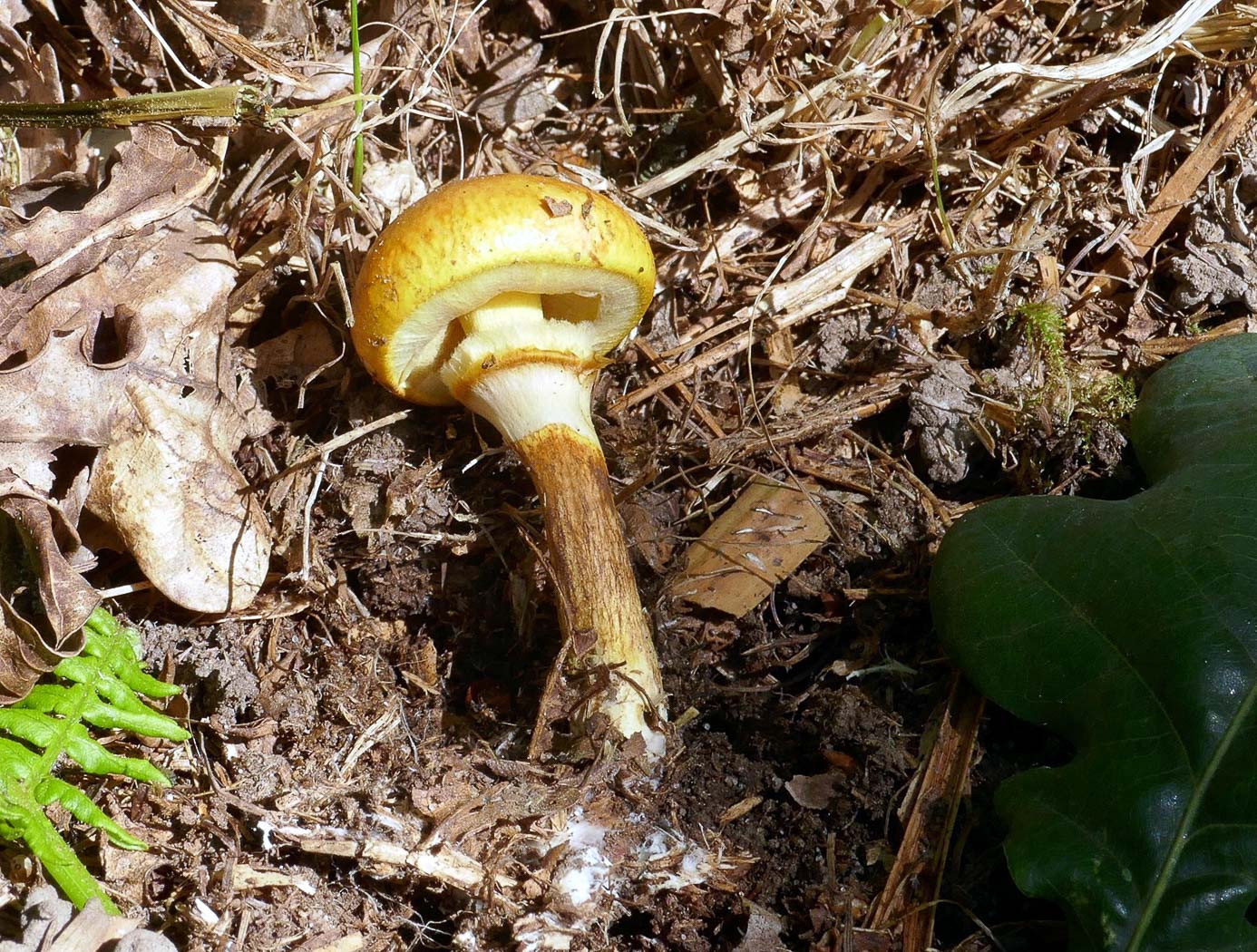 |
June 14th Suillus grevillei (Larch Bolete) 
Here we have another early sighting - our second Bolete and the first Bucks record for June for the species though we have two others for July. It was found by Jackie Ewan at Stampwell Farm under Bracken and Oak but with Larch not far away. (A good lesson here: the host tree to any mycorrhizal species is not always the nearest tree!) See also Finds 2020 September 7th and 16th.
|
June 13th 2022
 |
June 13th Tubifera ferruginosa (Raspberry Slime Mould)
On Naphill Common Claire Williams spotted this splodge of pink mess on a rotting log (presumed to be conifer) and tested for sliminess with her finger, recognising what it was. This species surely has to be one of the brightest coloured when at this plasmodium stage - often much more vivid darker pink / orange than this example - but soon dries off and becomes quite boring inconspicuous brown. If you spot an orange / pink patch on Beech, not conifer, you may have Dictydiaethalium plumbeum! See both species in Barry's separate page on Finds.
|

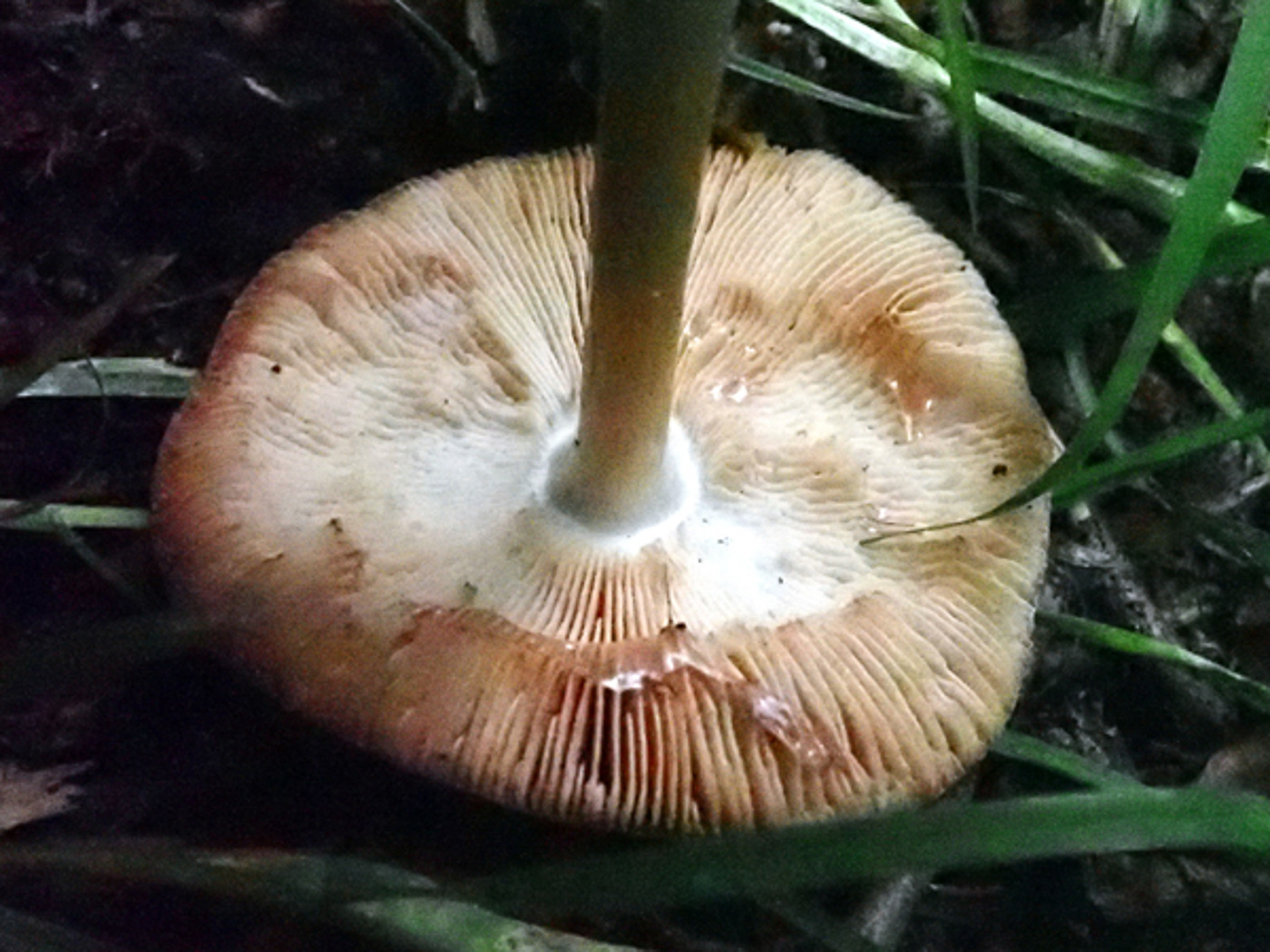
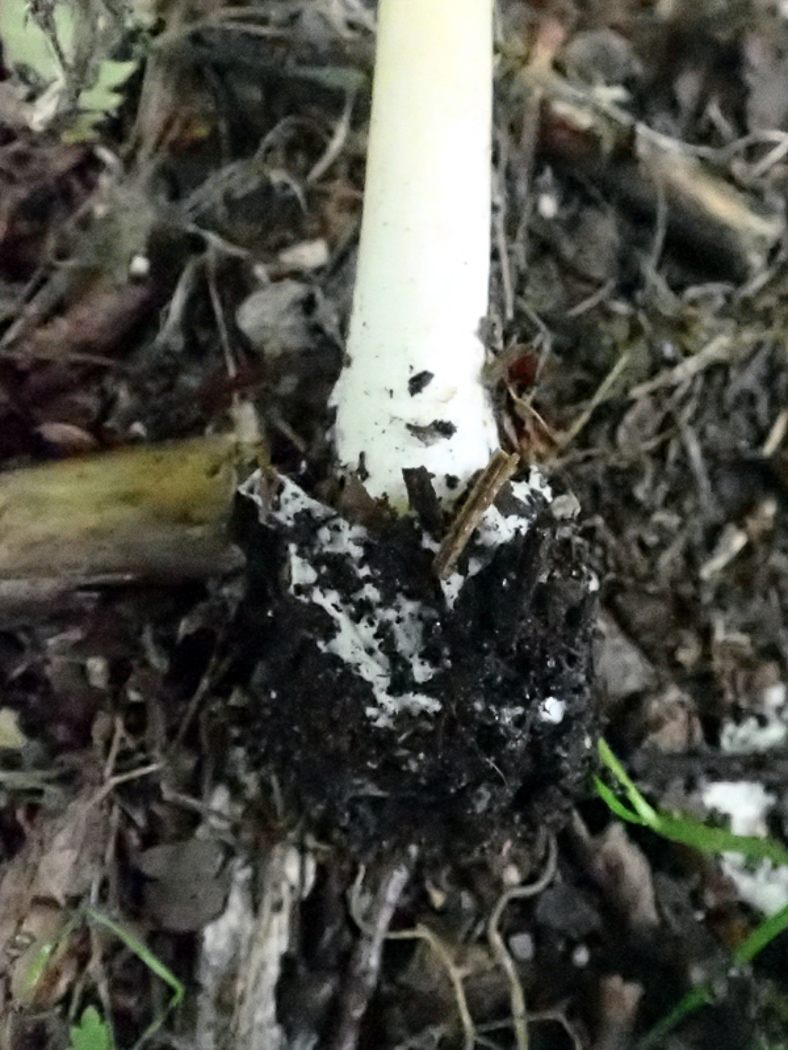 |
June 13th Volvopluteus gloiocephalus (Stubble Rosegill) 
In a grassy roadside only inches from the road at Turville Heath Penny was surprised to find this agaric which was about 6 cm across, the identity of which completed fooled her to start with. From above it appeared similar to maybe a Melanoleuca or even a Grisette Amanita, but on turning it over she then thought it must be a Pluteus, having pink crowded gills which were clearly free (photo 2). It was not until she noticed the rather muddy volva at the stem base (photo 3) that all was revealed. The species was previously in Volvariella but its new genus name is apt - like a Pluteus but with a volva. It also has considerably larger spores (checked today) which separates it from other members of Volvariella. It can sometimes be seen in hundreds in fields cleared of cereal crops - hence its common name, but also occurs quite commonly in grassy areas throughout summer and autumn. We have a couple of other June records for the county. See also in Finds 2020 Nov 2nd.
|
 |
June 13th Panaeolus papilionaceus (Petticoat Mottlegill)
On a small bare patch of manured soil at Turville Heath these attractive little LBJs were found by Penny. Their substrate together with the frilly cap edge from veil remnants and mottled dark gill having a white edge were enough to make the identification in the field. This is a common species wherever dung has been. See also finds 2021 July 13th.
|
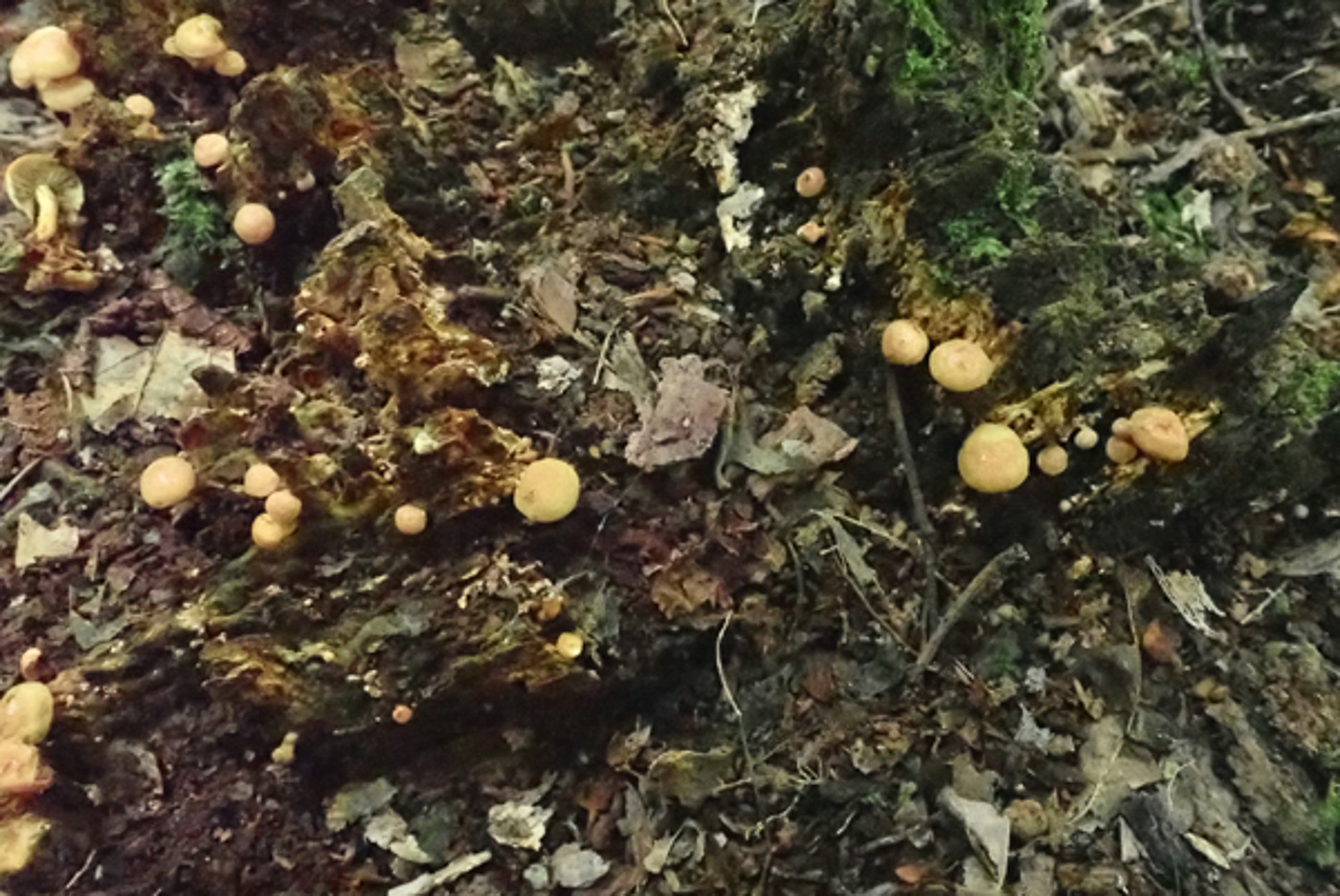
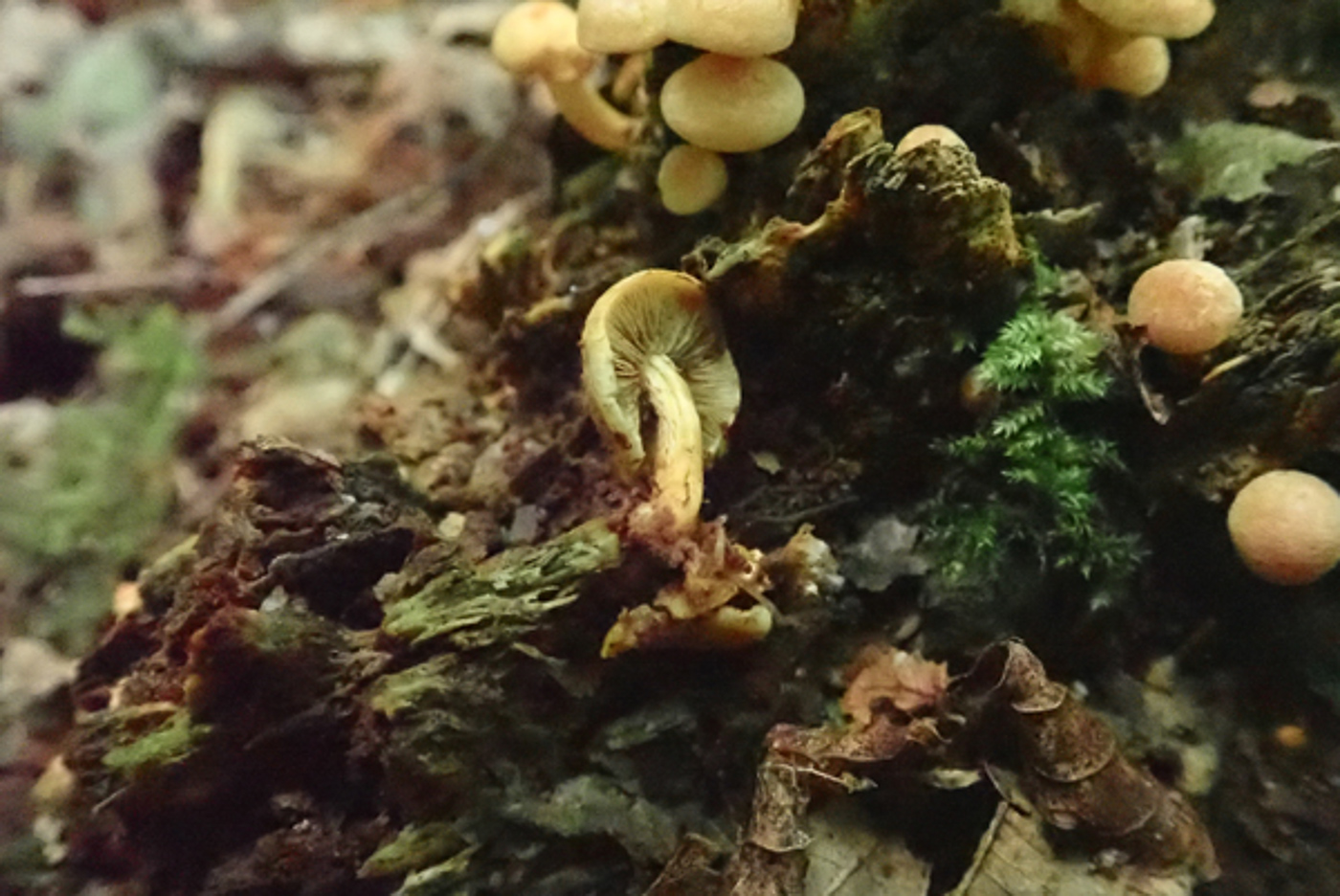 |
June 13th Hypholoma fasciculare (Sulphur Tuft) 
On an old deciduous stump at Turville Heath Penny caught her eye in these tiny buttons just emerging, thought they were likely to be this species though with the largest caps well under 1cm across she could not be certain. However, all the microscopic features confirmed it. It's not that unusual to find clusters of this common species popping up at any time of year when conditions are suitable, and we have one for Finds 2021 June 21st, also one for this year Jan 13th as well as several autumn collections.
|
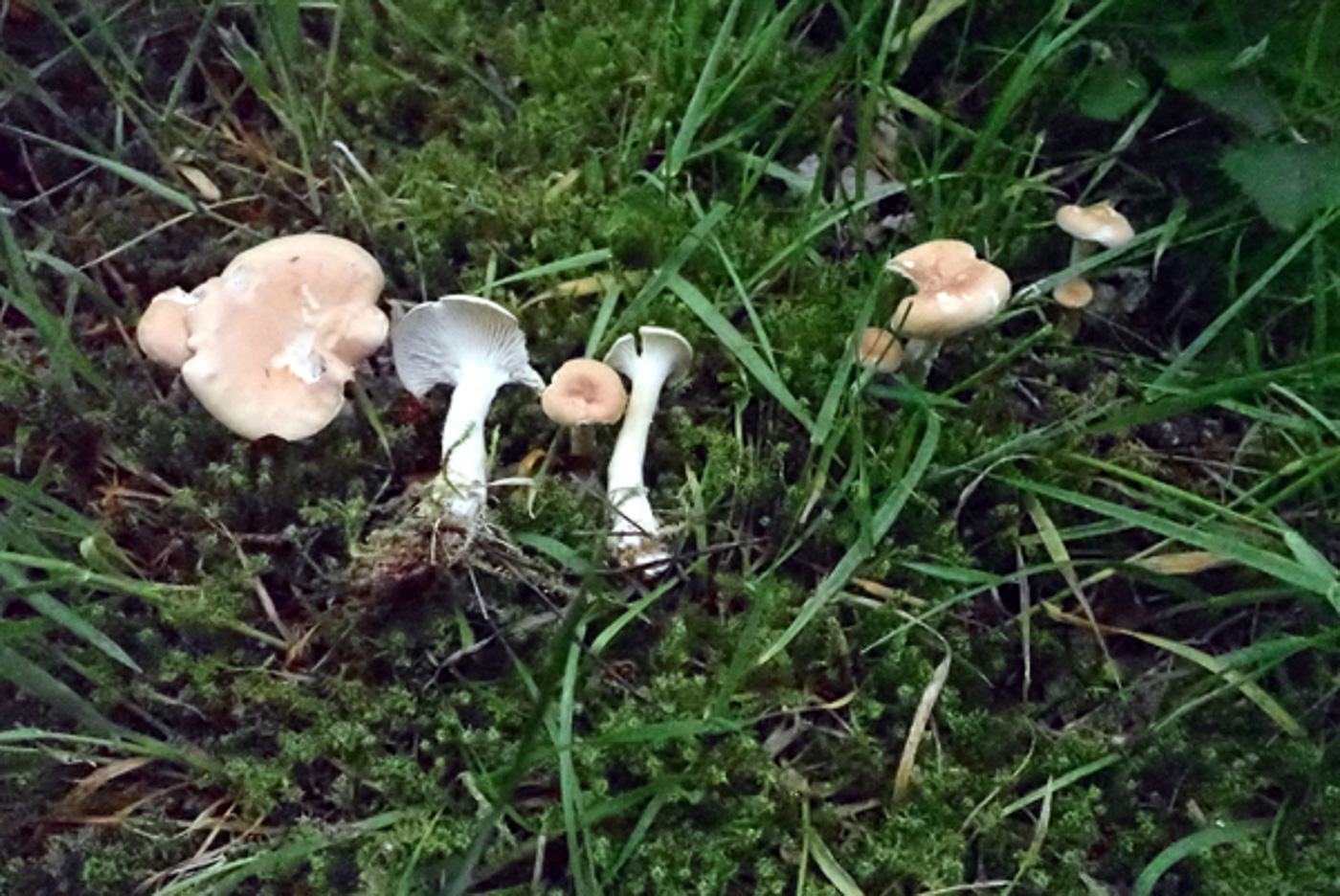
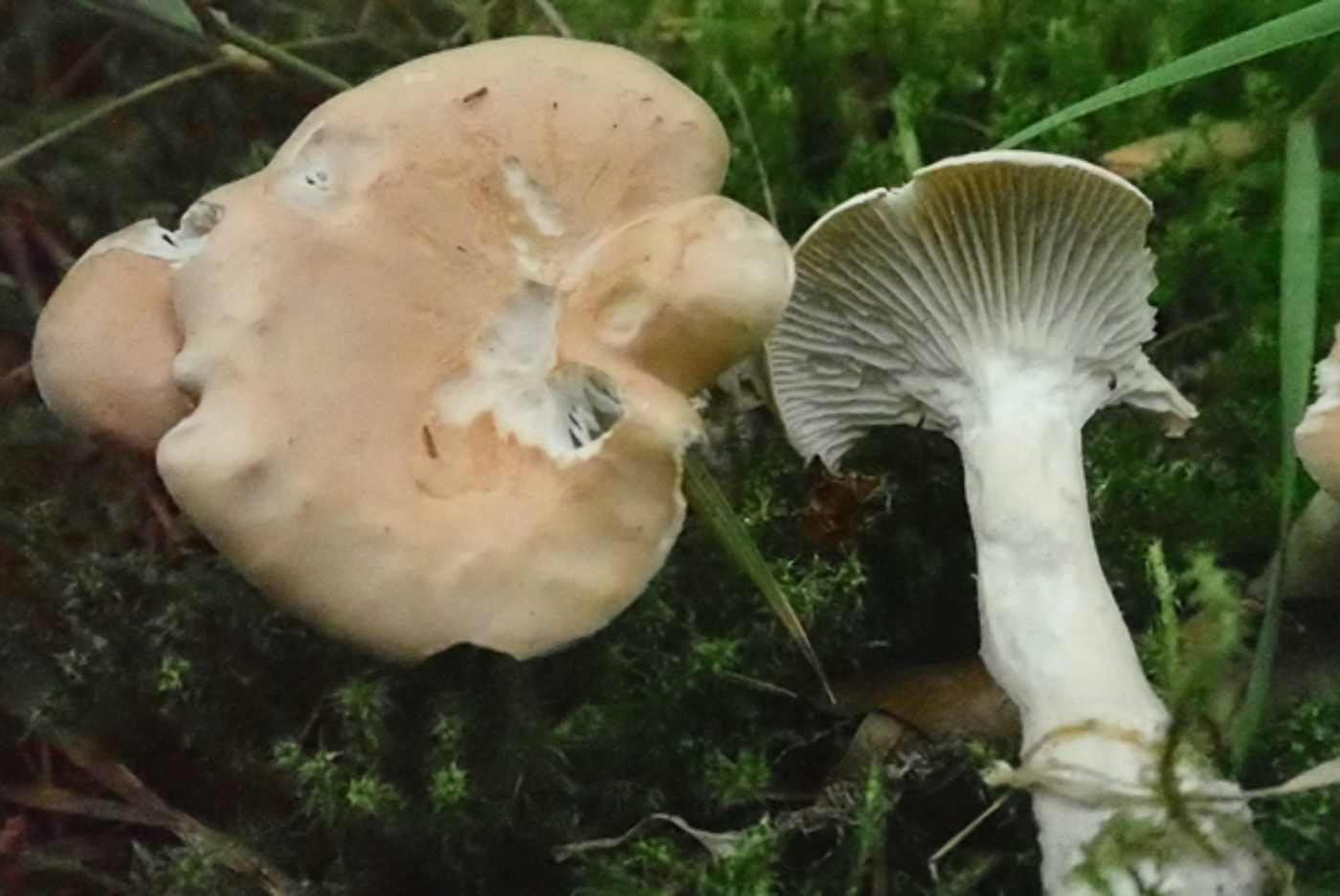 |
June 13th Infundibulicybe gibba (Common Funnel)
In grass under Pine at Turville Heath Penny was pleased to find this cluster just appearing. This is one of our commonest early season fruiters but amongst our many records the earliest is for June 25th. The pink-buff tinge to the cap and white decurrent gills make it quite an easy one to recognise.
|
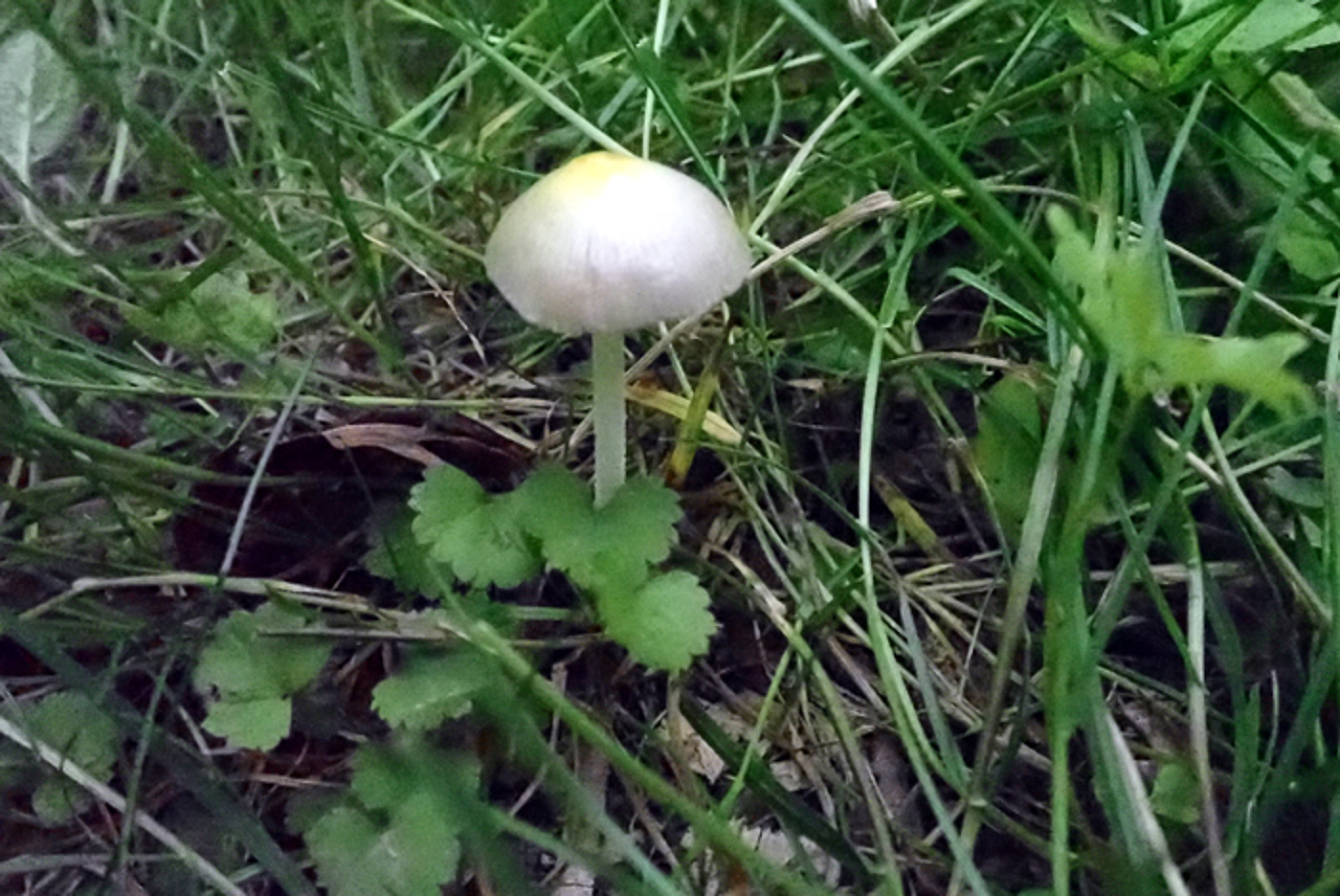
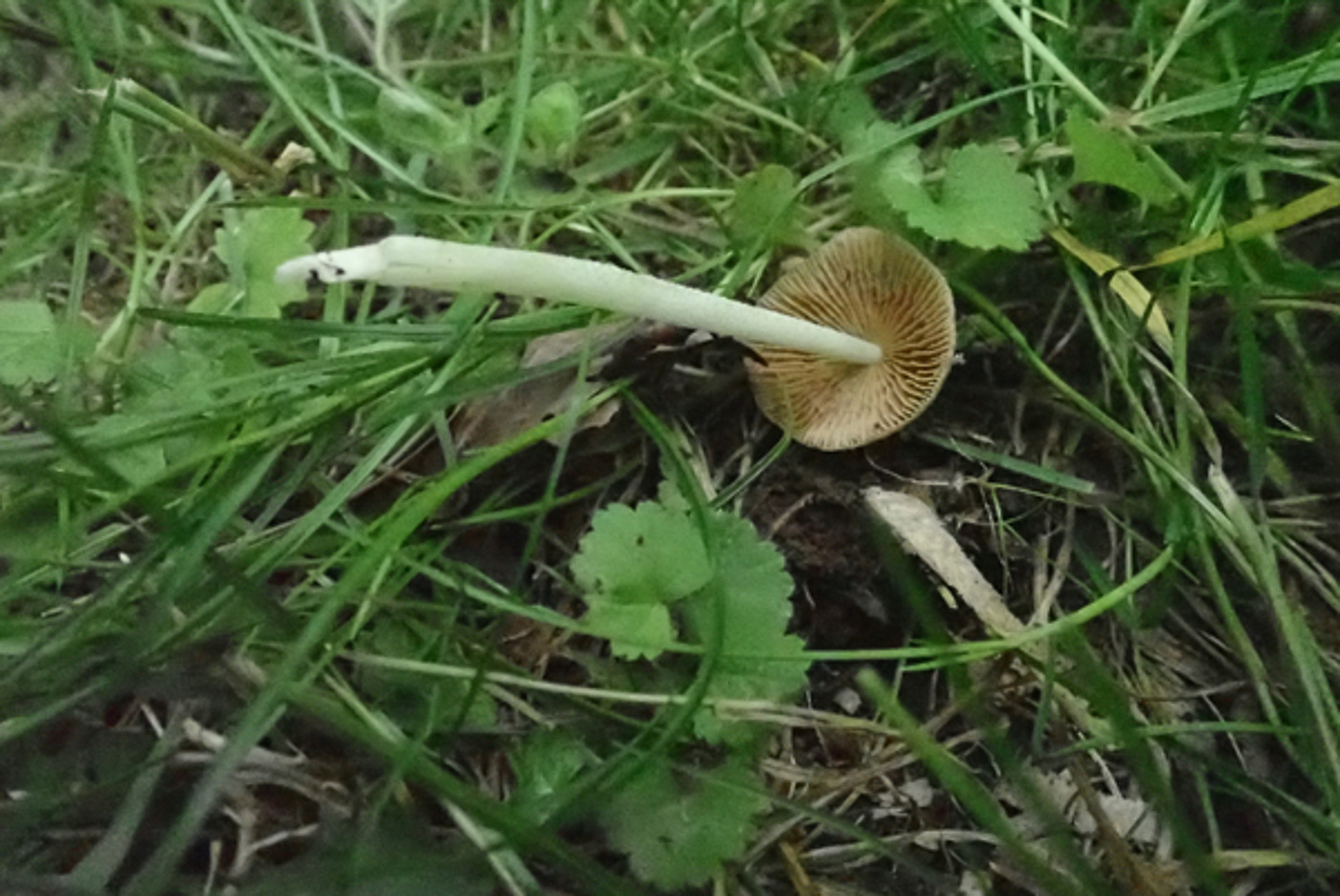 |
June 13th Bolbitius titubans (Yellow Fieldcap)
In a grassy path edge at Turville Heath Penny found this mature singleton with enough of its yolk yellow cap still just showing at the centre. The thin flesh and gills similar to a Parasola Inkcap, also its sticky stem and cap helped to confirm its identity.The species made an even earlier appearance on May 16th, with other images available in earlier years of Finds.
|
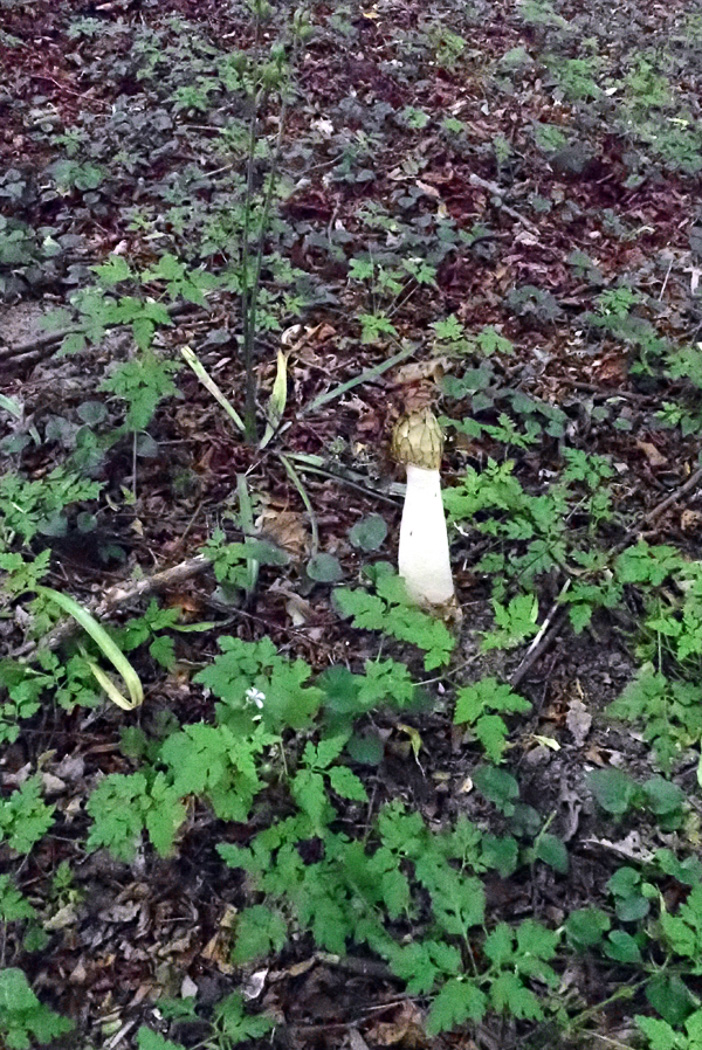
 |
June 13th Phallus impudicus (Stinkhorn)
Under Lime in litter at Turville Heath Penny noticed this standing proud at some distance away, but as she went closer both the smell and the shape soon told her its identity. The species made an even earlier appearance in Finds on May 21st this year.
|
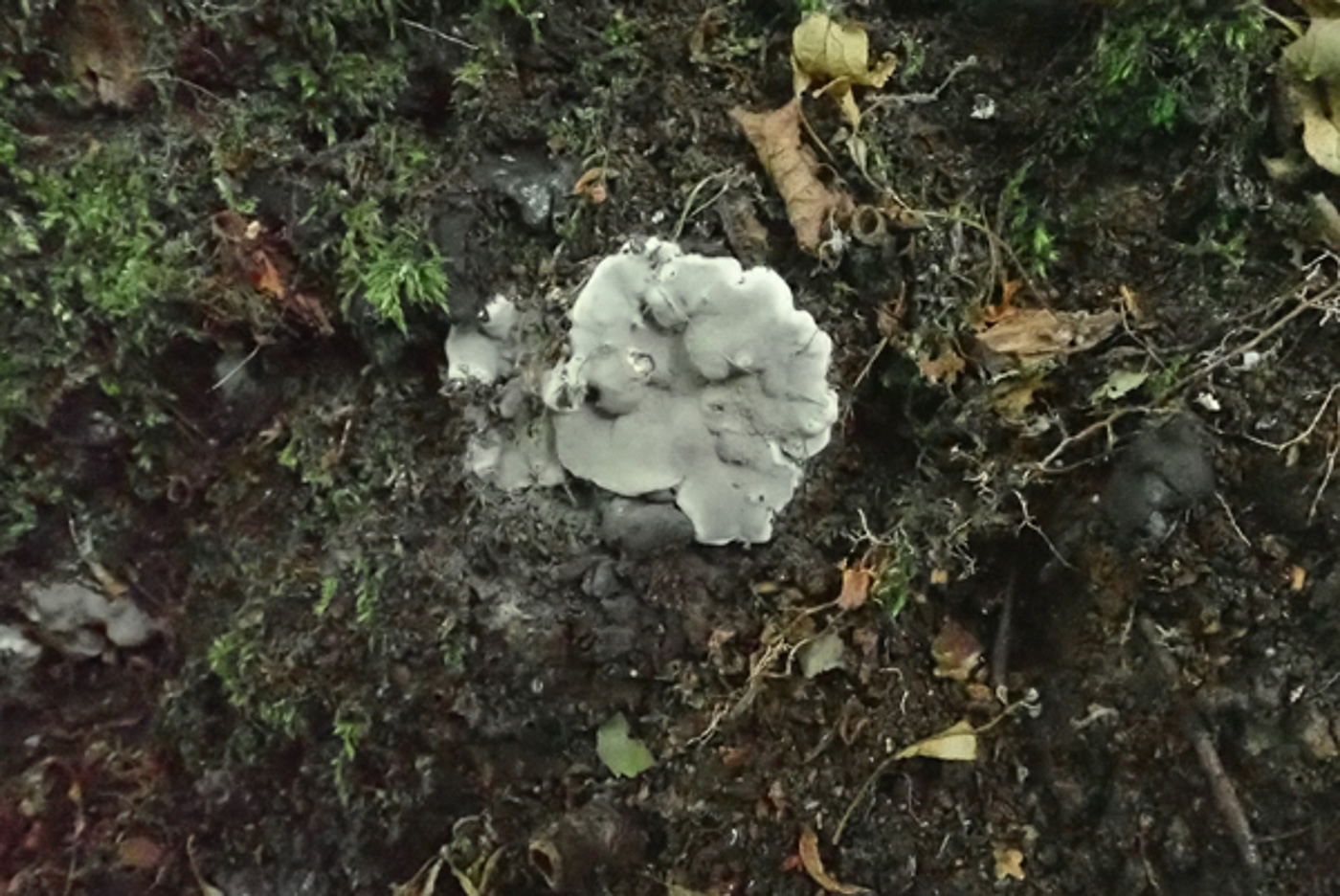
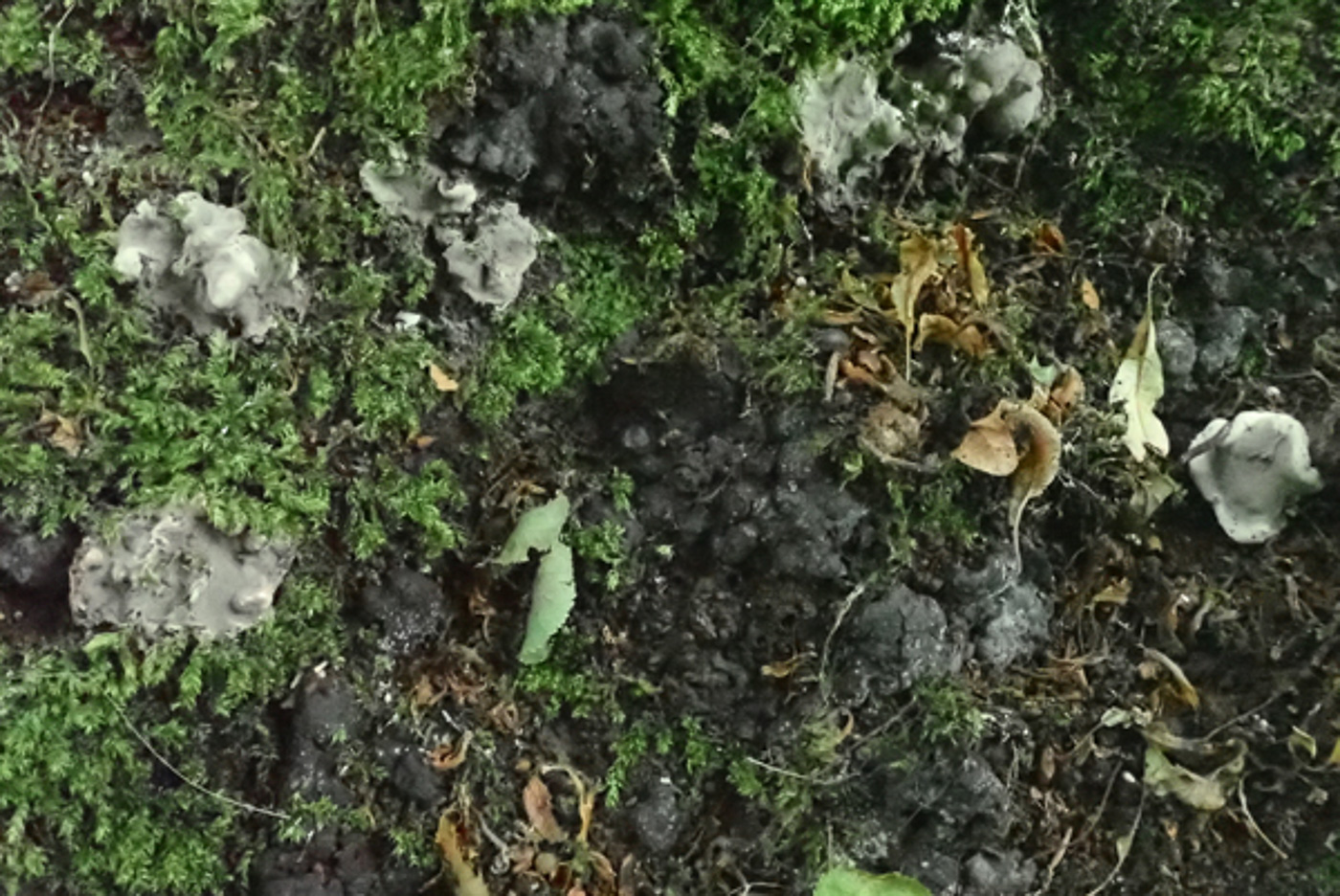 |
June 13th Kretzschmaria deusta (Brittle Cinder)
On the base of a Lime trunk at Turville Heath Penny noticed some pale grey lumpy patches having white edges and recognised this species of Pyrenomycete Asco, belonging to the Xylariaceae. When fresh as here it is an easy one to spot, but as it matures it becomes black, crusty and even lumpier and is easily missed. Both fresh and mature patches are visible in photo 2. It is quite common and usually on Beech and at this grey stage in early summer. See also on Finds 2021 June 21st (which may in fact be on the same trunk here!)
|
June 12th 2022

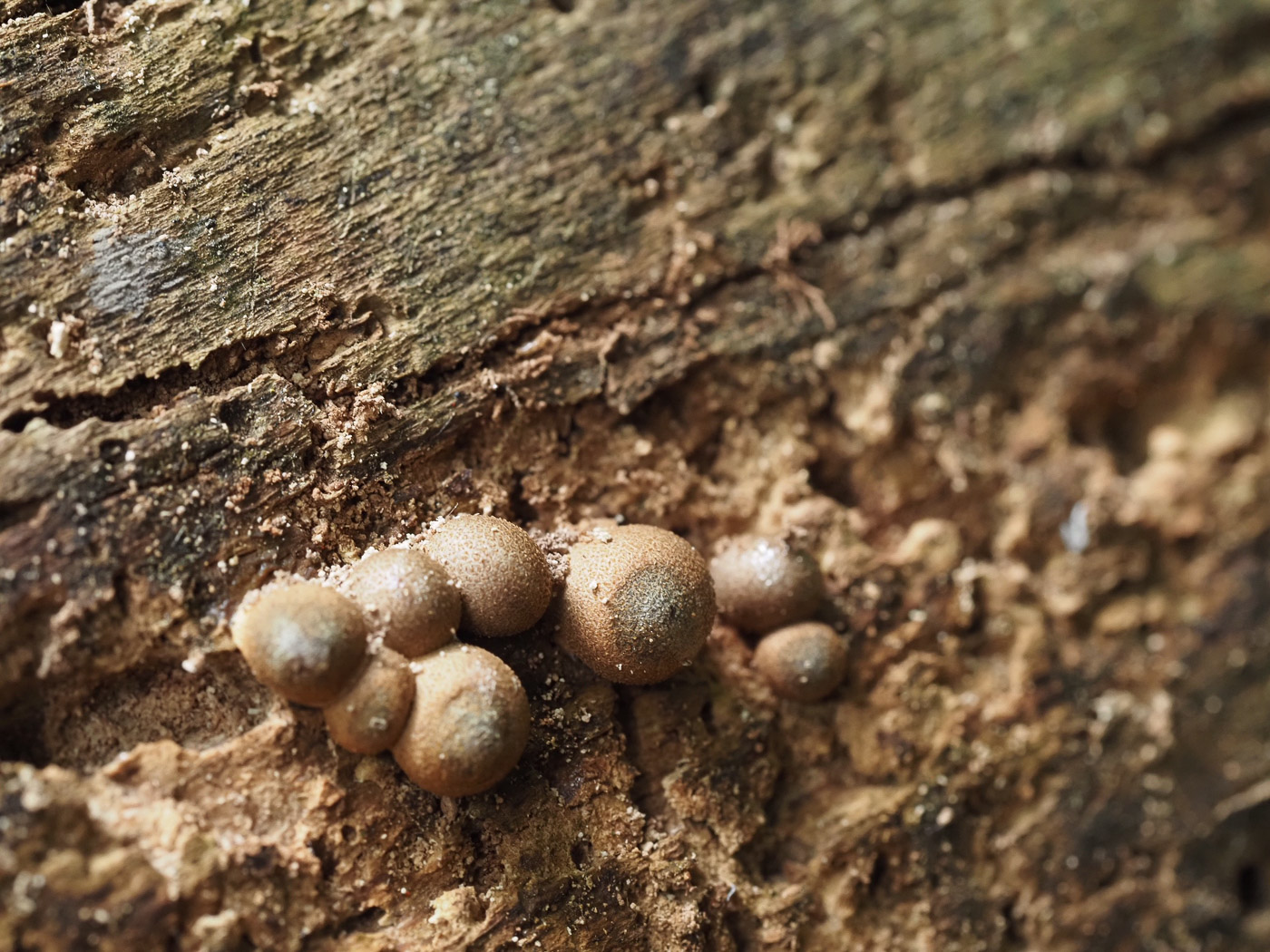
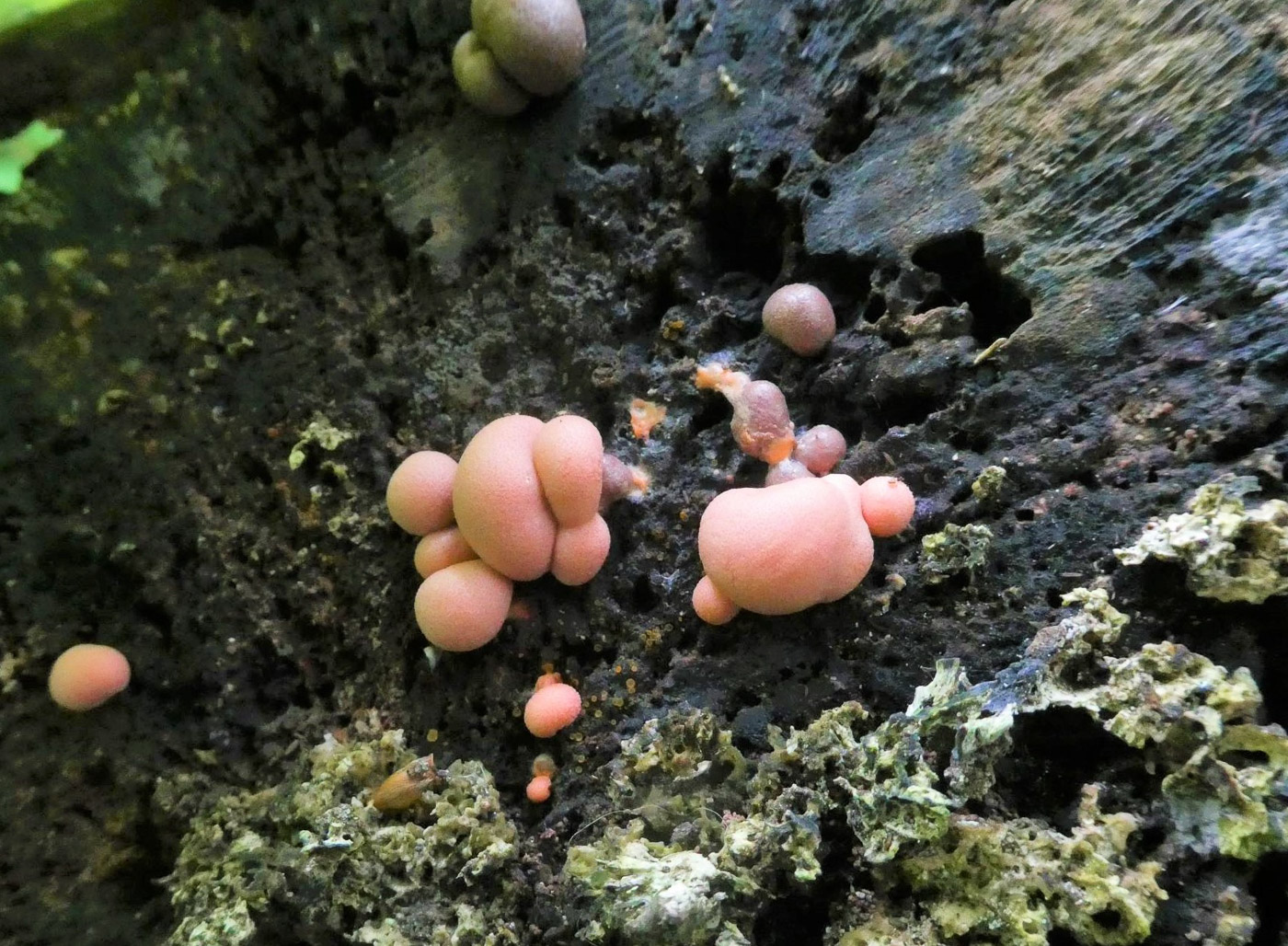
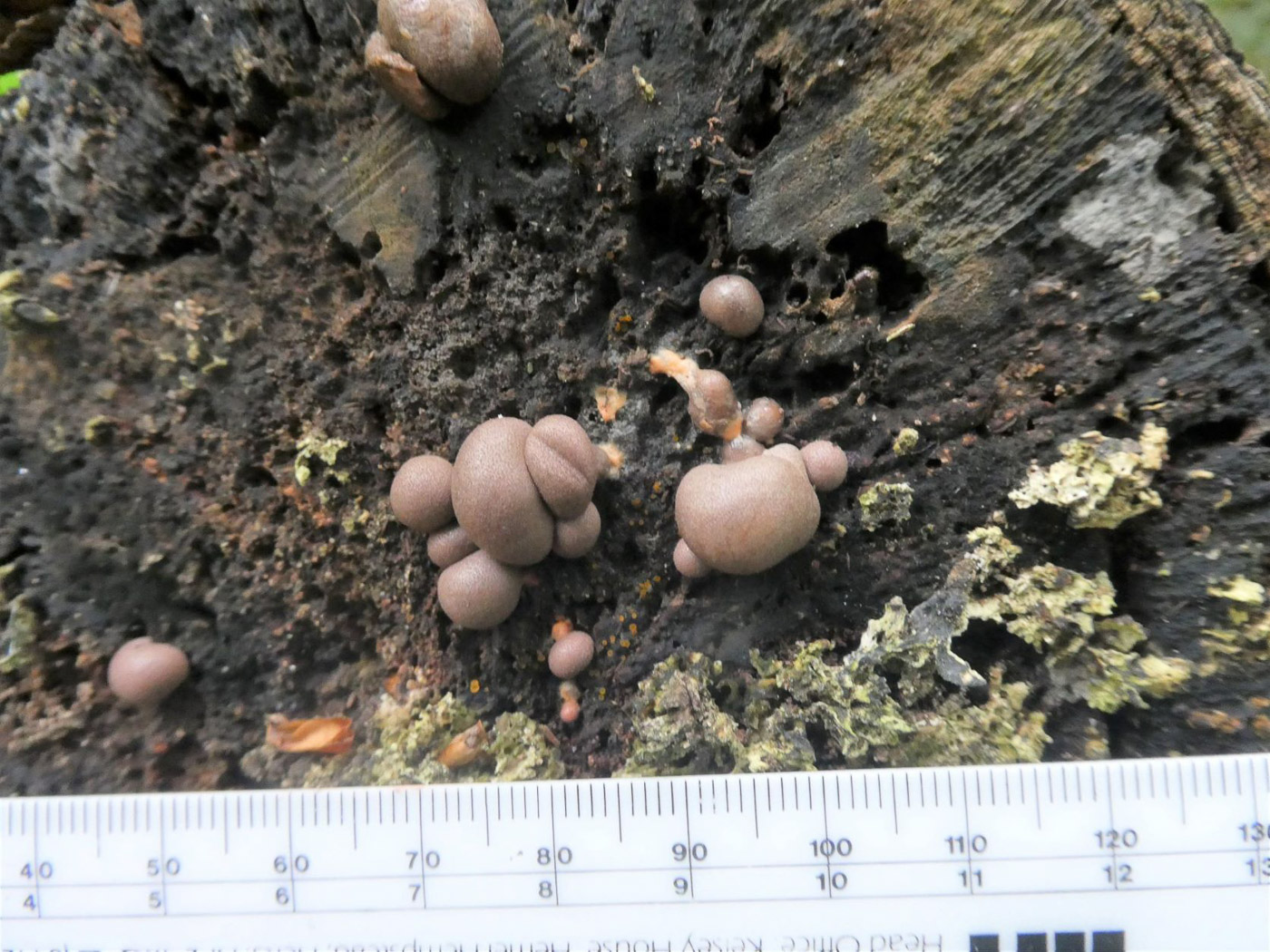 |
June 12th Lycogala terrestre (Wolf's Milk Slime Mould)
In Downley Wood Claire Williams spotted these bright peach blobs on fallen rotten wood (photos 1 and 2). Two days earlier Jim Wills also found this species near Chalfont St. Giles (photos 3 and 4). Note how the peach colour fades to beige as the blobs dry off and mature. There are various photos available on earlier Finds pages - this is one of our commonest species of Slime Mould.
|
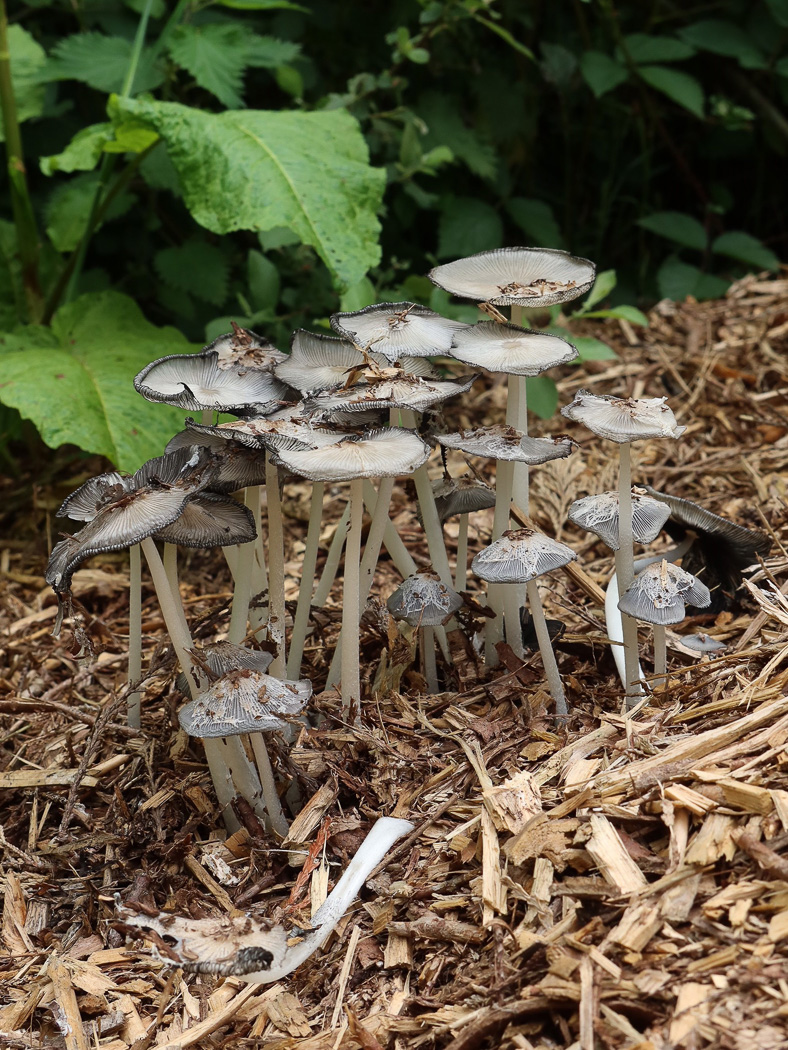
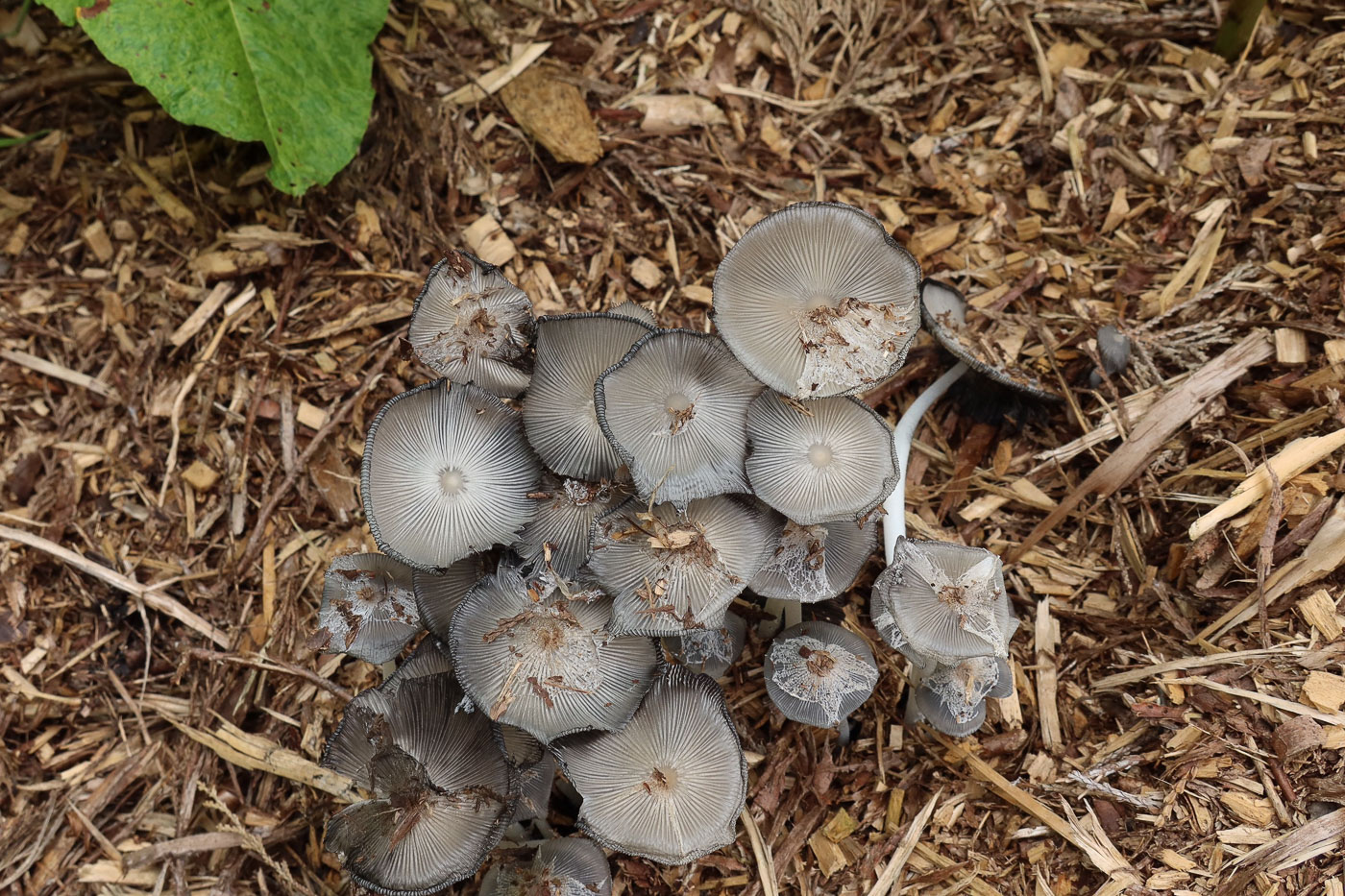 |
June 12th Coprinopsis lagopus (Hare'sfoot Inkcap)
In a woodchip pile at Naphill Common Claire Williams found this species, obviously having been stirred into action by the recent rain. The common name refers to its appearance when young before the cap has expanded when still covered in copious grey fluffy veil, the remnants of which can be seen on several caps here. The species is very partial to woodchip, forming clusters as here, but also occurs singly in soil in woodland rides. (This id was not confirmed with microscopy so is not 100%.) See also Finds 2021 Oct 7th, also 2020 Oct 1st and Nov 17th - this last showing young material.
|
June 9th 2022
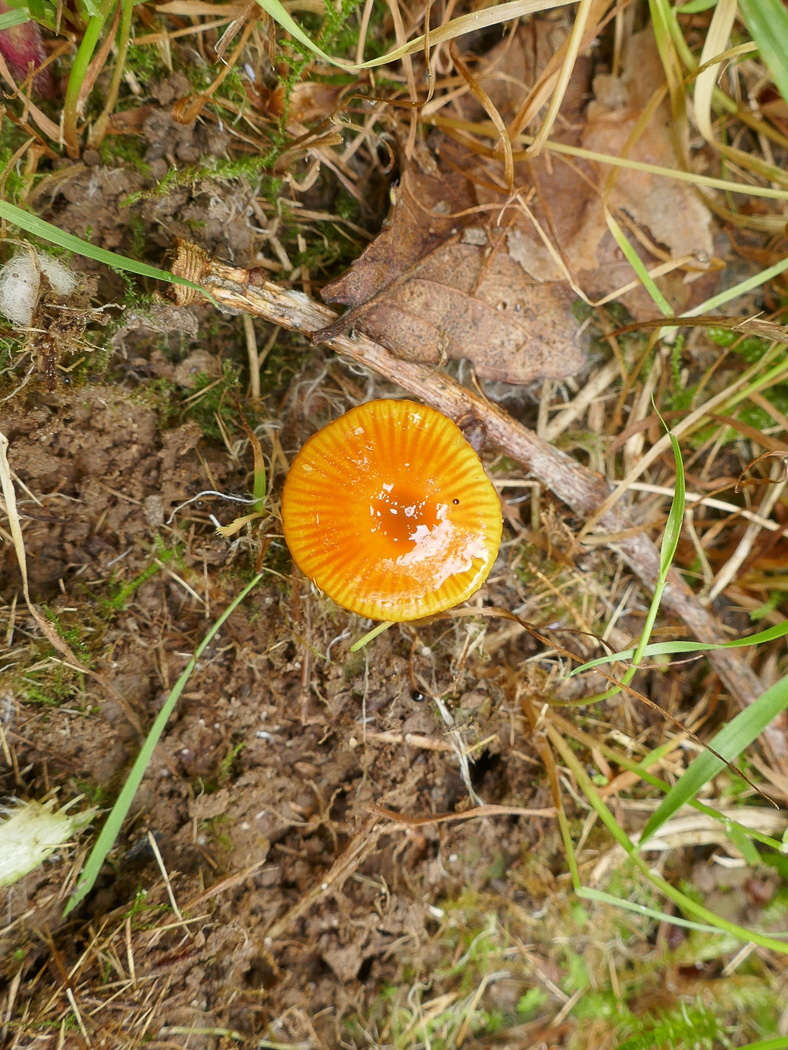
 |
June 9th Hygrocybe glutinipes (Glutinous Waxcap)
At Stampwell Farm in a grassy weedy spot near where she found this species last July, Jackie Ewan was delighted to discover her first Waxcap of the year - this now proven to be an excellent site for many species of Waxcap. A small species recognisable in the field by its viscid stem as well as cap, it also has quite distinctive spores, though the cap colour can vary from yellow through orange to red. We have around 20 previous records though this is the earliest by several weeks. See our second earliest record, from this same spot, on Finds 2021 July 12th.
|
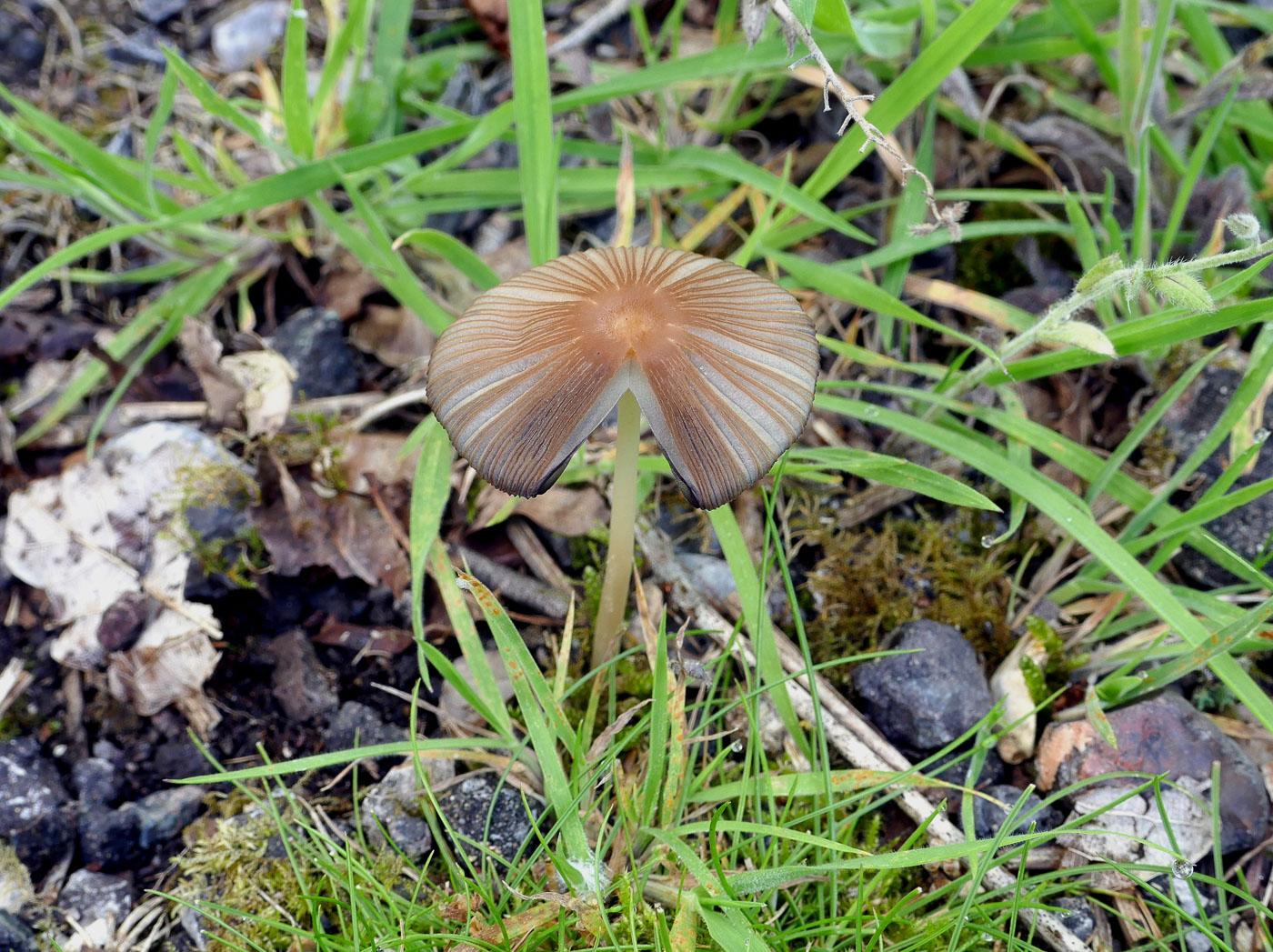
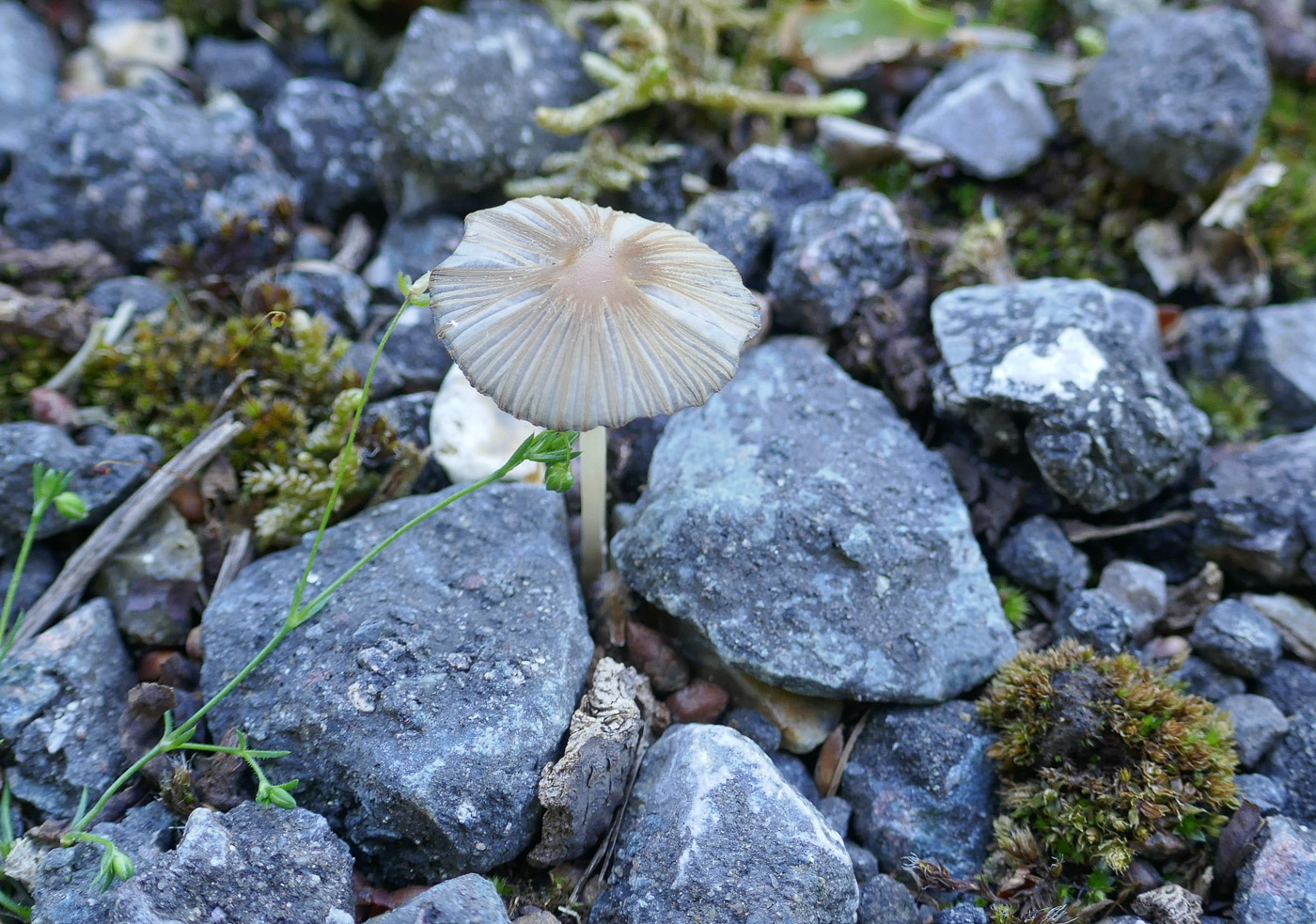
 |
June 9th Parasola auricoma (Golden-haired Inkcap)
Amongst some old road chippings in a parking spot at Stampwell Farm Jackie Ewan spotted two mature Inkcaps and recognised them as belonging to the Parasola genus (thin fleshed - almost translucent - and not deliquescing). With a scope, having ascertained the spore shape and size, she checked for and located the telltale long golden hairs found in the cap surface - a unique feature of this quite large Parasola. (See also in Finds 2021 July 17th, and for comparison various other examples of the genus, one much small species just yesterday.
|
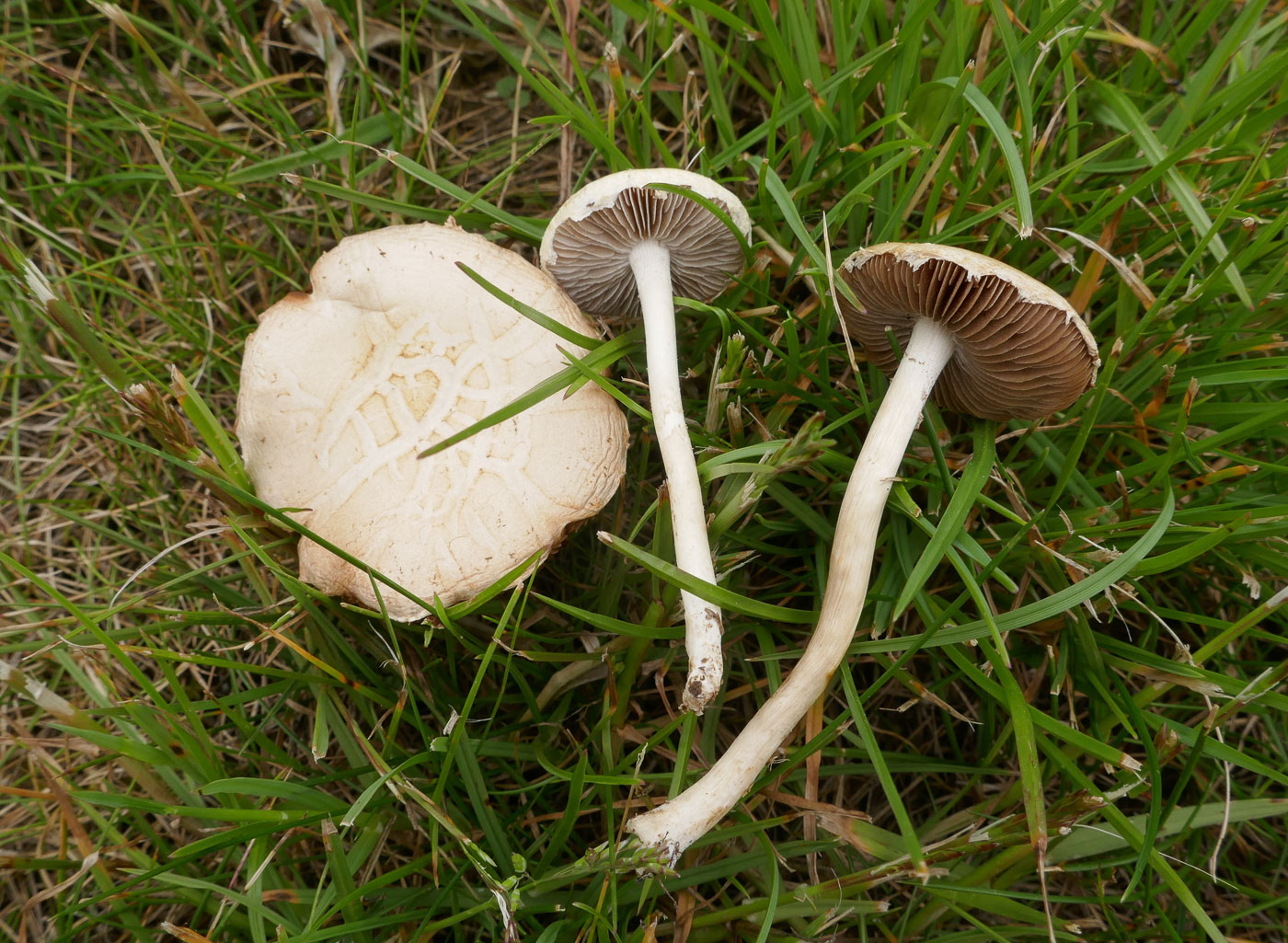 |
June 9th Agrocybe molesta (Bearded Fieldcap) 
At Stampwell Farm in a piece of lawn Jackie Ewan found this cluster and, noticing the distinct hanging veil remnants on the cap edge and cracking just starting on the cap surface, took one home to check the microscopy. The larger spore size and tendency for the cap surface to crack help to separate this species from the quite similar A. praecox (see the earlier entry dated May 21st) which also has veil remnants and a stem ring which can quickly disappear. The genus generally has a preference for fruiting from May through to early autumn - none our records for A. molesta are later than August.
|
June 8th 2022
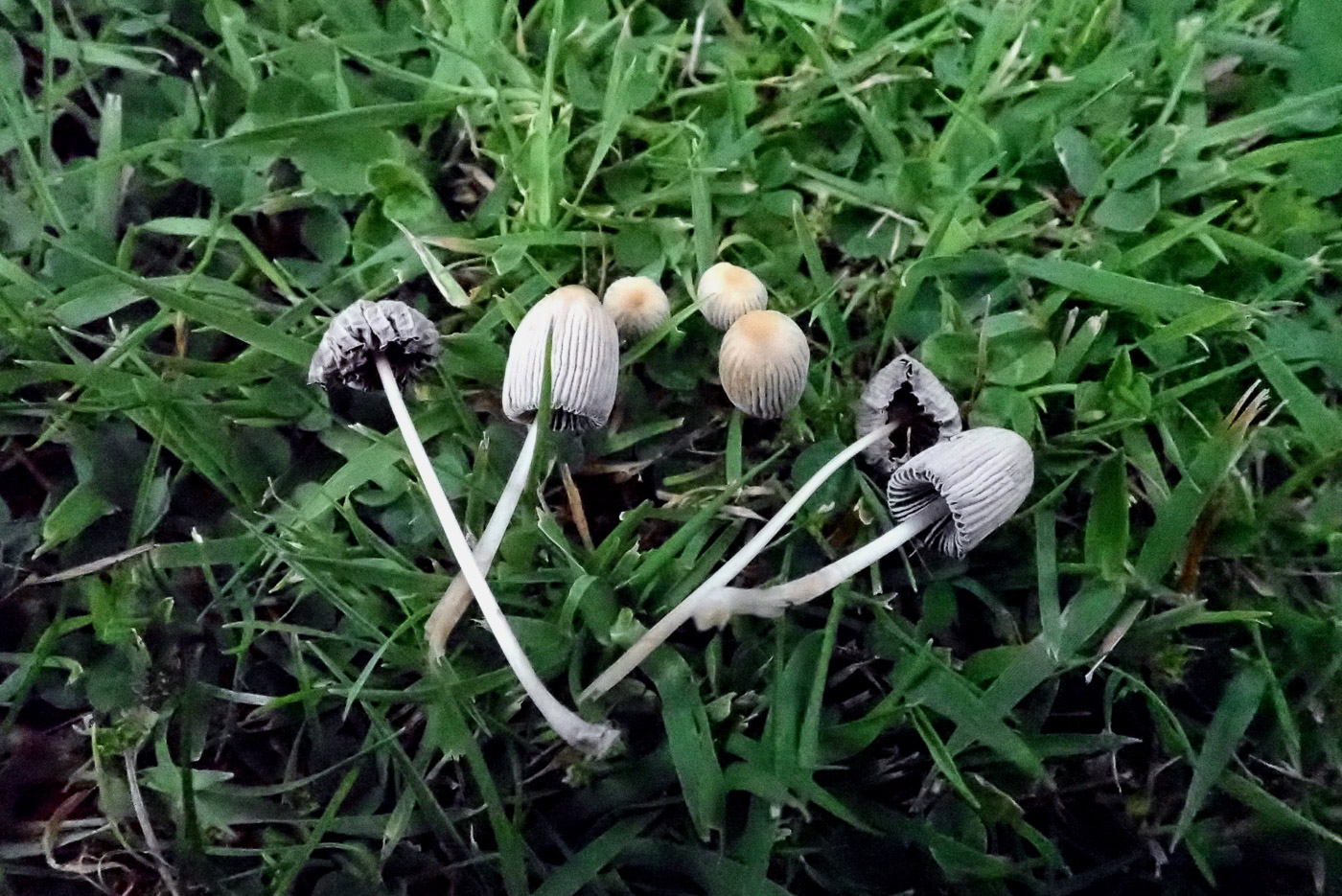 |
June 8th Parasola schroeteri (an Inkcap with no common name) (
In Penny's lawn (not quite in Bucks but very near the Oxon/Bucks border!) quite a few of these tiny mushrooms were making an appearance, the caps no more than 7mm tall before expansion and no wider than that when expanded, going over very quickly. There being several very similar Parasols which can be found in lawns, she checked the spores which were surprisingly large for such a small species: up to 15 microns long. This eliminated all but three similar species, P. megaspora being extremely rare, P. hercules having wider spores, leaving P. schroeteri as the likeliest and also the commonest of the three. We have only two BFG records but today's obviously doesn't count, so do look out for tiny Parasols in lawns though the spores will need to be checked to confirm it.
|
 |
June 8th Marasmius oreades (Fairy Ring Champignon)
Also in Penny's lawn this common grassland species has just started popping up in its usual ring, no doubt stirred into action by the recent rains. This is early, yes, but not exceptionally so: we have a few BFG records for May and June. See also Finds 2020 Sept 29th.
|
June 3rd 2022
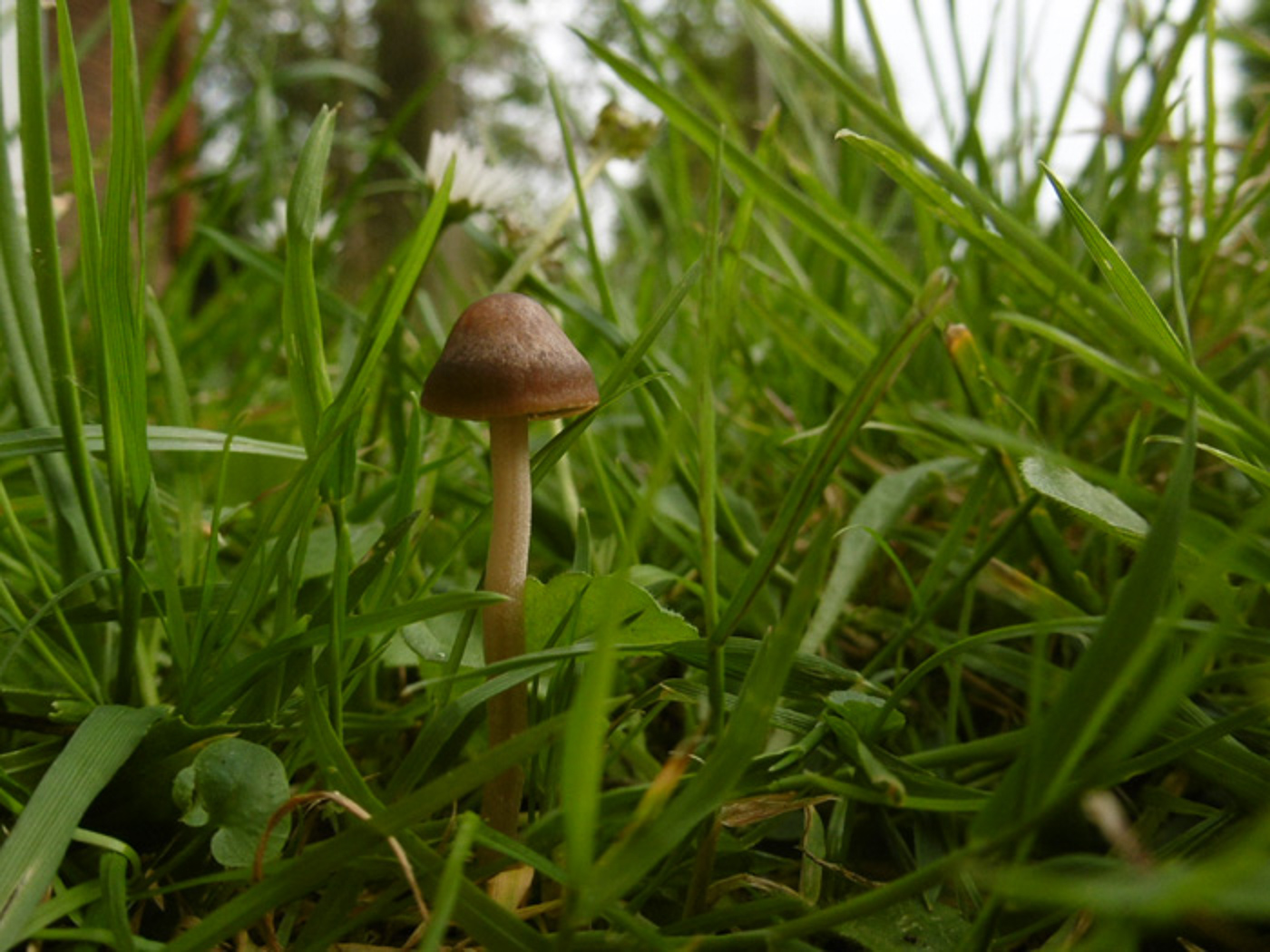
 |
June 3rd Panaeolina foenisecii (Brown Mottlegill)
In her garden in Marlow Ann Pitwell noticed this small LBJ coming up in her lawn and wondered what it was. Though not checked with a scope, the general 'jizz', the lawn habitat and clearly mottled dark gills tell Penny that this is the most likely identification. Also known as the Turf Mottlegill and March Mottlegill, this is one of our commonest garden species and often fruits soon after rain. Previously in the genus Panaeolus, it was separated from that genus on account of its dark brown rather than black sporeprint and also has rather differently ornamented spores.
|
June 2nd 2022
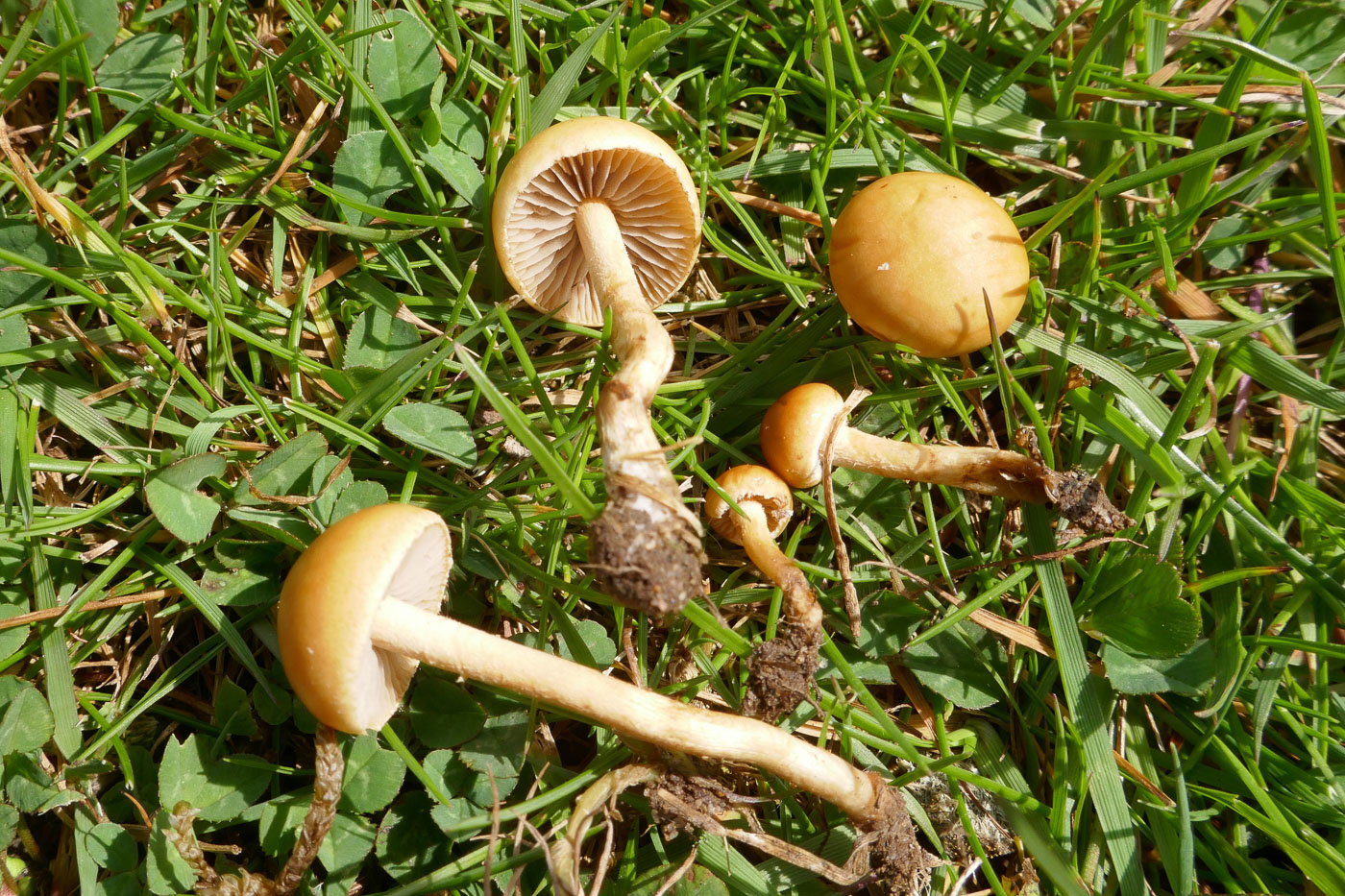 |
June 2nd Agrocybe pediades (Common Fieldcap) 
At Stampwell Farm Jackie Ewan noticed clumps of this species just emerging in grazed grassy areas, no doubt triggered by the recent rain. The species was very common here last year though started fruiting a month earlier. See also finds 2021 May 14th.
|
May 31st 2022



 |
May 31st Pleurotus ostreatus (Oyster Mushroom)
On fallen beech in Willow Wood on the outskirts of Amersham Paul Allen found this collection of Oyster Mushroom and asked Penny if she could confirm his identification (which was Pleurotus pulmonarius - Pale Oyster). She had her doubts because that species is often very difficult to split from the more common P. ostreatus and almost identical in the field, hence from a photo - however good - any such identification is speculative at best. One way to distinguish between them is by their sporeprint colour: cream in P. pulmonarius but with a lilac tinge in P. ostreatus. So Penny suggested Paul should try this and the following day received his photo 4 which surely shows enough lilac tinge to confirm this as P. ostreatus. P. pulmonarius tends to be paler and fruit earlier in the season than the commoner species - hence Paul's original naming and Penny's doubts, but pale forms of P. ostreatus are not that unusual and it can certainly fruit this early as well. So this was an interesting exercise and also show the usefulness of taking sporeprints.
|
May 27th 2022
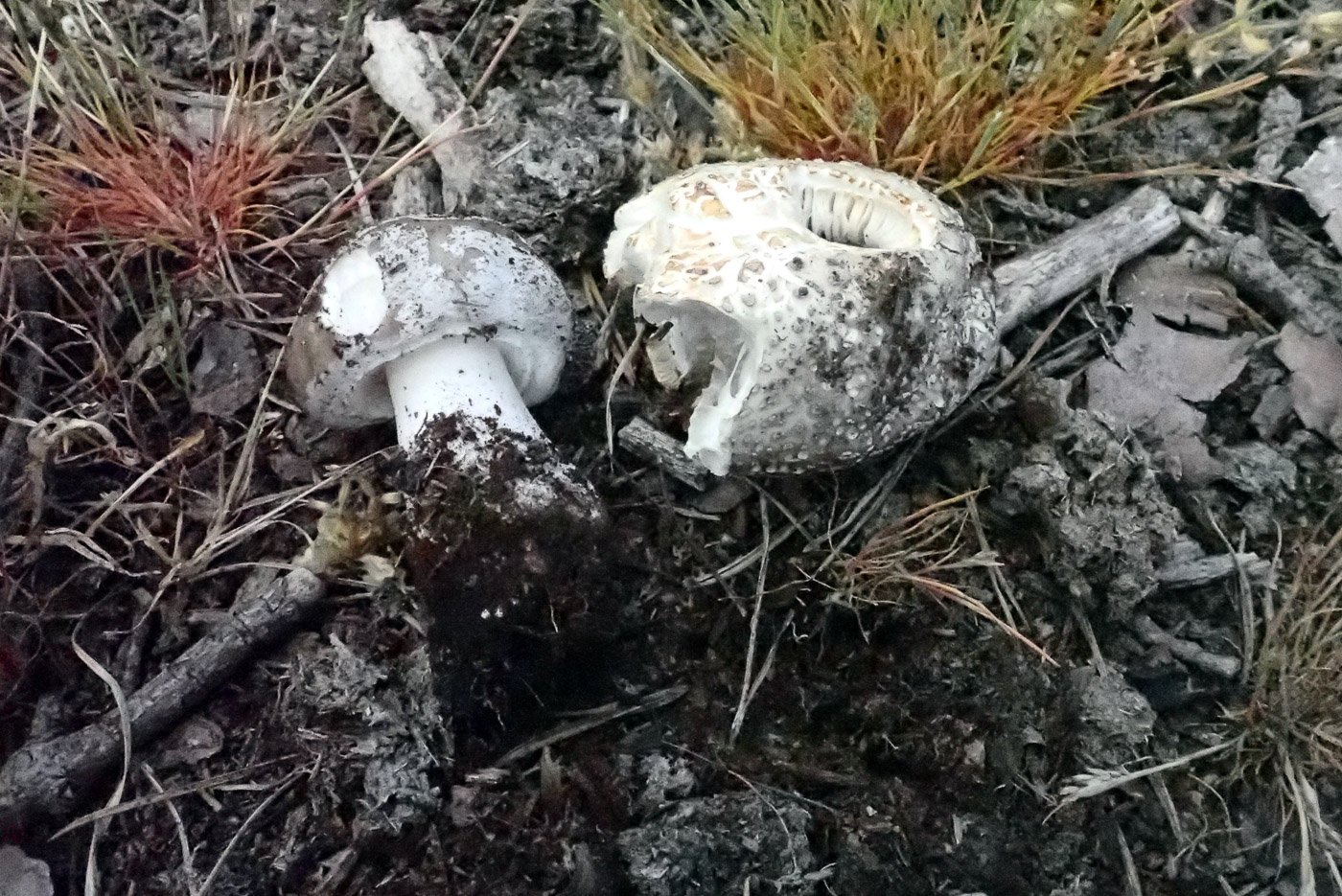 |
May 27th Amanita excelsa var. spissa (Grey-spotted Amanita)
If Bob Simpson gets the prize for the first Bolete this year (yesterday), then Penny claims the prize for the first Amanita today! At a bone dry Stoke Common she was amazed to find anything fresh at all, so this find in a cleared area under a lone Pine was indeed a surprise. Not the greatest specimens but at least they were recognisable, the bright sunlight not doing the photo any favours, however. A glance at our database shows a few June records amongst the many (from Hodgemoor Woods and Penn Wood) but none for May! See also Finds 2020 Sept 4th.
|

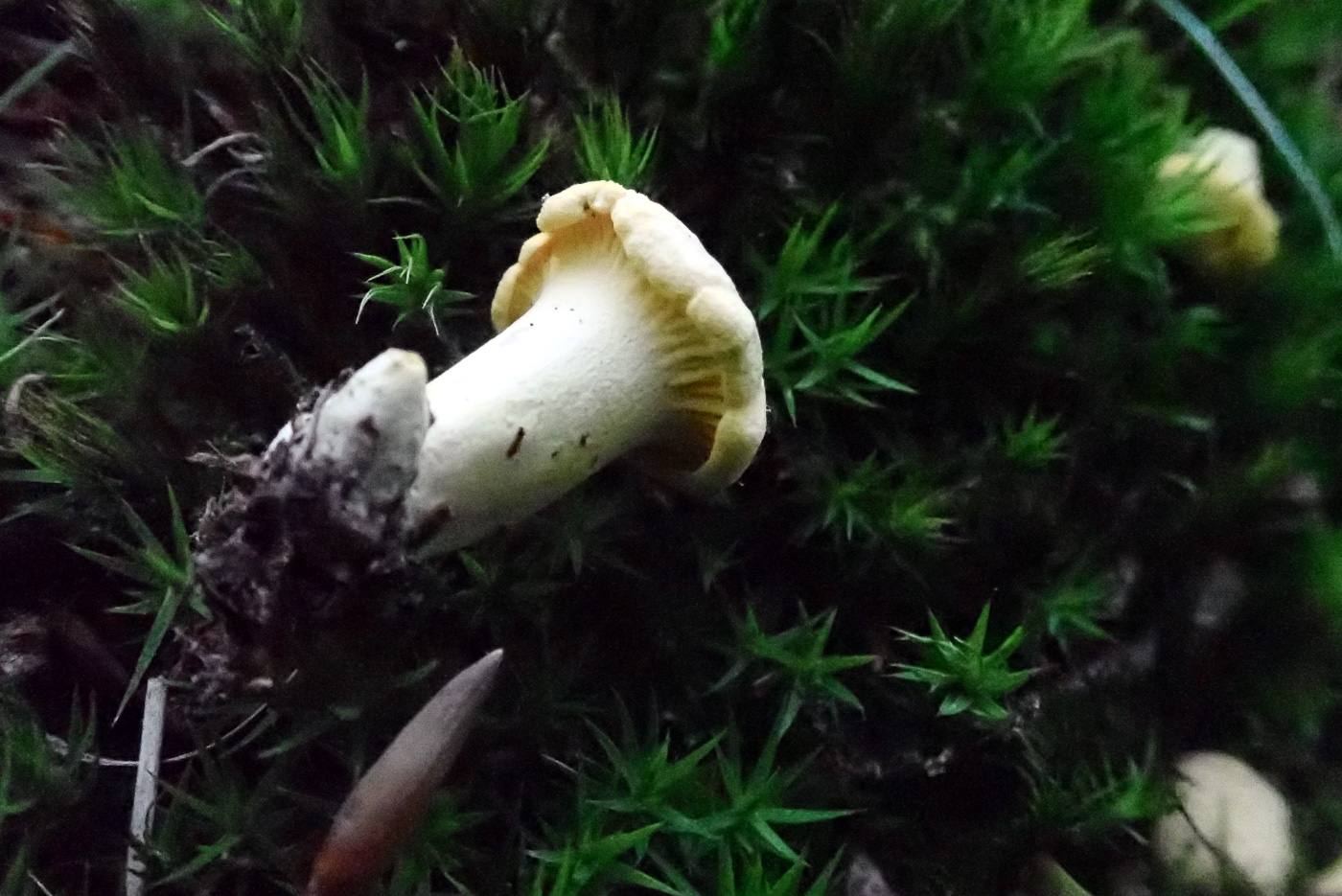 |
May 27th Cantharellus cibarius (Chanterelle)
At Stoke Common Penny was somewhat surprised to find these tiny specks just trying to emerge in a mossy glade under Oak, the site being incredibly dry and pretty well devoid of fungi. Turning over the largest of them (only 1 cm across) confirmed its identity and a check at home revealed just two other previous collections from this site, and amongst our numerous records for the county were a handful from June (the earliest June 4th from Hodgemoor Woods) but none for May! Surprisingly this is our first image of the species on Finds - pity it's not very useful as identification!
|
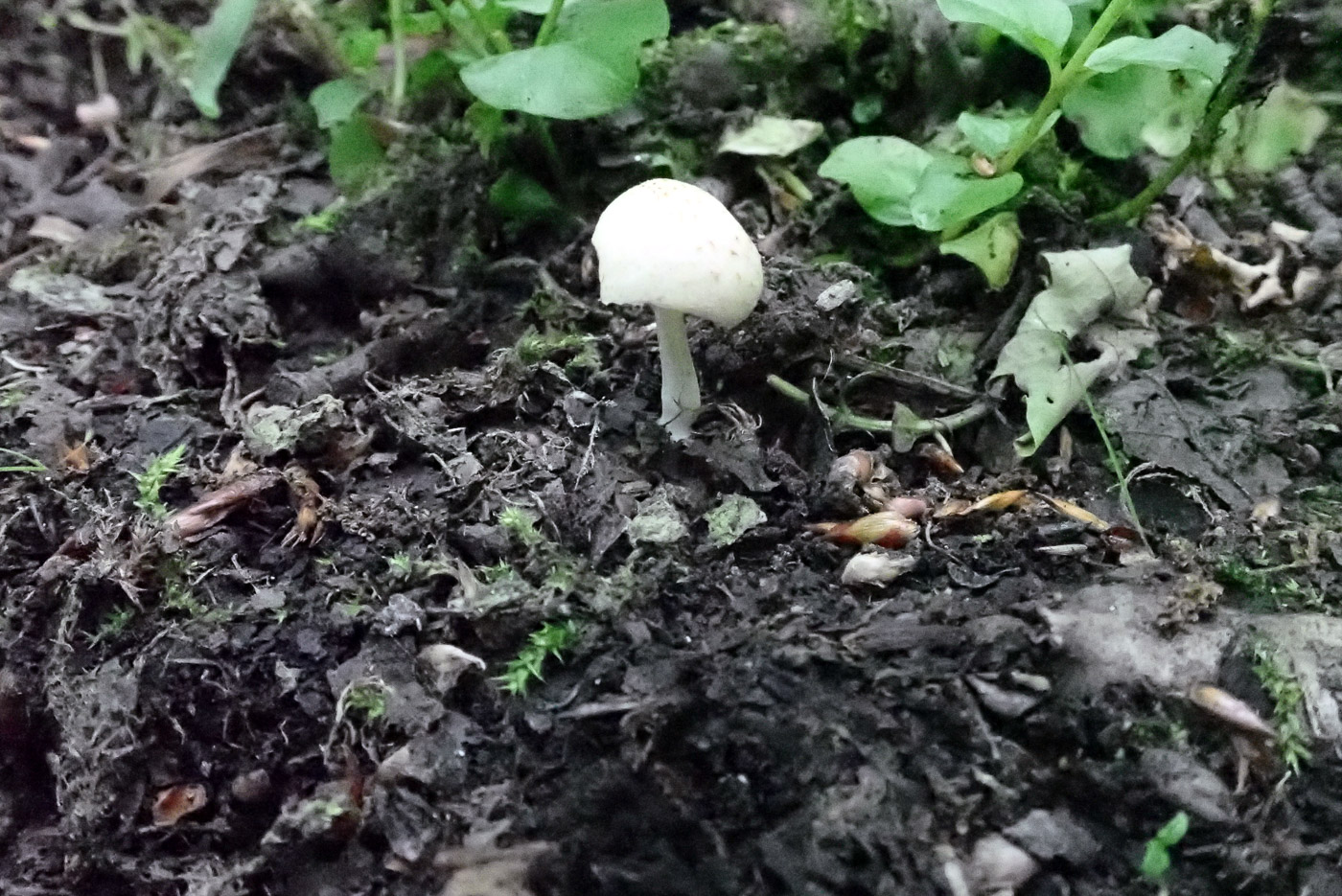
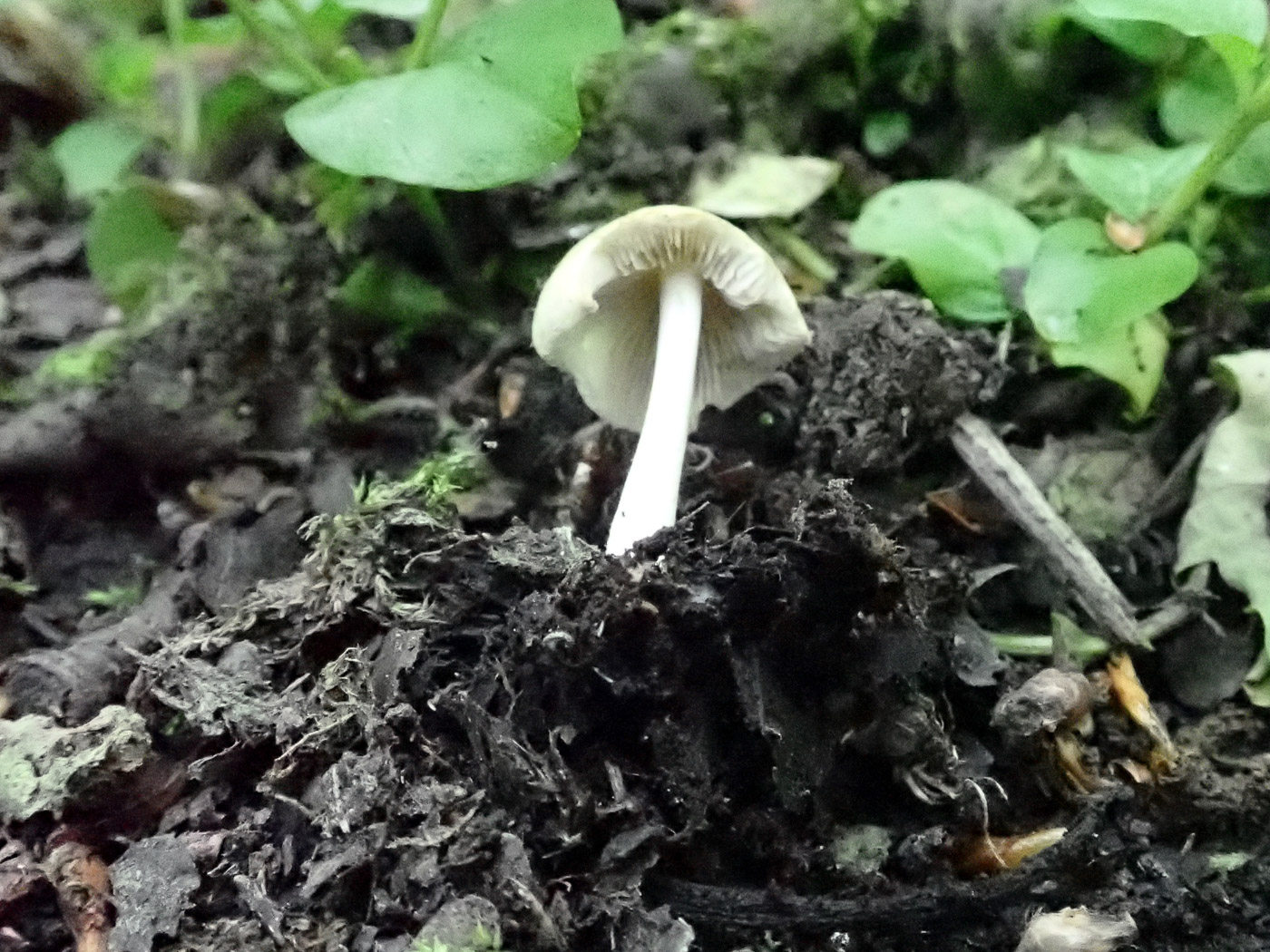 |
May 27th Psathyrella candolleana (Pale Brittlestem) 
In Stoke Common Penny had to search long and hard to find any fungi today, it was still incredibly dry underfoot (though near the Bucks/Oxford border there'd been considerable rain recently). In the dried up bed of a pond she found this rather nibbled small singleton, still with somewhat pale gills for a genus which has dark brown spores but a few hours later they were becoming suitably brown. This common species often fruits very early in the season in grassy path edges in woodland (so appearing in muddy soil which is usually under water seemed odd?). See also Finds 2020 Nov 10th, also 2021 June 23rd and Aug 3rd.
|
May 26th 2022

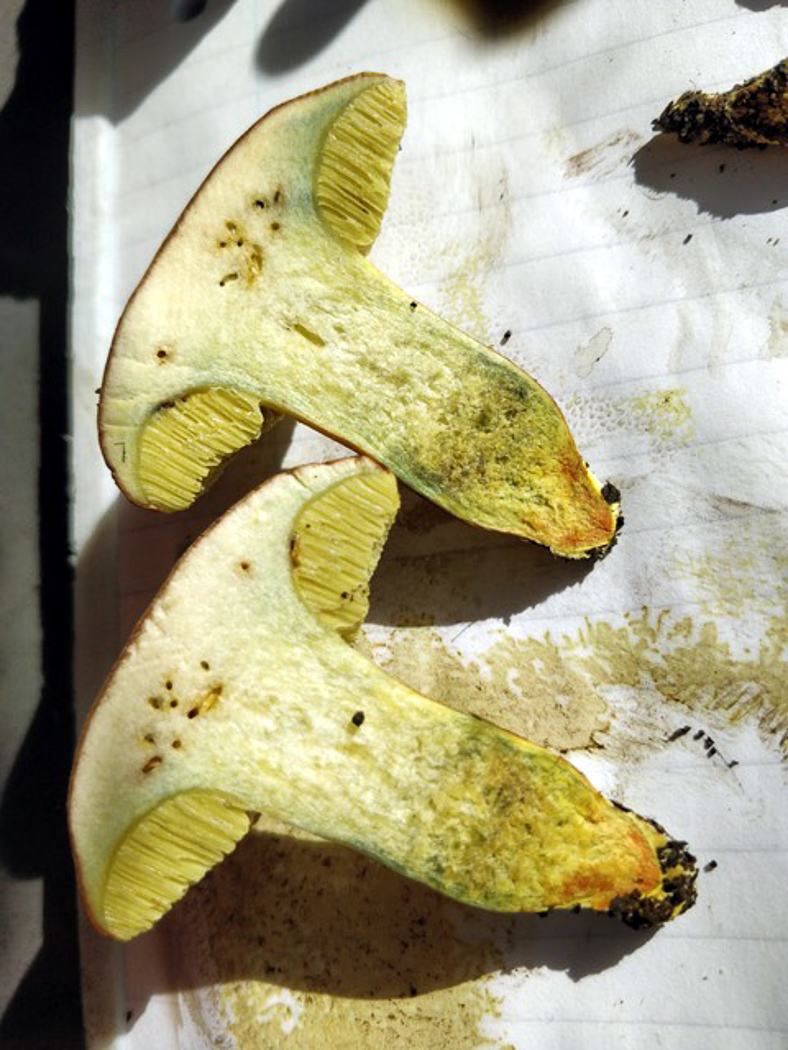

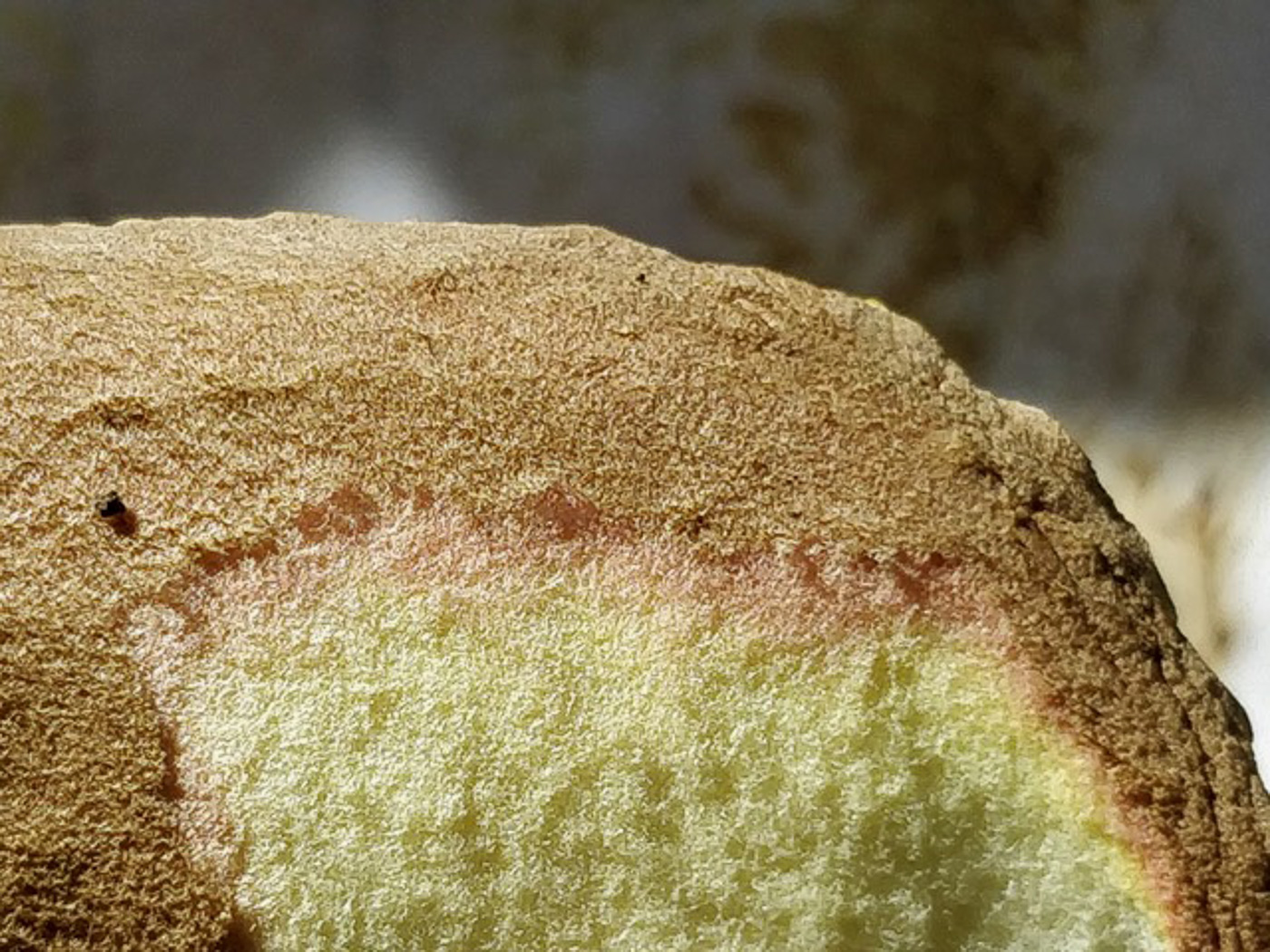 |
May 26th Hortiboletus engelii (a common Bolete but with no common name) 
Bob Simpson deserves a prize for finding the first Bolete of the year! He found these nice specimens growing in a polytunnel in his garden where apparently they come up every year, being near a large Oak which was originally in woodland where he lives at Salden Wood, not far from Milton Keynes. He'd tentatively named it Xerocomus subtomentosus (Suede Bolete) but Penny is confident from his photos that the general 'jizz' together with the tapering stem (see photo 3) with clear orange dots / stains at the base (see photo 2 - a unique feature of the species) and its early fruiting under Oak all point to what was at one stage known as Boletus communis, then Xerocomus/ellus communis, then X. engelii and now Hortiboletus engelii! Photo 4 shows the felt-like cap cuticle with underlying pink, confusingly a feature of Xerocomellus pruinatus as well. The earliest month we've a record of this species seems to be July, so Bob's beaten that quite considerably. Could this be a sign that things are going to start fruiting really early this year? See also Finds 2020 Sept 18th, also 2021 Aug 12th and Sept 27th.
|
May 21st 2022
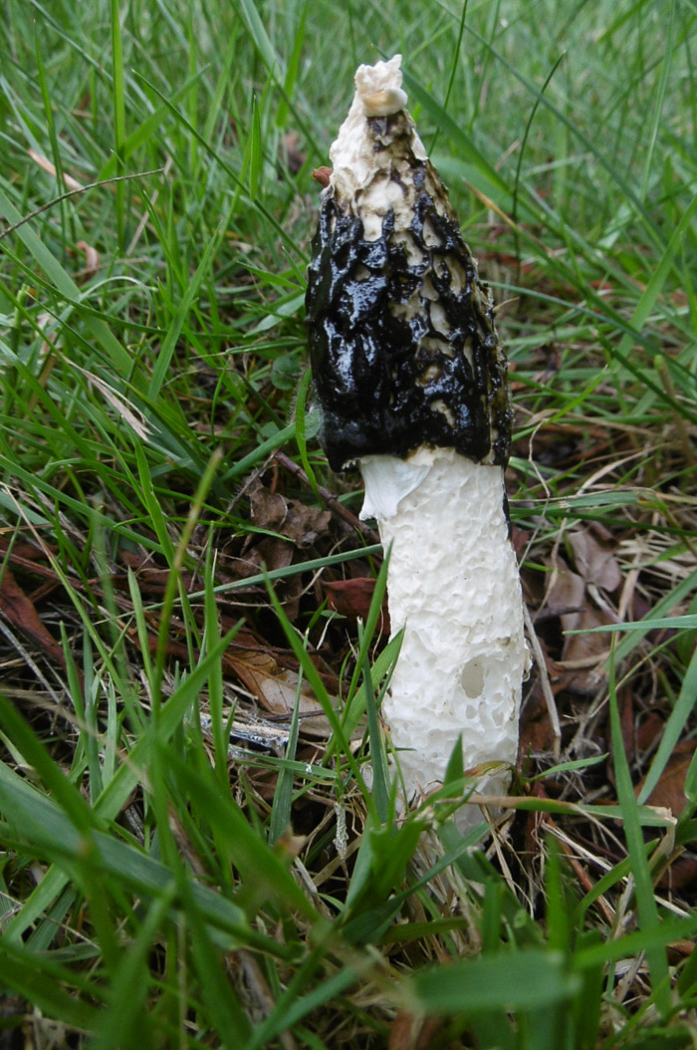 |
May 21st Phallus impudicus (Stinkhorn)
In her garden in Marlow Ann Pitwell first smelt and then found this early fruiting Stinkhorn. Checking our database Penny found that our earliest previous record for the species is May 31st 20 years ago!
|
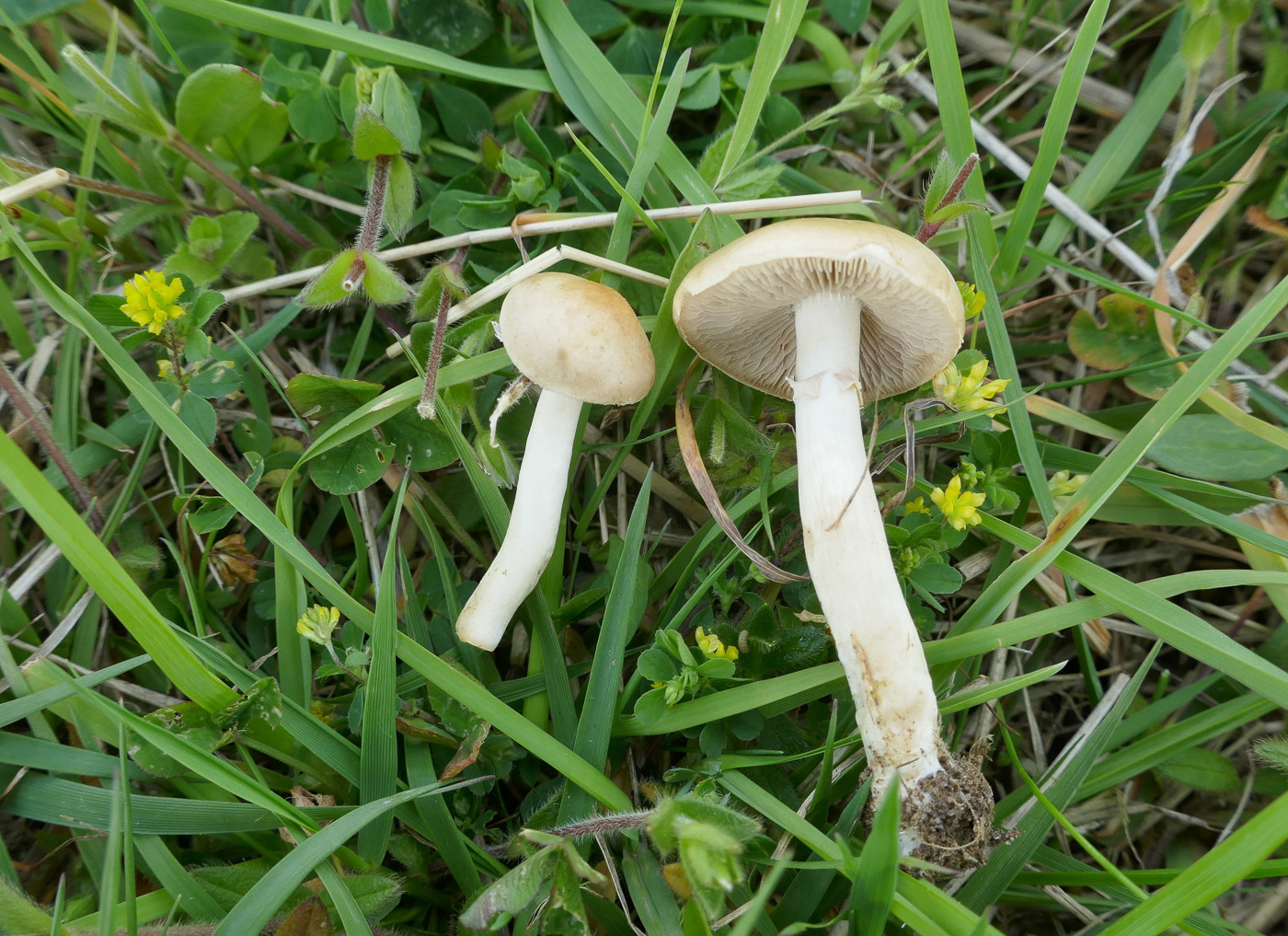 |
May 21st Agrocybe praecox (Spring Fieldcap) 
At Stampwell Farm Jackie Ewan found the first fruiting of this species in the same large meadow as it occurred in quantities last Spring. Note the remains of the ring which often can also leave remnants on the cap edge, though this feature can be missing in more mature specimens. The species has a distinct mealy smell. See also Finds 2021 May 25th and June 4th.
|
May 19th 2022
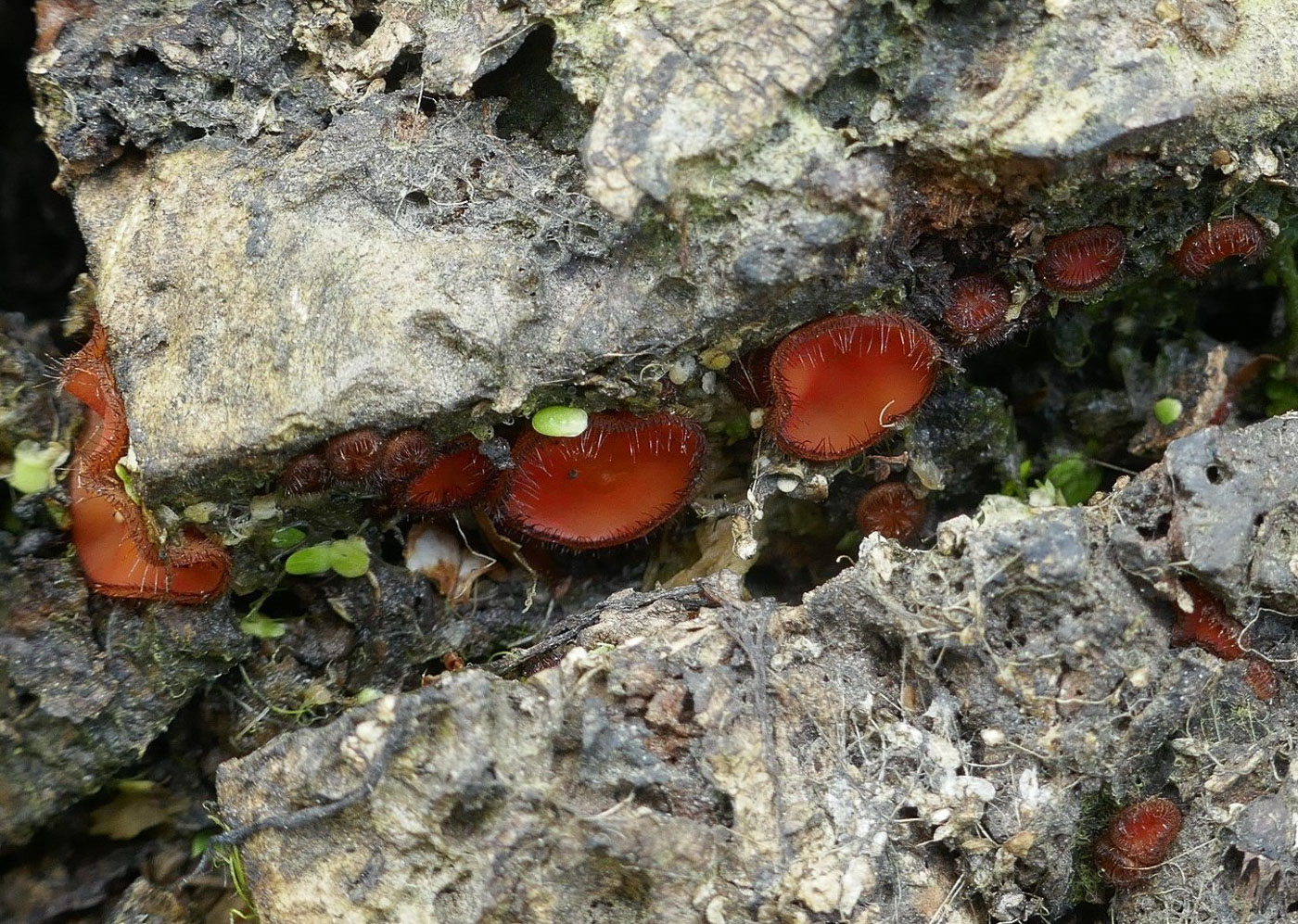 |
May 19th Scutellinia scutellata (Common Eyelash) 
At Stampwell Farm on a rotten Willow stump Jackie Ewan found these tiny discs and checked the microscopic details to ensure it was not one of the other species in the genus - there are many and the keys are not for the faint-hearted(!) but the very long 'eyelashes' together with the spores confirmed her identification.
|
May 18th 2022
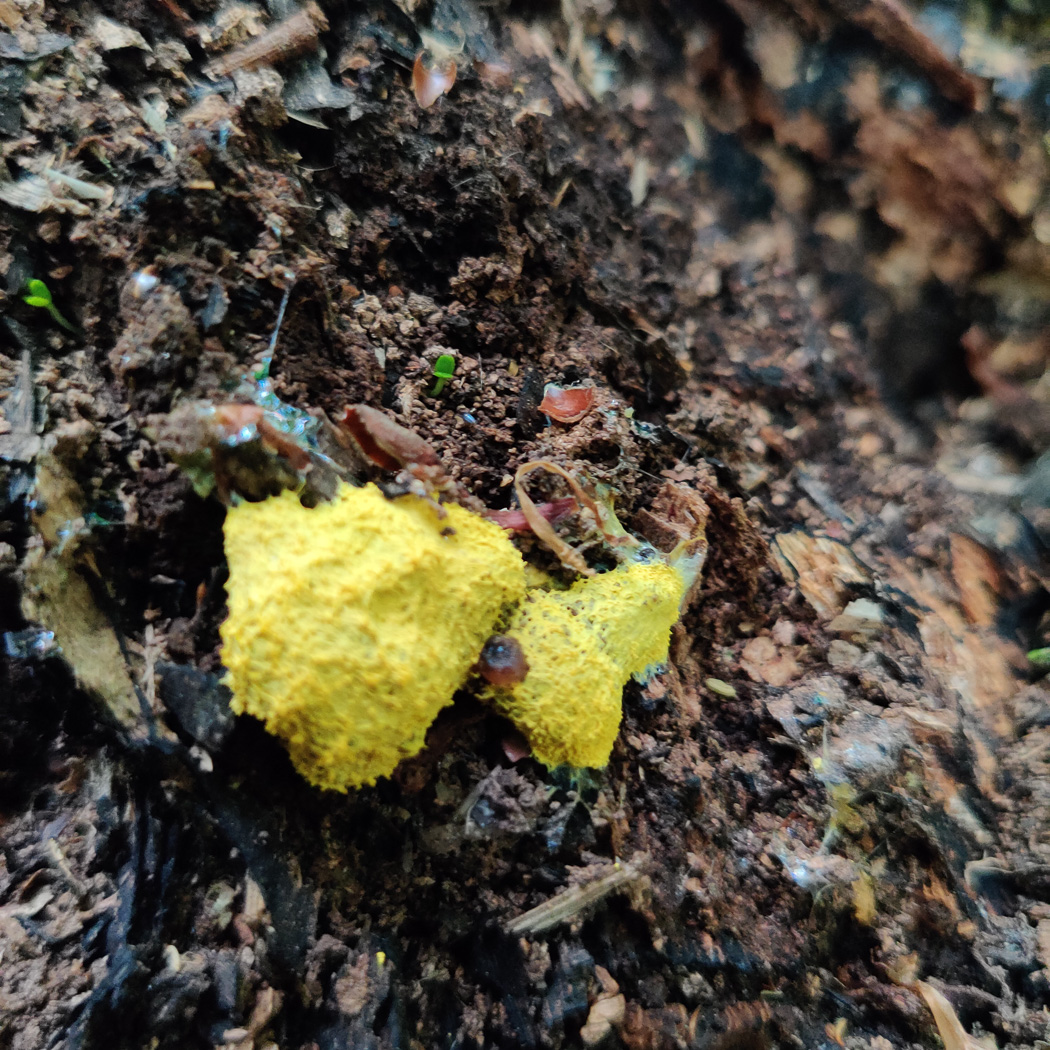 |
May 18th Fuligo septica var. flava (Dog's Vomit)
In Bradenham Woods Claire Williams spotted a tree stump with three patches of this bright yellow and very common Slime Mould. We have two other images showing different aspects of development: Finds 2020 Sept 18th and 2021 July 21st.
|
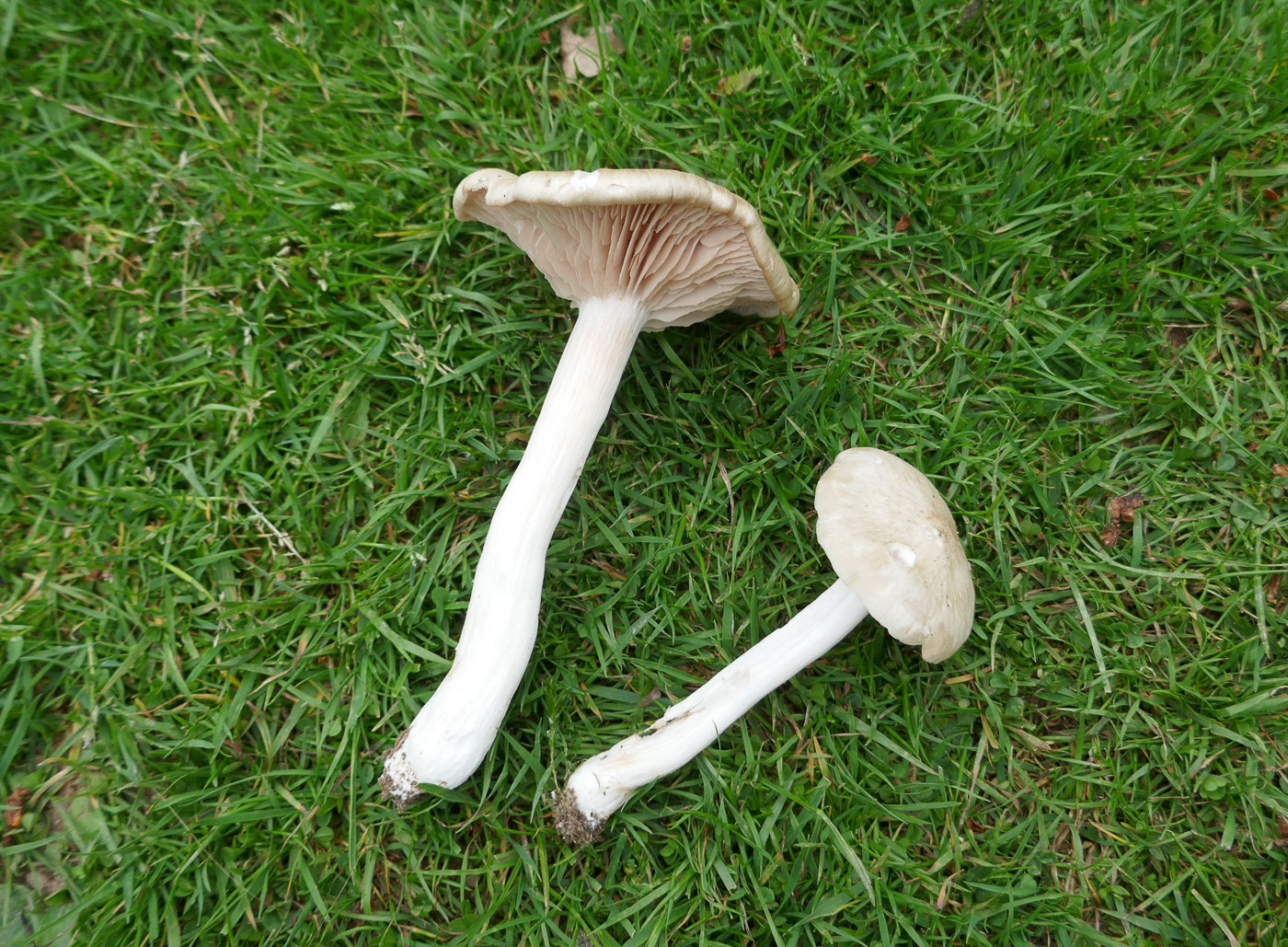 |
May 18th Entoloma clypeatum (Shield Pinkgill) 
At Stampwell Farm Jackie Ewan found this quite common Springtime Pinkgill growing amongst some Plum suckers in the same spot as it was found last year almost to the week! See also Finds 2021 May 29th and 2022 Mar 8th.
|
May 17th 2022
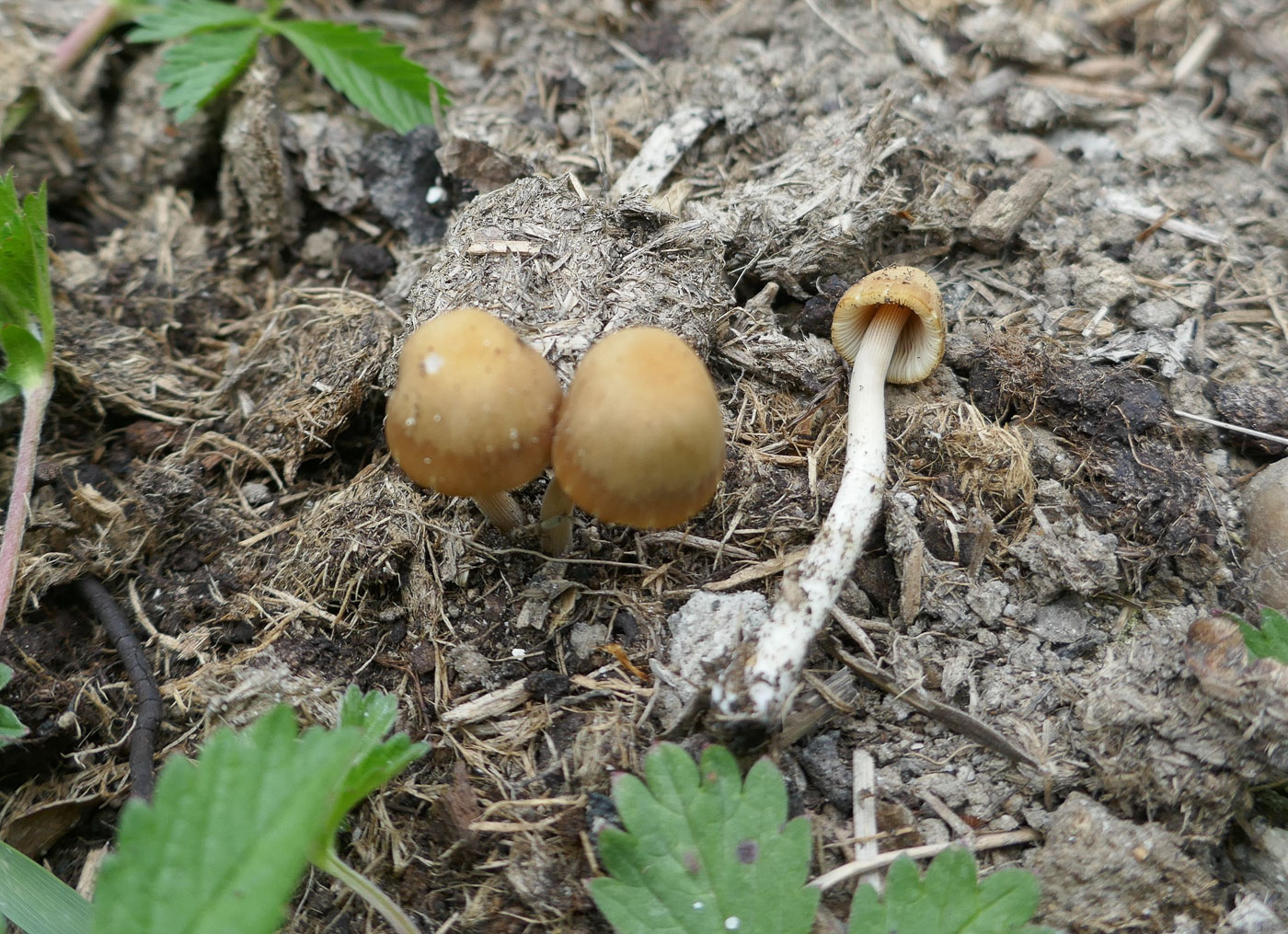 |
May 17th Conocybe moseri (an unusual Conecap with no common name)  
In a composted flower bed at Stampwell Farm Jackie Ewan found this second collection of Conocybe nearby (see also the entry below) which she attempted to name but from limited resources. As Conocybe is a difficult genus to say the least, Penny considered it worth getting sequenced. Its DNA showed it to be C. moseri, new to the county and with few national records. So this was a nice find with a successful result - one of the first using our newly introduced Science Fund supported by BFG members' donations.
|
 |
May 17th Conocybe pubescens (Downy Conecap) 
At Stampwell Farm in a recently composted flowerbed Jackie Ewan made two collections of Conocybe near together, though a microscope revealed they were not the same species. One, however, was quite easily identifiable as C. pubescens - a common species on dung or manured soil, quite large for the genus with a finely hairy bulbous stem and rather large spores. See also Finds 2020 Nov 30th and 2022 Feb 24th. (The second species Jackie found today proved harder to nail down with any certainty - not unusual with this genus. But see also the entry above.)
|
May 16th 2022
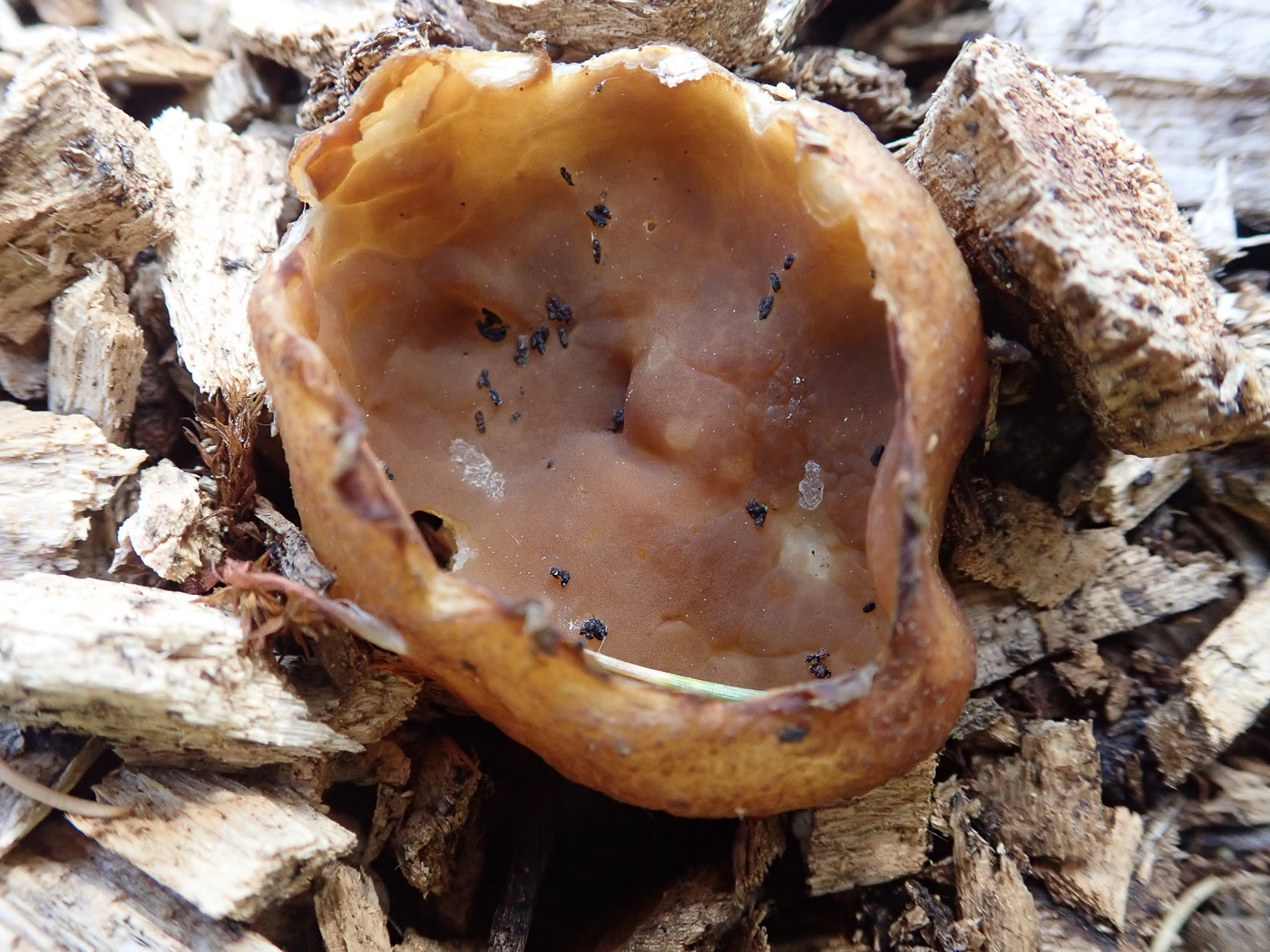
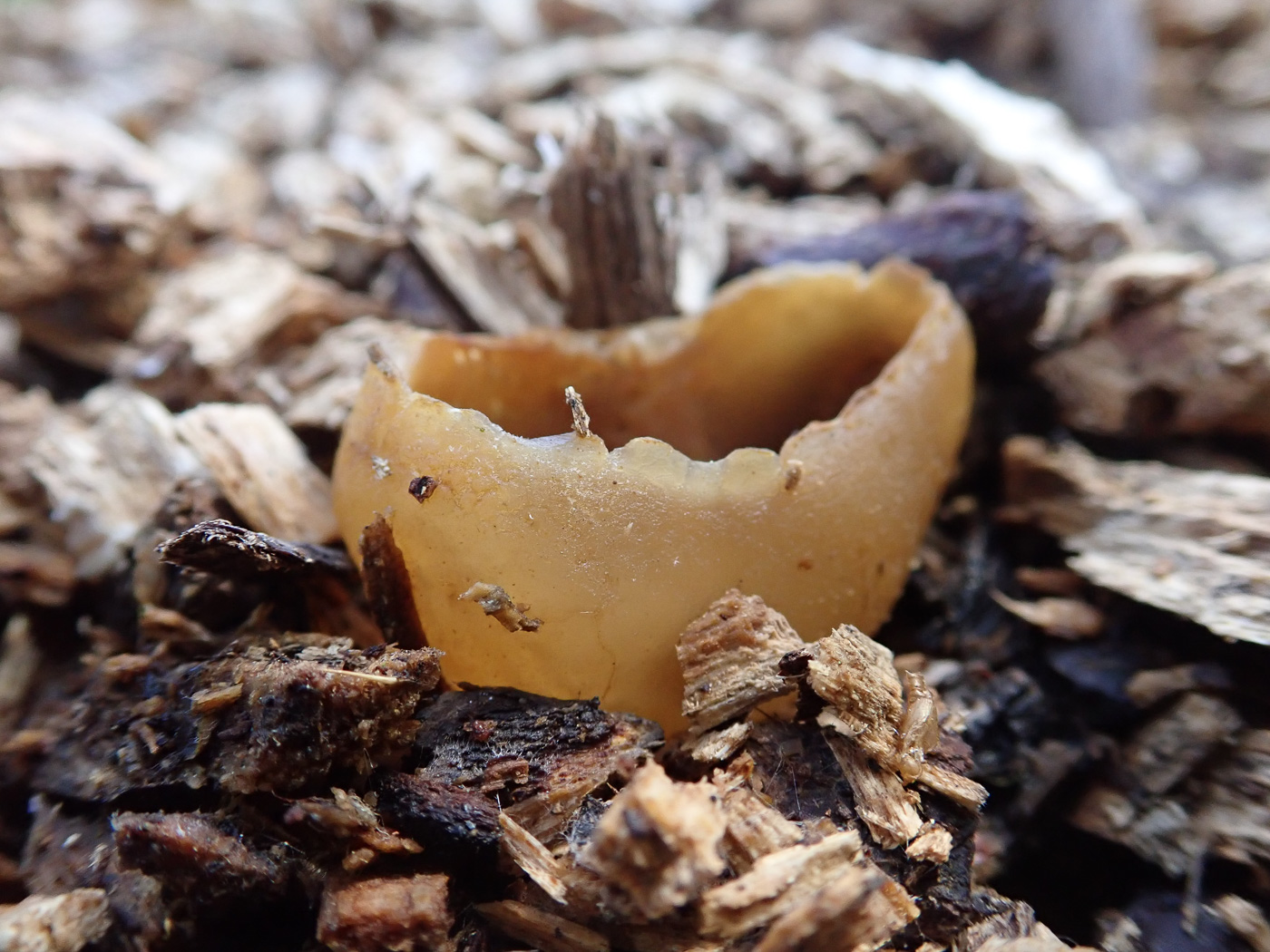 |
May 16th Peziza vesiculosa (Blistered Cup) 
On a woodchip pile of local Sycamore adjacent to the car park at Dancersend (whilst a small group of us were doing some survey work here) Neil Fletcher spotted several sizeable 'cup fungi' which we confidently recognised as a species of Peziza. Knowing that a key and some scope work was required to get to a species name, Derek took the sample home to work on. He initially arrived at the very rare P. megalochondra, bypassing other more common species when taking habitat and micro-details into account, and this would indeed have been an exciting find. Clearly this was a good candidate for DNA sequencing to confirm, but the results showed that it was in fact P. vesiculosa, not nearly as rare but still a nice record with only two previous doubtful records from 1995 for Dancersend. The species normally fruits on rotting hay / straw bales, hence Derek's dismissal when keying it out, but further research shows that it can occur on woodchip piles as well. See also Finds 2022 Jan 3rd for an another example, this one found on a hay bale.
|
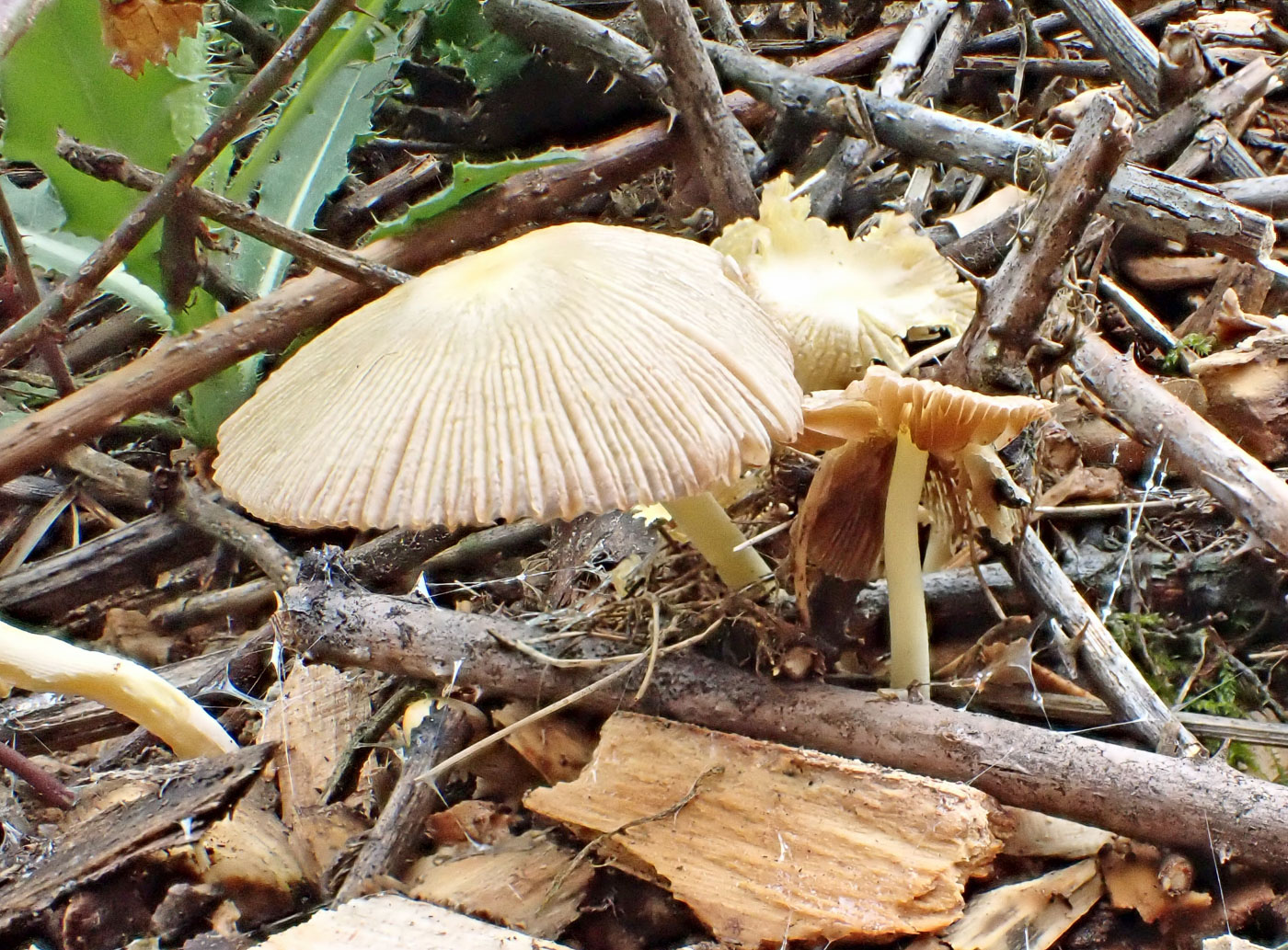 |
May 16th Bolbitius titubans (Yellow Fieldcap)
This was one of only two agarics found by our small group at Dancersend - a common species though more often found from summer onwards in grassy paths rather than on a woodchip pile as here. Its previous name was B. vitellinus and the photo is Neil Fletcher's. We have a choice of other photos on Finds, the best being from 2020: Sept 29th and Nov 1st which show specimens at their beautiful egg yellow stage.
|

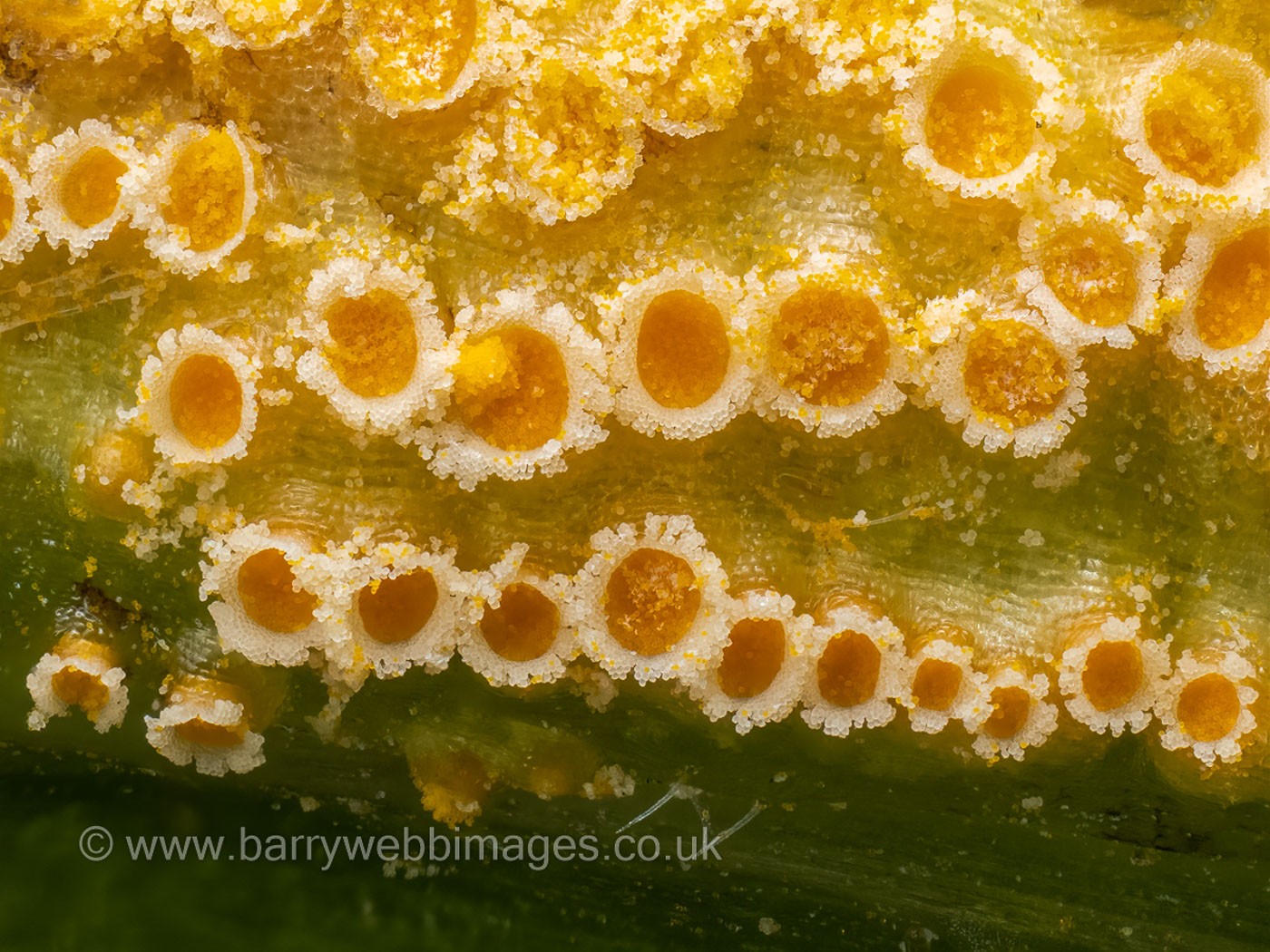 |
May 16th Puccinia urticata (Nettle Clustercup Rust)
On a living nettle stem at Dancersend Justin Long spotted this large patch of rust and bravely collected it (his resultant stinging rash leaving no doubt as to the host plant!) for further identification by Kerry Robinson. Though considered a common species (and previously named P. caricina) we have only one previous county record. Both photos are Barry Webb's.
|

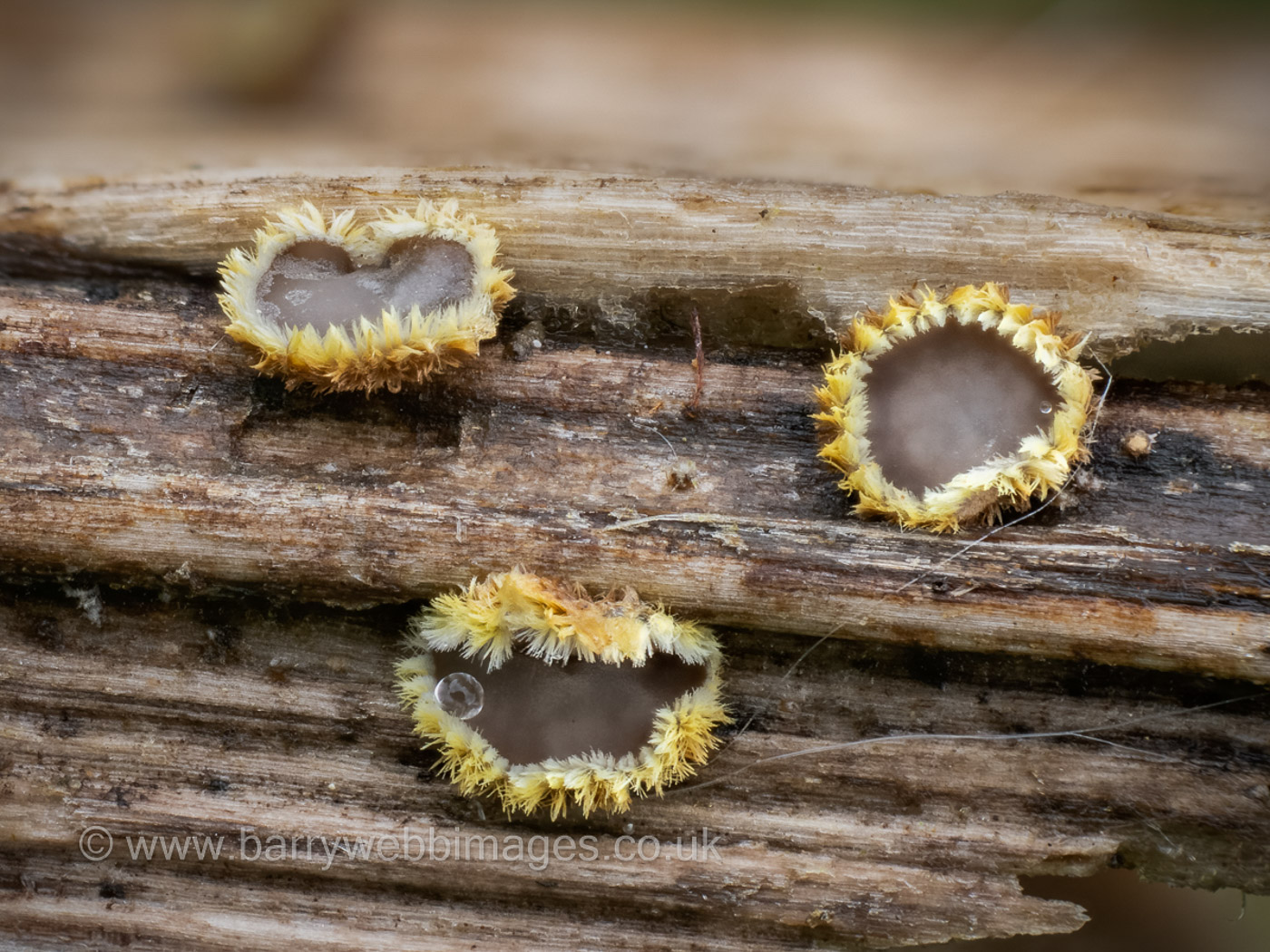 |
May 16th Trichopeziza leucophaea (an Ascomycete with no common name)
Also found on the base of dead umbellifer stems - probably Burdock - at Dancersend today were these rather distinctive tiny grey-brown discs with yellow hairs around the edge. Though they unfortunately missed being examined by Kerry Robinson later, they seem distinctive enough to name, being closely related to T. mollissima (and indeed growing on the same stem) but clearly differing in their colour. The species appears to be new to the county. (Photo 1 is by Neil Fletcher, photo 2 is by Barry Webb.)
|
 |
May 16th Lachnella alboviolascens (a cyphelloid Basidiomycete)
At Dancersend, where a few of us were doing some survey work, several interesting things turned up including this tiny cluster of grey 'discs' found on the end of an Ash twig. Thought at the time to be maybe a species of Lachnum or Mollisia (i.e. a typical small Ascomycete) it was not until Derek together with Asco expert Kerry Robinson examined it later under the scope that its true identity was revealed! Described as occasional in England but probably quite common but either misidentified or overlooked, this is a first for the county. (The photo is Barry Webb's)
|
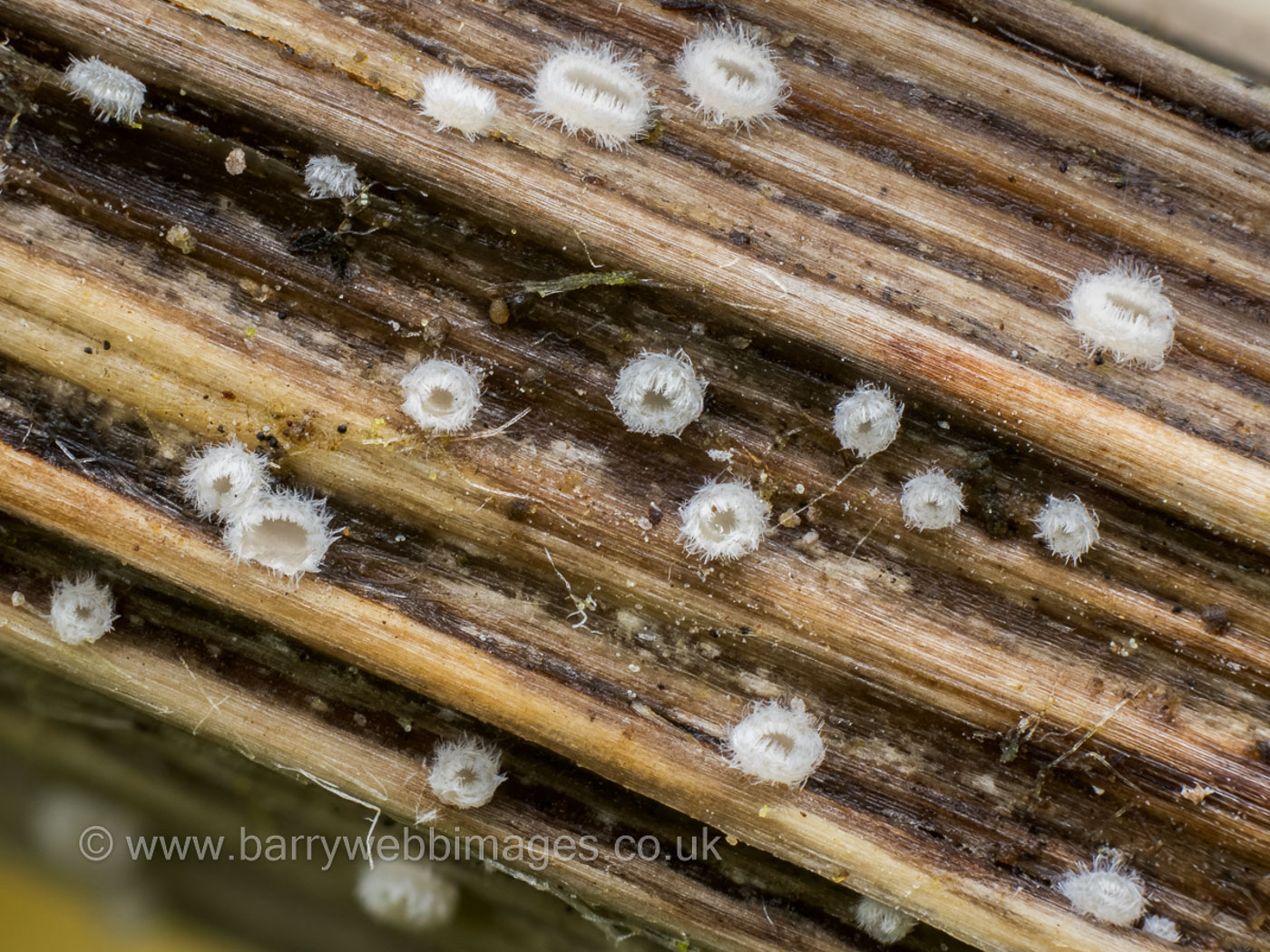 |
May 16th Trichopeziza mollissima (a Discomycete with no common name)
Also at Dancersend today several dead umbellifer stems were found having various tiny discs towards their base, later identified for us by Kerry Robinson. This tiny white hairy species seemed to be quite common today but we appear to have no previous county records. Previously Lachnum mollissimum, the name Trichopeziza (i.e. like a hairy Peziza) seems to describe it well. (Both photos are Barry Webb's)
|

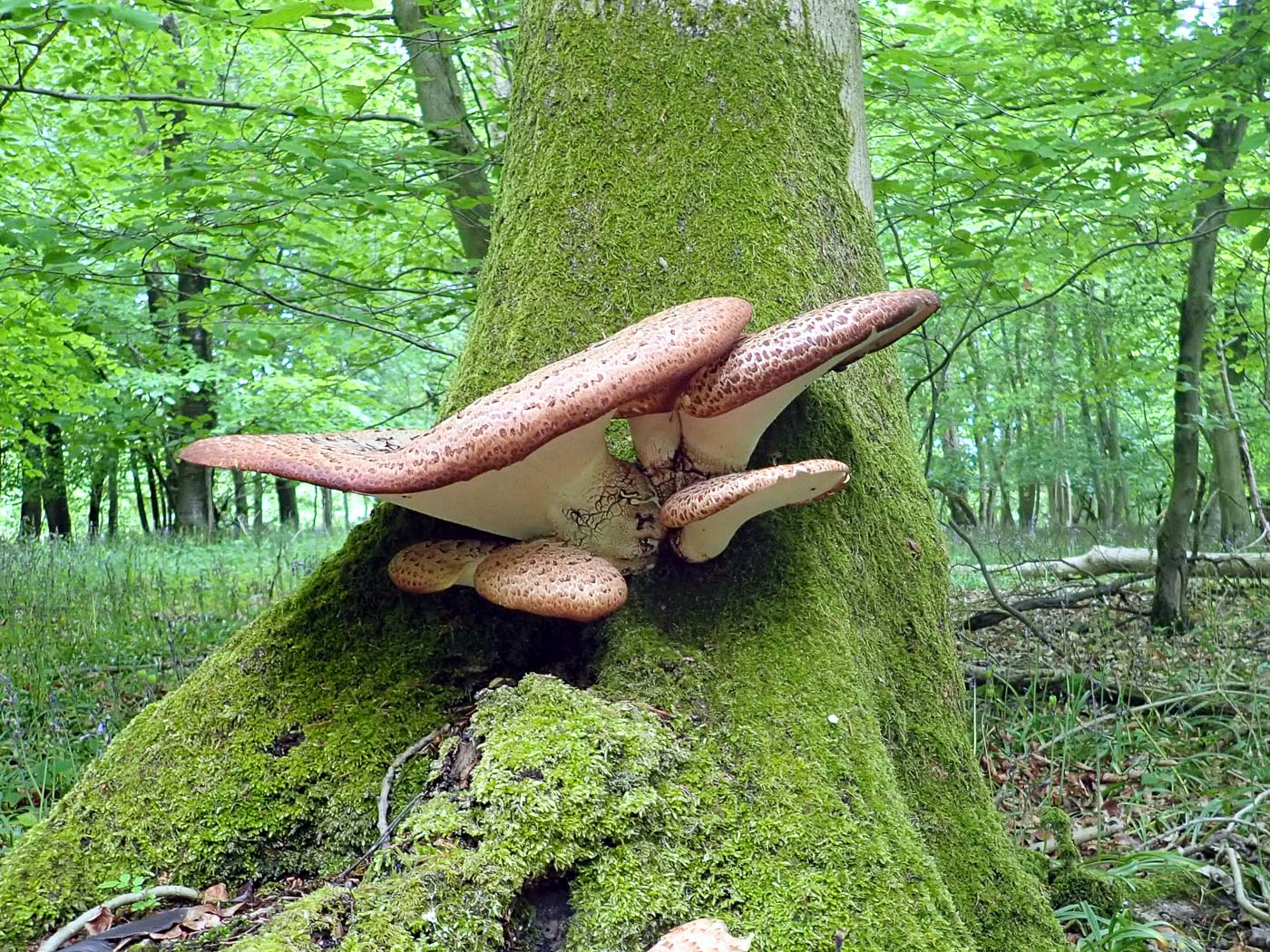
 |
May 16th Cerioporus squamosus (Dryad's Saddle)
At Dancersend (where a few of us were taking part in some survey work for BBOWT) conditions were very dry and generally unproductive, so it was a nice treat to come across this large and pristine specimen of a very common but beautiful polypore on an Ash trunk. Here we have yet another recent genus name change to contend with - from Polyporus to Cerioporus. In fact it appears that of our common polypores only P. tuberaster remains in that genus! What was P. varius = leptocephalus is now also moved to Cerioporus; what was P. badius = durus is now moved to Picipes; what were P. brumalis and P. ciliatus are now moved to Lentinus. (Photo 3, taken by Mick Jones, gives an idea of scale as well as being a nice group photo!)
|
May 7th 2022
 |
May 7th Mitrula paludosa (Bog Beacon)
At Burnham Beeches Barry Web took this stunning photo of this aptly named Spring-fruiting Ascomycete. It was not in the Mire area where we found it last year (see Finds 2021 May 5th) but in a sloping wet flush in woodland. It stands no more than 50mm tall and is not often recorded, its habitat requirements being very specific and it can be found in late spring to summer in really wet areas growing on soggy remnants of vegetation. We have records only from this site and Danesborough in the north of the county.
|
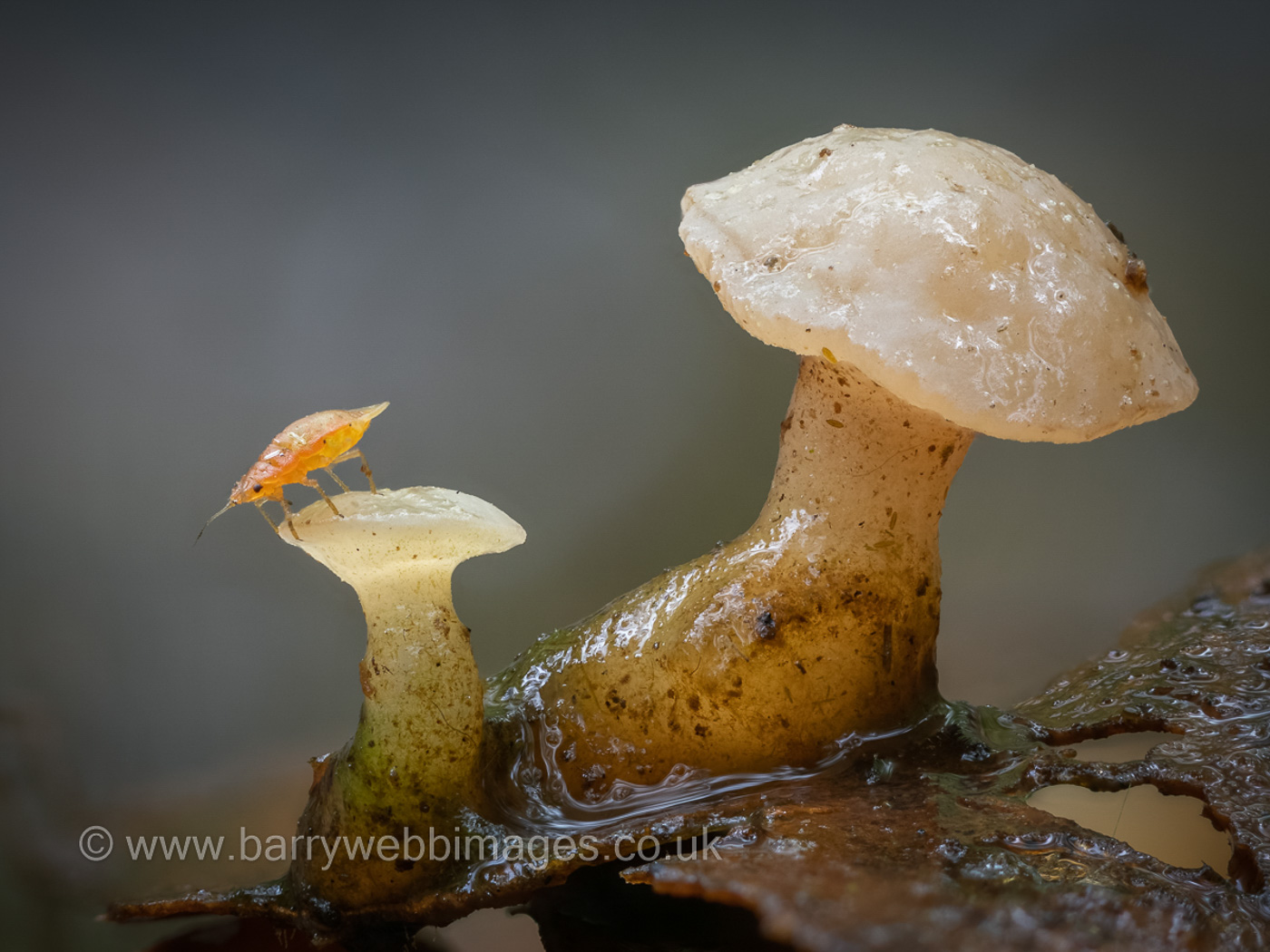 |
May 7th Cudoniella clavus (Spring Pin)
Adjacent to his beautiful specimens of Bog Beacon in a wooded sloping wet flush at Burnham Beeches, Barry Webb noticed these very small whitish 'mushrooms' growing in the wet woody debris, later identified by Derek from this photo. Though looking mushroom-shaped, the species in fact has no gills or pores underneath and is an Ascomycete, closely related to the much more common and also smaller Cudoniella acicularis (Oak Pin) - see Finds 2020 Oct 22nd, also Finds 2021 Feb 01, and for another example of today's species see Finds 2021 May 5th - also from Burnham Beeches. It is not that common and we have only a handful of previous records, though fruiting as it does at this time it may well get overlooked.
|
May 6th 2022
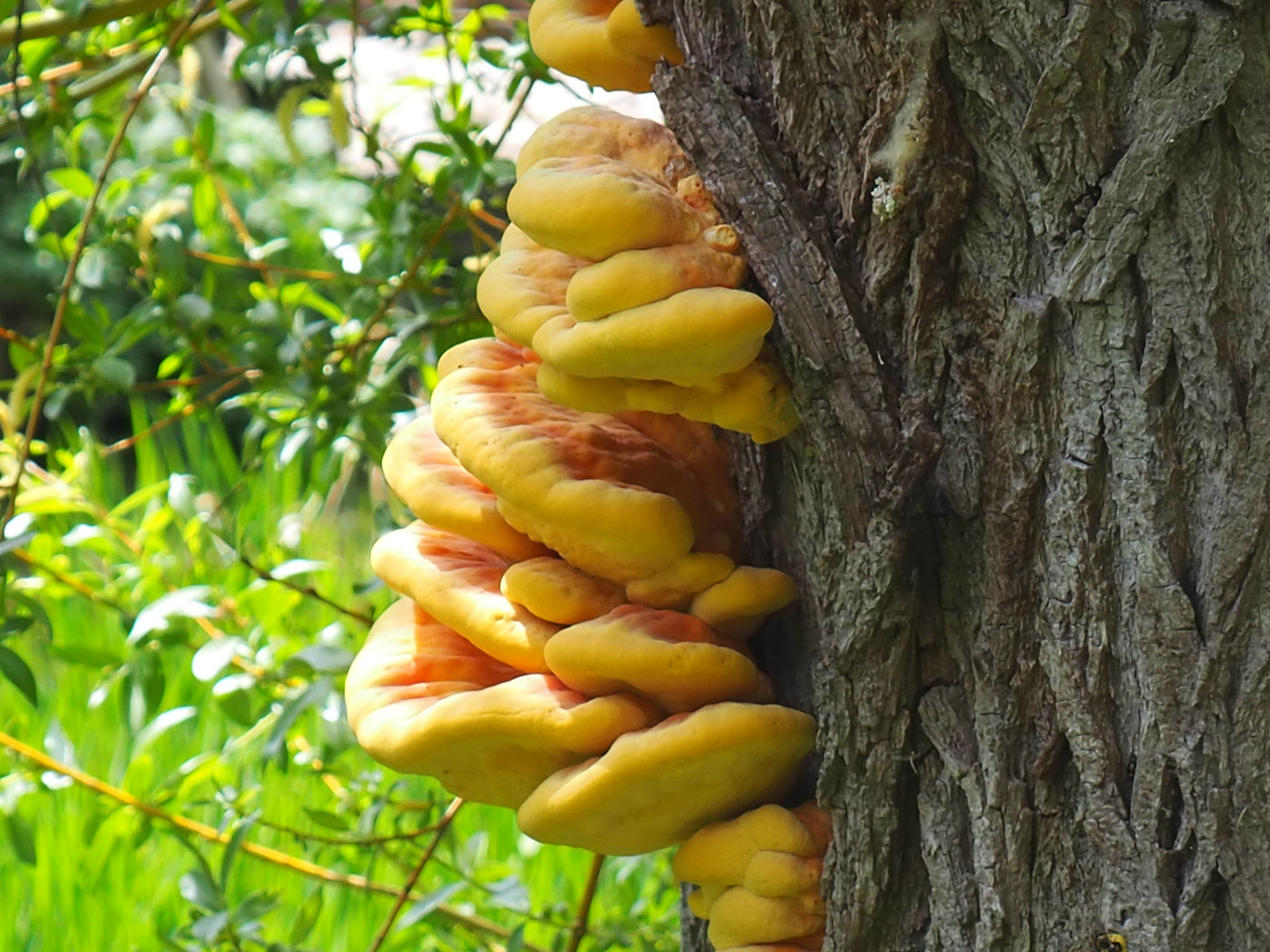 |
May 6th Laetiporus sulphureus (Chicken of the Woods)
On a living Willow adjacent to the river Wye in High Wycombe John and Leslie Catterson spotted this beautiful specimen pretty well in perfect condition - a sight for sore eyes when fungi is in short supply owing to the recent dry spell. However, dry conditions are much less likely to affect fungi growing on wood rather than in soil as is the case here. This common species often starts appearing in early summer, so is one to look out for now. It can be found on a range of different hosts, even Yew.
|
May 4th 2022
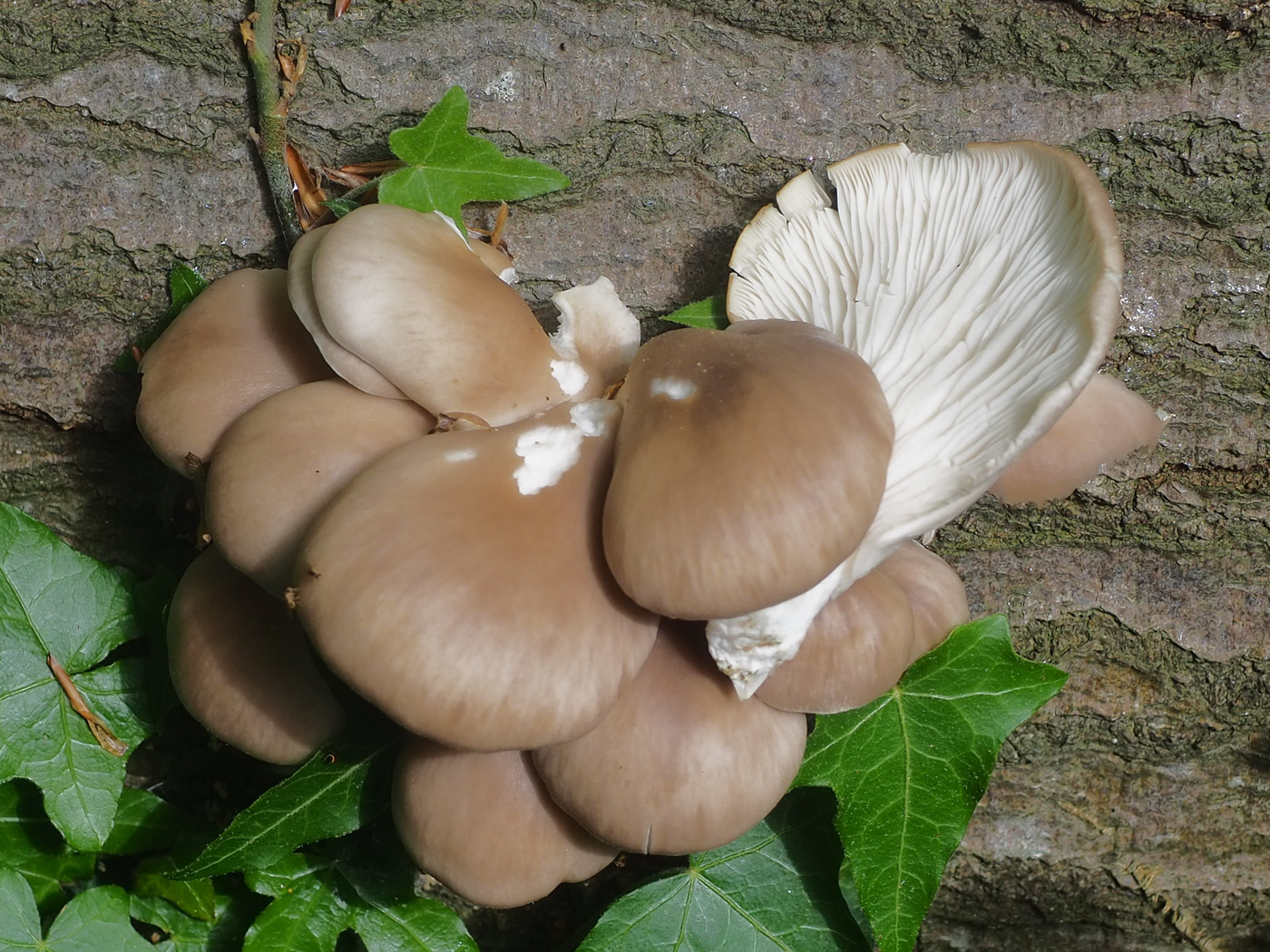 |
May 4th Pleurotus ostreatus (Oyster Mushroom)
Another sight for sore eyes! On a deciduous log in Great Tinkers Wood John and Leslie Catterson found this surprisingly fresh and photogenic cluster - surprising because of the recent dry spell which has affected the fruiting of many species. As with their find above here, species growing on wood are still able to fruit even when there's been no significant rain.
|
April 25th 2022
April 18th 2022

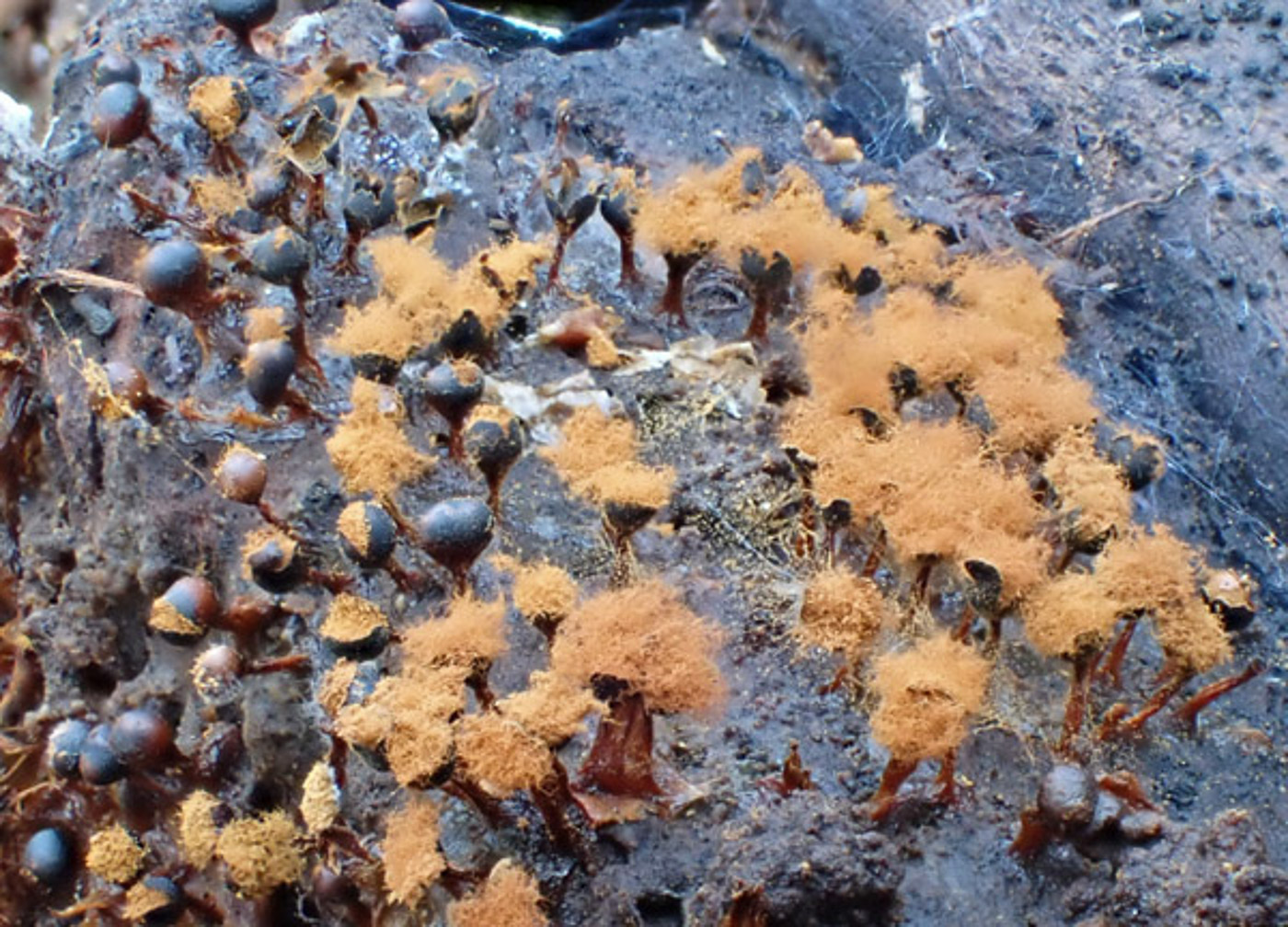
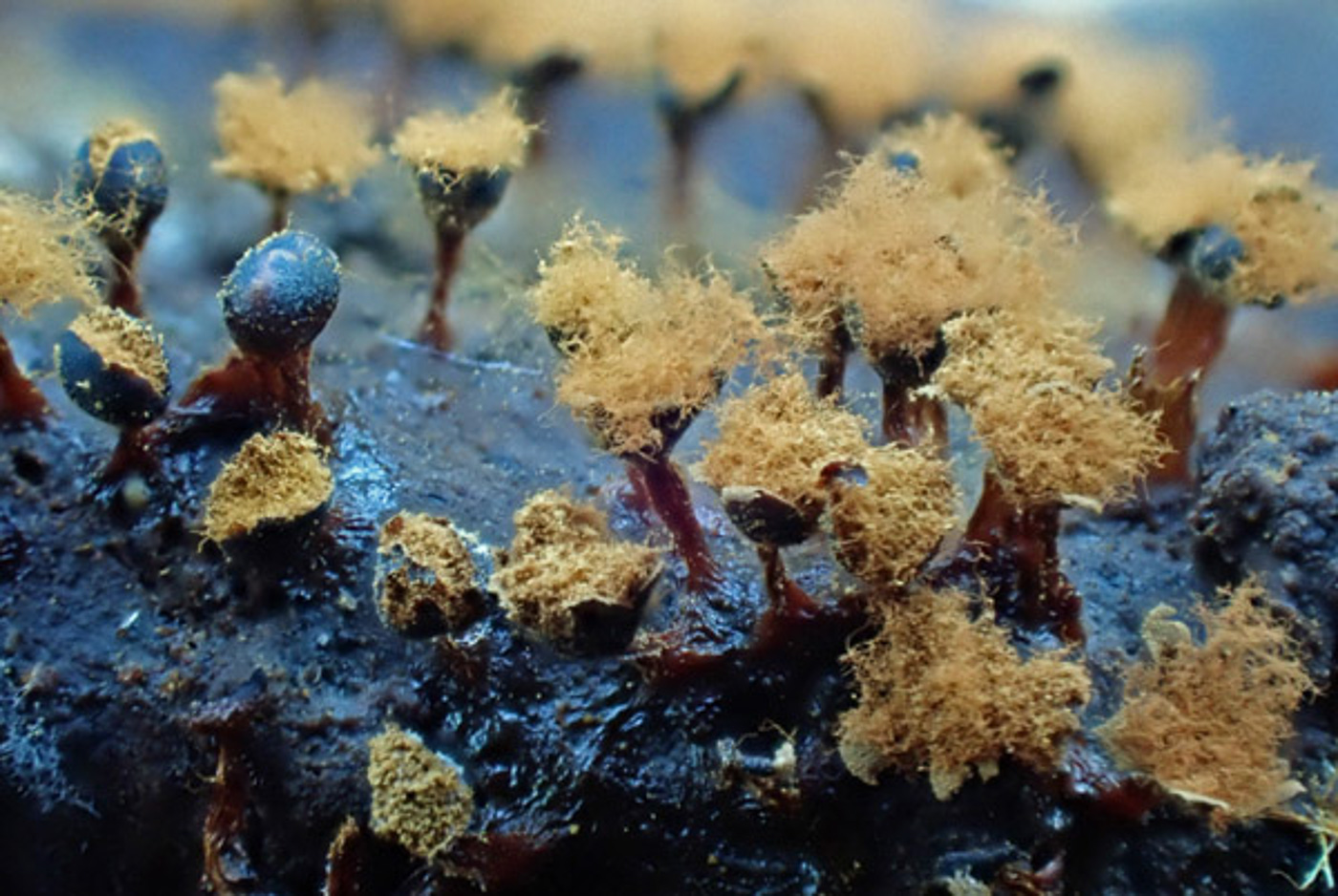
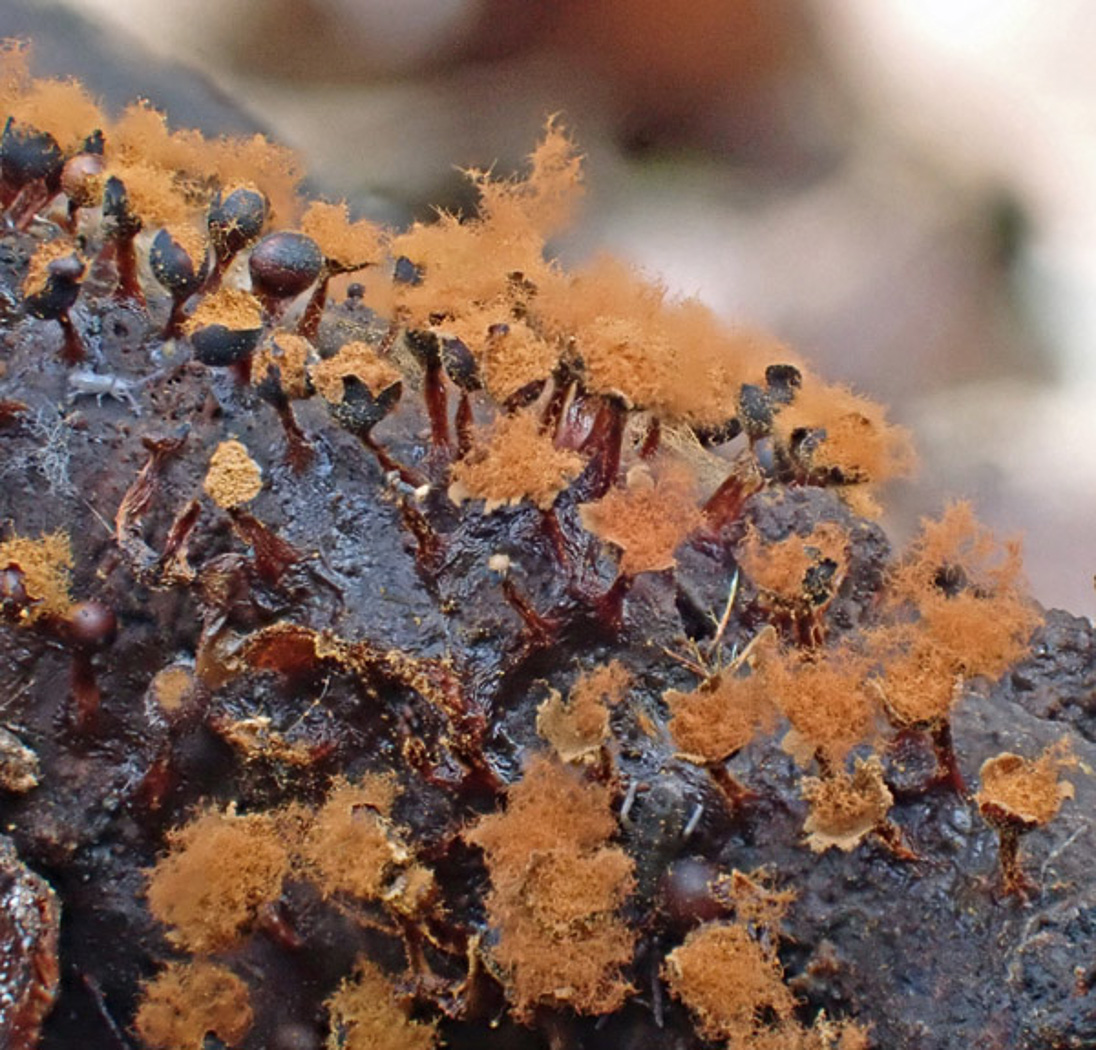 |
April 18th Metatrichia floriformis (a Slime Mould with no common name)
At Hampden Common Neil Fletcher spotted a large patch of this common and distinctive slime mould on damp rotting wood. (We also found this species on our Walk at Rushbeds Wood a couple of days earlier.) His photos show some sporangia (the fruiting bodies) still closed with round shiny black heads on stalks as well as those which are mature and have split open like the petals of a flower to reveal the orange spore mass within. (See also dated Jan 12th and March 23rd.)
|
April 14th 2022
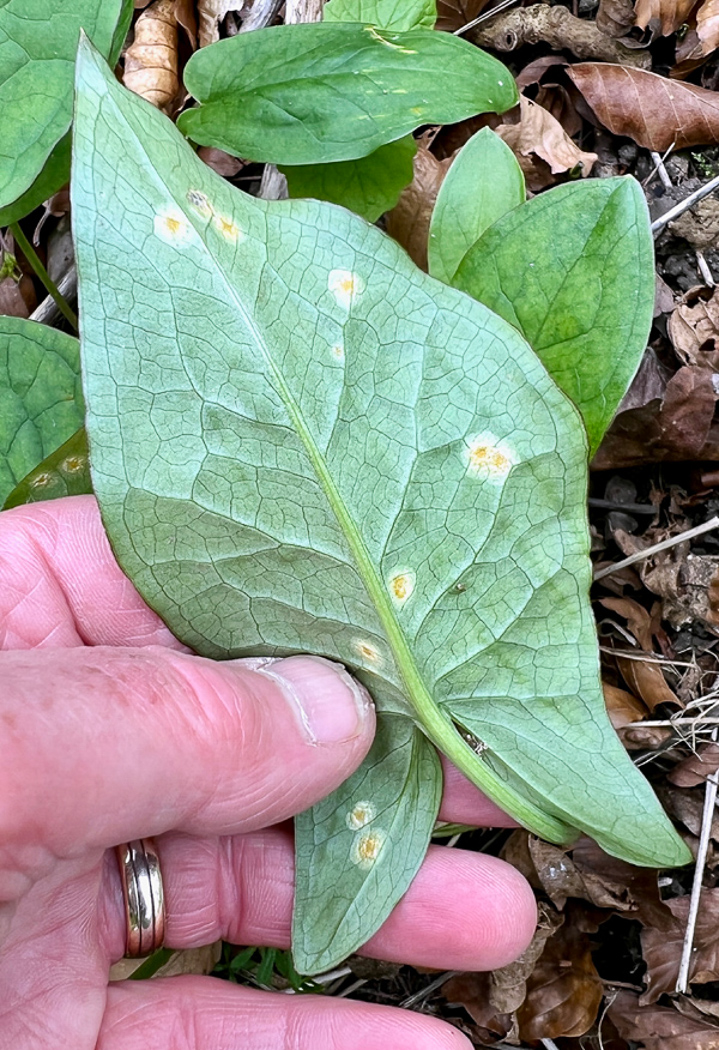 |
April 14th Puccinia sessilis (Arum Rust)
At Dancersend Reserve Neil Fletcher found this quite common rust on leaves of Arum maculatum (Lords and Ladies). The very dark blotches seen on many leaves of this plant are in fact part of the plant and very rarely are caused by a fungus, though as in Neil's photo here these blotches are not always present. The rust causes small orange patches on both sides of the leaf and the fungus is very common at this time.
|
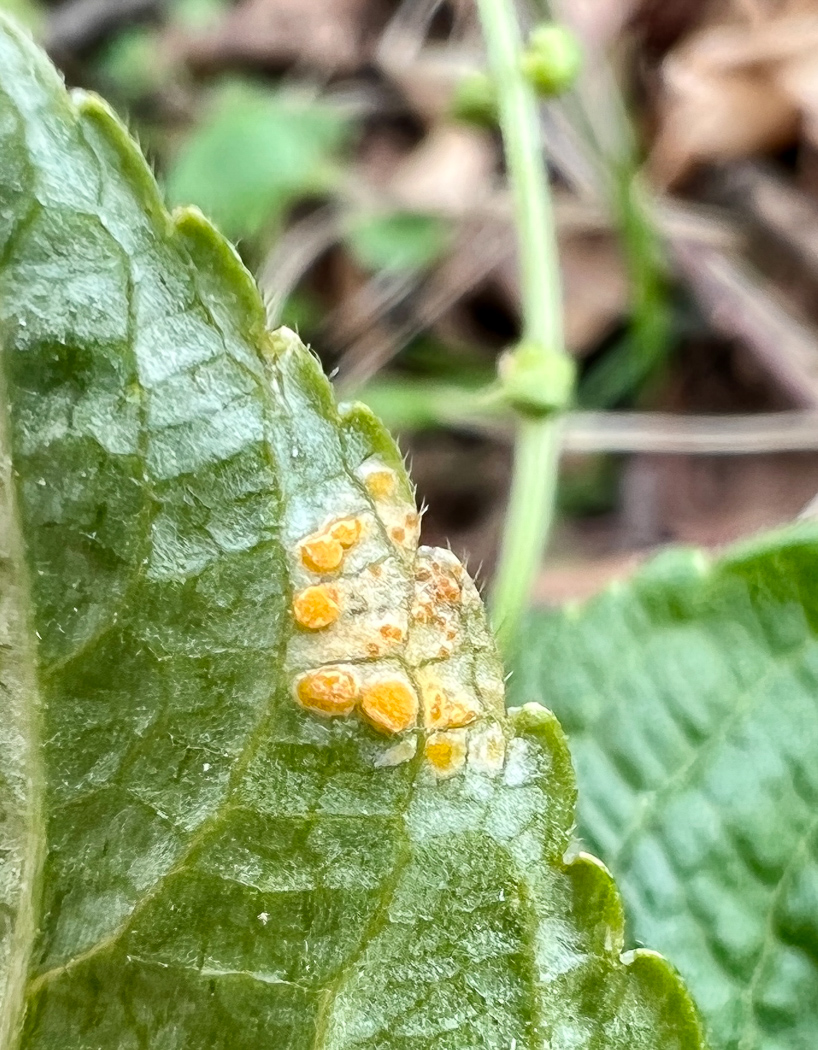
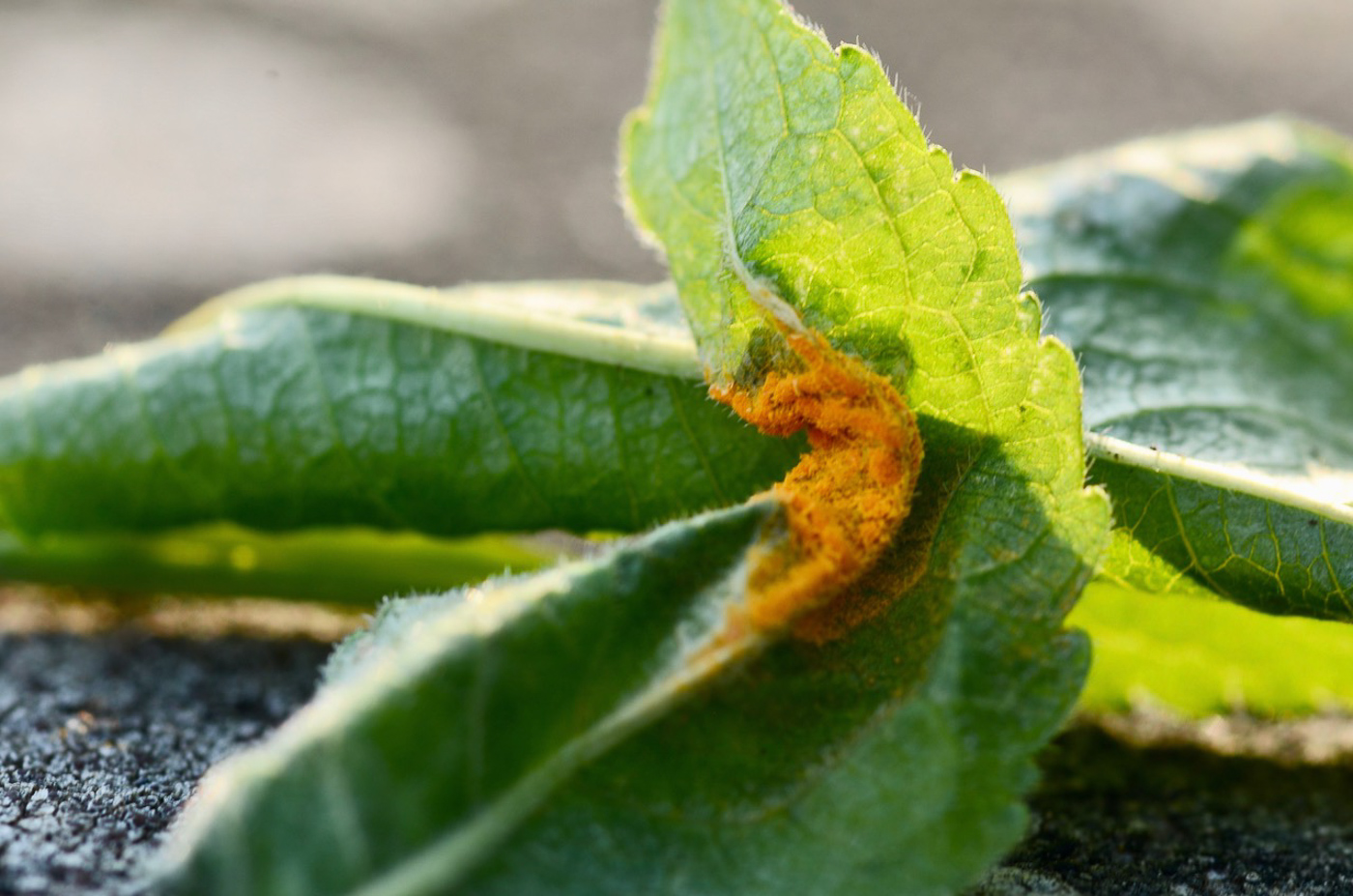
 |
April 14th Melampsora rostrupii (Dog's Mercury Rust)
Neil Fletcher found this common rust fruiting in abundance on Dog's Mercury at Dancersend (photo 1) and reported to Penny that M. populnea (the name by which it was previously known) is now known to be a species complex occurring on various different hosts. The new name M. rostrupii now applies only to the rust fungus which is host specific to Dog's Mercury as here. Photos 2 and 3 were taken by Linda Seward two days later on our Walk at Rushbeds Wood. (See Penny's report on Rushbeds Wood April 16th for further photos of what we found there.)
|
April 12th 2022
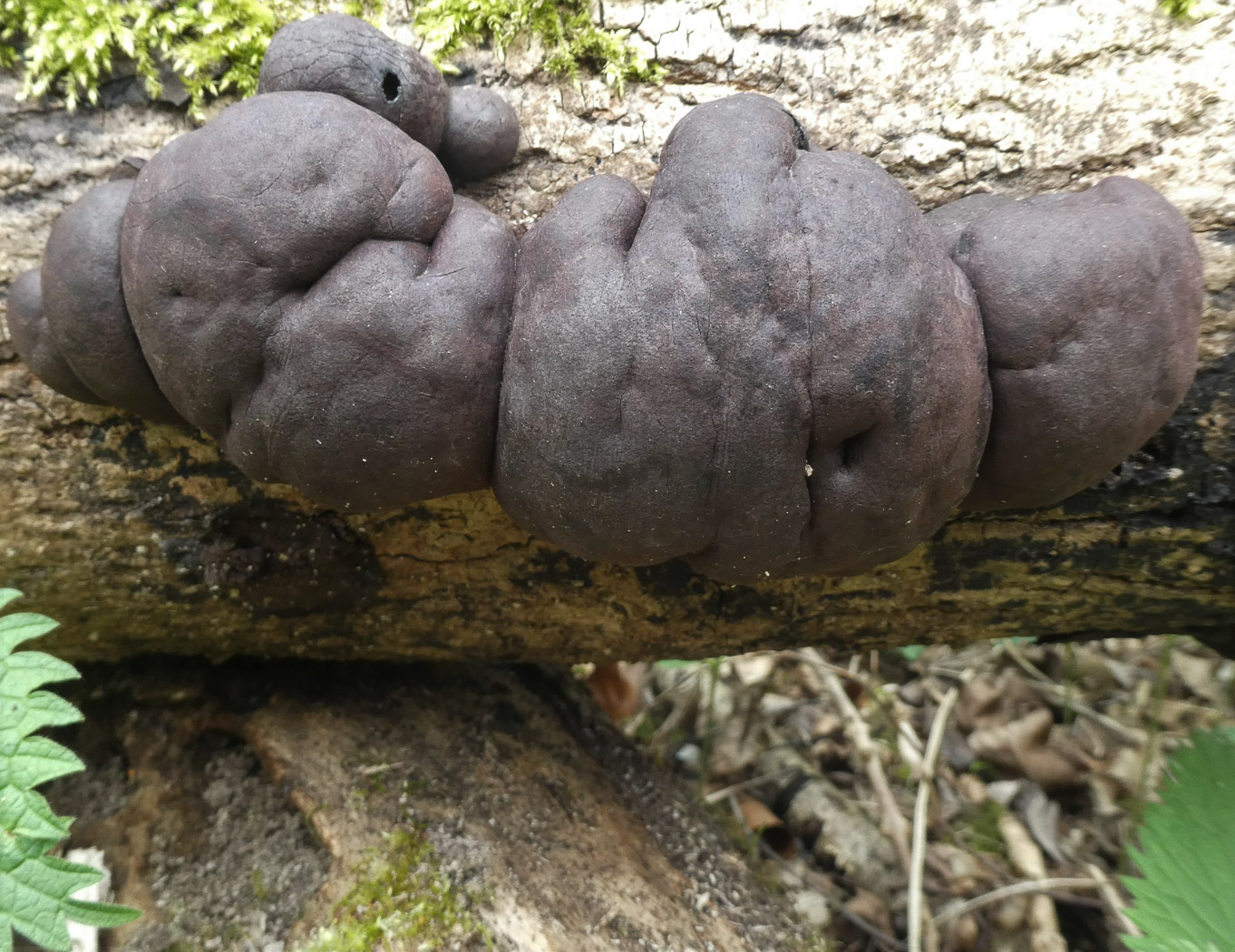
 |
April 12th Daldinia concentrica (King Alfred's Cakes / Cramp Balls)
On fallen Ash near Chalfont St. Peter Jim Wills noticed these nice examples of a common Ascomycete - one of the largest Pyrenomycete species which can get to about 4cm across or more, sometimes singly, sometimes clustered as here. Today's were about 3cm across and still at the cocoa brown stage; later they become shiny and black and photo 2 shows the typical concentric rings revealed when a specimen is broken open. It is very common on dead and dying Ash. See also Find 2020 October 10th (though surprisingly we have no entries for 2021.)
|
April 10th 2022
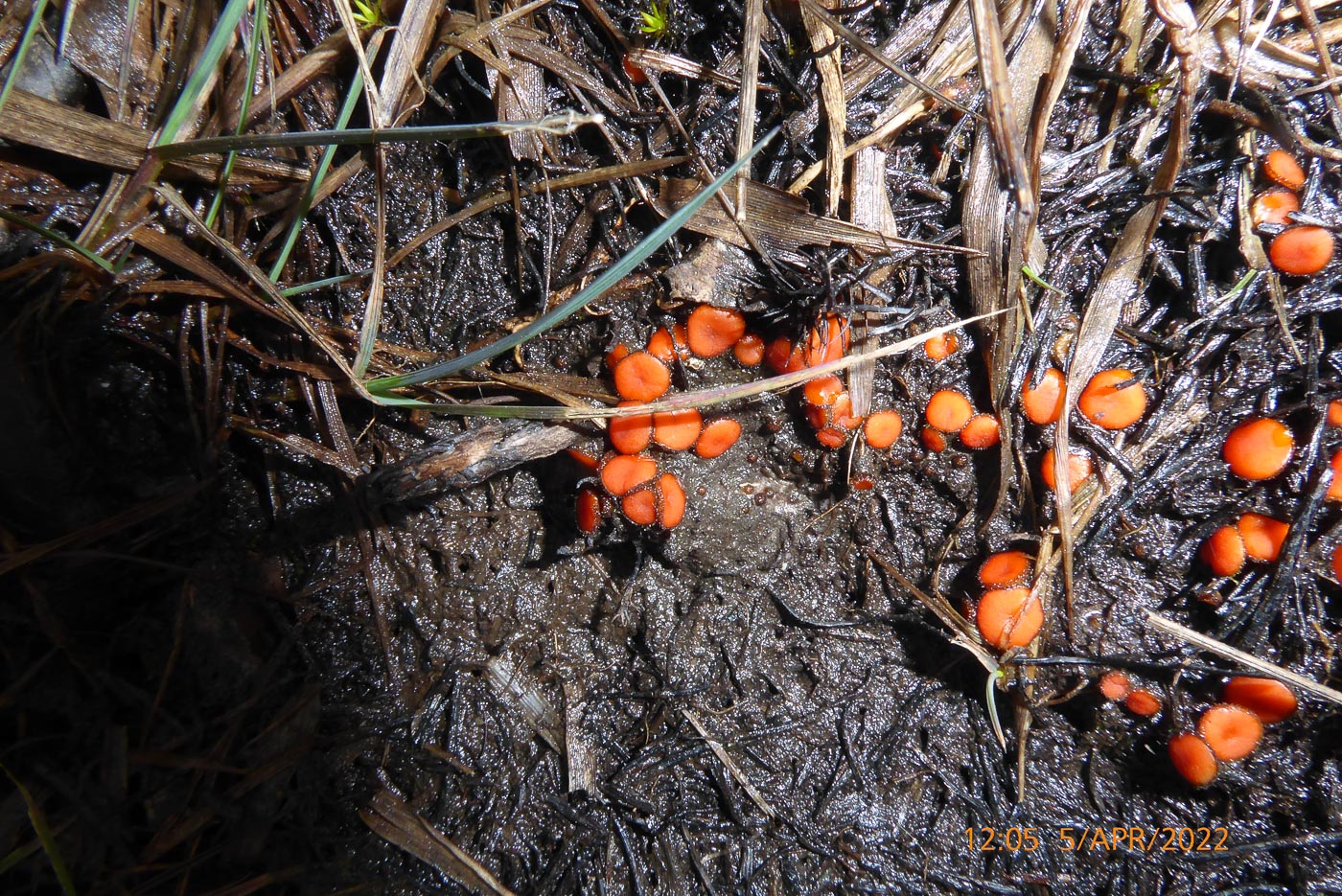
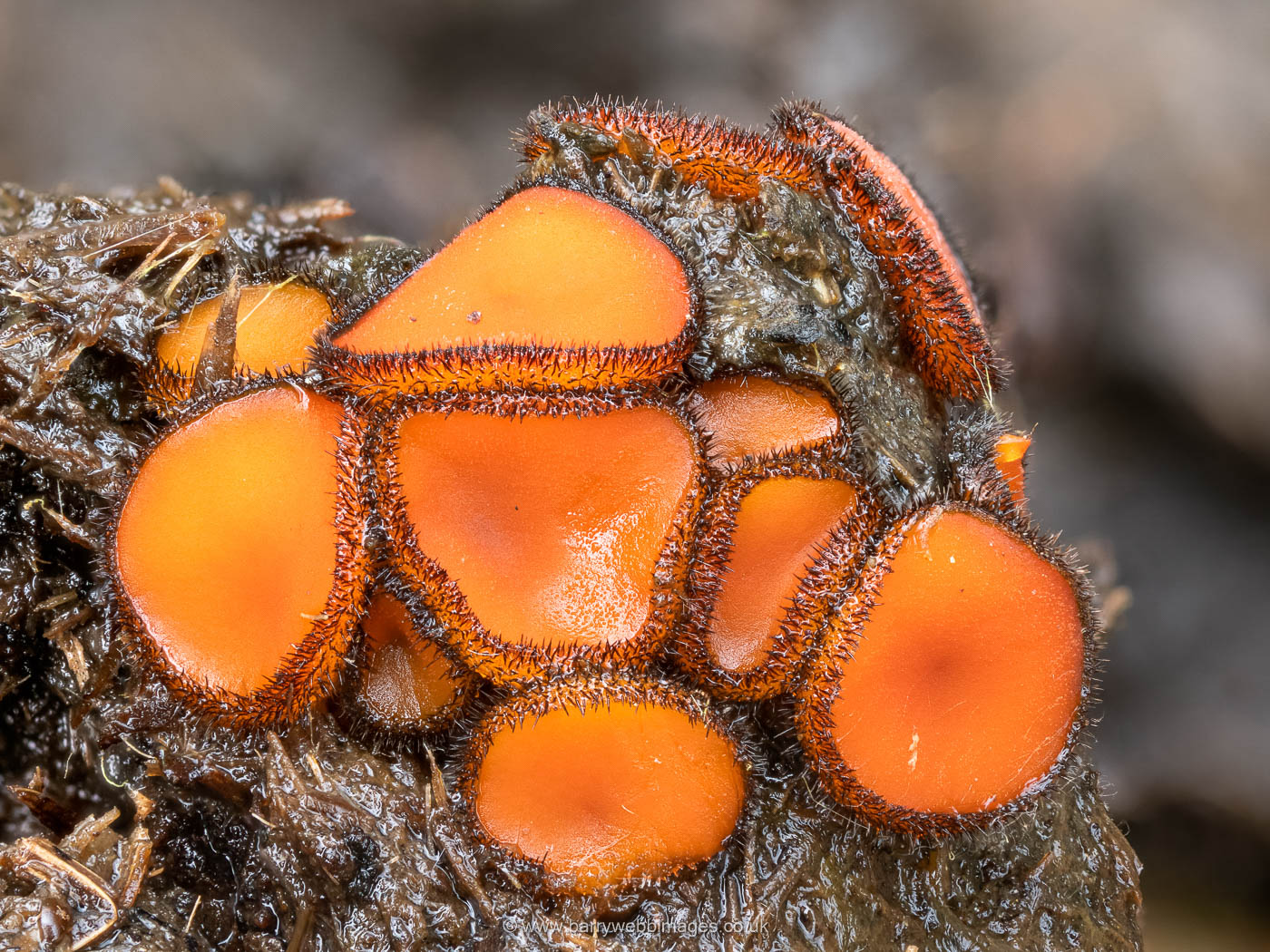 |
April 10th Scutellinia mirabilis (a rare Eyelash fungus) 
5 days previously Penny received photo 1 from Jim Wills taken at Stoke Common, but as there are many such small red ascos it is never advisable to attempt an identification without recourse to a scope. However, by chance the same species was collected there by Claire Williams and Barry Webb a few days later, and Barry then returned for a further sample (photo 2) to take to Penny and Derek at the Easter w/e Rushbeds Walk. Both worked on it at home and came to the same name - always gratifying especially when it's a rare species like this one (though Barry says it was fruiting in good numbers on soil in several areas). This is an Eyelash fungus with much shorter 'eyelashes' than in the common S. scutellata, also the spores are larger and have different characteristics. It is not only new to the site and the county but there appears to be only one previous English record, from Lancs, also one from Scotland and one from Ireland.
|
April 9th 2022
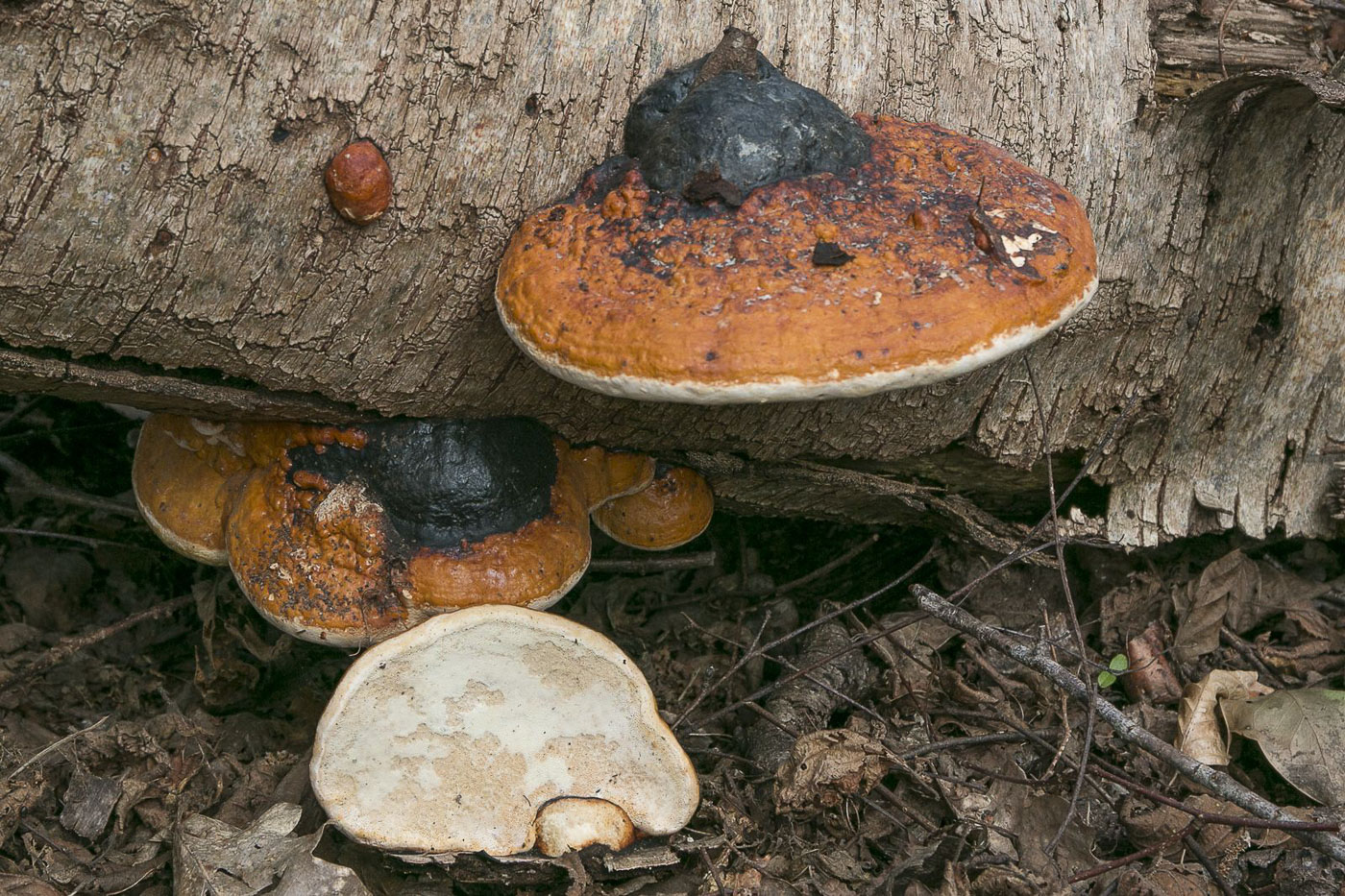 |
April 9th Fomitopsis pinicola (Red-belted Bracket)
In Egypt Woods, Burnham Beeches Claudi Soler found these rare brackets on a fallen Birch trunk. Though more often found on conifer (hence it's common name) it can also occur on deciduous trunks, particularly Birch, and is possibly on the increase in the UK though is not considered rare further south (eg France). It is a hard bracket like a Ganoderma and its colour is variable but the orange-red zone around the perimeter is the feature which distinguishes it. We have just one previous county record from Linford Lakes near Milton Keynes, found in 2019, so this is a nice find and new to the site.
|
April 7th 2022
 |
April 7th Calocybe gambosa (St. George's Mushroom) 
In a sheep paddock at Stampwell Farm Jackie Ewan was surprised to see this cluster of mushrooms emerging so early in April. St. George's Day being April 23rd, this is indeed early for it to appear, especially as last year our only siting of it was on May18th! (See Finds 2021.) This is a fairly easy species to identify, being the only chunky pale 'Tricholomatoid' mushroom to appear in late April, often in grassy glades. It also has a very distinctive mealy smell and often comes up consistently near to April 23rd, hence its common name. As this was so early Jackie took the trouble to check the spore size just in case, but the collection looks spot on leaving no doubt.
|
March 23rd 2022
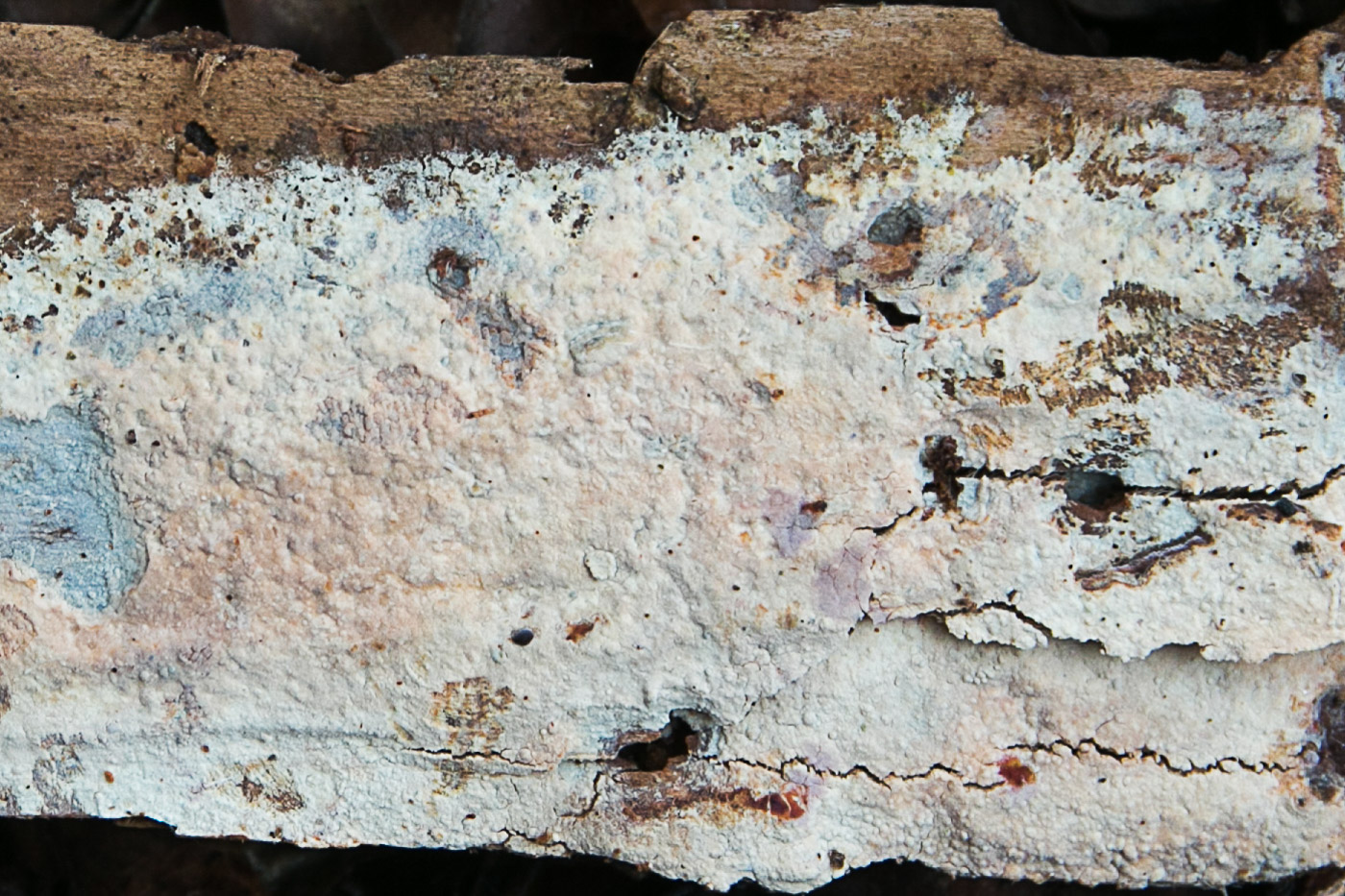 |
March 23rd Hyphodontia alutaria (a Corticioid with no common name) 
On a bare fallen Pine trunk in Burnham Beeches Claudi Soler noticed this whitish flat patch - typical of a good many such species - and took it home to work on with a scope, then compared notes with Kerry Robinson who confirmed his identification. Not a rarity but with only a handful of county records, this was new to the site today and occurs on both coniferous and deciduous woods. This is our first image of the species on Finds.
|
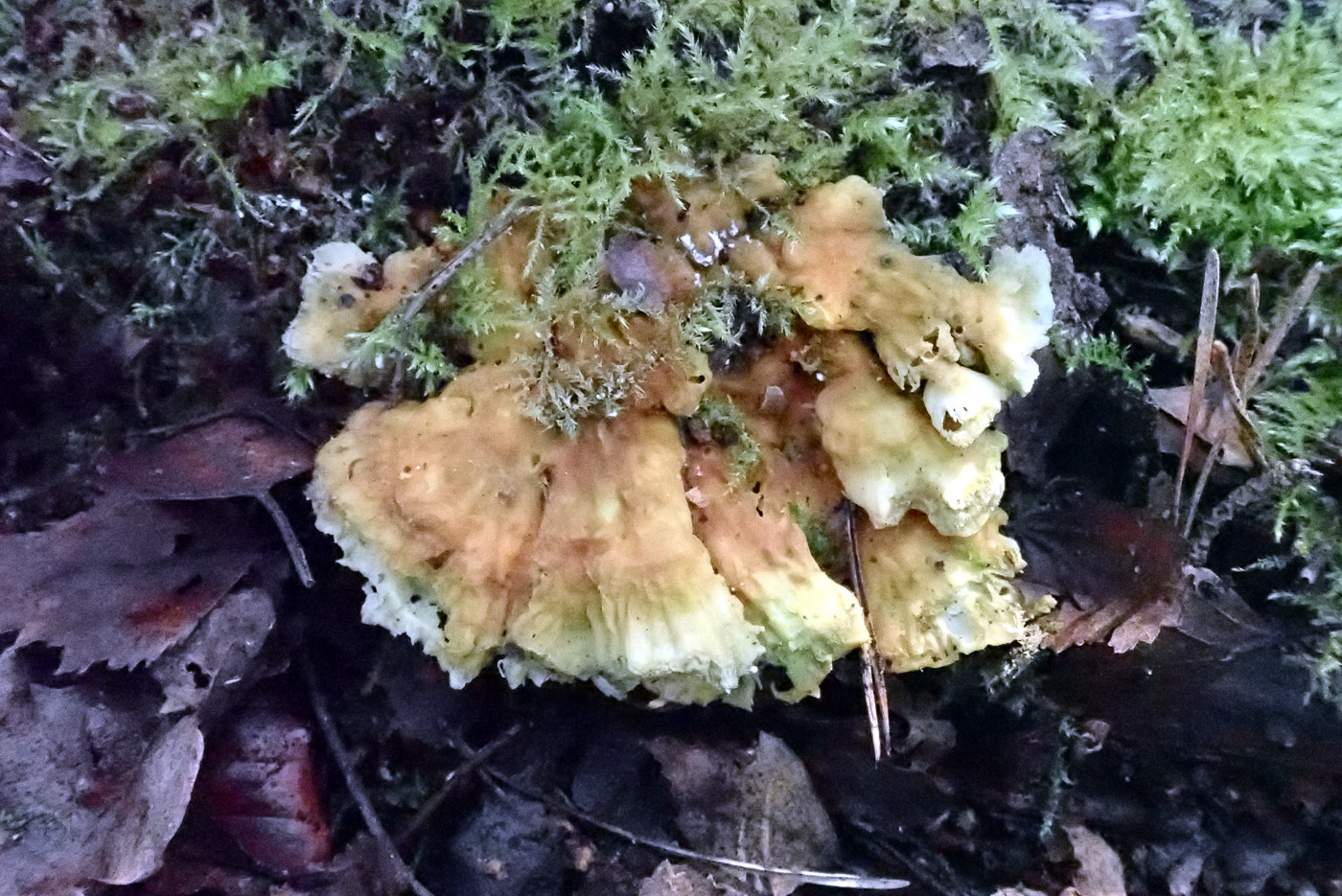
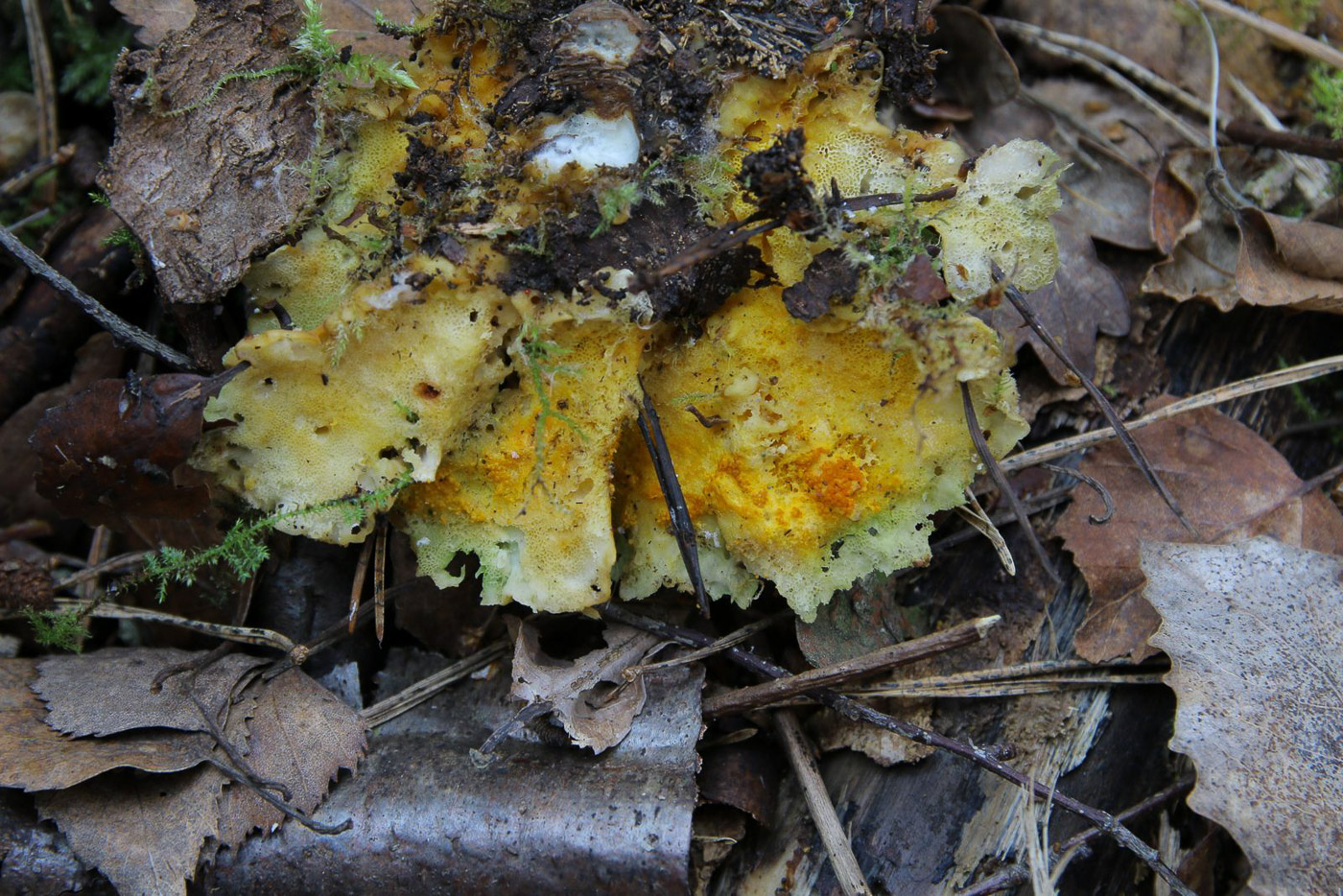 |
March 23rd Hypomyces aurantius (Orange Polypore Mould)
Noticing a rather soggy and strangely orange coloured bracket on rotting fallen deciduous wood in Burnham Beeches, Penny took a further look underneath where the distinctly orange roughened surface of this paracitic Hypomycete was very apparent. Though named Polypore Mould, this species is common on many different fungi, particularly Trametes versicolor (Turkeytail) - today's host. (Photo 1 is Penny's photo, 2 is Claudi Soler's). This is our first image of the species on Finds.
|
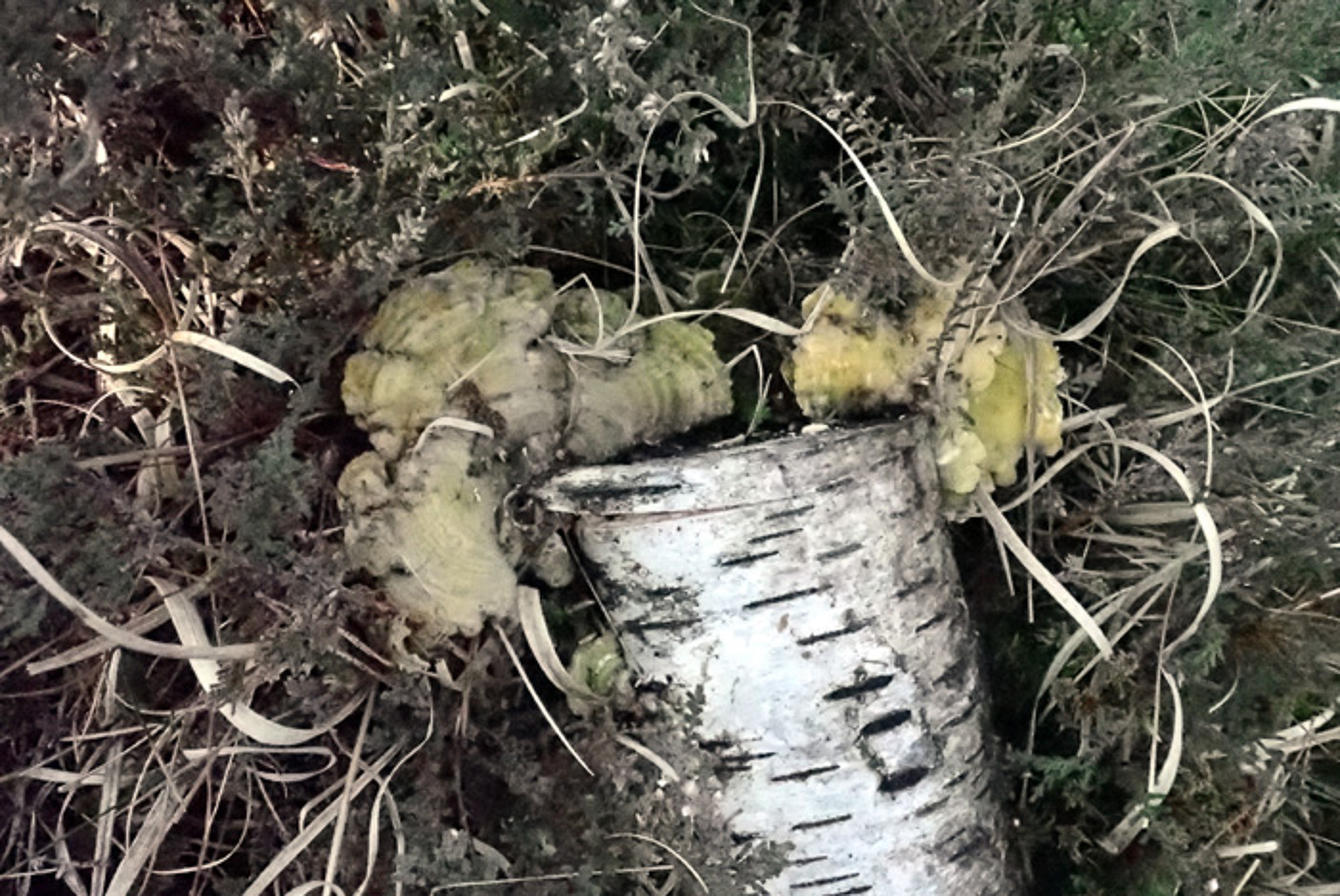
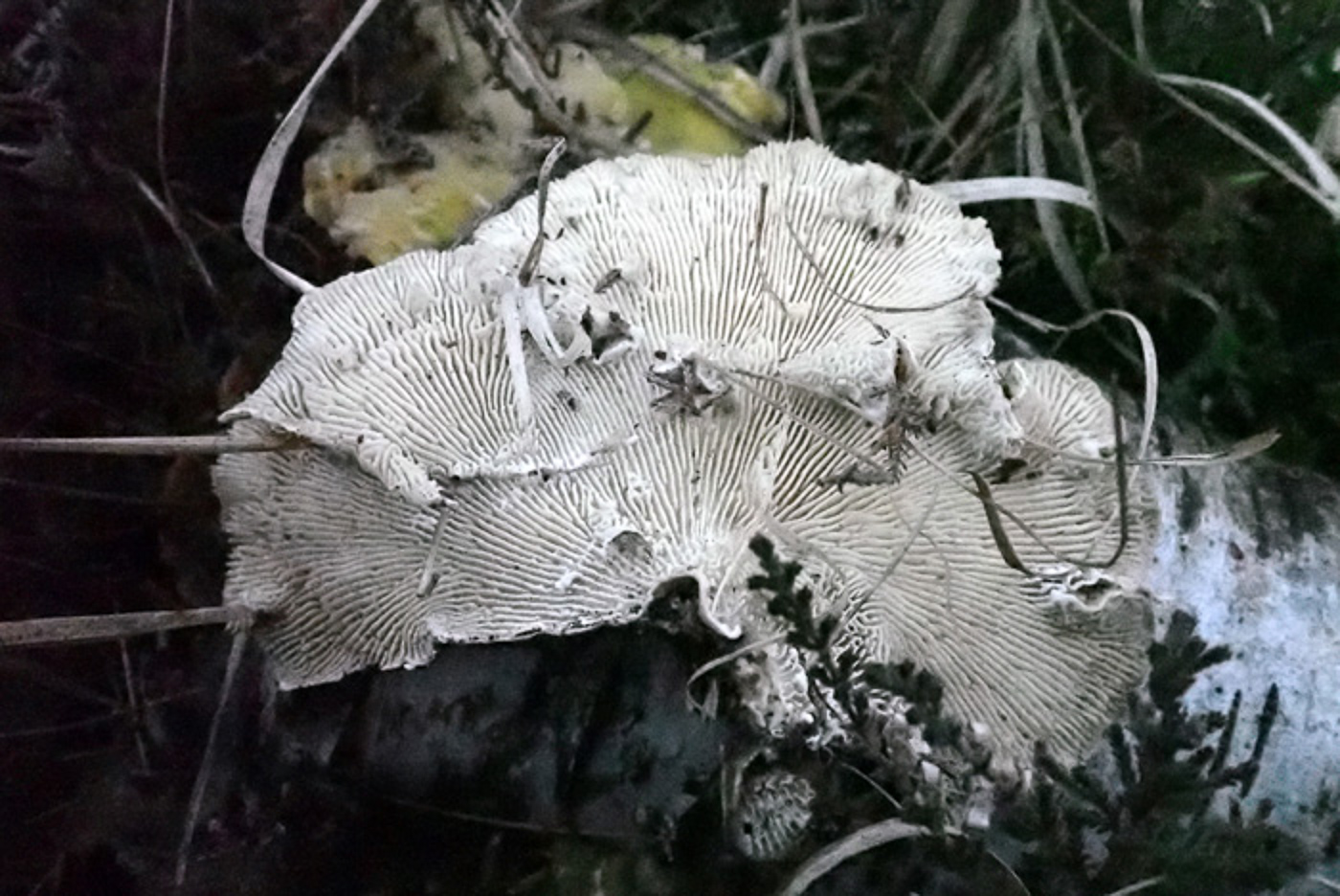 |
March 23rd Lenzites betulinus (Birch Mazegill)
On the end of a fallen Birch branch in the Mire at Burnham Beeches Penny noticed this cluster of rather soggy brackets, and turning one over revealed the distinct gill-like ridged structure of this species which helps to separate it in the field from similar brackets such as Trametes. It is considerably less common than that genus but seems to have been becoming more frequent in recent years. See also Feb 12th, and in 2020 Oct 22nd and Nov 15th.
|
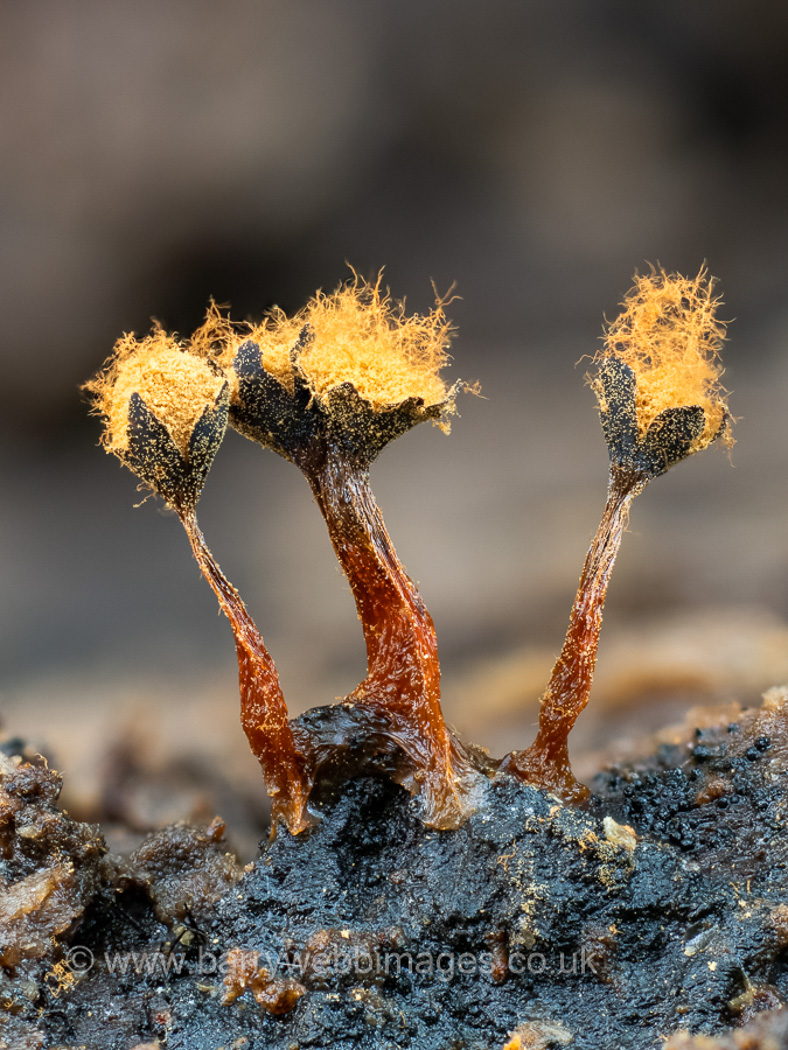 |
March 23rd Metatrichia floriformis (a slime mould with no common name)
In Burnham Beeches this was one of two fairly common slime mould species Barry Webb found on fallen rotting Birch. See also Jan 12th, with further images on Barry's separate Finds page.
|
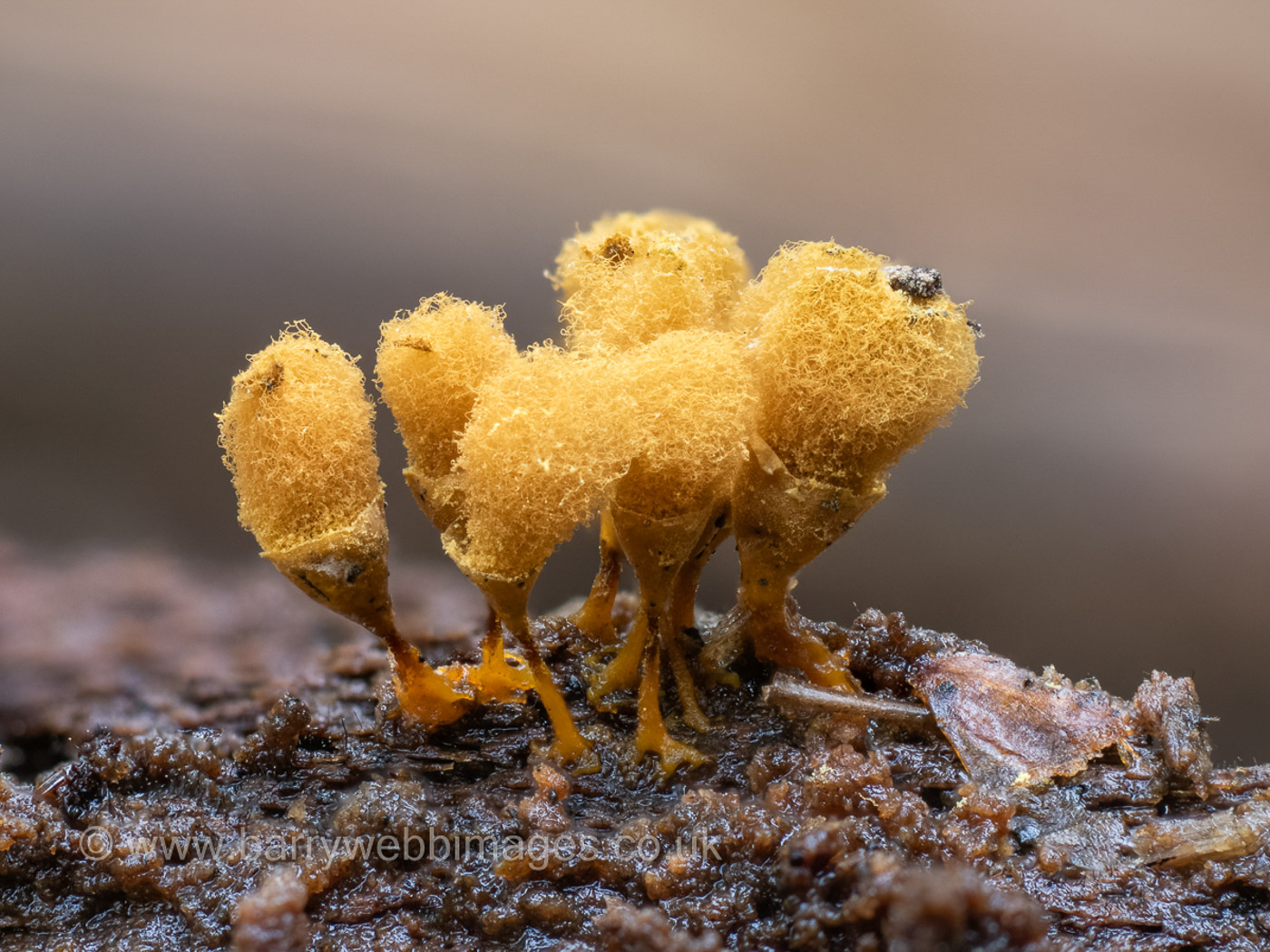 |
March 23rd Hemitrichia calyculata (a slime mould with no common name)
In Burnham Beeches this was the second of two fairly common slime mould species Barry Webb found on fallen rotting Birch. For more images see Barry's separate Finds page.
|
March 17th 2022
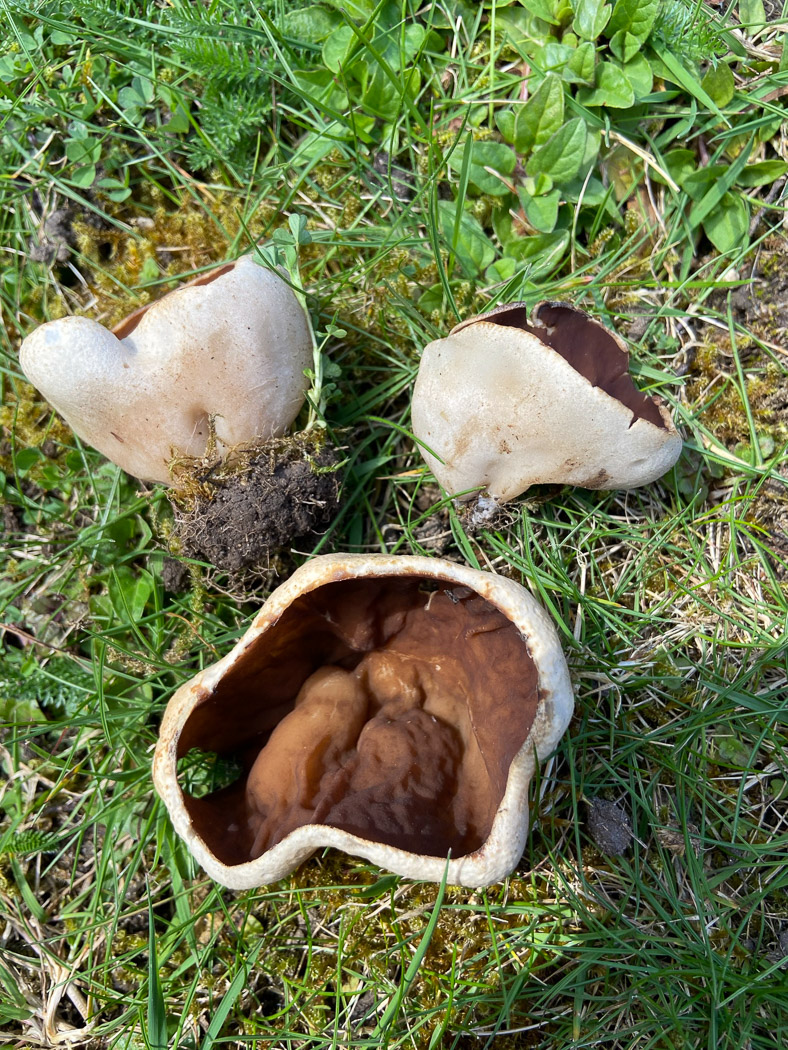 |
March 17th Disciotis venosa (Bleach Cup) 
In her mother's garden in Tylers Green Sarah Ebdon spotted these impressive cups, had no idea what they were, so took them home to work on. As they were clearly not either Peziza or Otidea, she was stumped but had noticed the distinctive pervasive bleachy smell and thought this must be a useful clue. So she googled 'bleach cup fungi' and up came the answer. She then checked that the microscopic features matched, which they did - Bingo! This is an occasional springtime species, occurring in woodland soil and also garden lawns and beds and has a brown furrowed / wrinked inner surface with a paler pruinose outer surface with a small stem, often somewhat buried in the soil. Another quite similar species to look out for now is Paxina acetabulum, another brown Peziza-like cup which occurs in woodland litter in Spring - this one has a smooth inner surface but prominent veins / ribs on the outer surface extending onto its hollow stem. (It is sometimes known as Cabbage Leaf Helvella.)
|
March 8th 2022
 |
March 8th Entoloma clypeatum (Shield Pinkgill)
In a private garden in Brill Joanna Dodsworth found this Spring to early Summer fruiting species - not one of your small LBJs as many of this genus are, but quite a chunky sizeable species and one which associates with Hawthorn and other woody members of the Rosaceae family. It has a mealy smell and the cap can get to 10 cm across or more, and - as found here - often occurs in rosebeds in gardens. See also Finds 2021 May 29th.
|
March 7th 2022
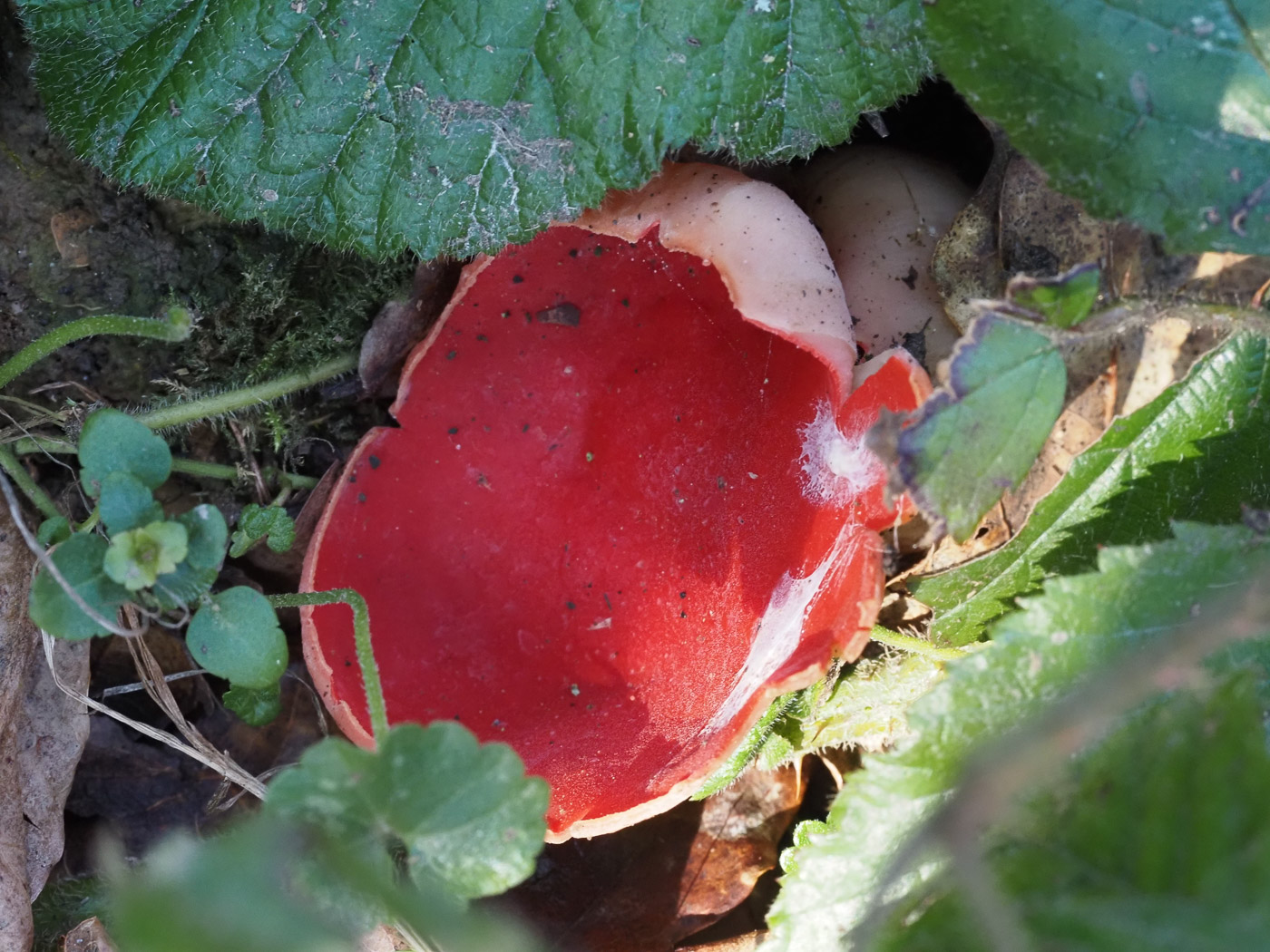 |
March 7th Sarcoscypha austriaca (Scarlet Elfcup)
In Naphill Common Claire Williams spotted the telltale bright red colour of this beautiful species on fallen rotting deciduous wood and peeping through the undergrowth near Daisy Pond. Though not a rarity this is our first record from Naphill Common and it's not uncommon for the species to continue fruiting through the spring months - even into May. So still one to look out for.
|
March 4th 2022


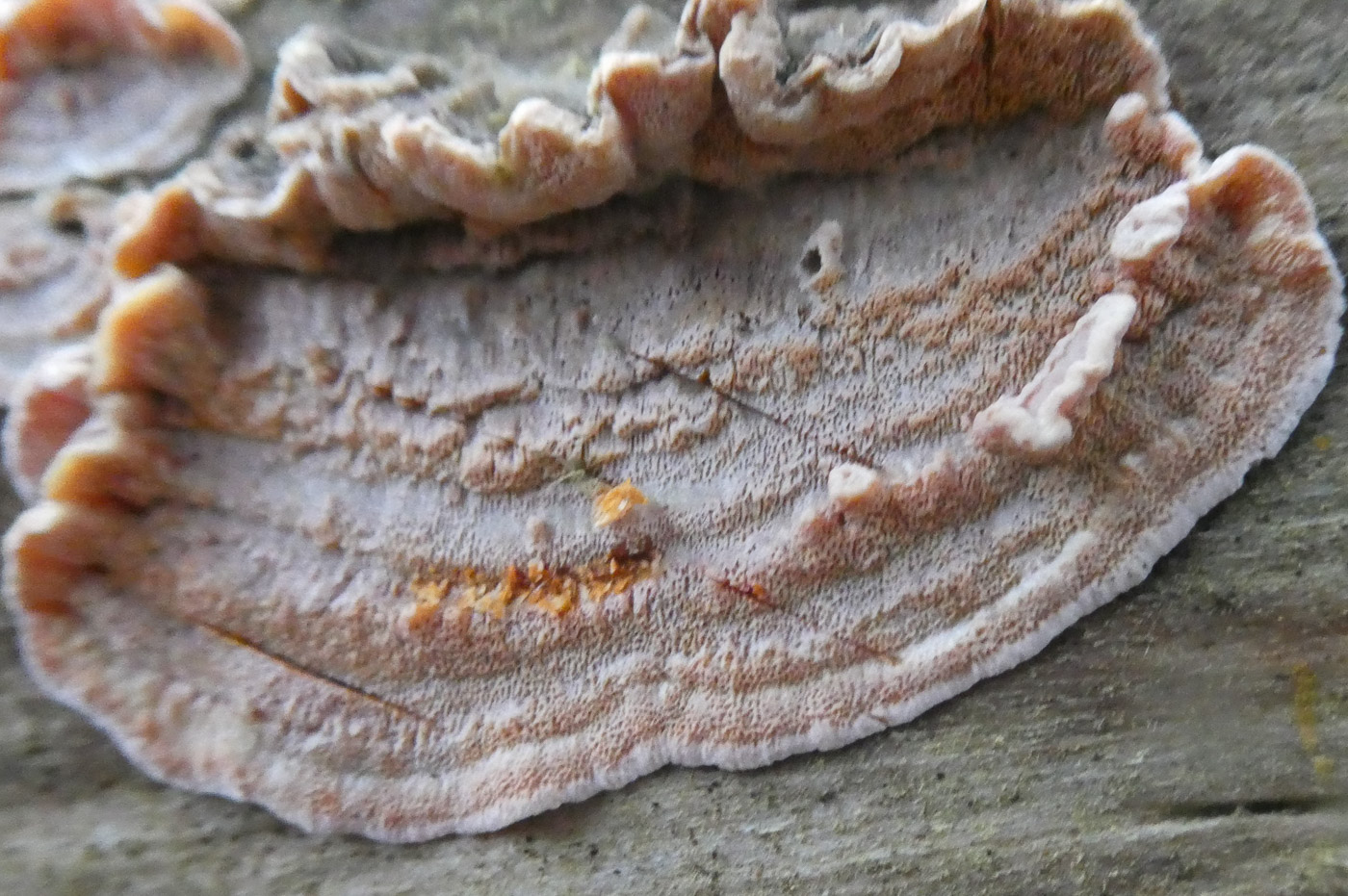 |
March 4th Skeletocutis amorpha (Rusty Crust)
On fallen conifer at Stoke Common Jim Wills spotted several patches of this corticioid species which was unfamiliar to him. Searching through books and online, he came across this species which seemed to fit the bill, so sent Penny his photos in the hope that he could be correct, the key features being the tendency of the finely poroid undersurface to turn rusty orange as it matures, also when fresh and young the soft texture making it easily removable from its conifer substrate - though it dries hard as it matures. Photo 1 is of a fresh sample, photos 2 and 3 show the rusty orange just developing on the pores. The species is confined to conifer but is not a rarity and we have a handful of other county sites though it appears to be new to both Burnham Beeches and Stoke Common during March this year.
|
February 25th 2022
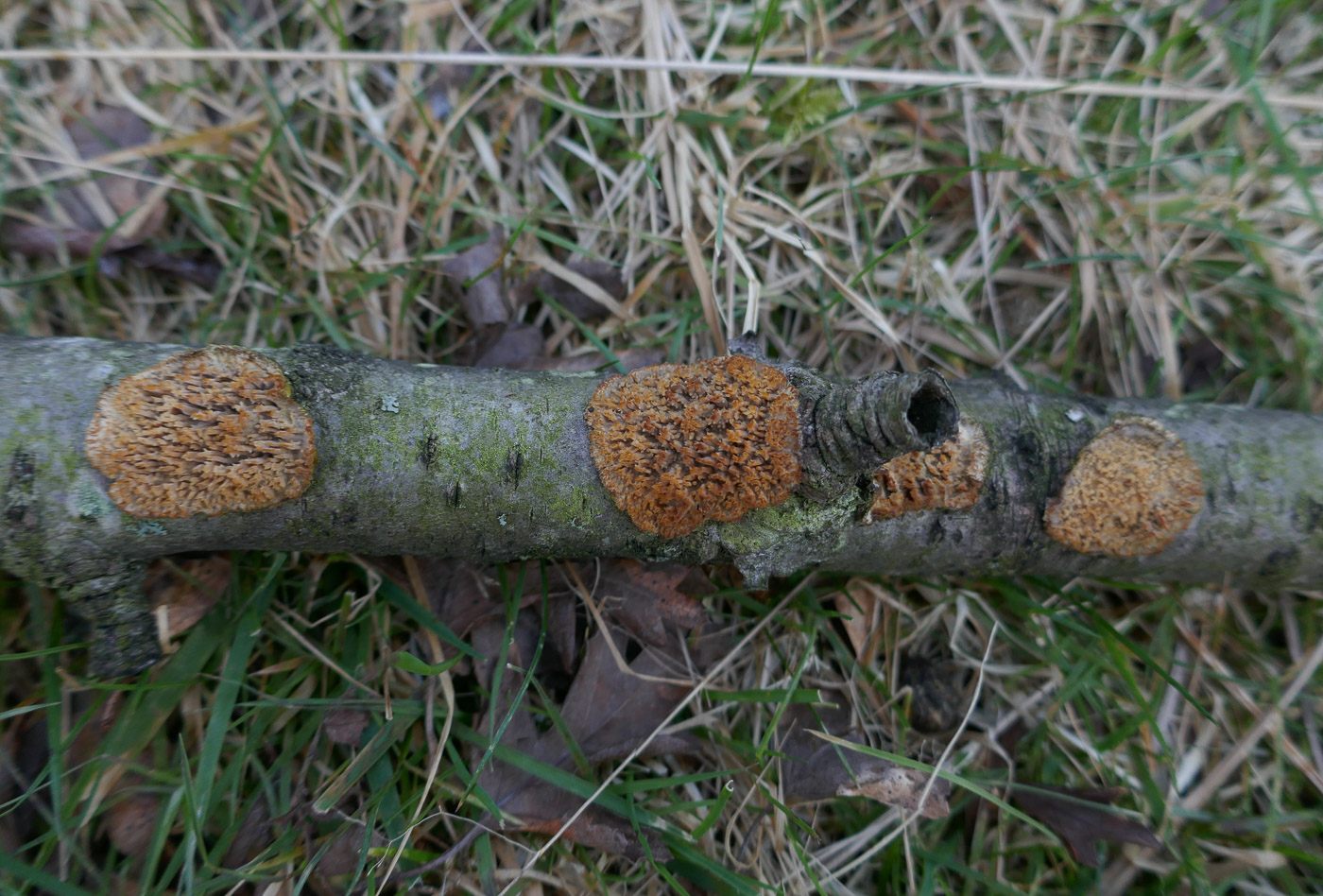 |
February 25th Radulomyces molaris (Oak Tooth Crust) 
On fallen Cherry at Stampwell Farm Jackie Ewan picked up this resupinate fungus - one which favours dying branches high up in the canopy so tends not to turn up until after strong winds (of which there've been plenty recently!). It is commonest on Oak but is not unheard of on other deciduous woods and is quite similar to Basidioradulum radula (Tooth Crust)though not so pale and more distinctly toothed also. See that species for comparison on Finds 2020 December 7th, also 2021 January 28th and February 13th.
|
February 24th 2022

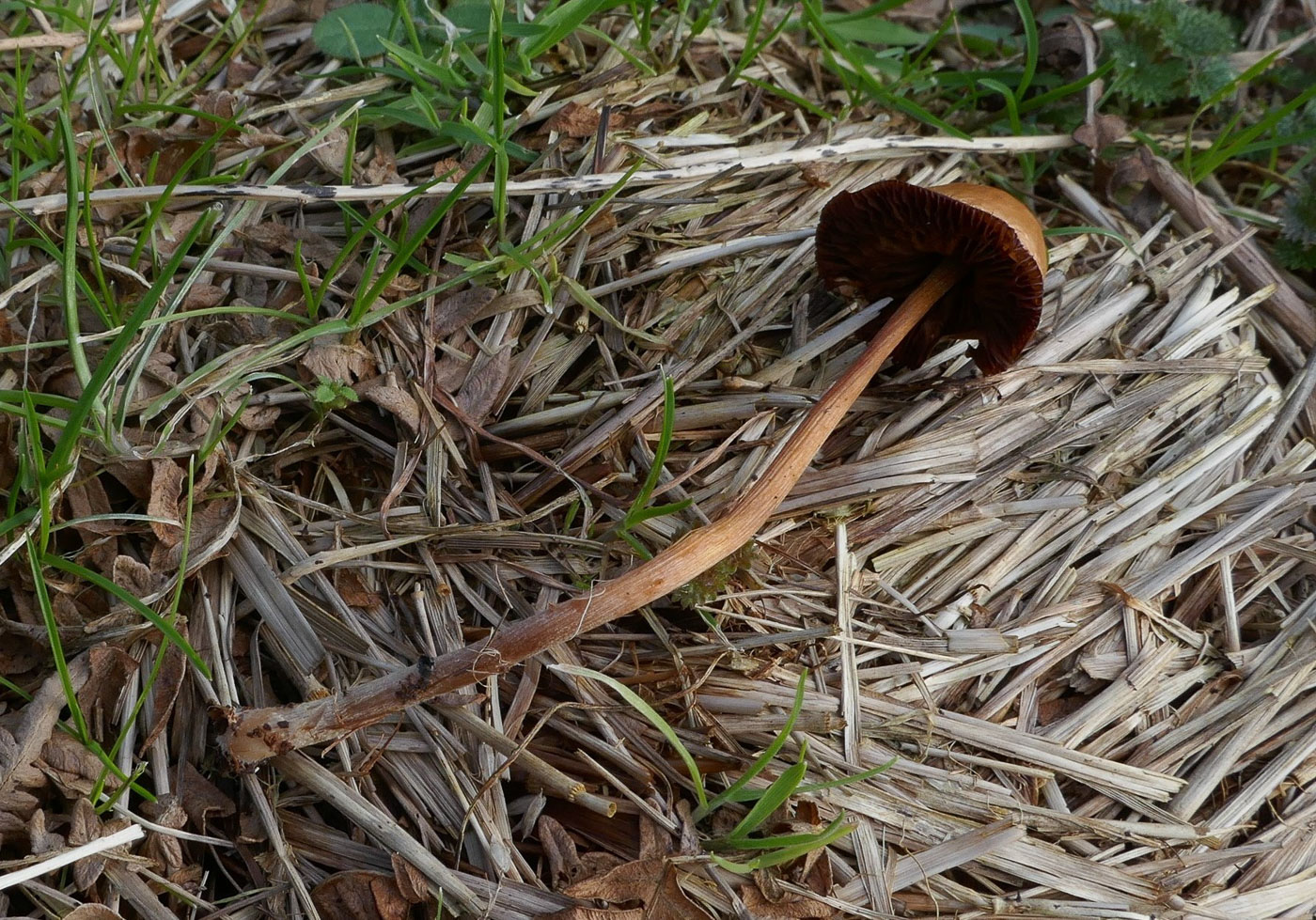
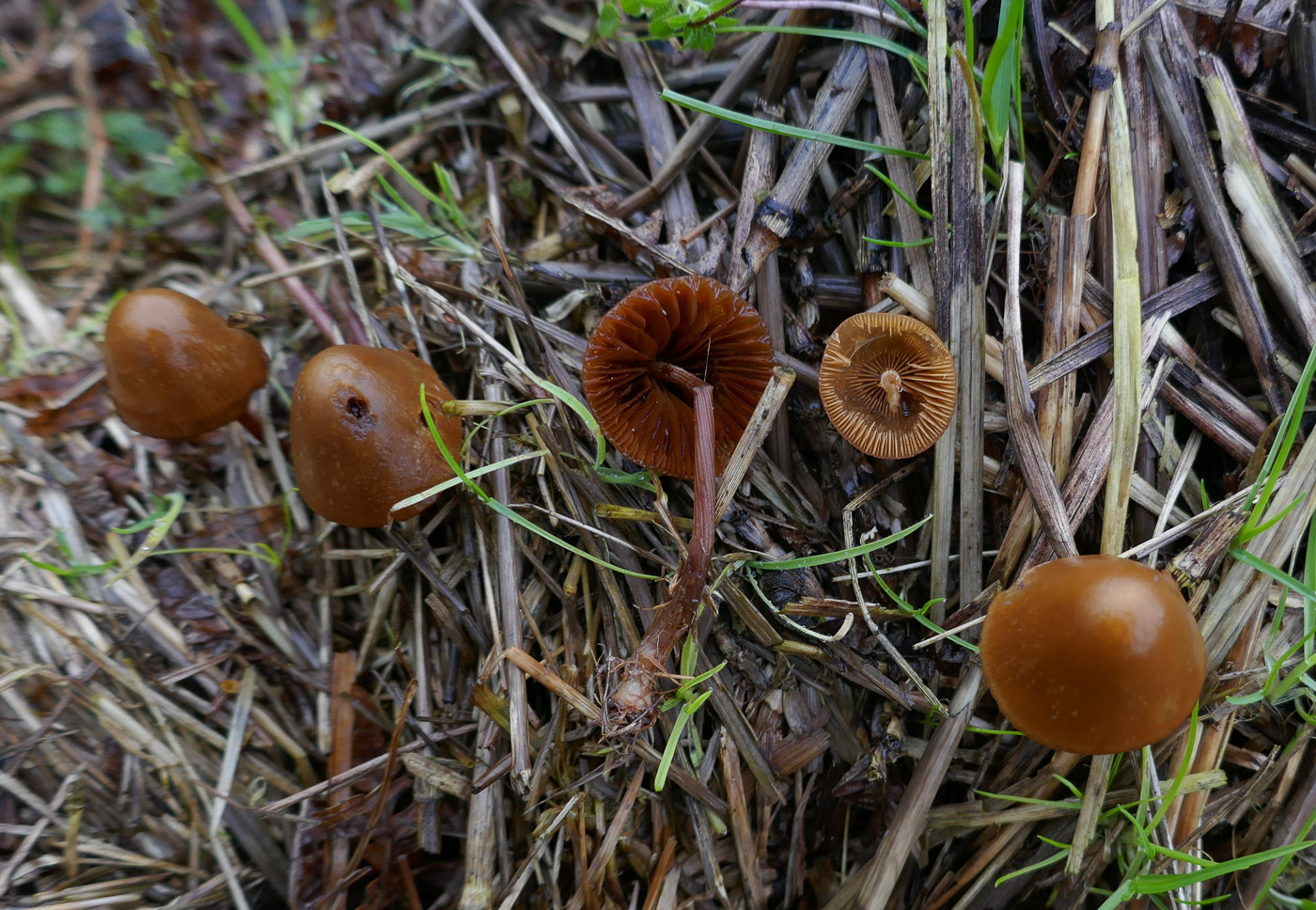 |
February 24th Conocybe pubescens  (Common) (Common)
On an old dung heap at Stampwell Farm Jackie Ewan found this bright rusty brown LBJ, noticed the finely pruinose stem and took it home to work on. The dung habitat together with its fairly large size for the genus, pruinose stem and large spores confirmed this as C. pubescens, not rare but with only two previous county records, both from Burnham Beeches. See also on Finds 2020 November 30th.
|
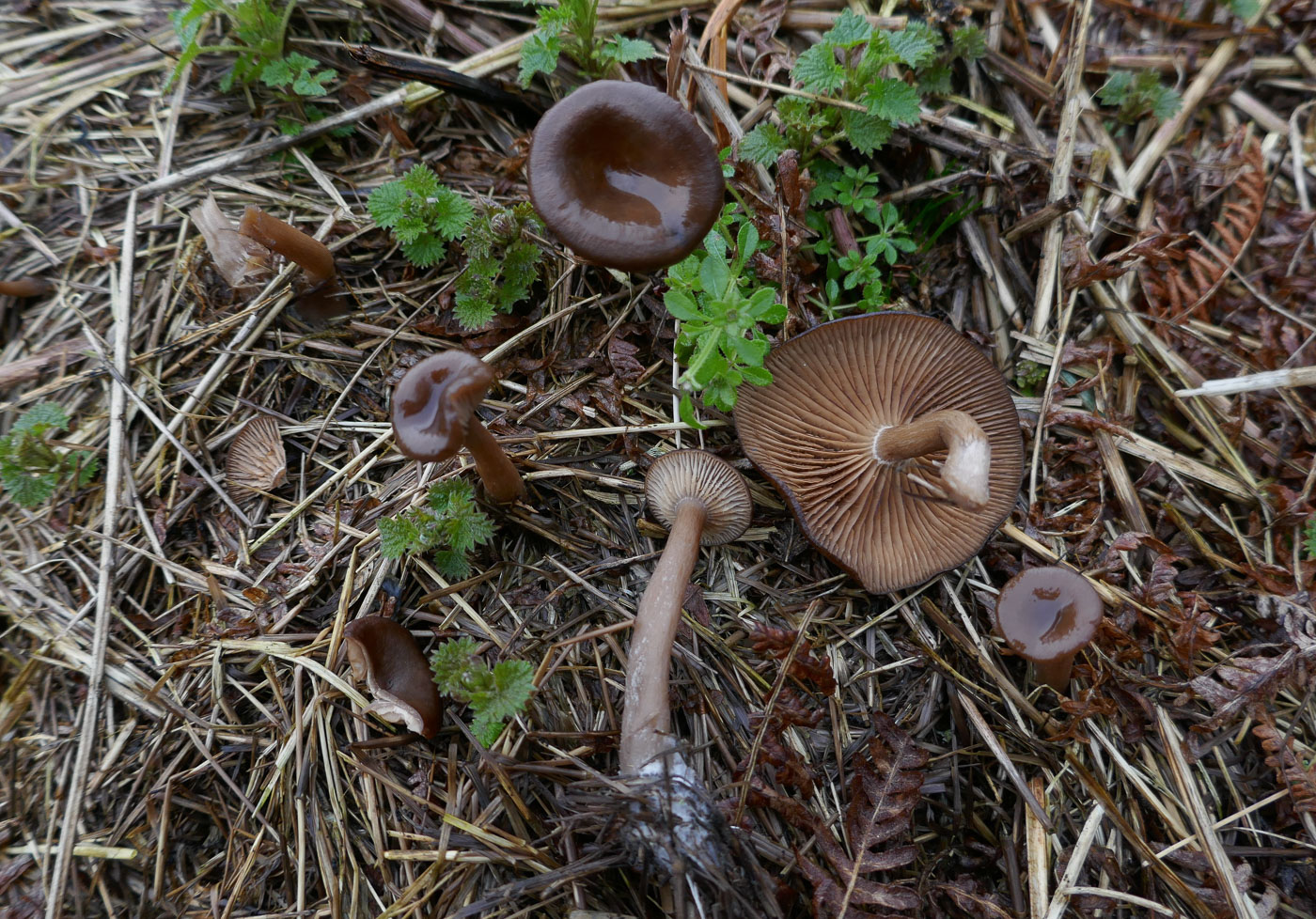 |
February 24th Pseudoclitocybe cyathiformis (Goblet)
On an old dung heap at Stampwell Farm Jackie Ewan noticed this late season mushroom fruiting where she'd found it late last year. See also Finds 2021 November 18th and December 30th.
|
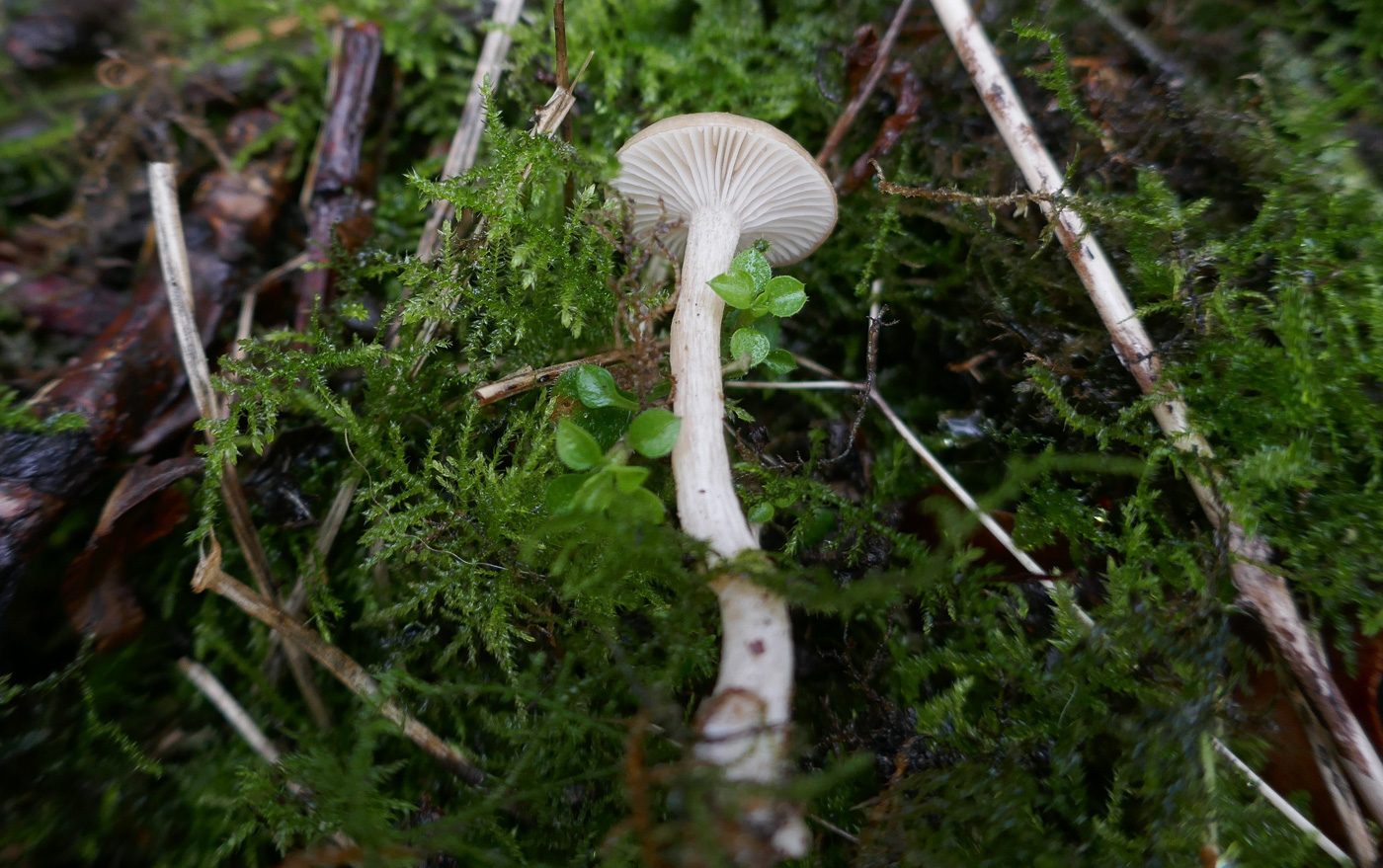
 |
February 24th Clitocybe fragrans (Fragrant Funnel)
In a meadow at Stampwell Farm Jackie Ewan noticed two clusters of this smallish Funnel, unremarkable in appearance but with a very distinctive sweet smell of aniseed. It didn't make an appearance last autumn till well into November but has made sporadic fruitings though the winter months - unusual to occur this late, though. See also Finds 2021 November 18th.
|
February 23rd 2022
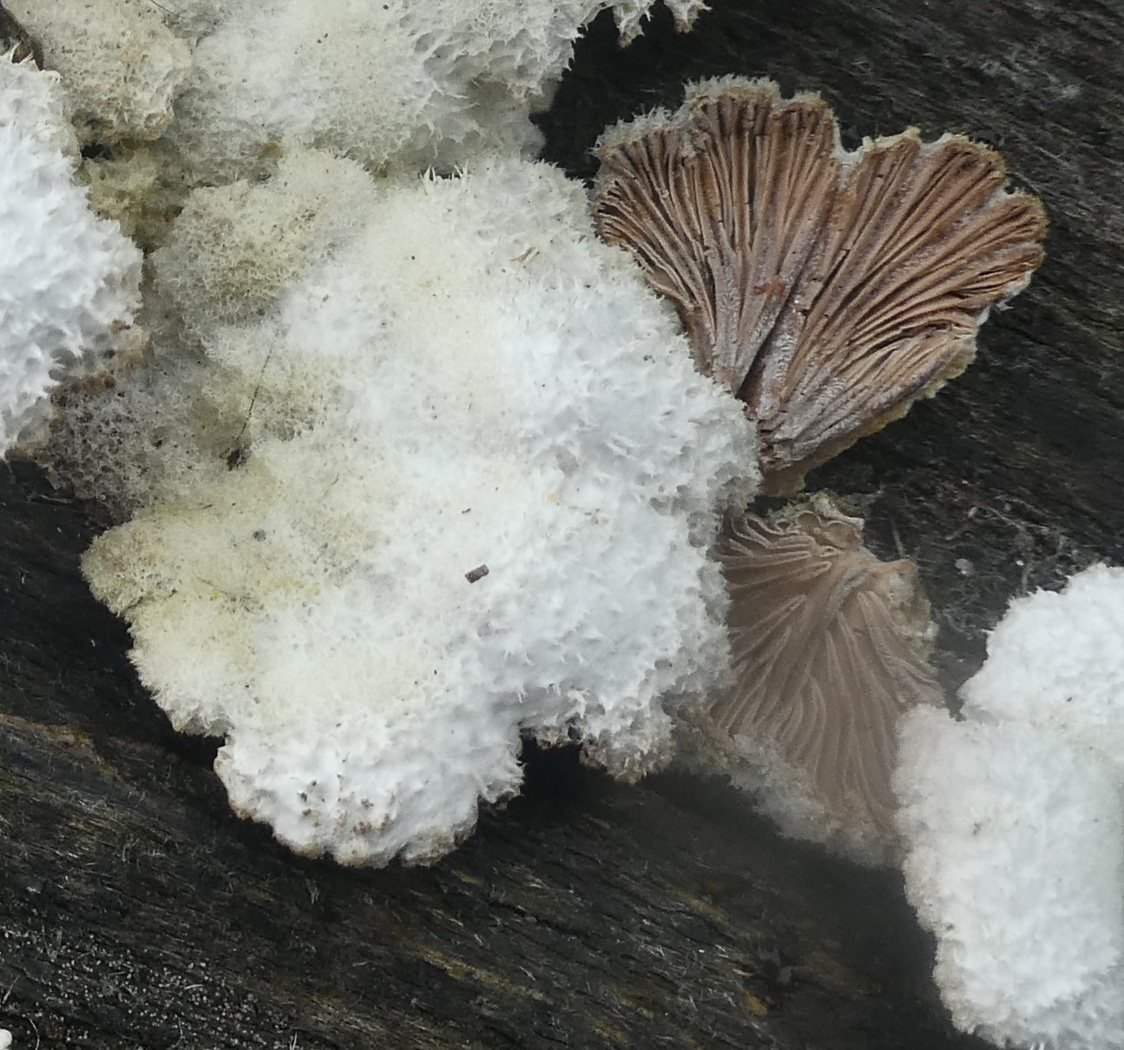

 |
February 23rd Schizopyllum commune (Split Gill)
On the edge of Moorend Common Jill Wills found these attractive little lacy-edged 'fans' fruiting on several felled deciduous trunks, also on their sawn off ends. This is a distinctive species with its white to cream hairy upper surface (looking almost frosted) and pinkish fawn strongly forking gills. See also Finds 2020 October 29th.
|
February 20th 2022
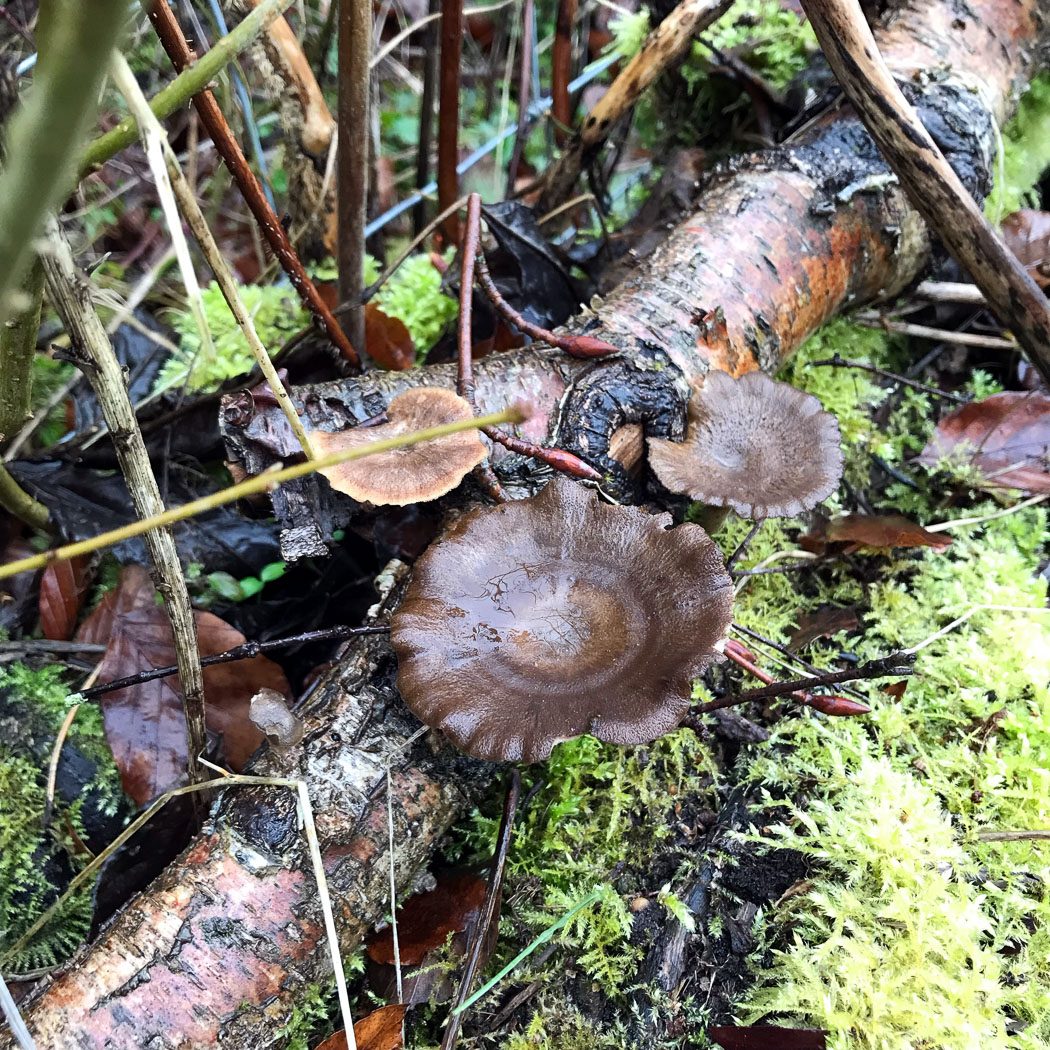
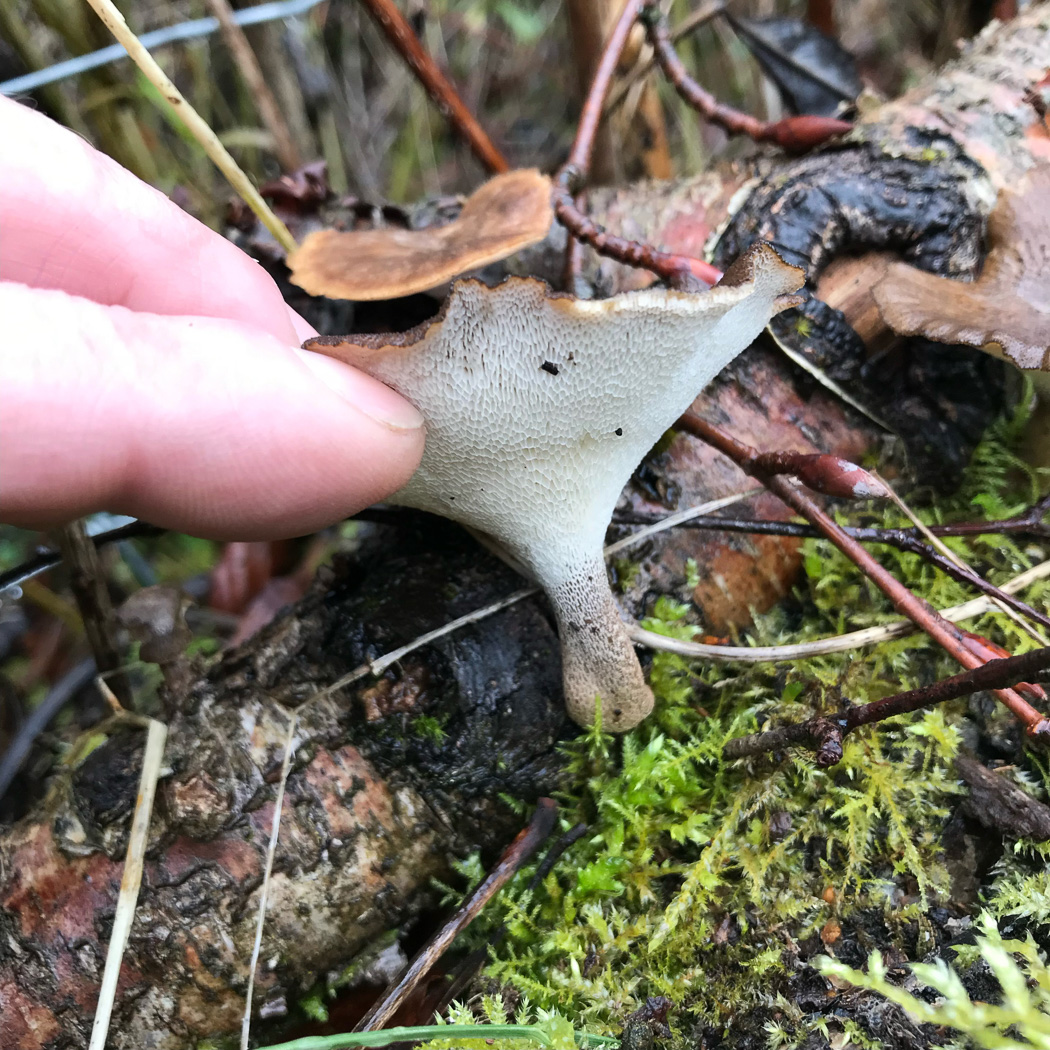
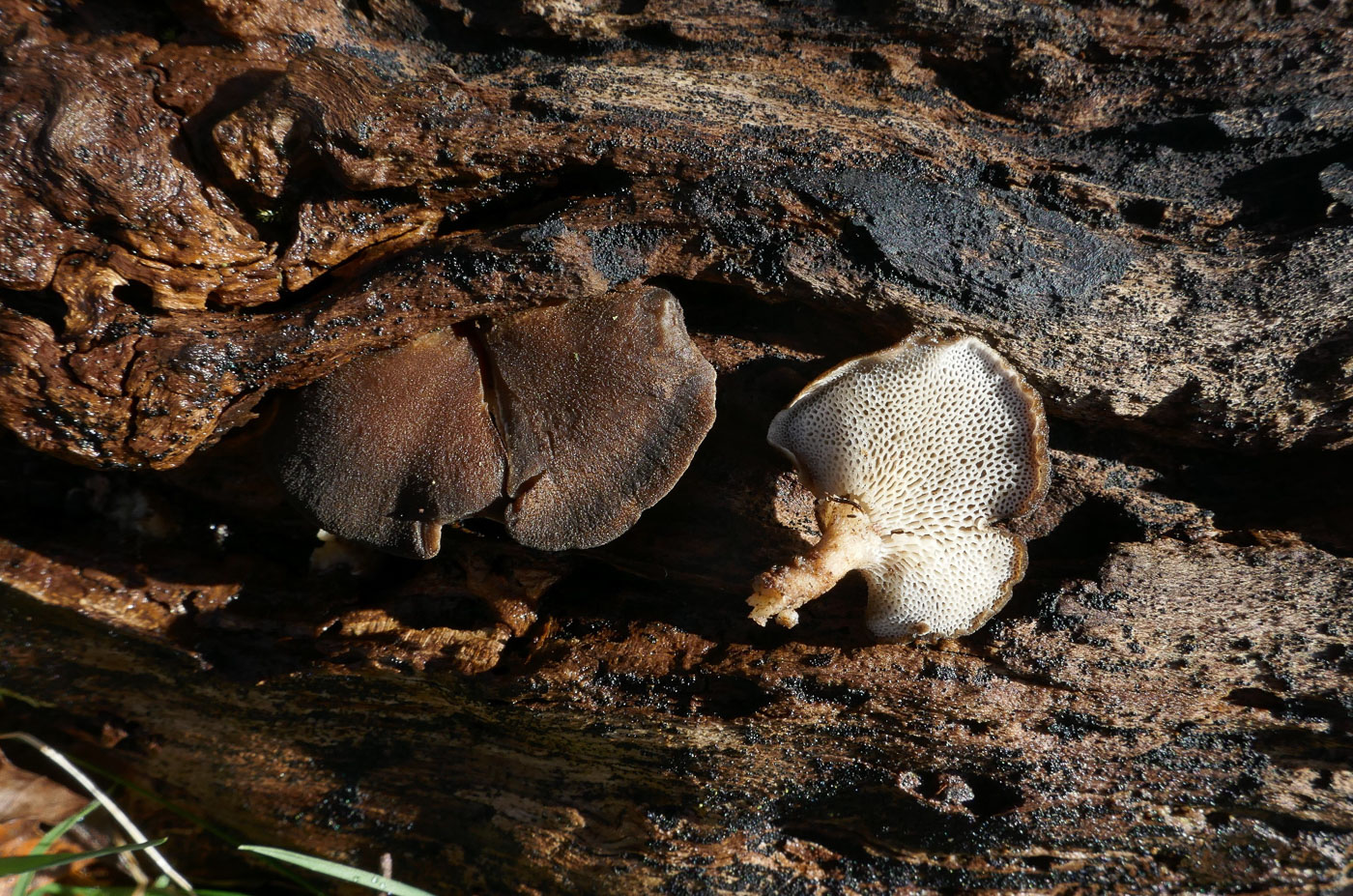 |
February 20th Lentinus brumalis (Winter Polypore)
At Ragpits Reserve, Aston Clinton, Phil Townsend found and identified these polypores on fallen Birch. More familiar as Polyporus brumalis, the species is best described as occasional and fruits most often in the winter months. These are nicely typical examples showing the fulvous brown zoned and frilly edged cap, slightly angular decurrent pores and scaly stem. Note the lack of black at the stem base, a useful indicator for the much more common Cerioporus leptocephalus (also previously in genus Polyporus). True to form like London buses, Jackie Ewan also found L. brumalis at Stampwell Farm four days later on fallen rotting Oak (photo 3).
|
February 16th 2022

 |
February 16th Diatrype stigma and Dialonectria episphaeria (Common Tarcrust and a species of Coral Spot with no common name)
Two for the price of one here: At Tram Hill Ponds, Brill, Joanna Dodsworth noticed a Hazel stick with the tell-tale black patches of this common species - a typical member of the Pyrenomycetes (the crusty black Ascos). What she didn't notice, however, were the tiny red blobs of Dialonectria episphaeria (previously in genus Nectria) liberally adorning it and visible with close inspection (photo 2)! This Tarcrust can form large expanses on barkless fallen deciduous wood, commonly Beech, and this particular Coral Spot - another Asco - can (with a hand lens) quite often be found on it. There are many different species of Nectria - a parasitic genus now being split up - the most familiar being N. cinnabarina (Coral Spot) which often forms large swarms of fallen deciduous sticks. Several species are only found on other fungi, particularly on Pyrenomycetes of various kinds, and today's species favours Diatrype stigma.
|
February 15th 2022
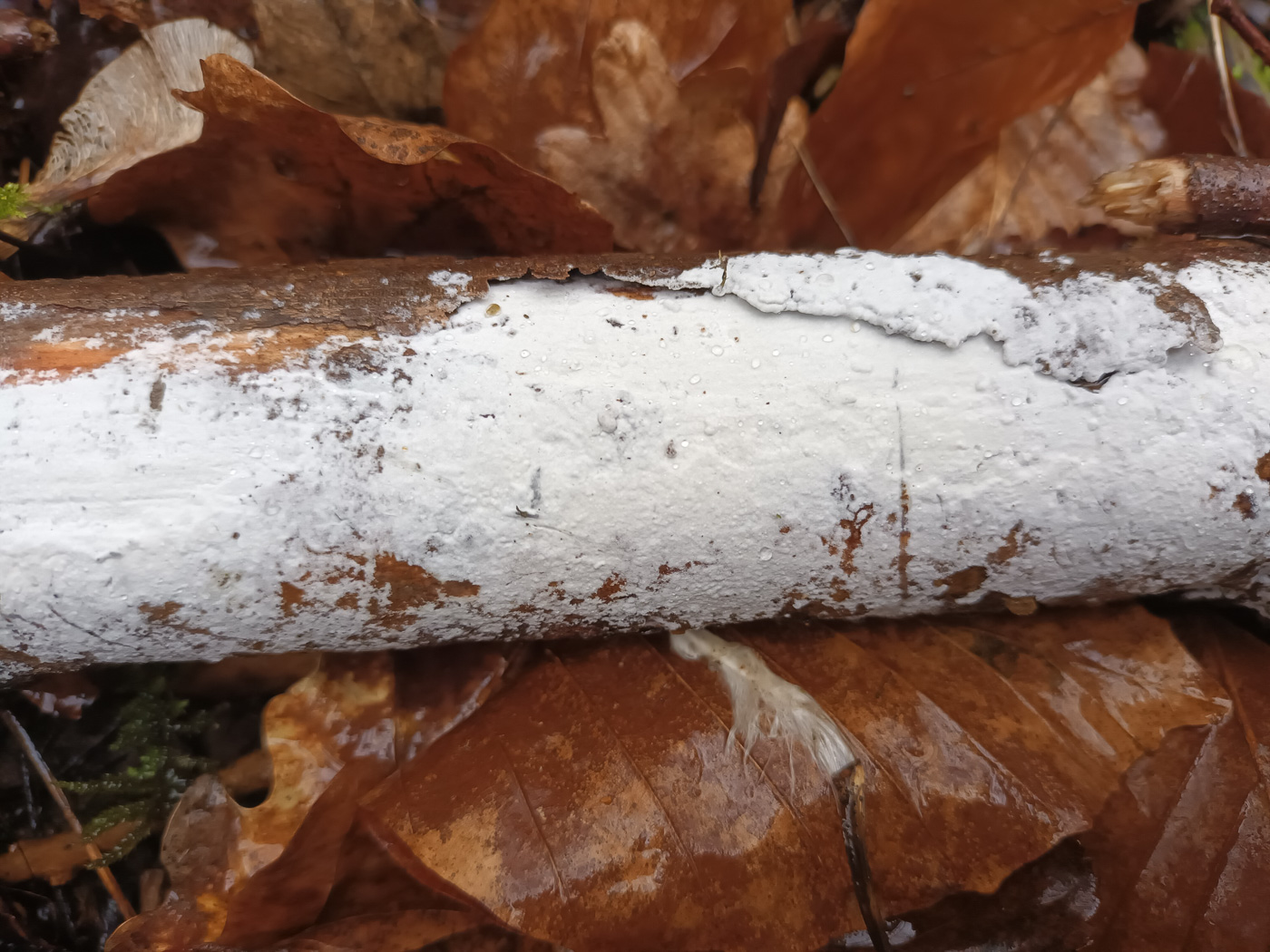
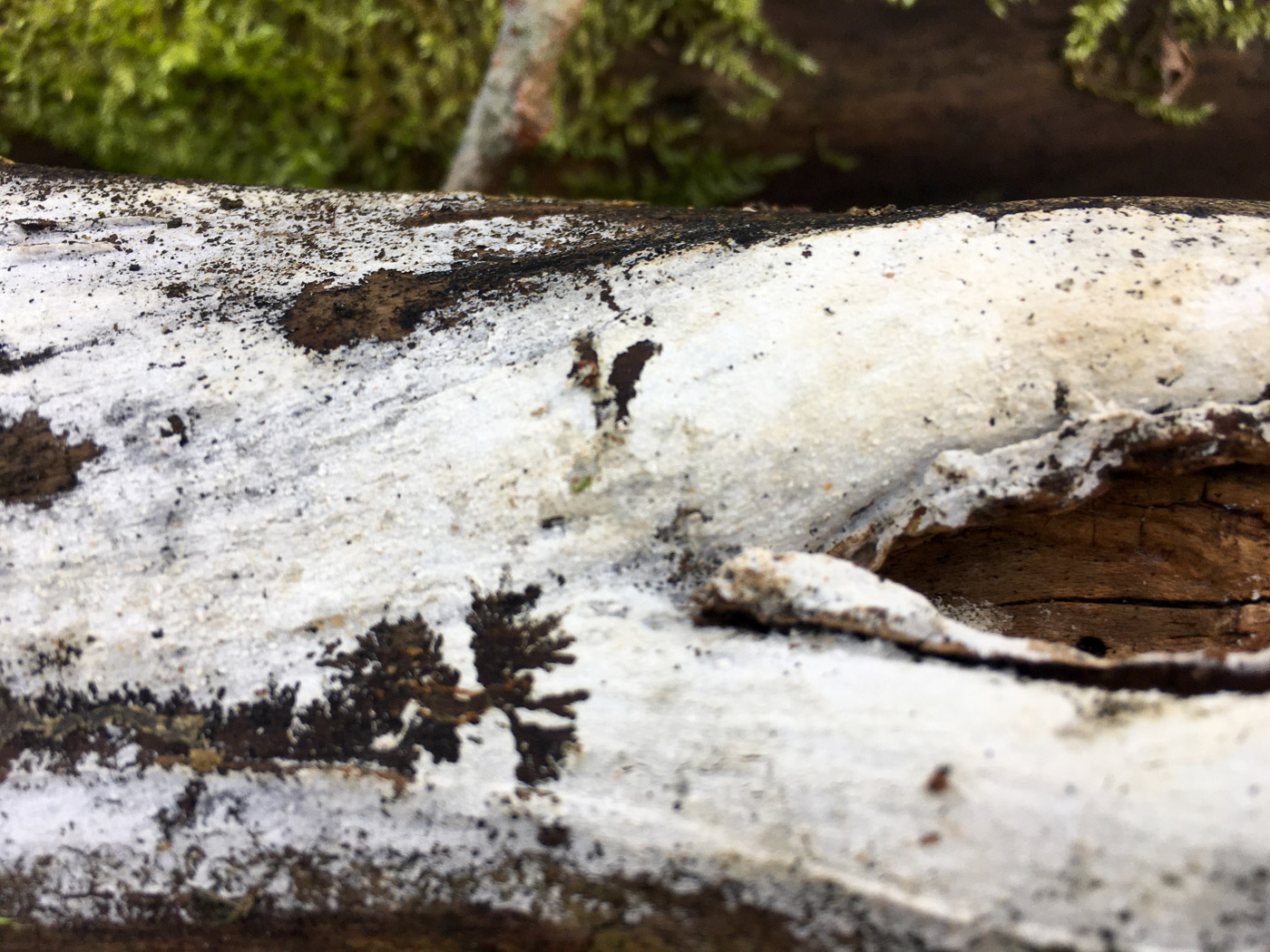 |
February 15th Phanerochaete sordida (a corticioid with no common name) 
On a deciduous stick in woodland near Chalfont St. Peter Jesper Launder collected this corticioid sample to take home and work on. This is yet another example of the many 'patches of white paint' on fallen wood, the vast majority of which need skilled microscopic study to name. This genus has distinctive cells which help but as there are about a dozen species within the genus it is not always simple to separate them. We have about 10 previous county records though only one in the last 20 years - from Dancersend in 2021, collected by Claudi Soler and subsequently identified by Alick Henrici. Joanna Dodsworth identified this species from Brill the following day (photo 2) so in true London bus style we have nothing for 20 years then two come along at once!
|
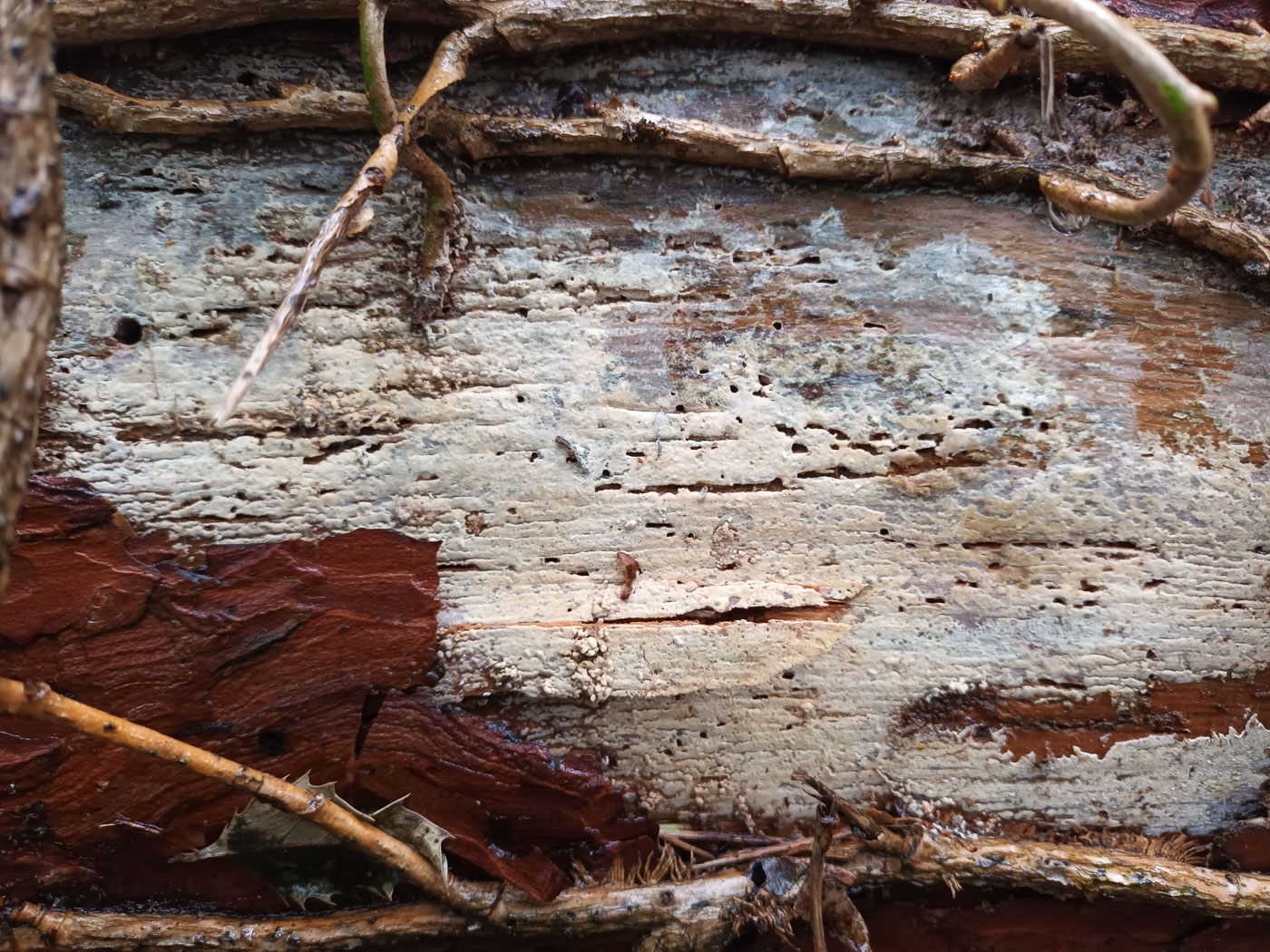 |
February 15th Tubulicrinis subulatus (a rare corticioid with no common name) 
On decorticated fallen Pine in woodland near Chalfont St. Peter Jesper Launder collected this corticioid sample to take home and work on. The microscopic characters were distinctive, leading straight to this genus (which appears superficially very similar to so many other 'white paint' species which frequent fallen wood). Further detective work revealed the species - one for which we have only one previous record made by Kerry Robinson at Burnham Beeches last June, also on conifer with which it is always associated.
|
February 12th 2022
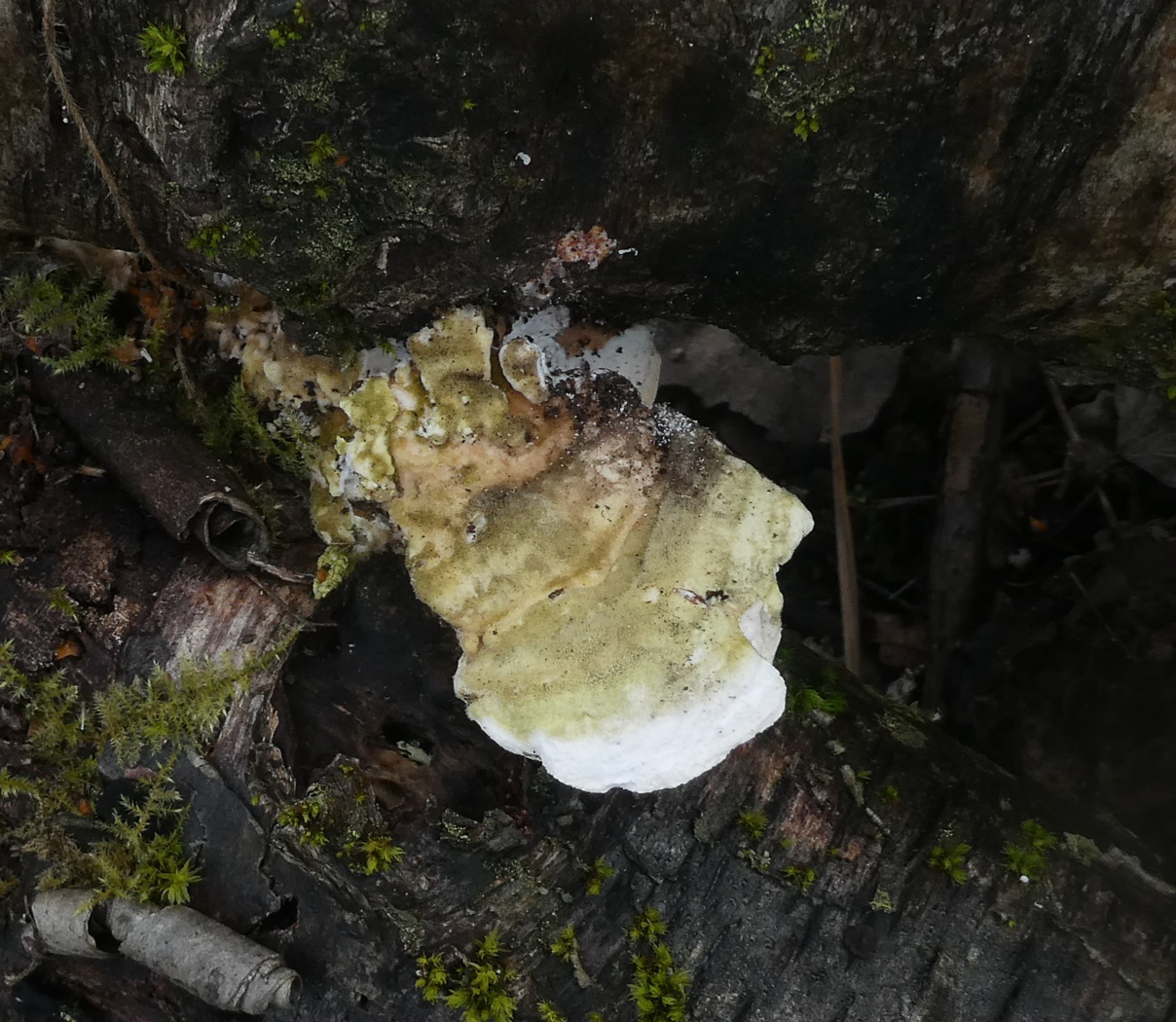
 |
February 12th Lenzites betulina (Birch Mazegill)
At Stoke Common on a Birch stump Jim Wills noticed this bracket having almost gill-like labyrinthine pores similar to those found in the very common Trametes gibbosa (Lumpy Bracket). That species is commonest on Beech whereas today's species occurs mainly (but not exclusively) on Birch and is also far less common. See also in Finds 2020 October 22nd and November 15th.
|
February 11th 2022
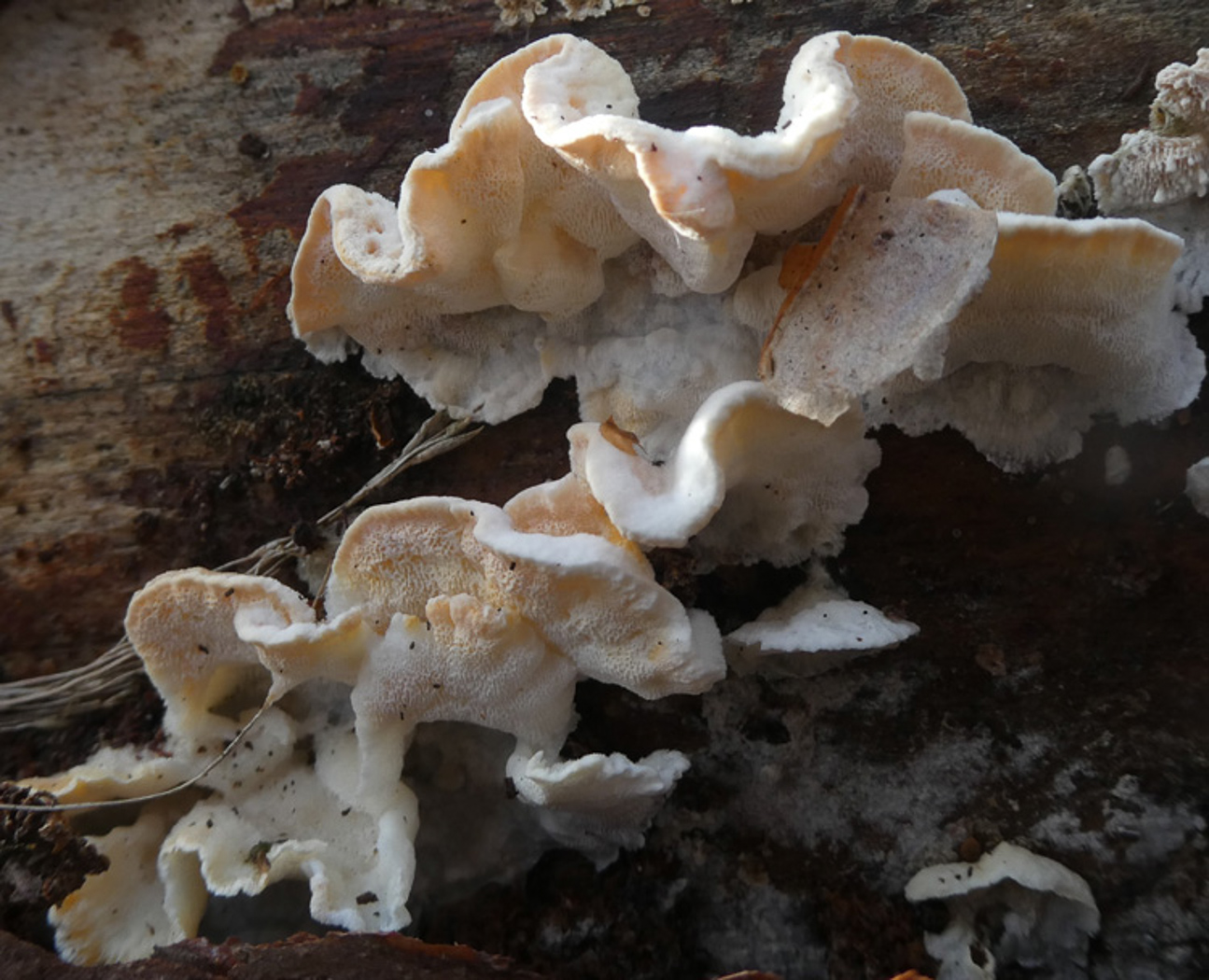
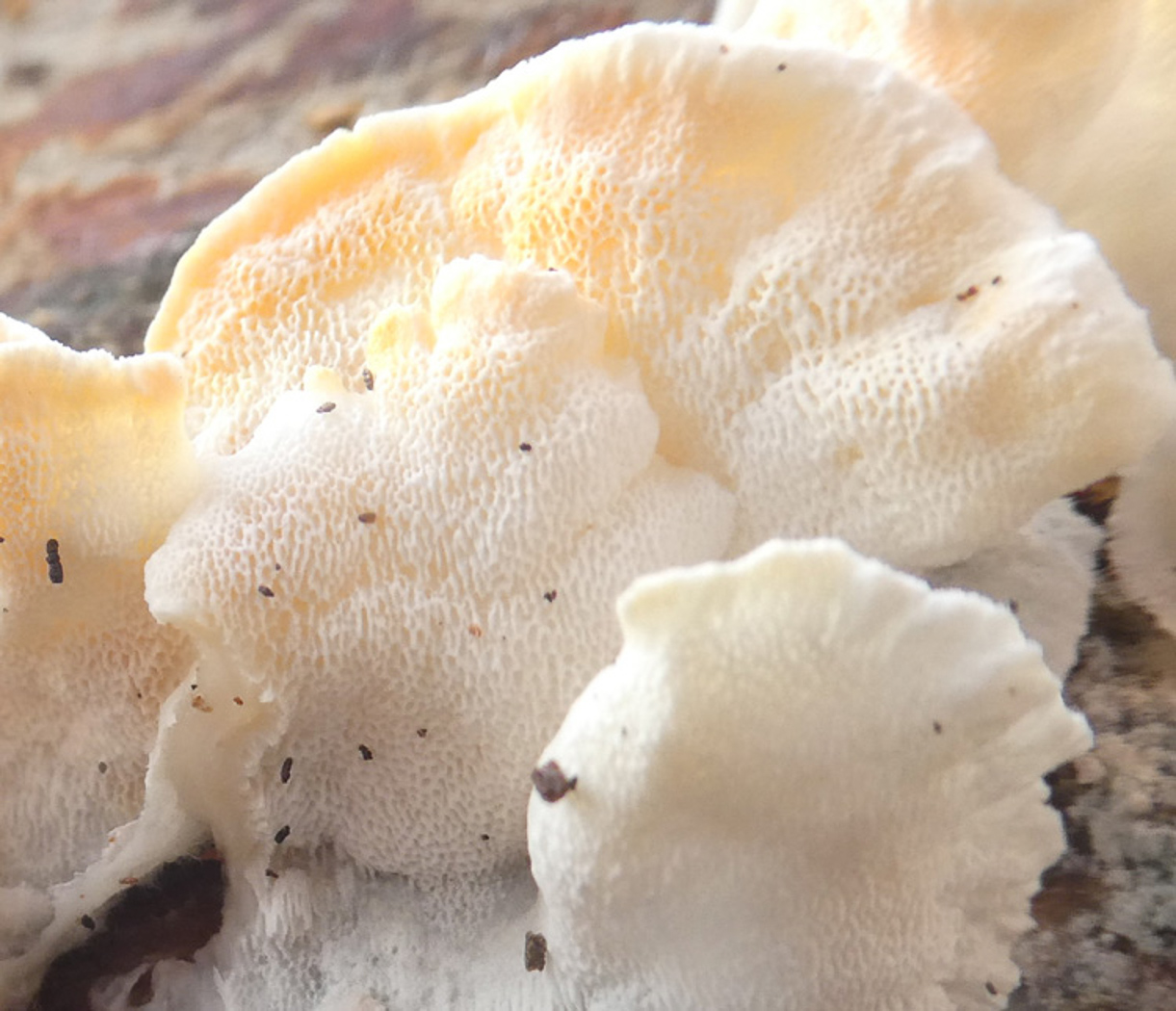

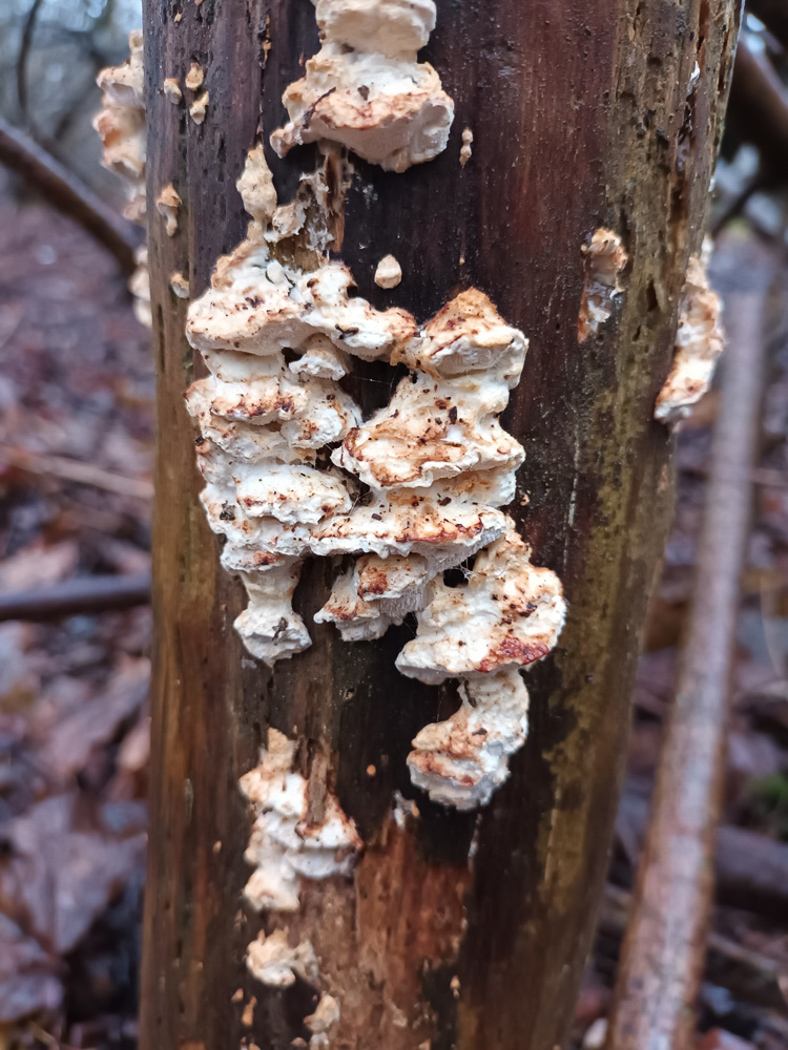
 |
February 11th Fuscopostia fragilis (an unusual bracket with no common name) 
On fallen Pine in Stoke Common Jim Wills found these white brackets (photos 1-3); he thought it was possibly Postia stiptica - common on this substrate - but was able to eliminate that species by its absence of a bitter taste. Penny was unable to suggest what it might be until three days later when in came photos 4-5 from Jesper Launder of what appeared to be the exact same species, also on fallen Pine but from woodland near Chalfont St. Peter. Jesper had checked the microscopic characters and was confident of his determination. It is worth noting the field differences between these two white species which occur on fallen conifer (both previously in the genus Postia, P. stiptica now apparently Amaropostia stiptica): A. stiptica is common, tends to form individual white soft hoof-shaped brackets with colour unchanging when bruised or damaged and a bitter taste; F. fragilis is occasional, tends to form overlapping tiers of white soft hoof-shaped brackets which stain red-brown when bruised or damaged (visible in both collections), also (according to Jim!) tastes mild. The species appears to be new to Bucks but is clearly one to look out for in coniferous woods.
|
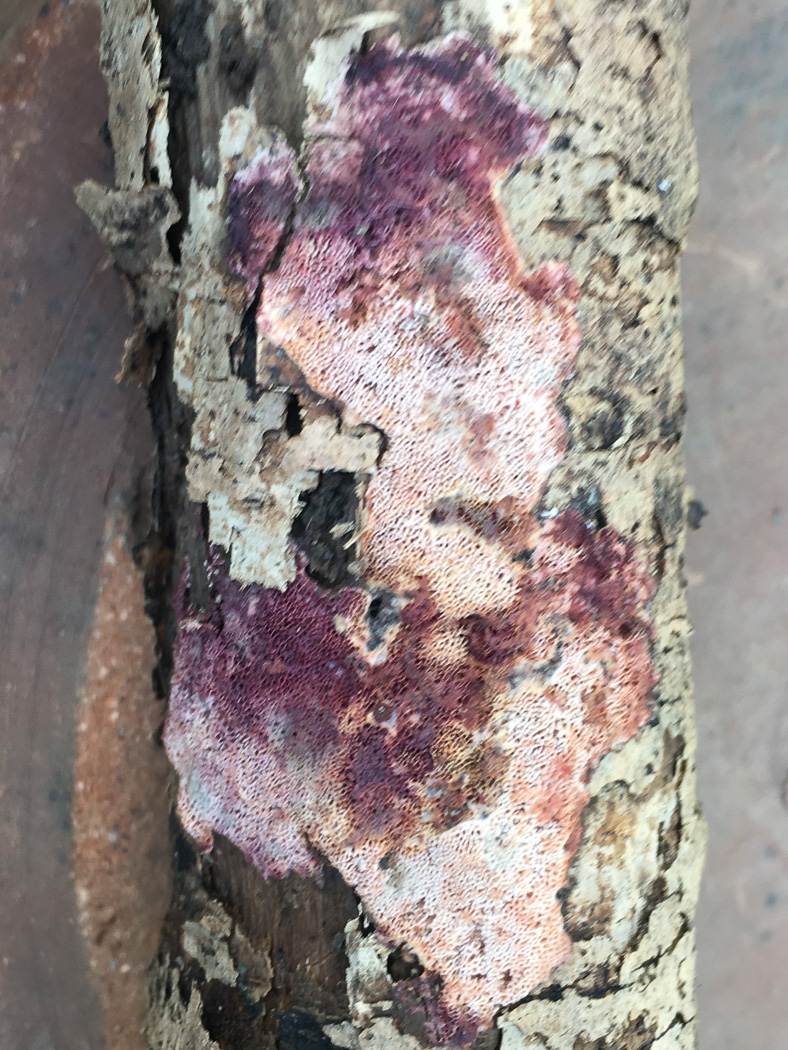
 |
February 11th Ceriporia purpurea and Trichia decipiens (a corticioid and a slime mould, neither with common names)
On rotting deciduous wood near Brill Joanna Dodsworth noticed this distinctive resupinate (flat) patch which had an unusual purplish pink colour. At home she was able to identify it from images and also from testing with a drop of KOH which turns the pores red-purple. This is quite a rare species and we have just two previous records (one of which was Joanna's from Brill 10 years ago!). Alongside on the same fallen branch were the bright orange blobs of Trichia decipiens (seen in photo 2), a common slime mould but one of the few recognisable at an immature stage from its distinctive shiny blobs and little white stalks.
|
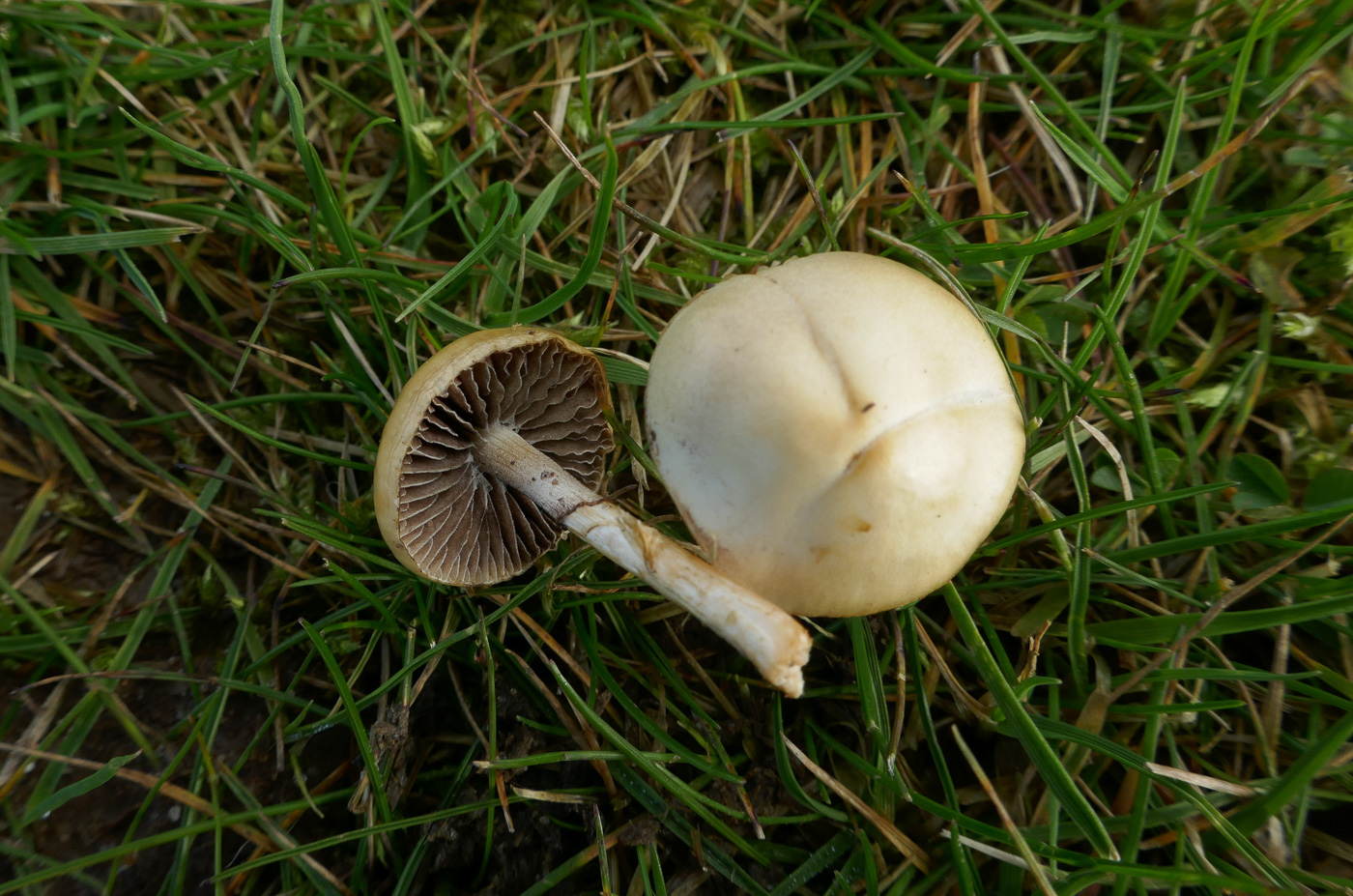
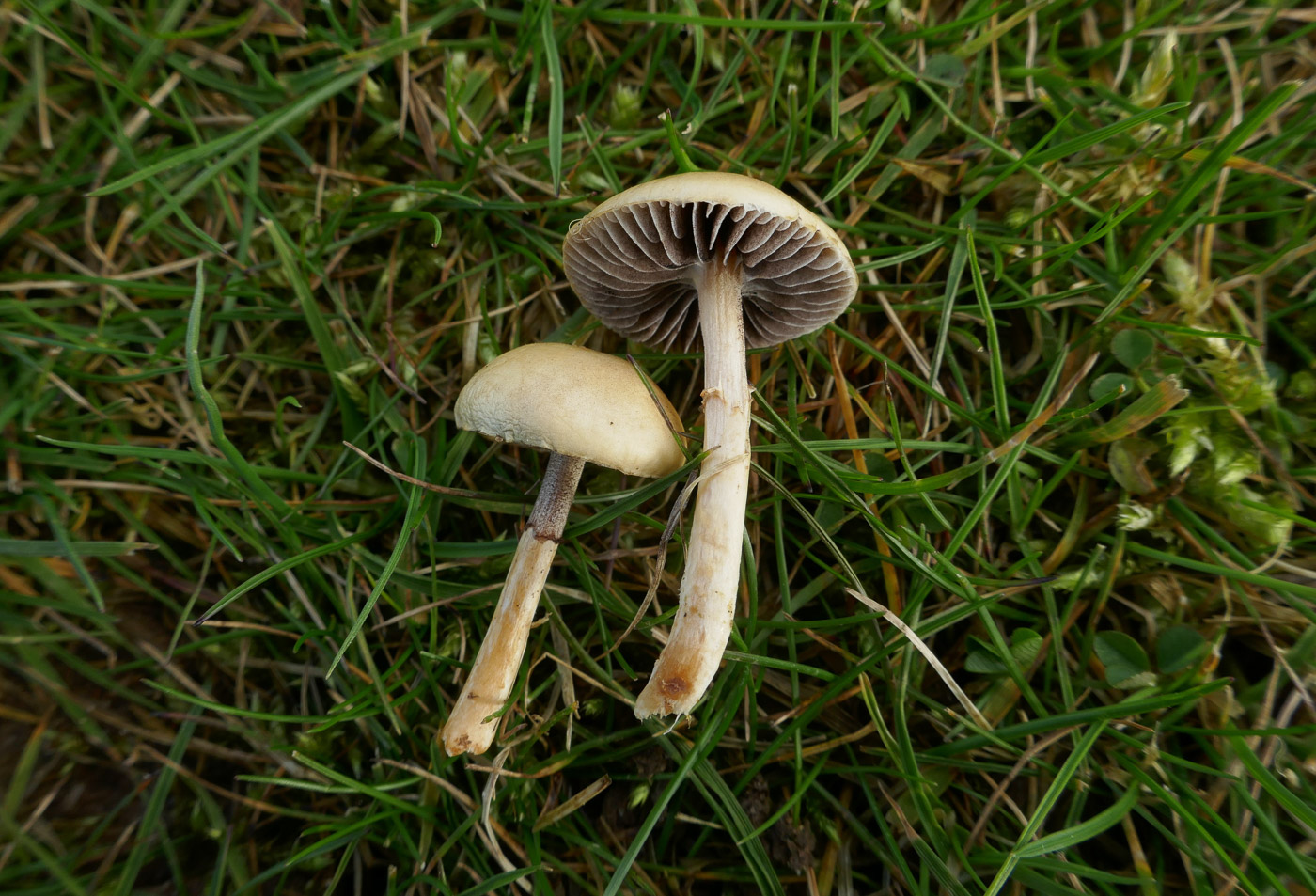 |
February 11th Protostropharia semiglobata (Dung Roudhead) 
At Stampwell Farm in a grassy area inhabited by rabbits Jackie Ewan found these mushrooms (not obviously on dung but no doubt on old rabbit droppings). The species (better known as Stropharia semiglobata) has a smallish yellow ochre rounded sticky smooth cap with a peelable cuticle, greyish gills and a thin sticky stem having a ring - often coloured from the dark spores but which soon disappears. It occurs commonly on assorted dung or dung remains.
|
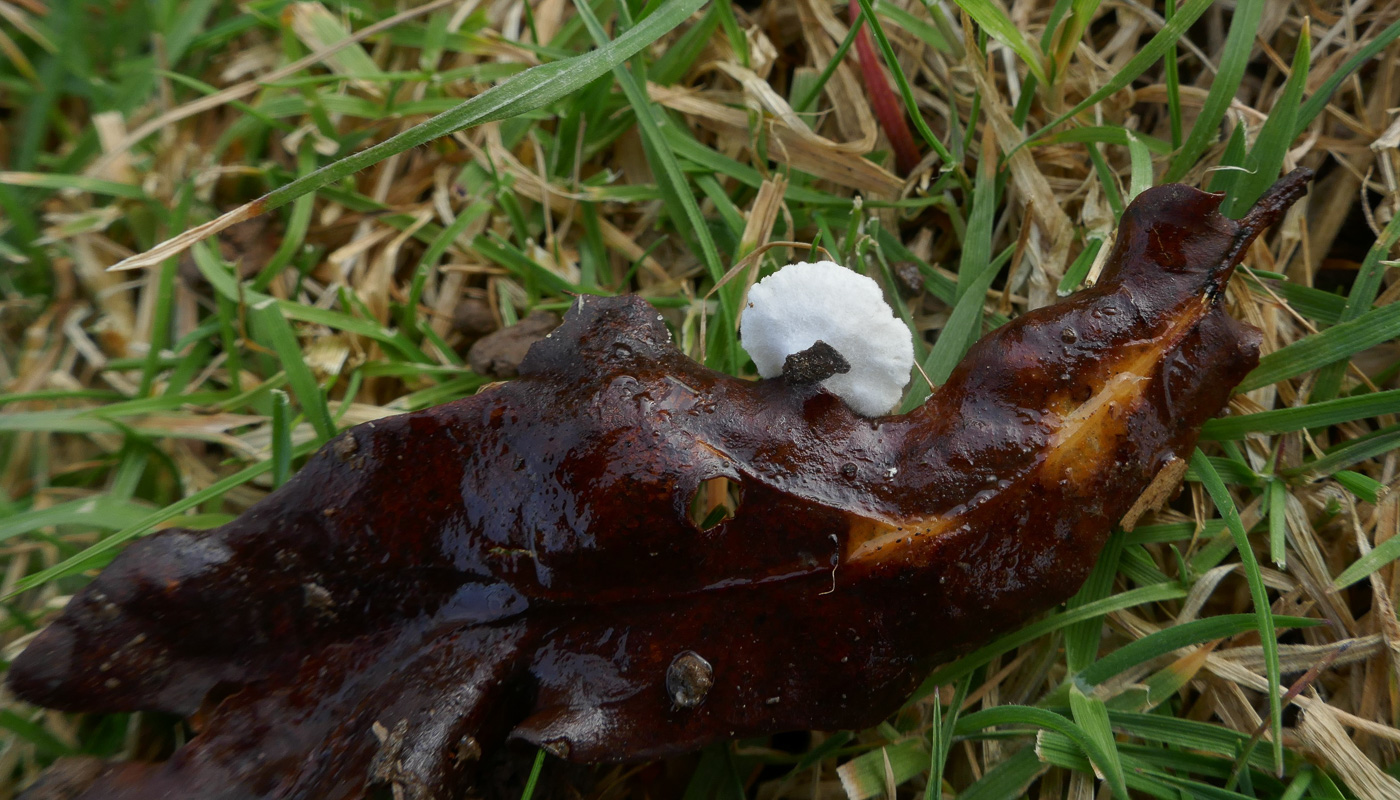
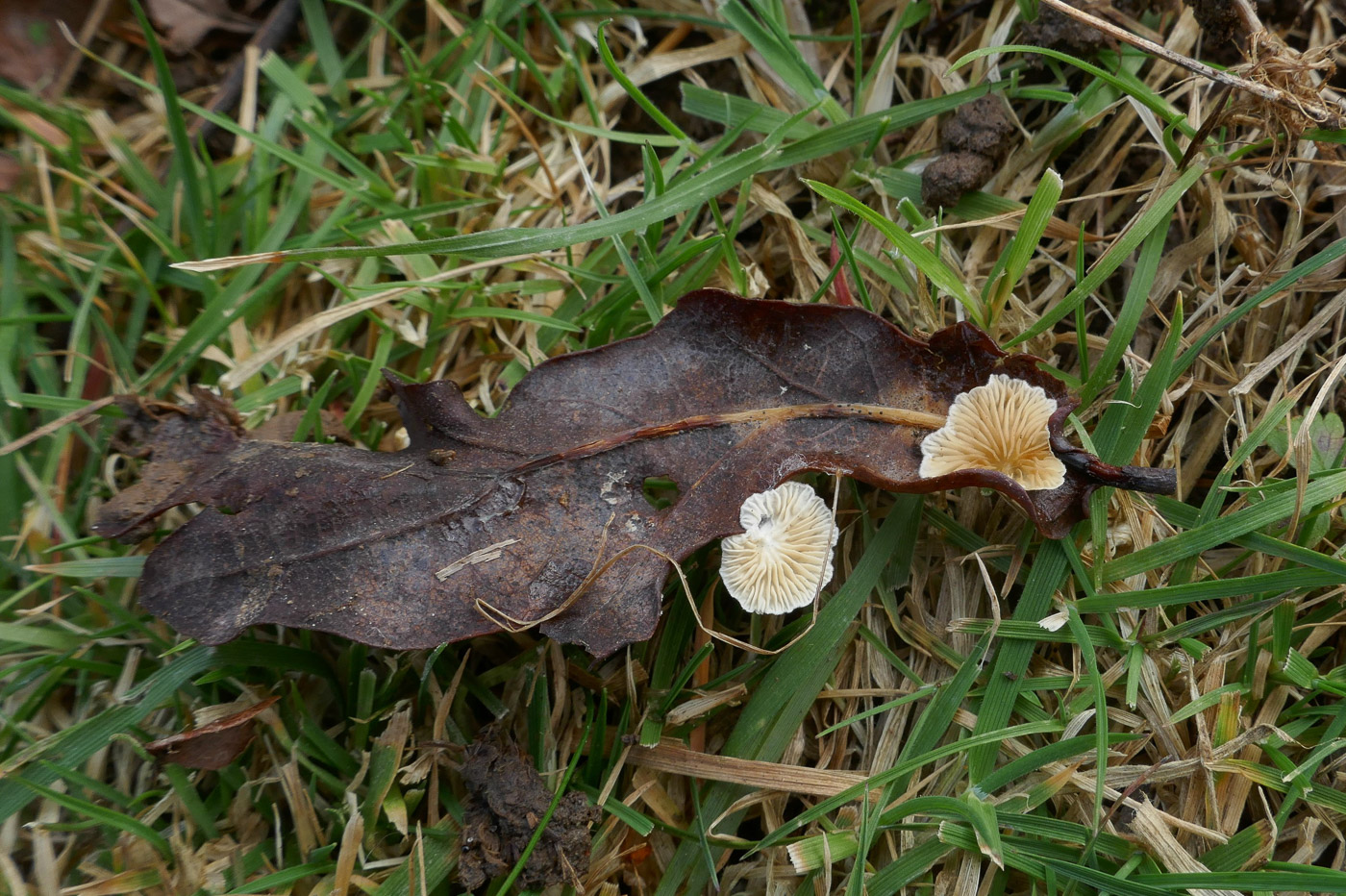 |
February 11th Crepidotus epibryus (Grass Oysterling) 
On a dead Oak leaf at Stampwell Farm Jackie Ewan noticed a tiny white fungus, and turning the leaf over found another one which confirmed the genus for her. A check for the narrow pip-shaped smooth spores then confirmed this quite common species which occurs on plant debris and deciduous leaves / twigs. Compare with images of others from the genus, nearly all species of which need confirmation with a scope, as here.
|
February 4th 2022
 |
February 4th Crepidotus cesatii (Round-spored Oysterling) 
At Stampwell Farm Jackie Ewan noticed some nice fresh examples of this common pretty little stemless species fruiting on a fallen deciduous stick. It is mainly but not exclusively found in autumn but only identifiable to species by its spores because there are several other extremely similar little Oysterlings found on twigs etc. Only C. mollis can be recognised safely in the field by it elastic transparent cap cuticle. Compare with several other species in Finds 2020.
|
February 1st 2022

 |
February 1st Phellinus pomaceus (Cushion Bracket)
At Stampwell Farm Jackie Ewan noticed this species fruiting on an old Plum tree where it appears every year (as it also does at Rushbeds Wood on the closely related Blackthorn - Penny saw it there today also but didn't have a camera handy!). It is a species confined to Prunus and as such is quite an easy one to recognise. See also in Finds 2021 August 13th.
|
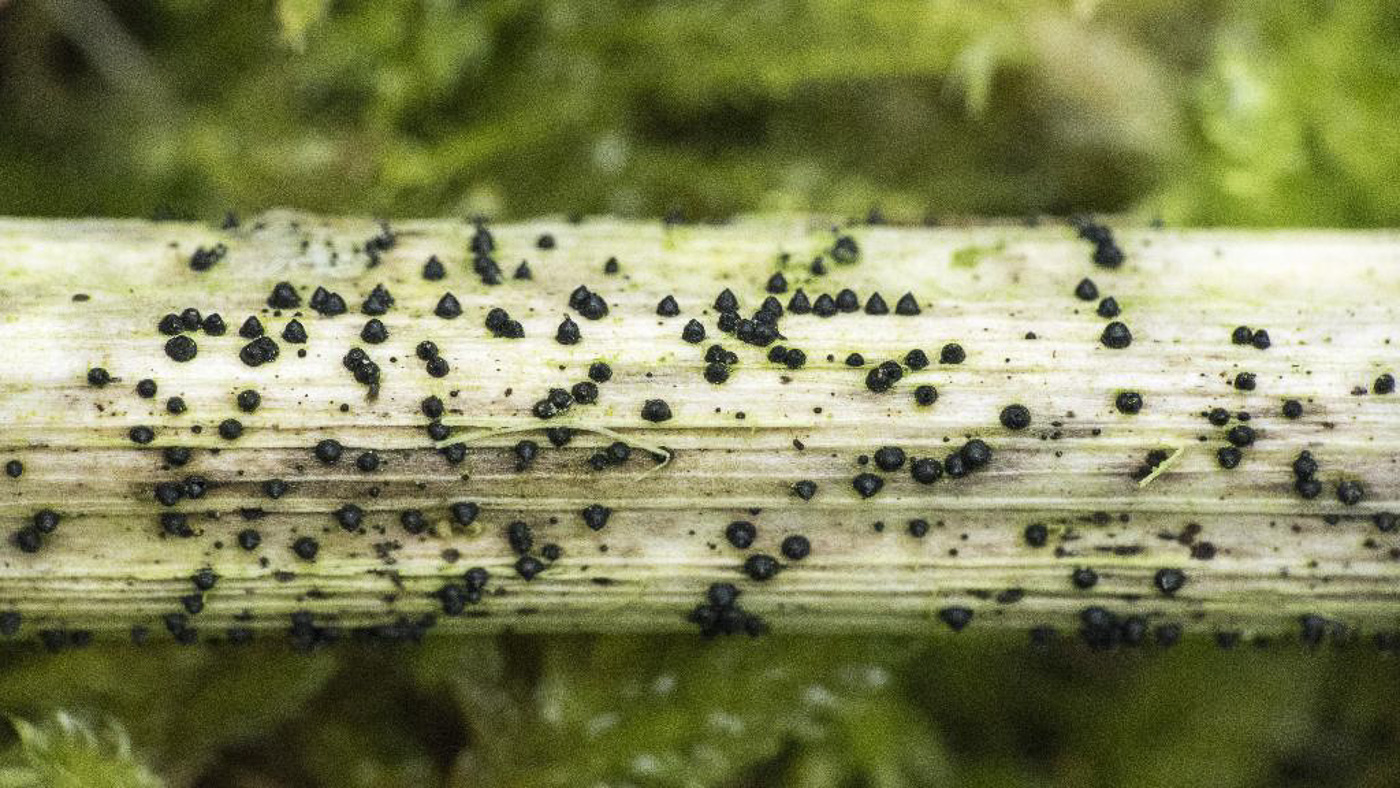 |
February 1st Leptosphaeria acuta (Nettle Rash)
In Rushbeds Wood Penny found extremely little to report despite the present milder spell, so resorted to looking for two small and very common springtime Ascos found on the lower part of last year's Nettle stems. She then discovered she'd left her camera behind! So the photo here is Neil Fletcher's, taken at this site in April 2017 and showing a typical cluster of shiny black 'bee hives', each less than 0.5mm high. This is one of two species to look out for on nettle stems over the next couple of months.
|
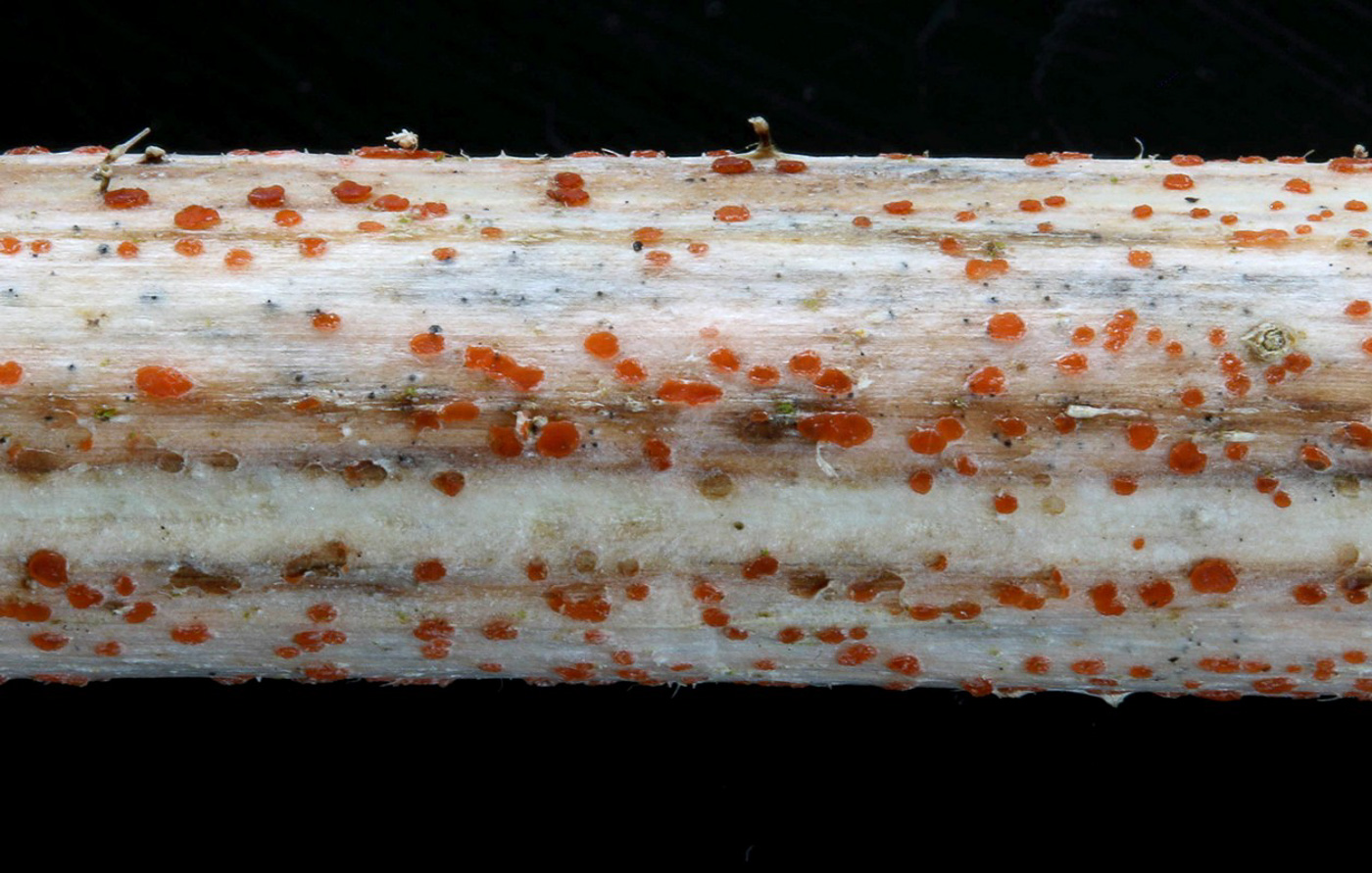 |
February 1st Calloria neglecta (Nettle Pox)
This was the second of two small springtime Ascos on Nettle stems Penny found at Rushbeds Woods today. The photo is Claudi Soler's, taken near Bicester in April 2018 and showing a colony of bright orange tiny cups which are under 1mm across. This was a particularly nice example and often one finds just faint orange patches, with no cups visible, to show that the species was present. Both this species and Leptosphaeria acuta above are host specific to Nettle and occur commonly from now until April or so.
|
January 31st 2022
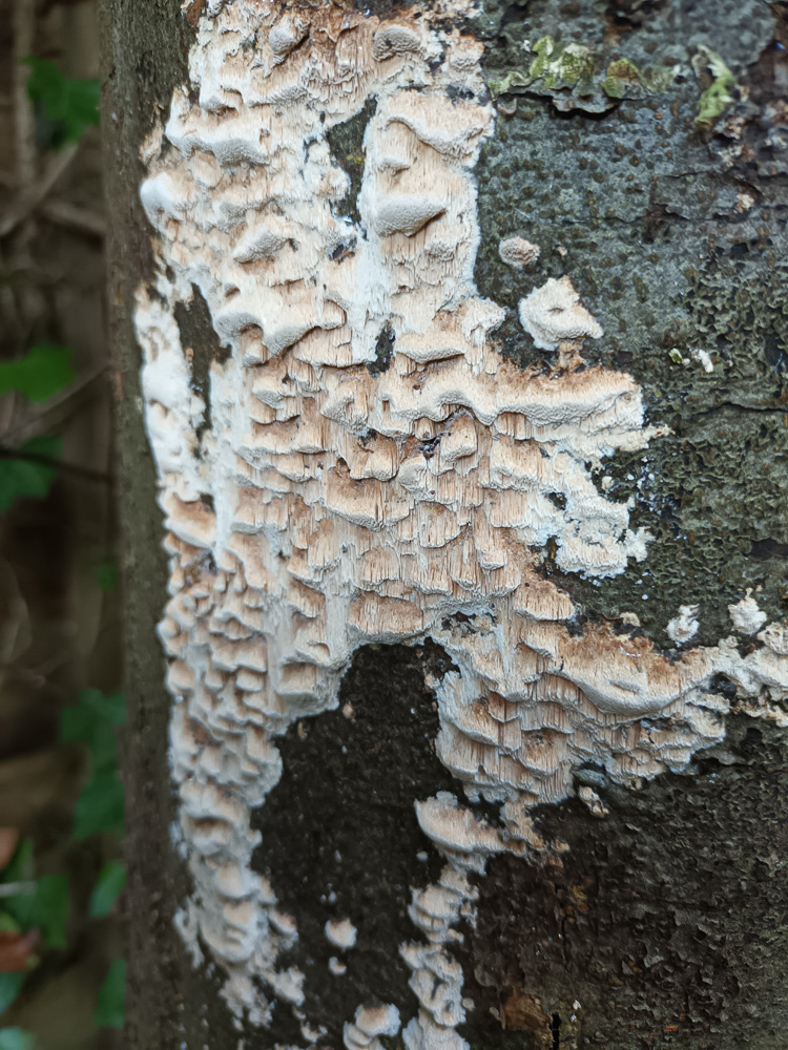
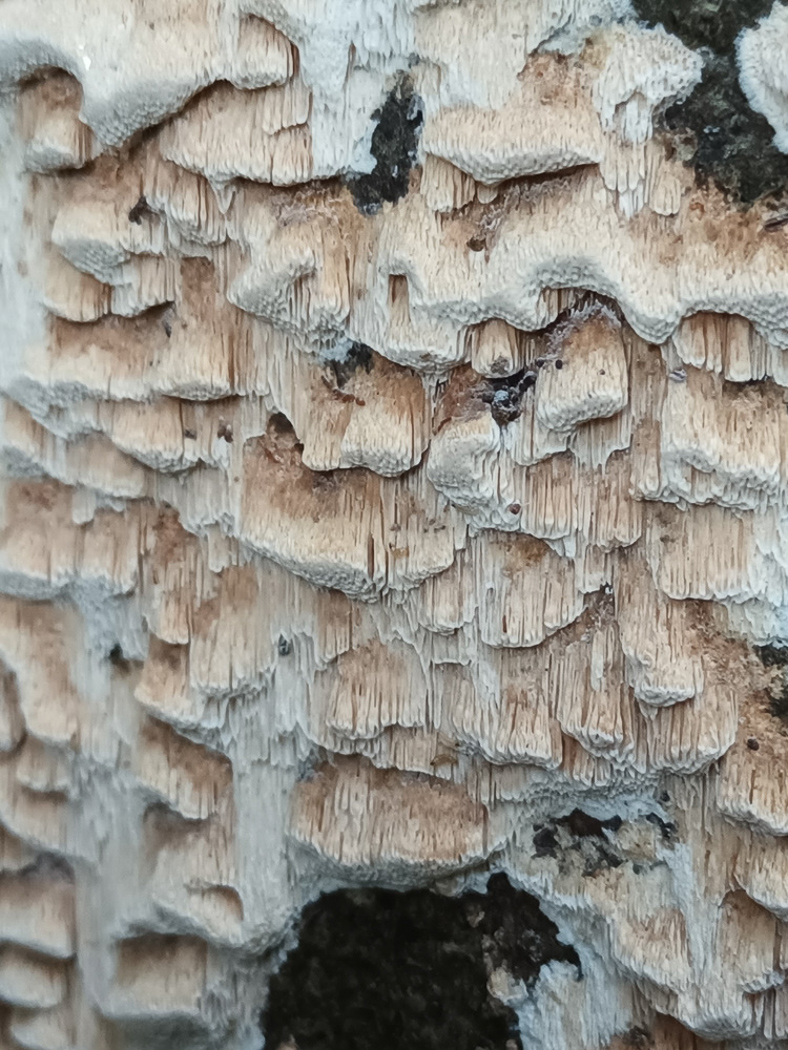 |
January 31st Ceriporiopsis gilvescens (Pink Porecrust) 
On a Beech stump near Jordans village Jesper Launder found this interesting patch of distinctive and strongly poroid fungus which he didn't recognise, so took some home to work on. He struggled to find a satisfactory answer and though his photos were then sent to Penny, Derek and also expert Alan Lucas, nothing definite was forthcoming. However, eventually a sporeprint and other microscopic details noted by Jesper clearly matched those for this species despite the fact that illustrations in various books showed a fully resupinate species rather than one forming the tiers of deep pores seen here. However, he then found several examples of images online which match well, furthermore the typical pink coloration can clearly be seen developing here. We have a good handful of county records but this is particularly interesting example.
|
 |
January 31st Scytinostroma portentosum (Mothball Crust) 
On fallen Sycamore in woodland near Jordans Village Jesper Launder found this fairly nondescript resupinate but one which has a very useful field clue to its identity if you know to test for it. It has a distinctive and strong smell of Naphthalene, ie mothballs - hence its common name (though the species is in fact quite rare). It has a soft waxy cream surface often developing a pinkish tint as seen here, and is reportedly most often found on Willow though our four previous county records, all from Dancersend, were on Beech. So this was a nice find and a first for our Finds pages.
|
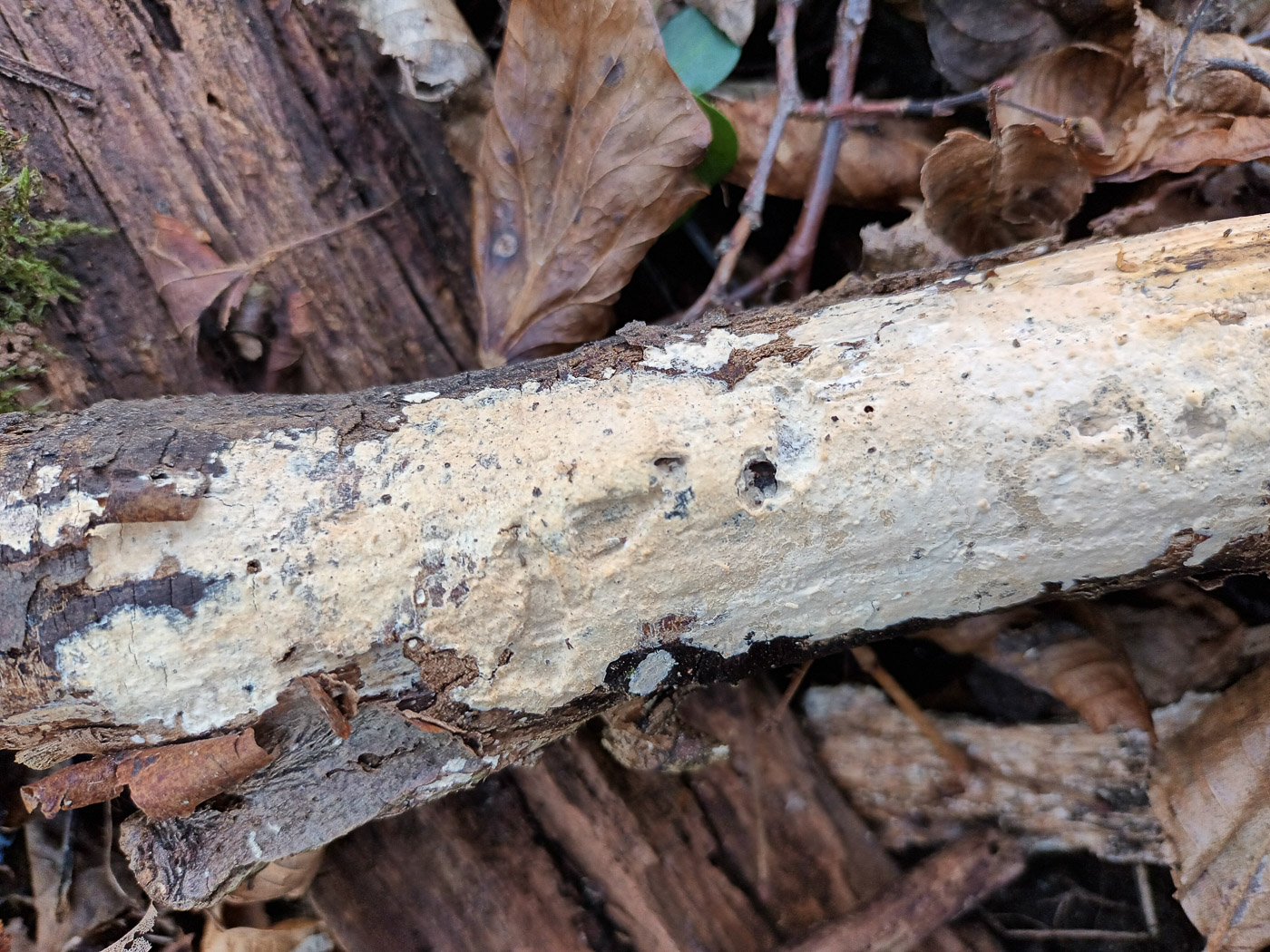 |
January 31st Radulomyces confluens (a corticioid with no common name) 
In woodland near Jordans Village Jesper Launder noticed this typical corticioid on unidentified fallen deciduous wood. The species is described as having a rough lumpy surface, pale watery white when fresh but becoming drying with a pinkish tinge as here. A useful field character, noticed by Jesper, is its distinct smell of Phenol when scratched, but Jesper also confirmed his identification checking its distinctive spores. It is quite common but a first for our Finds pages.
|
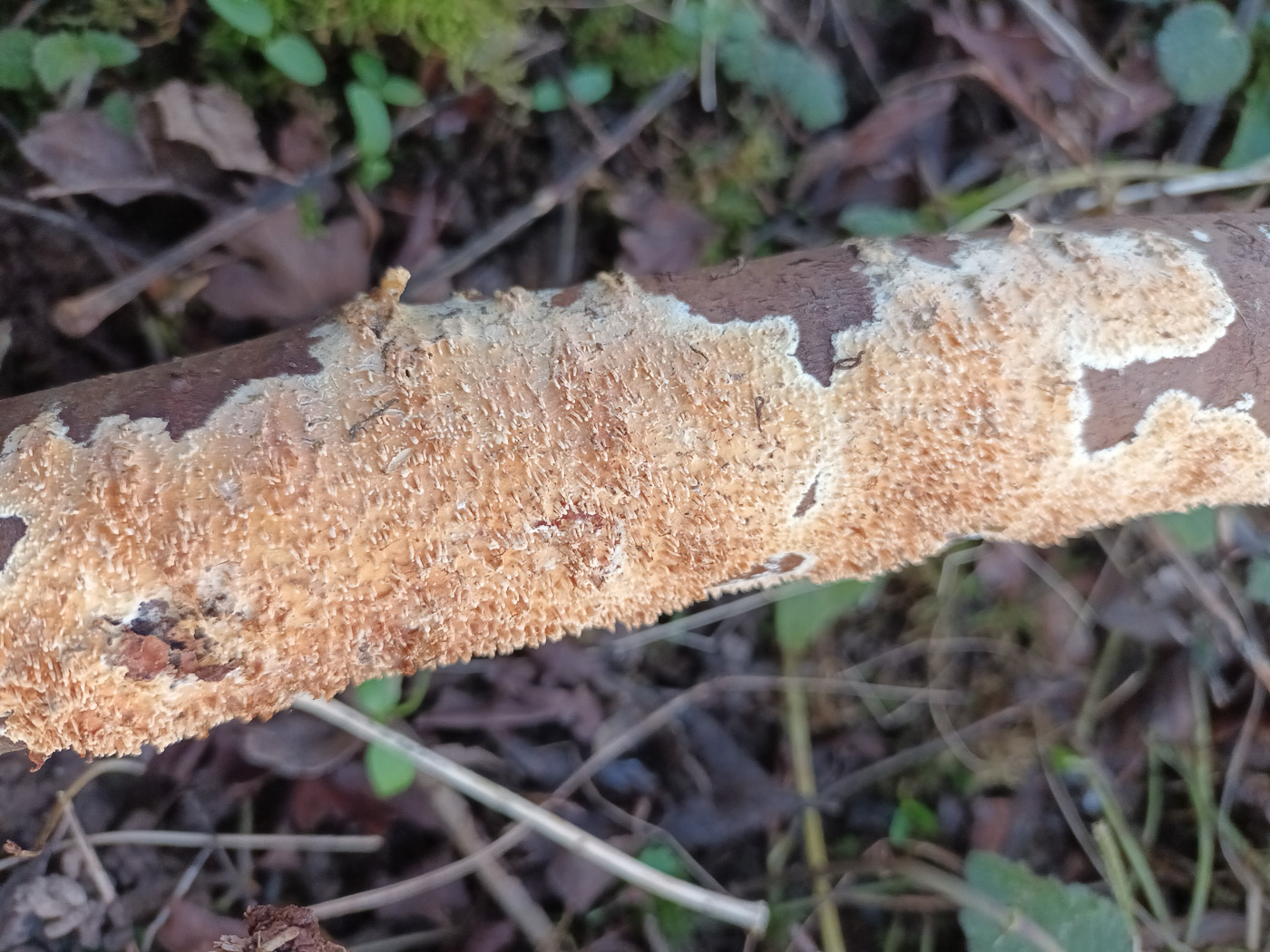 |
January 31st Basidioradulum radula (Toothed Crust)
In woodland near Jordans Village Jesper Launder noticed this resupinate on fallen Cherry. This is one of our commonest corticioids, growing on the bark of many different deciduous fallen woods. It starts out forming small roundish patches, white and smooth at the edge but cream and almost toothed in the centre. Gradually the patches coalesce to form larger areas as here. See other examples on Finds 2020 December 7th, also 2021 January 28th and February 13th.
|
January 30th 2022
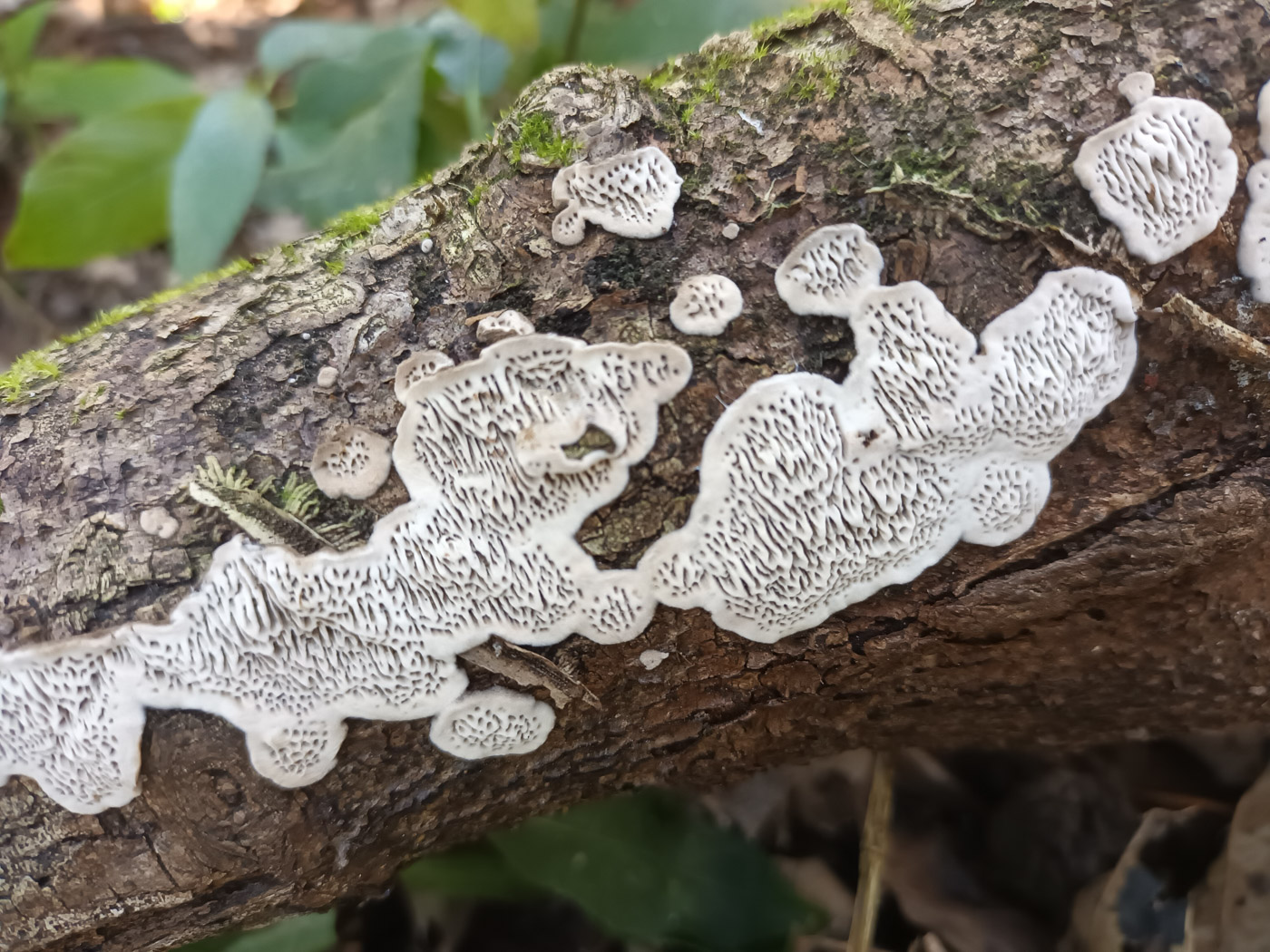 |
January 30th Datronia mollis (Common Mazegill)
In woodland near Jordans Village Jesper Launder found fresh material of this common species on fallen deciduous wood. Unlike other brackets also named Mazegill (for obvious reasons), this one starts out resupinate and long remains so, eventually forming only a small shallow brownish bracket if that. The labyrinthine surface is soft and whitish as here when fresh but soon becomes tough and darkens to ochre or brown. A useful clue to its identity is that it peels off the substrate very easily, unlike most resupinate fungi. This is a new species for our Finds pages.
|
January 29th 2022
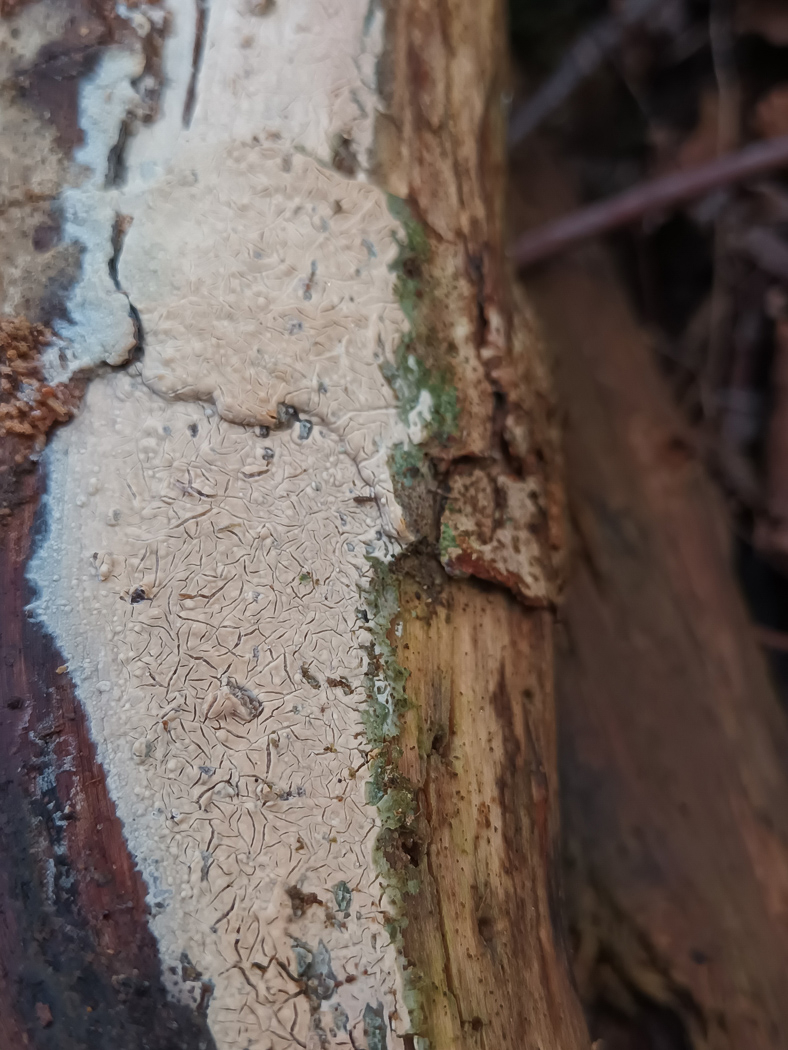 |
January 29th Gloeocystidiellum porosum (a corticioid with no common name) 
In woodland near Jordans Village Jesper Launder picked up this slightly pinkish flat specimen on an unidentified deciduous stick and took it home to identify. When fresh it is whitish cream and has a smooth waxy texture then becomes pinkish buff and cracked as here as it ages, and though it looks similar to many other such species, the microscopic characters are very distinctive. It is considered common and occurs on many different deciduous woods but we have only three previous records.
|
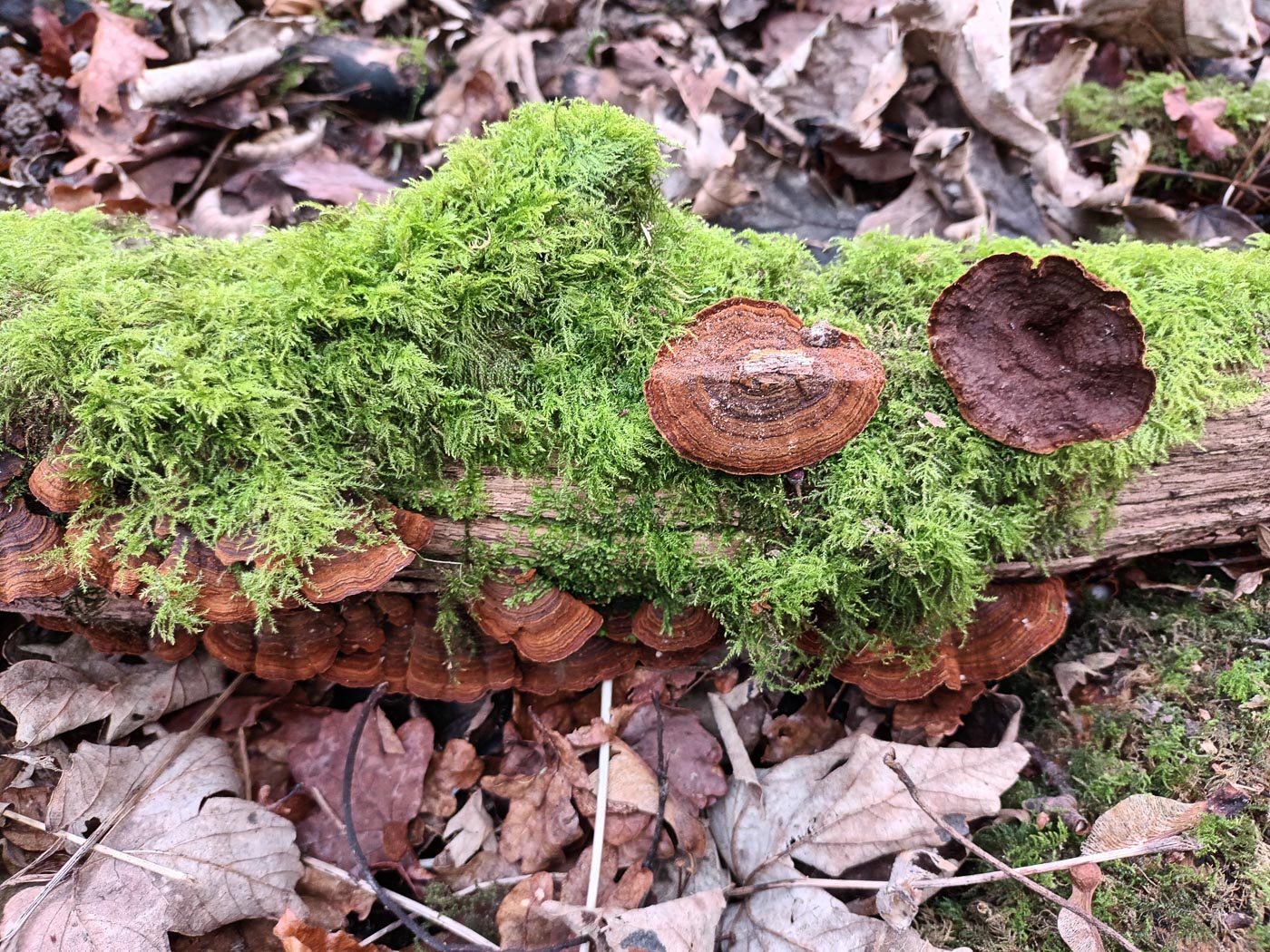 |
January 29th Hymenochaete rubiginosa (Oak Curtain Crust)
In woodland near Jordans Village Jesper Launder noticed this nice example on unidentified fallen wood though the species is most common on Oak, occasional of Sweet Chestnut. It commonly forms rows of zoned cinnamon brown brackets but occasionally forms complete circles, as seen here. It is easily separated from other similar zoned brackets by its dark brown undersurface. See another example on Finds 2020 October 19th.
|
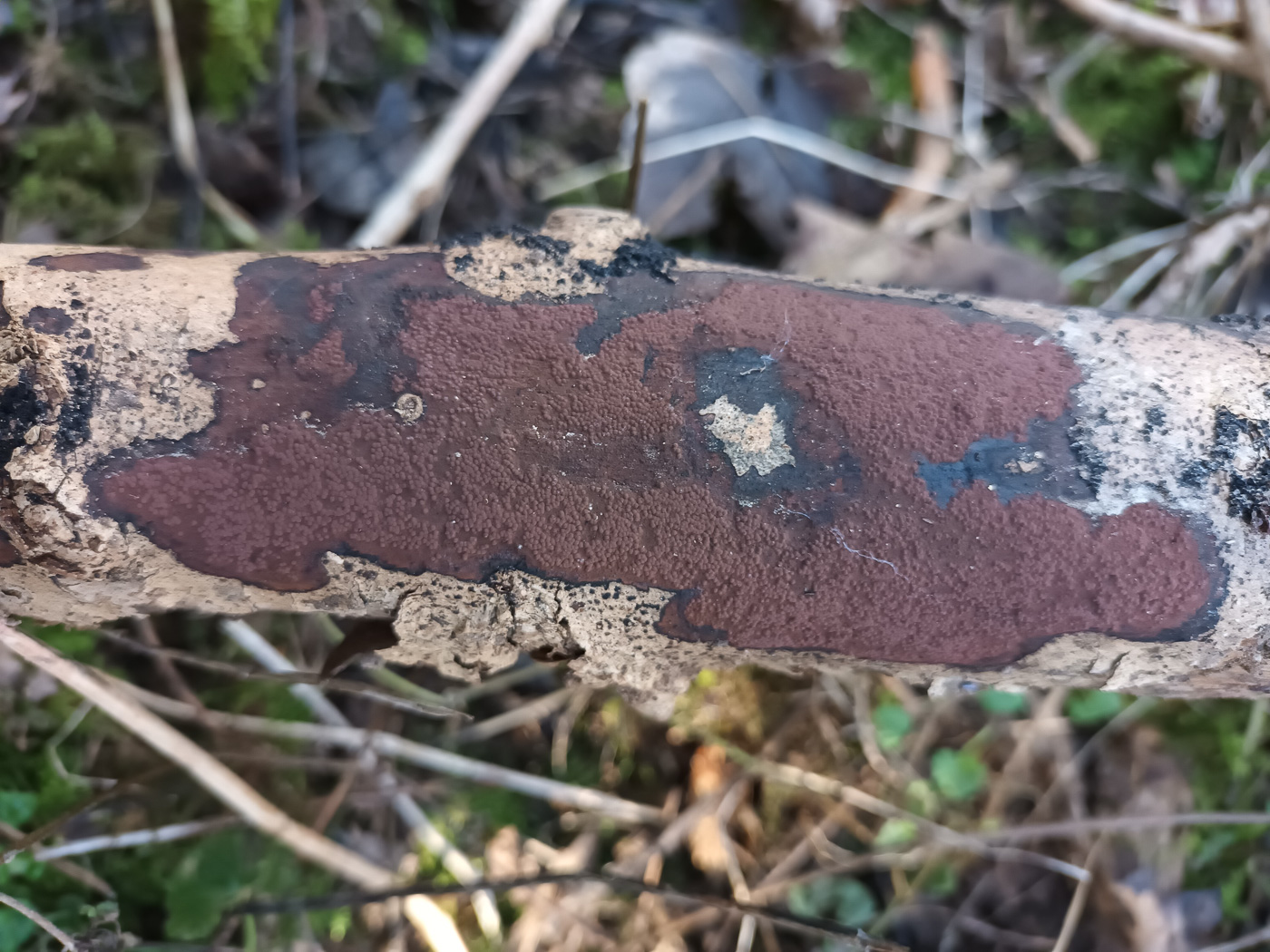 |
January 29th Hypoxylon rubiginosum (Rusty Woodwart)
On fallen Ash near Jordans Village Jesper Launder spotted a nice patch of this quite distinctive Pyrenomycete, ie a crusty Asco. The species is found commonly on this host but unlike other Woodwarts (such as the Beech and Hazel Woodwarts which form individual 'warts') it forms flattish patches starting out smooth and reddish brown then gradually becoming bumpy and darker brown as it matures as seen here. Though common, this is the first entry for our Finds pages though we have examples of the other two Woodwarts mentioned.
|
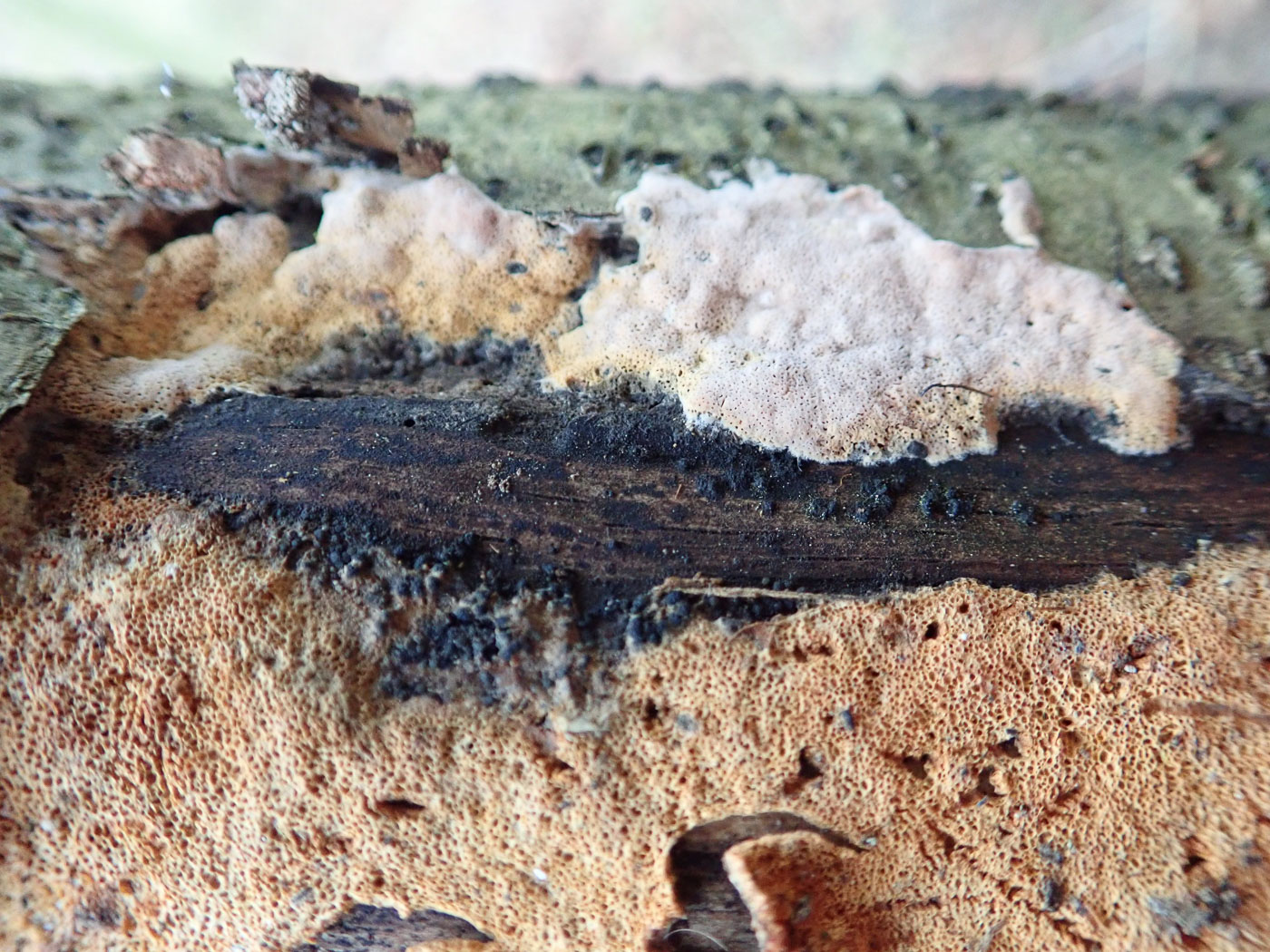

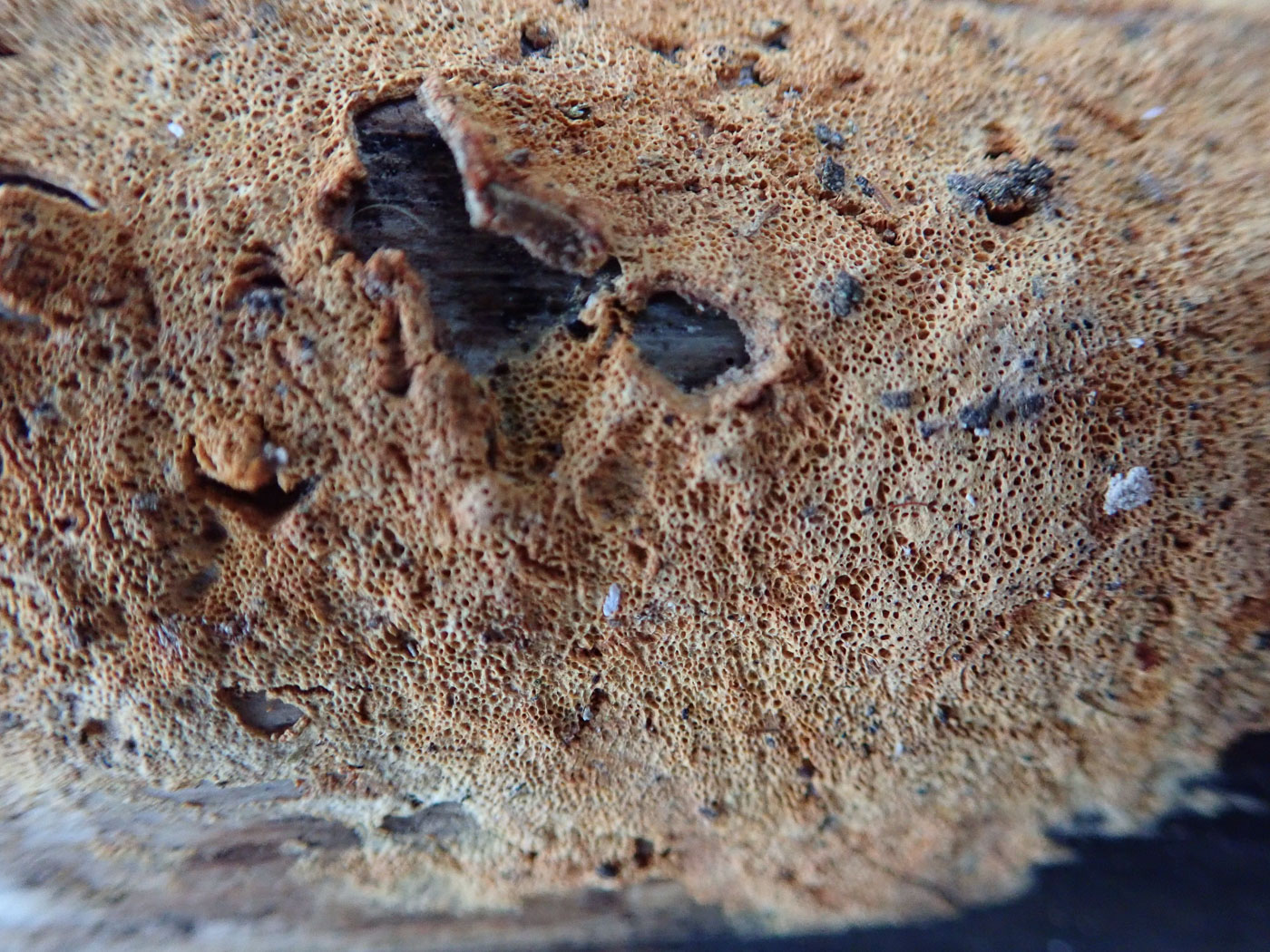
 |
January 29th Schizopora flavipora (a resupinate fungus with no common name)
In Dancersend John Tyler found this 'crust' on fallen Hazel which he didn't recognise, so sent the photos to Penny in the hope of identification. This not being Penny's strong suit, she was a bit doubtful of her skills to name it but suggested it was possibly Schizopora flavipora, then sent John's photos off for expert Alan Lucas's opinion. He agreed that this was correct, adding the comment that as it was not that rare it was not going to be controversial to record it without a microscopic check. The species is closely related and very similar to the extremely common and also very variable S. paradoxa (Split Porecrust) but is far less common, in fact we appear to have just one previous record. This could in part be due to the fact that we often identify S. paradoxa in the field without checking if it might possibly be S. flavipora which has smaller spores, though it does become a recognisably more distinct buff to almost orange colour as seen here.
|
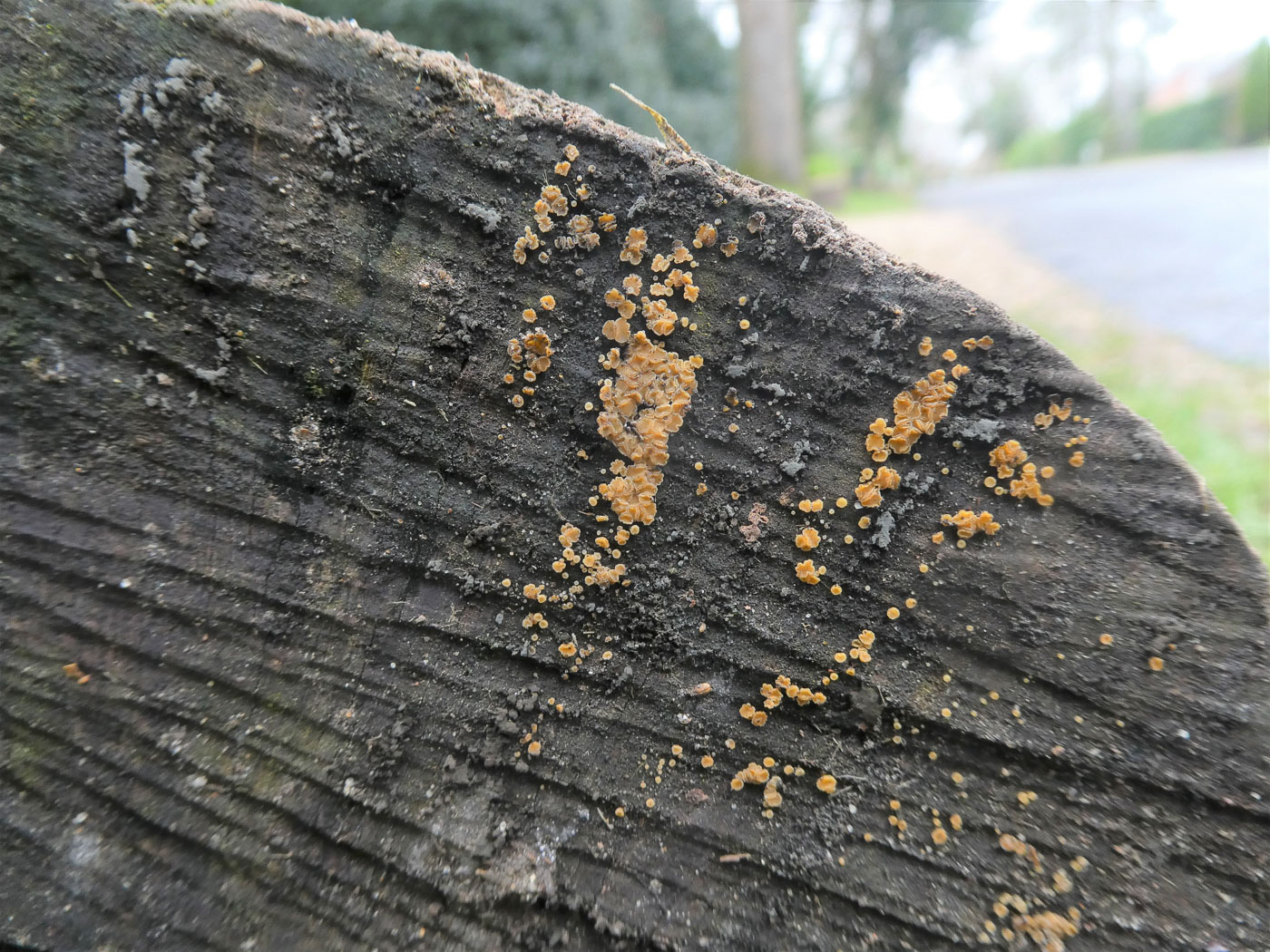
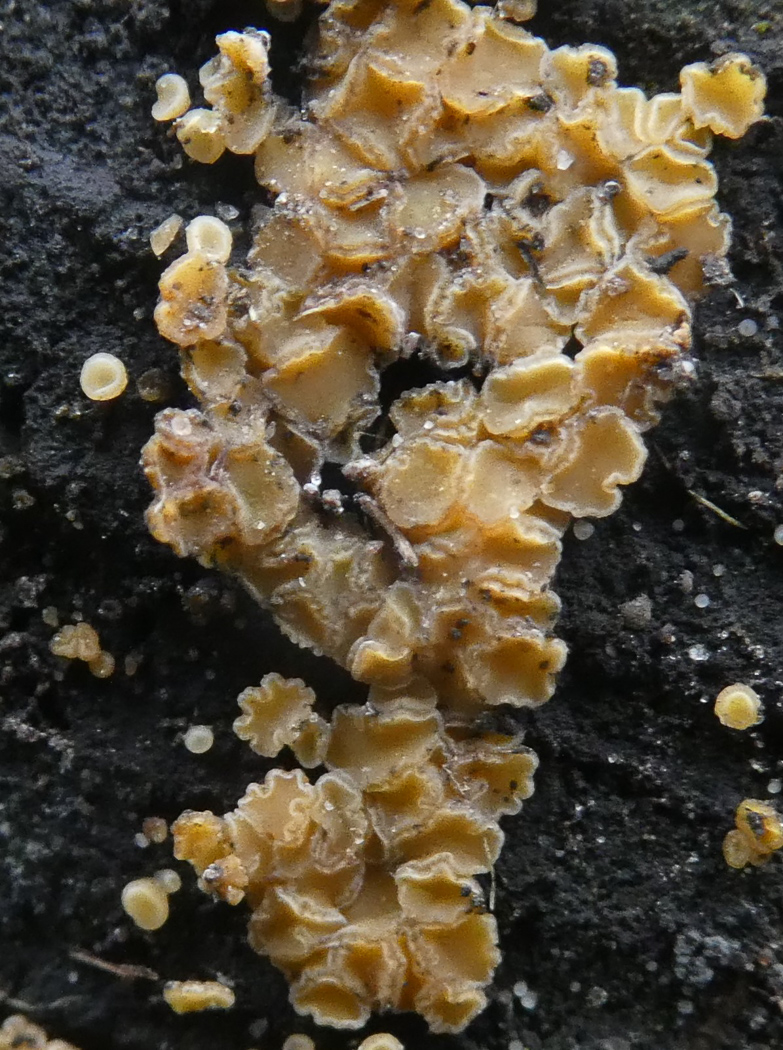 |
January 29th Bisporella subpallida (an Asco related to Lemon Disco with no common name)
Over the last couple of weeks Jim Wills has been keeping an eye on this colony of tiny cups he found on a sawn end of a deciduous trunk in Chalfont St. Peter, suspecting it might be maybe frosted material of something like Bisporella citrina (Lemon Disco). However, it appeared to be thriving, clearly palish ochre and not yellow, also consistently a bit frilly round the edges, so he sent the photos to Penny for confirmation. Without checking the spores one cannot be entirely sure, but this does appear to be very convincing material of a species for which we have only a few records. (The somewhat similar B. pallescens is also a possibility here but is paler still and grows on the black silky surface of an early stage of Bispora antennata, not seen here.)
|
 |
January 29th Hypholoma fasciculare (Sulphur Tuft)
At Stampwell Farm Jackie Ewan noticed this nice fresh clump today. It may be a very common species but it's nice to see any freshly fruiting mushrooms at this time, especially after the spell of frosts which have rather curtailed entries for Finds in recently. For further images see Finds 2021 October 27th, together with others on earlier pages.
|
January 28th 2022
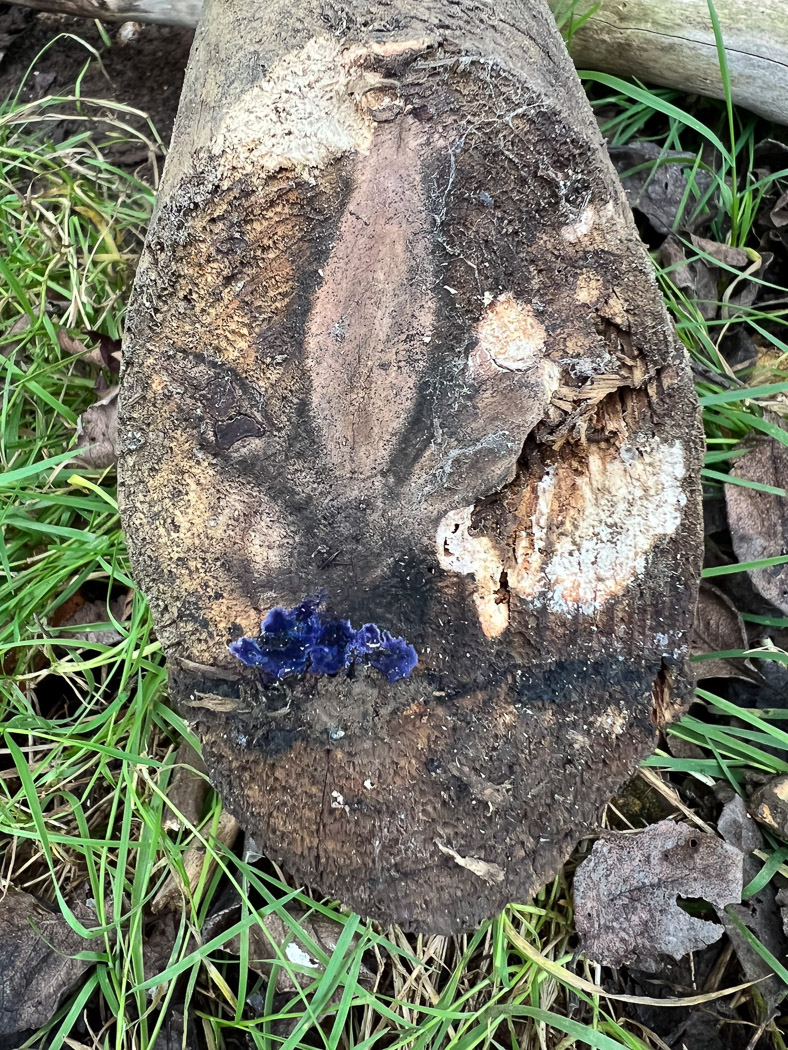
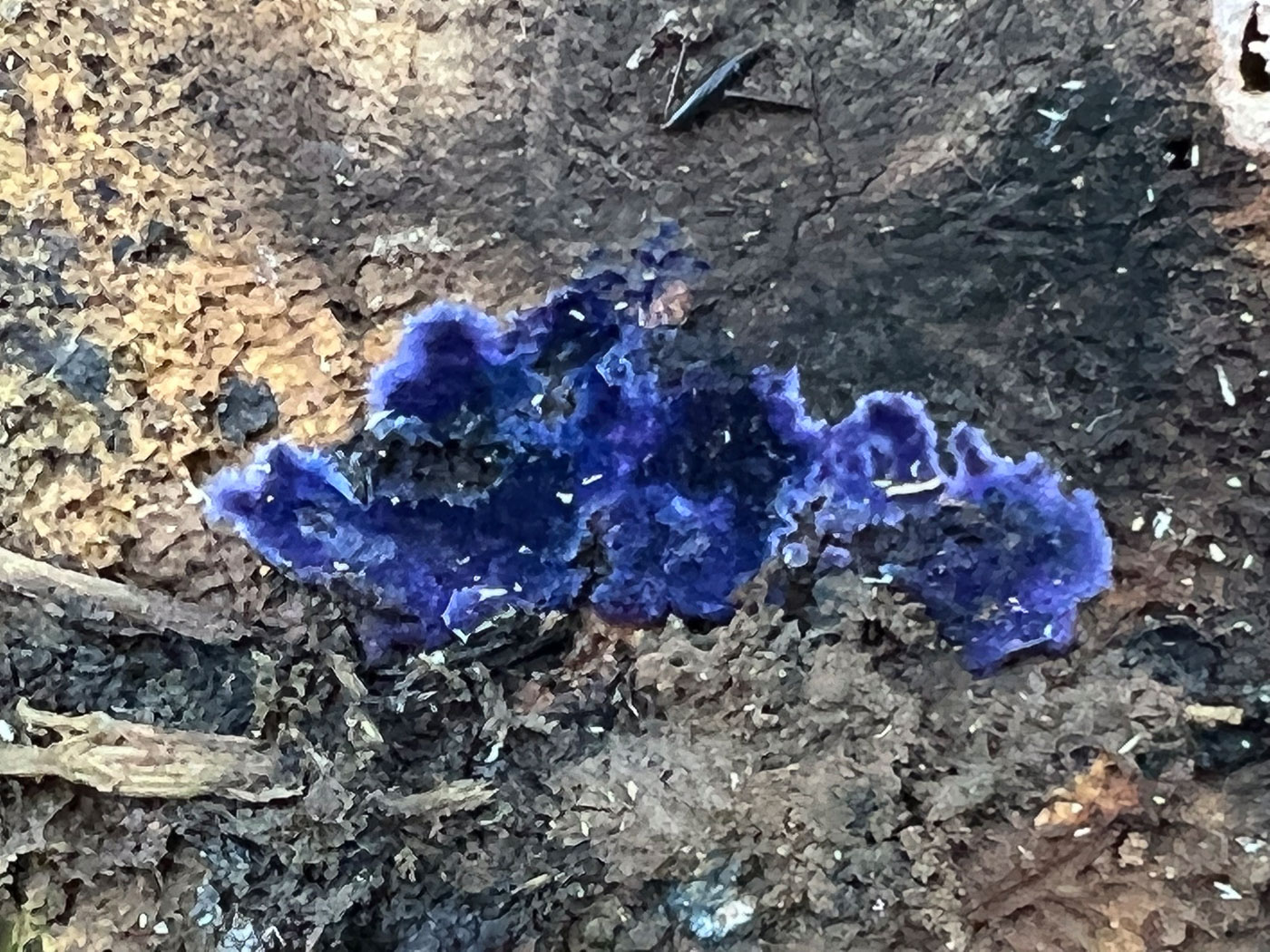
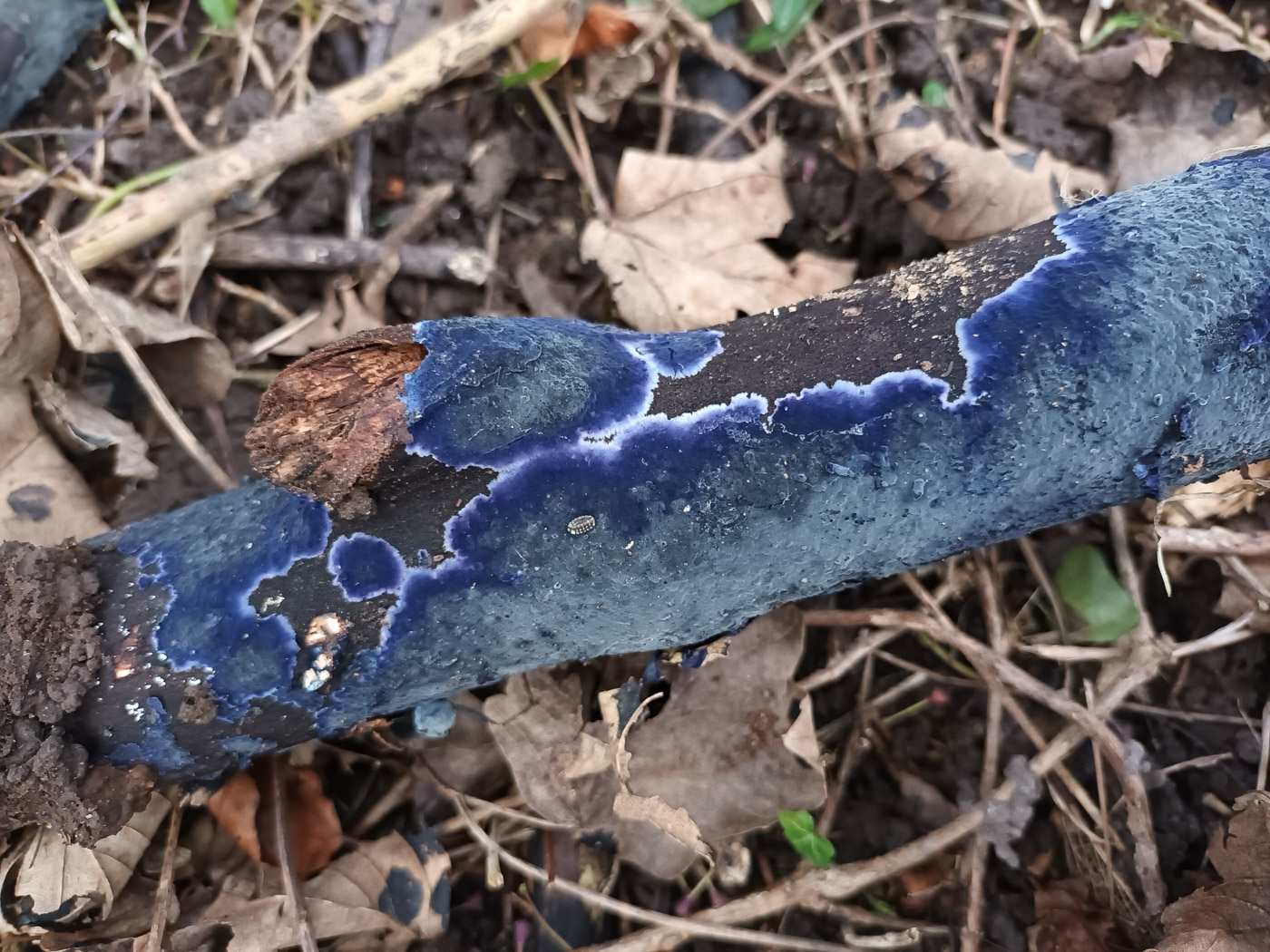 |
January 28th Terana caerulea (Cobalt Crust)
Whilst on his allotment in Walters Ash Neil Fletcher spotted a patch of bright blue on an old post in a pile of rotting wood. He soon realised this was not paint, as he wondered at first glance, but this rare but unmistakeable corticioid fungus for which we have just a handful of county records, mostly under the older name Pulcherricium caeruleum, and with just two in the last five years. This amazing colour is unique amongst resupinate species, and the whitish edge seen here is also typical. The fungus occurs on decaying deciduous wood and gradually spreads out, becoming flat and adhering tightly to the substrate. As so often happens, Jesper Launder then sent Penny his stunning photo (photo 3) taken the next day of the same species found on fallen Sycamore near Jordans Village.
|
January 24th 2022
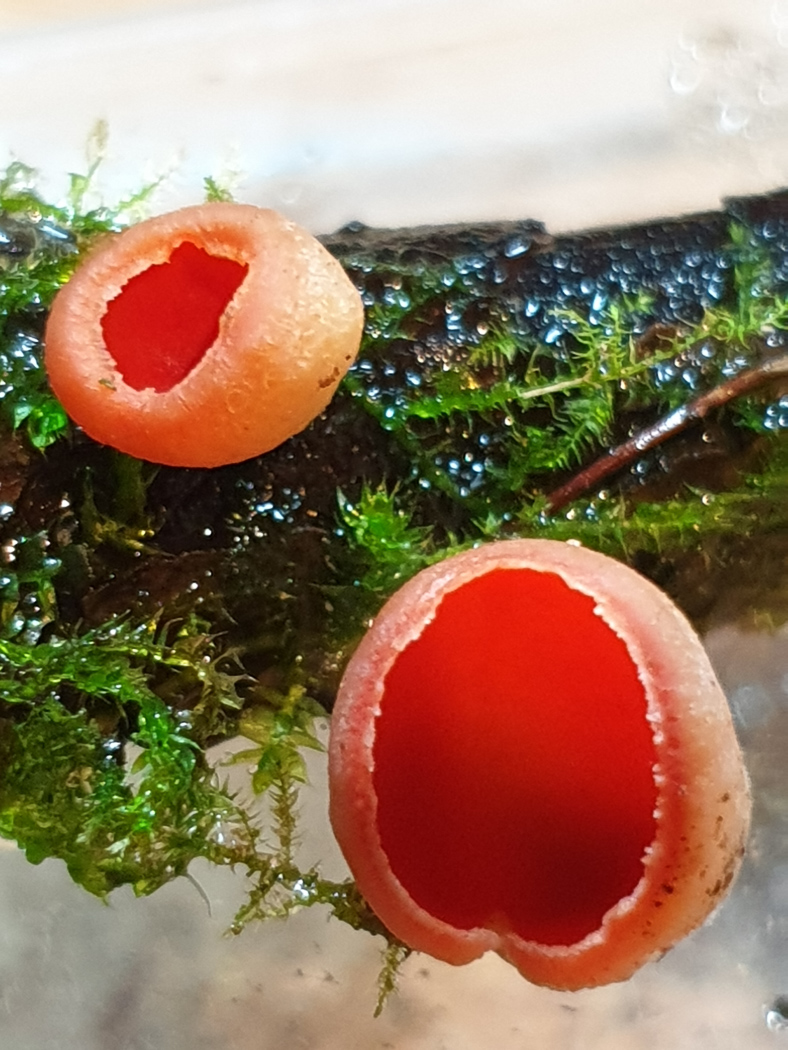 |
January 24th Sarcoscypha austriaca (Scarlet Elfcup)
Jackie McKenzie Dodds sent Penny this photo of a collection fruiting on a deciduous stick picked up on our Rushbeds Walk last November when she'd spotted some tiny pale pink blobs on it. In the field Penny was fairly sure of their identity but suggested Jackie should retain the stick at home, keeping it moist and weathered, to see if it would develop further to confirm this early springtime species. It did! Rushbeds is known as a reliable site for it though surprisingly a thorough search there by Penny recently was fruitless. See also Finds 2022 January 1st.
|
January 22nd 2022

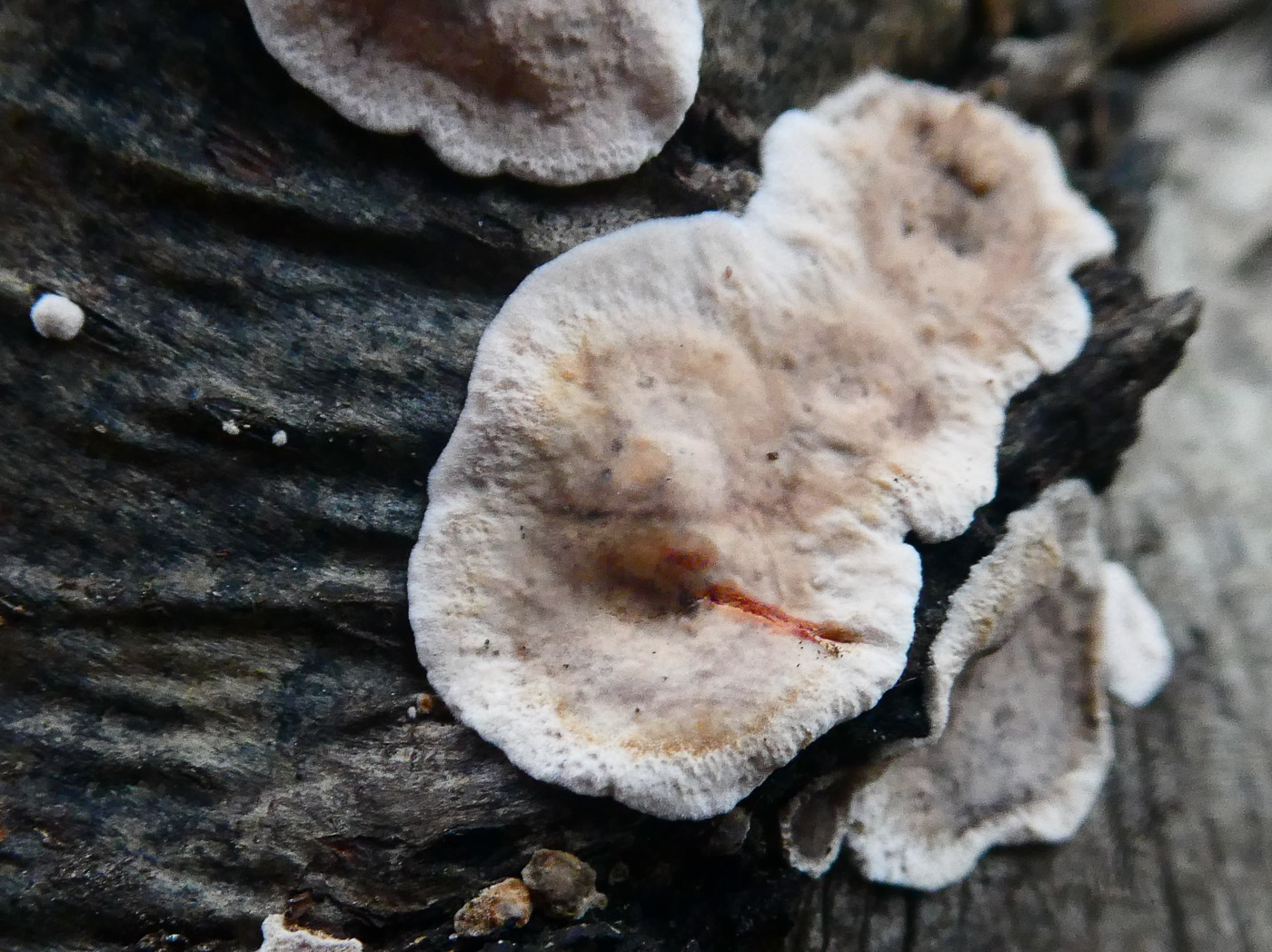 |
January 22nd Stereum rugosum (Bleeding Broadleaf Crust)
In Stoke Common Jim Wills noticed fresh material of this flattish species fruiting on Birch. It tends to form irregular patches which sometimes join up to make quite big patches, usually remaining pale pinkish and flat.The photos show the species both before and after damaging, demonstrating the typical reddening which happens within seconds when the specimen is fresh. Two other Stereum species also redden in this way: S. gausapatum, typically on Oak, tends to turn yellow and a bit curly at the edges; S. sauinolentum is easinger to be sure of because it is only found on conifer. None of them redden once dry and past their sell-by date! Examples of all three can be found in Finds 2020.
|
January 17th 2022



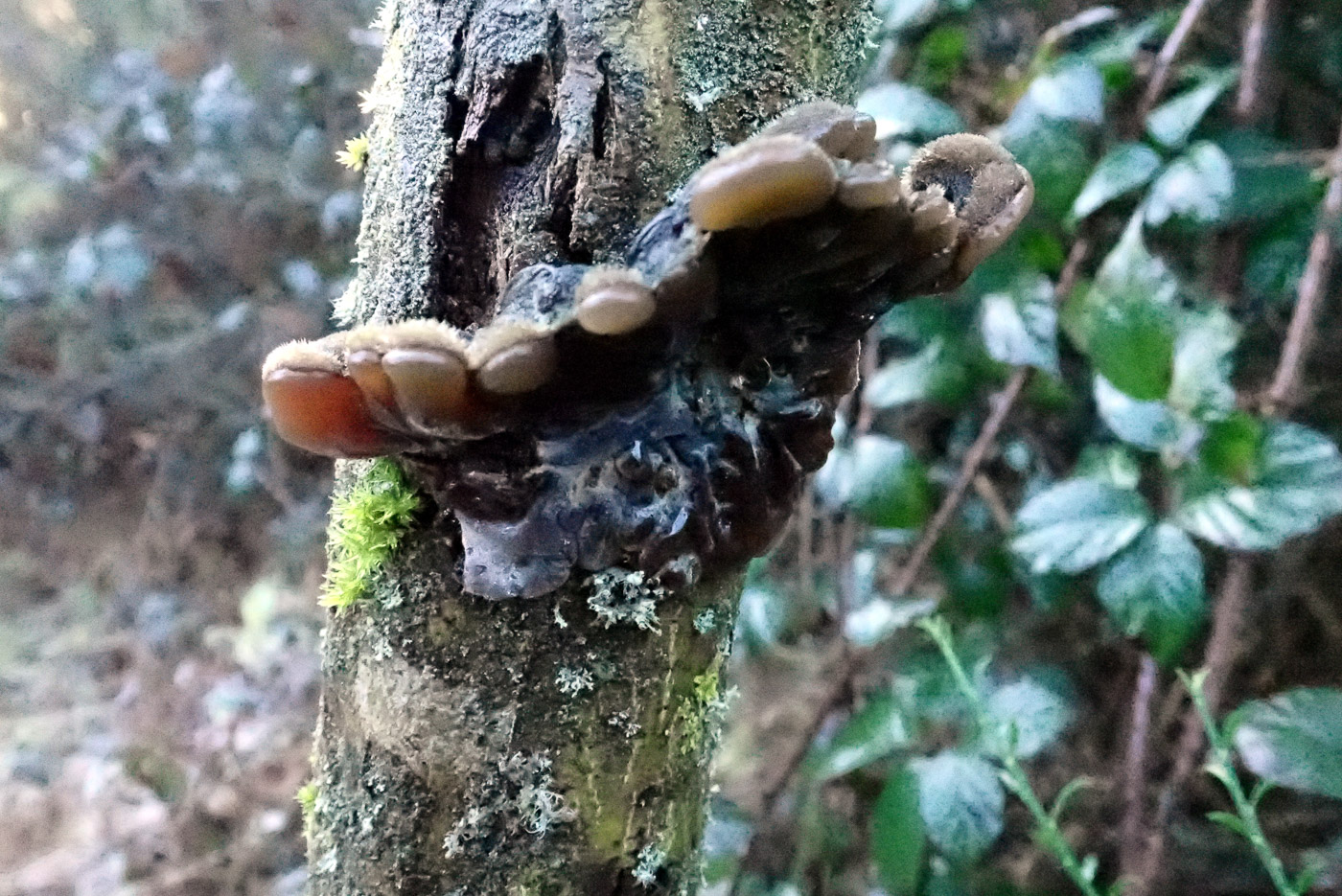 |
January 17th Auricularia mesenterica (Tripe Fungus)
Whilst searching for various species which occur with Gorse in Burnham Beeches, Penny came across a broken stump with nice fresh collections of this species, closely related to Jelly Ear though shaped very differently. It is more bracket-like and here forming tiers, the upper surface rather hairy but rubbery gelatinous (photo 3) and sometimes zoned, the underside more wrinkled to veined and becoming darker to purple almost black (photo 4). It is not rare and can occur on various deciduous stumps or dead wood, also shrubs and Gorse as here. See also Finds 2020 October 28th where the zoned upper surface and veined underside is shown well.
|
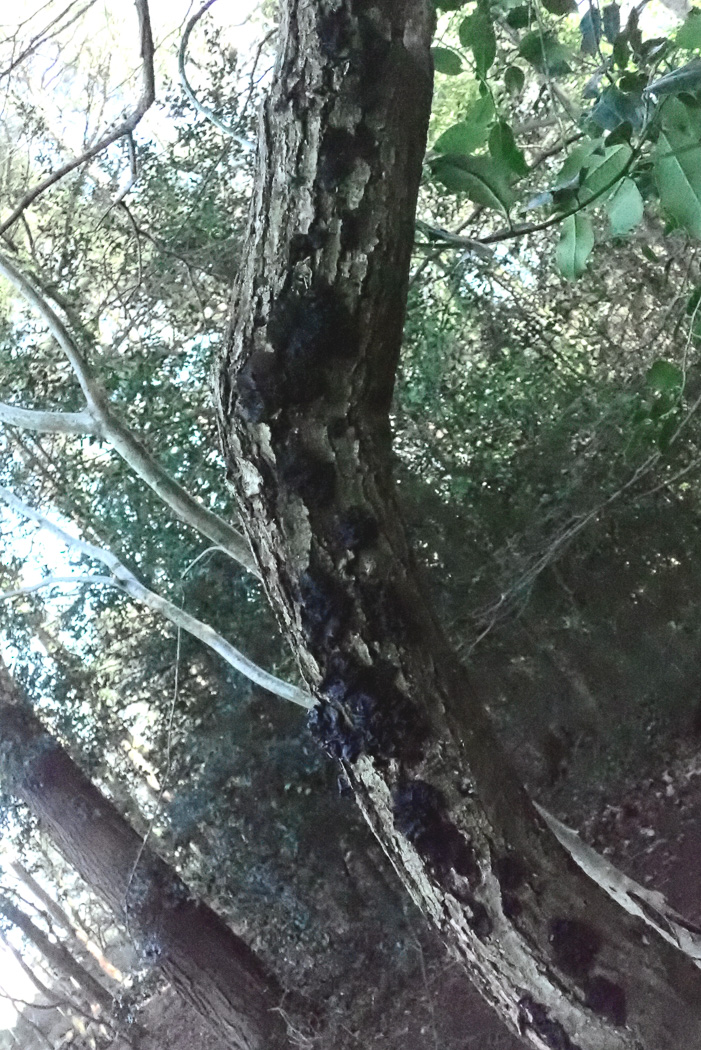
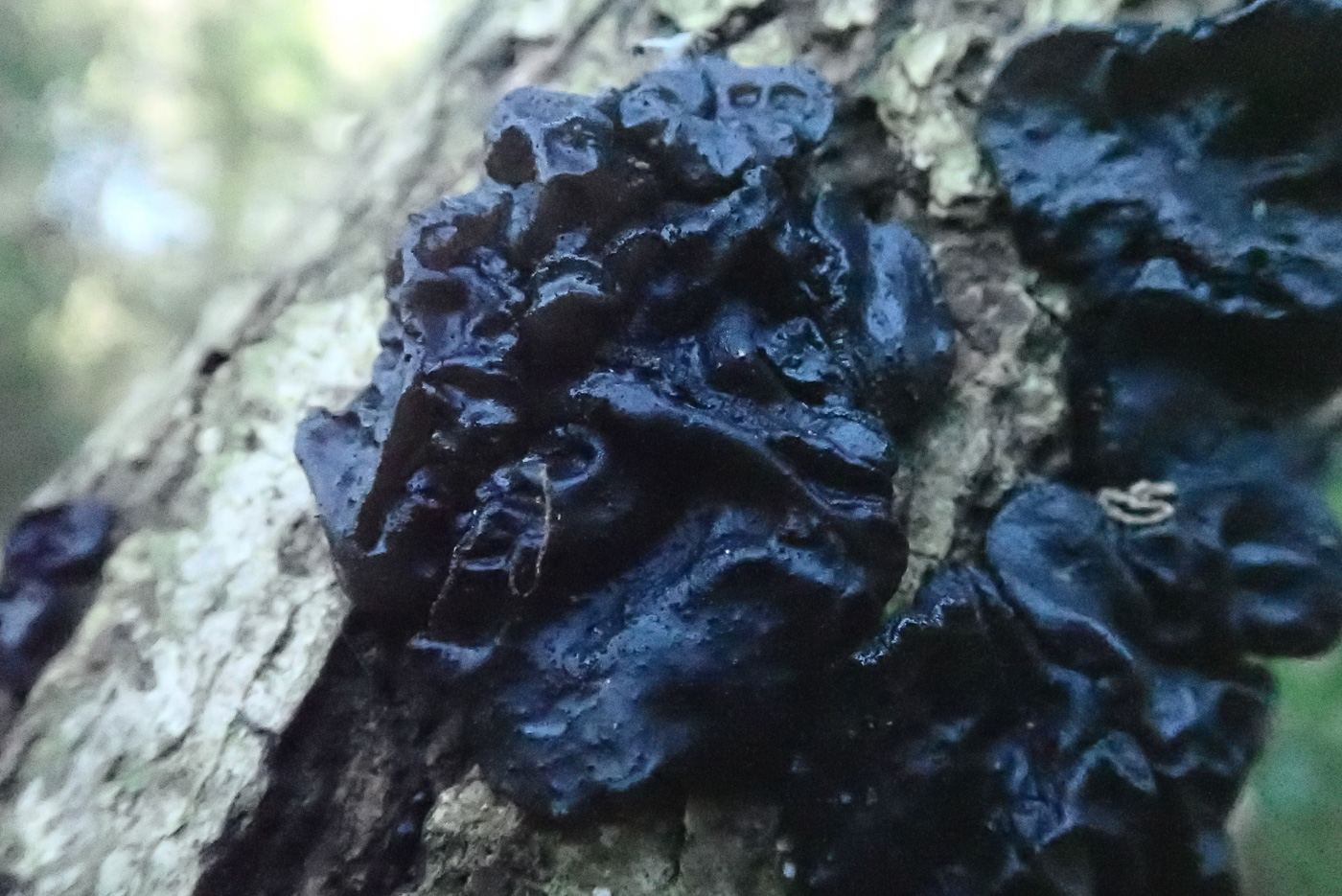
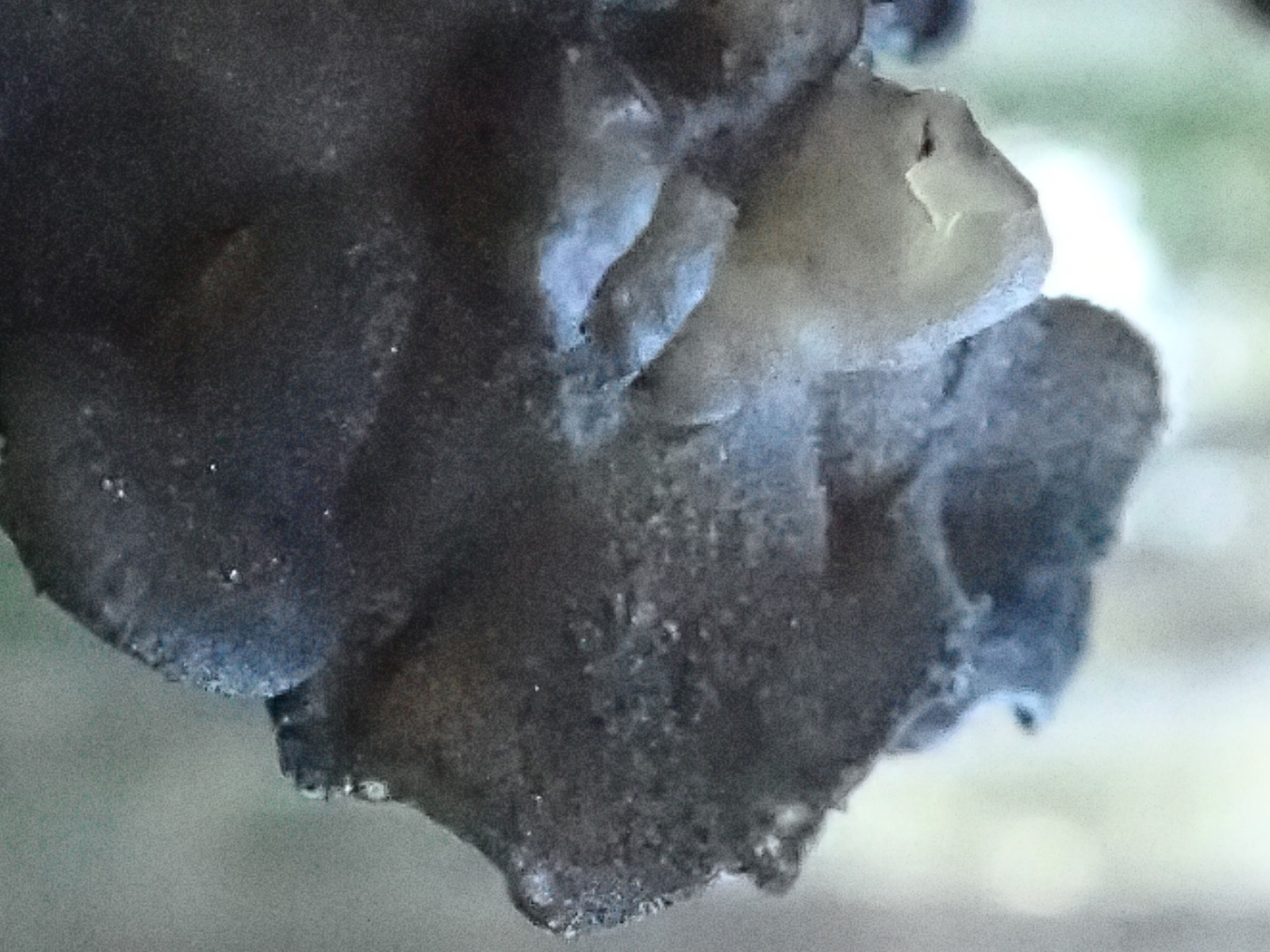 |
January 17th Exidia nigricans (Warlock's Butter) 
On a deciduous attached branch in Burnham Beeches Penny found this jelly fungus liberally fruiting and took a piece home to check the spore size. There is a fair amount of confusion regarding the names - both Latin and common - of two very similar species, E. glandulosa and E. plana. Both have been known as Witch's Butter and also confused with each other, but it appears now that what was E. plana is now E. nigricans (as named here) with a different common name also. The two are best separated by spore size (larger in today's species), but in the field E. nigricans forms a rather shapeless wrinkled shiny black brainlike mass, sometimes extending over 12 cms or more as seen here, easily detached from the substrate. E. glandulosa forms smaller patches but of bigger individual black 'cushions' and is more securely attached to the substrate. Both species have a bumpy slightly warty undersurface (seen in photo 3 - apologies for the quality!). Compare with E. glandulosa on Finds 2022 Jan 1st where the larger more shaped cushions can be seen.
|
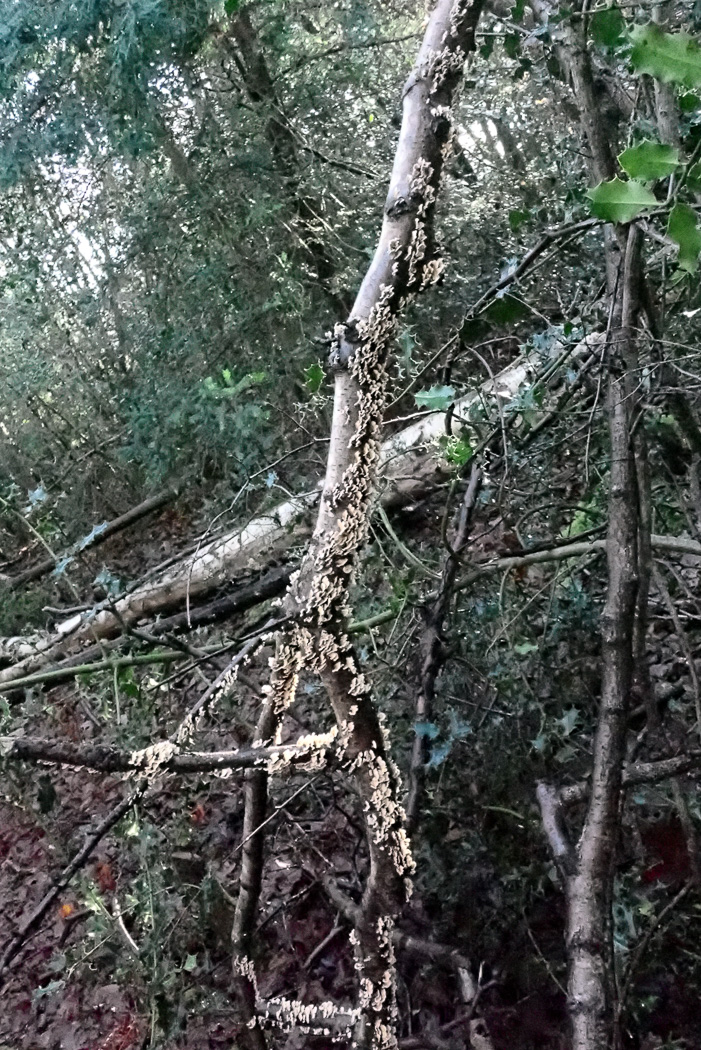

 |
January 17th Plicaturopsis crispa (Crimped Gill)
In Burnham Beeches Penny saw many examples of this species which is now becoming quite common, particularly on Birch as here. Photo 1 shows a thinnish broken branch liberally smothered with these small brackets; photo 2 is a closer example; photo 3 shows the underside with its distinctive fluted edge and unique crinkled gill-like structures, making this an easy species to separate from other small common brackets which can appear quite similar above. See other examples on Finds 2020 October 23rd and November 16th (as Plicatura crispa), also 2021 December 27th.
|

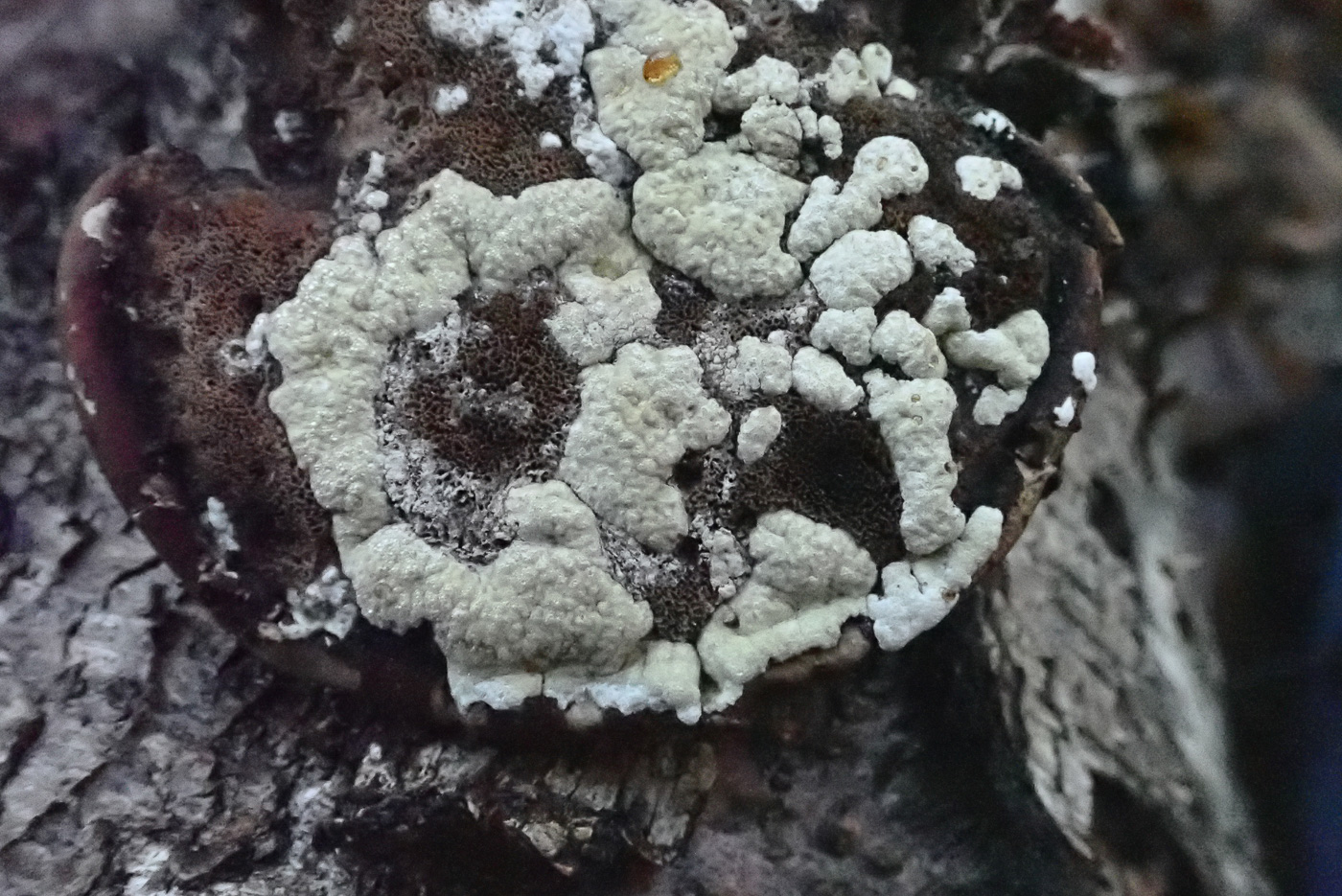
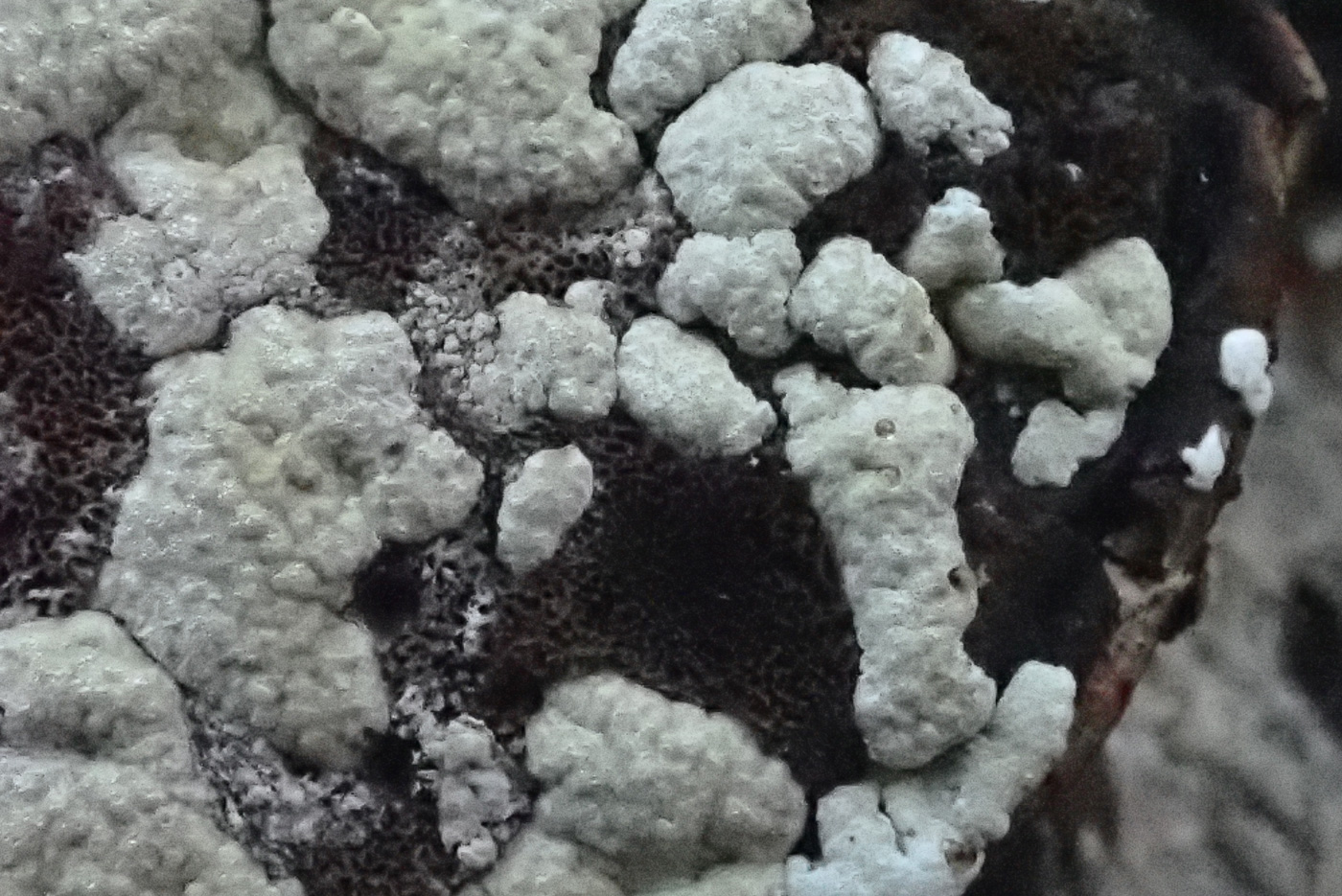
 |
January 17th Fomitopsis betulina (Birch Bracket) with Trichoderma pulvinatum (Ochre Cushion)
In Burnham Beeches on fallen Birch Penny found some old fruitbodies of this common bracket (previously Piptoporus betulinus) and, knowing the likelihood of then finding this ascomycete growing on the pores, she broke a bracket off to take a look underneath. Sure enough there it was (previously Hypocrea pulvinata). Photos 2 and 3 show it at an early whitish stage, in photo 4 it is just beginning to turn yellow. It eventually turns ochre then brownish in age. It is only found on the underside of old fruitbodies. For younger examples of F. betulina see Finds 2020 September 18th.
|
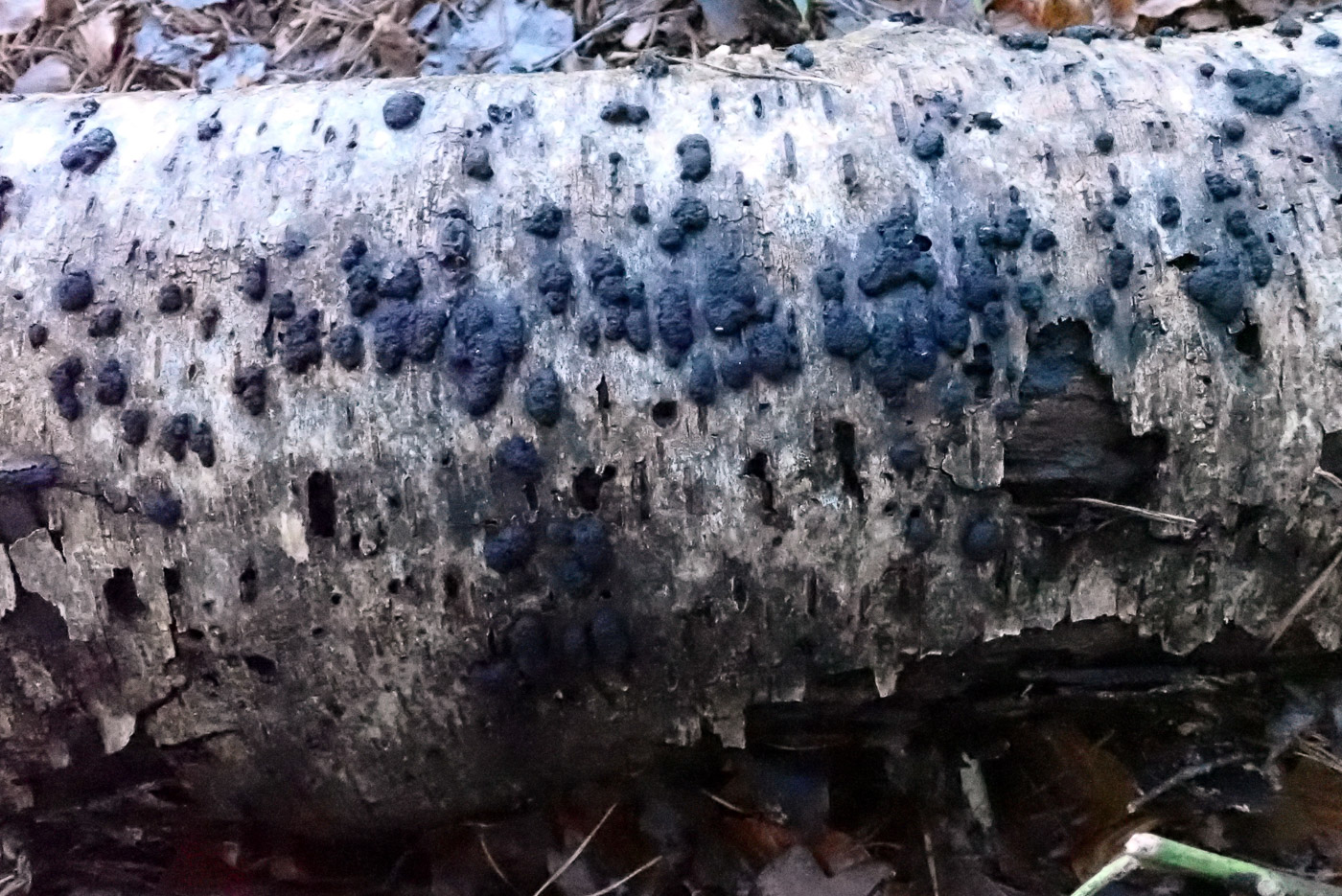
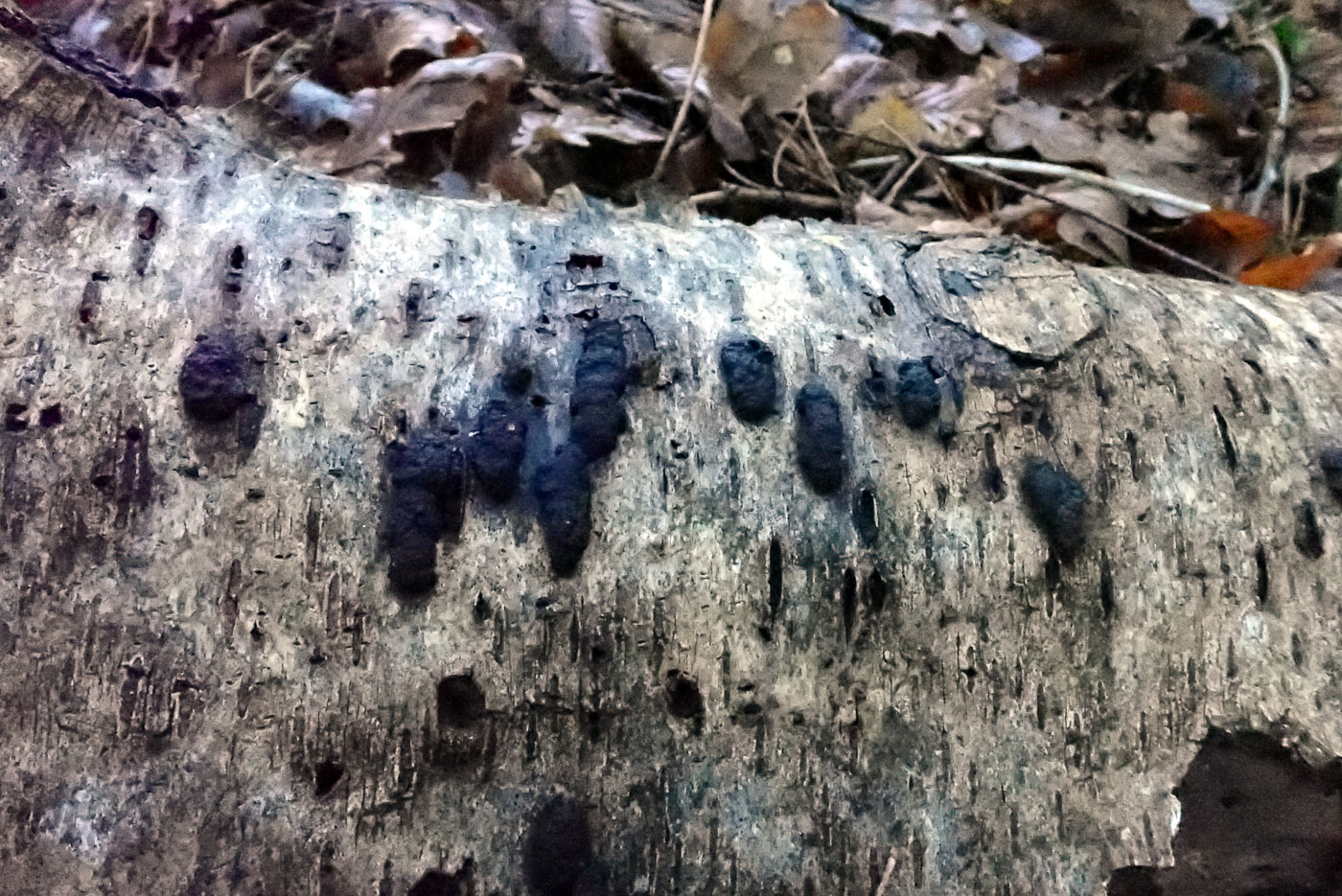
 |
January 17th Jackrogersella multiformis (Birch Woodwart)
In Burnham Beeches Penny found good examples of this common ascomycete - one of the hard crusty pyrenomycetes which will be more familiar under its old genus name of Hypoxylon (which incidentally is still in place for the equally common H. fragiforme (Beech Woodwart) and H. fuscum (Hazel Woodwart). Today's species is host specific to Birch and easily recognised by its lumpy elongated habit as seen here rather than forming colonies of round fruitbodies typical of other woodwarts. The surface is covered in tiny holes (ostioles) through which the spores are expelled, and when fresh it is reddish brown but gradually becomes darker then black. See also Finds 2020 November 30th (as Hypoxylon multiforme).
|
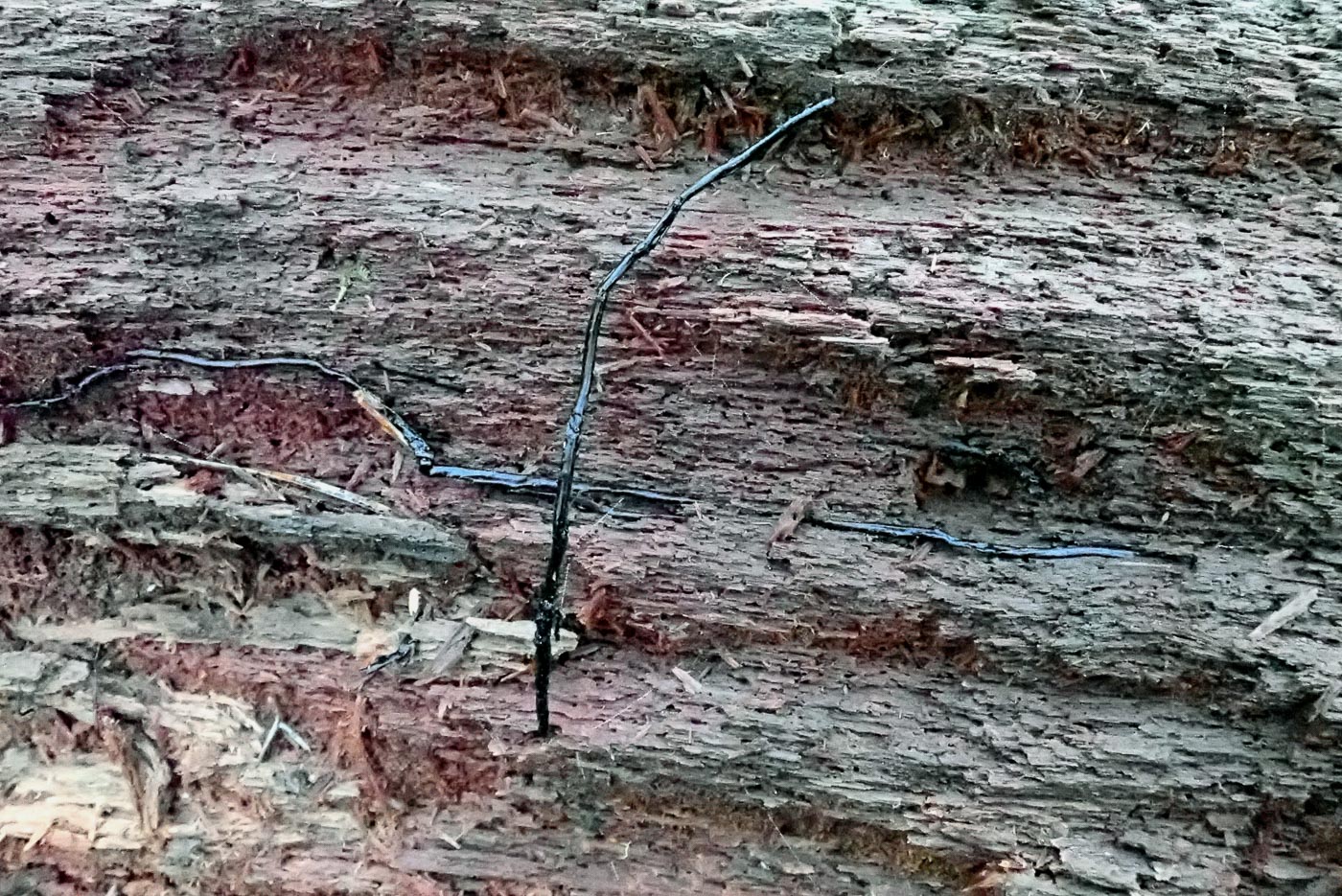

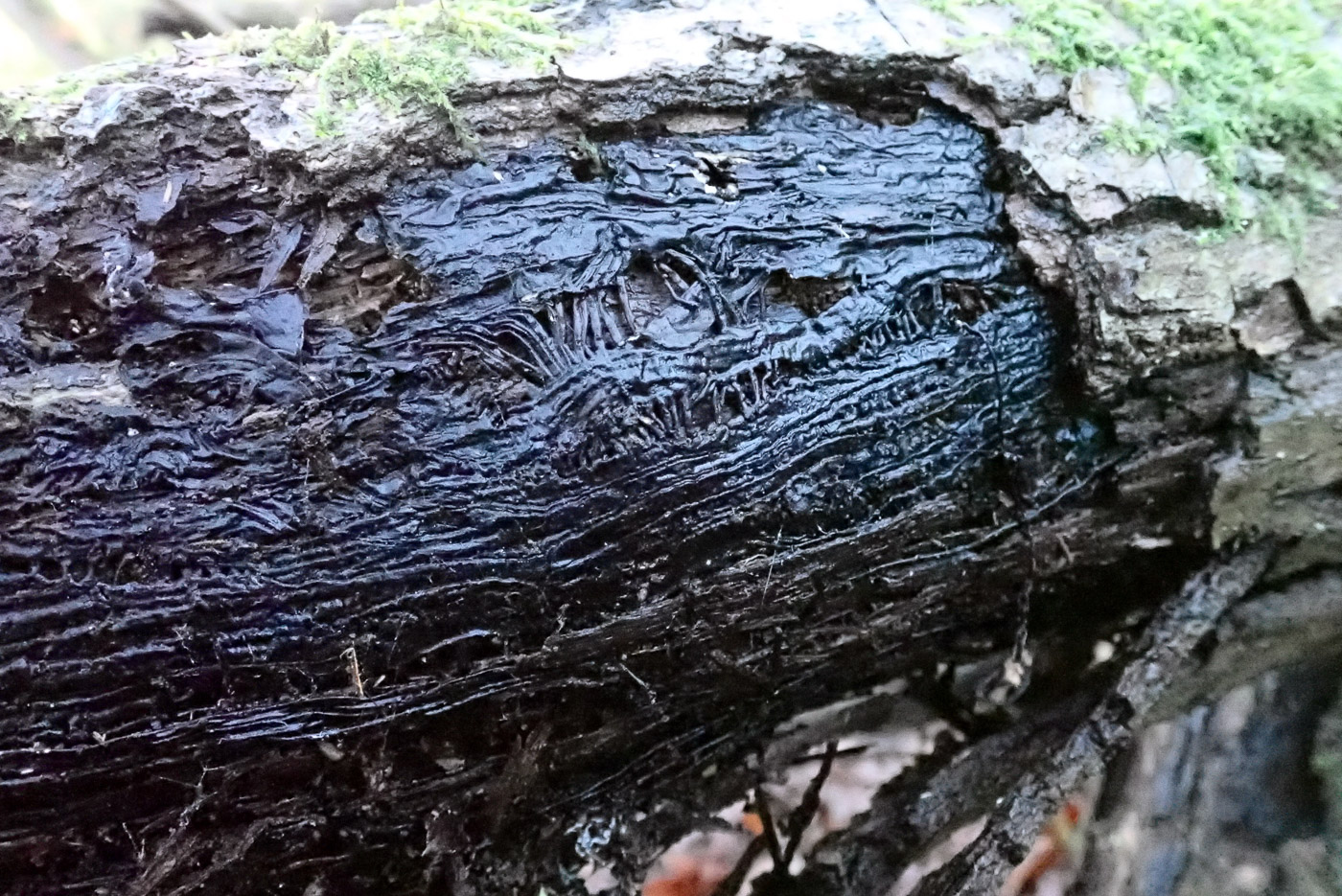 |
January 17th Armillaria sp. mycelium (Honey Fungus 'bootlaces')
In Burnham Beeches Penny noticed a fallen Beech trunk with good examples of the shiny black 'bootlaces' typical of Honey Fungus running both through the rotting wood and just under the bark and visible in a thick tangle (photo 3) where the bark had come off. The mycelium of most fungi is thin, white, feathery and delicate but this parasitic genus has developed these distinctive thick tough mycelial threads which enable it to spread rapidly and very successfully. This is one of the few genera identifiable from its mycelium though not to species, hence the 'sp' in the heading. (There are various entries available in the previous Finds pages of Armillaria fruitbodies.)
|
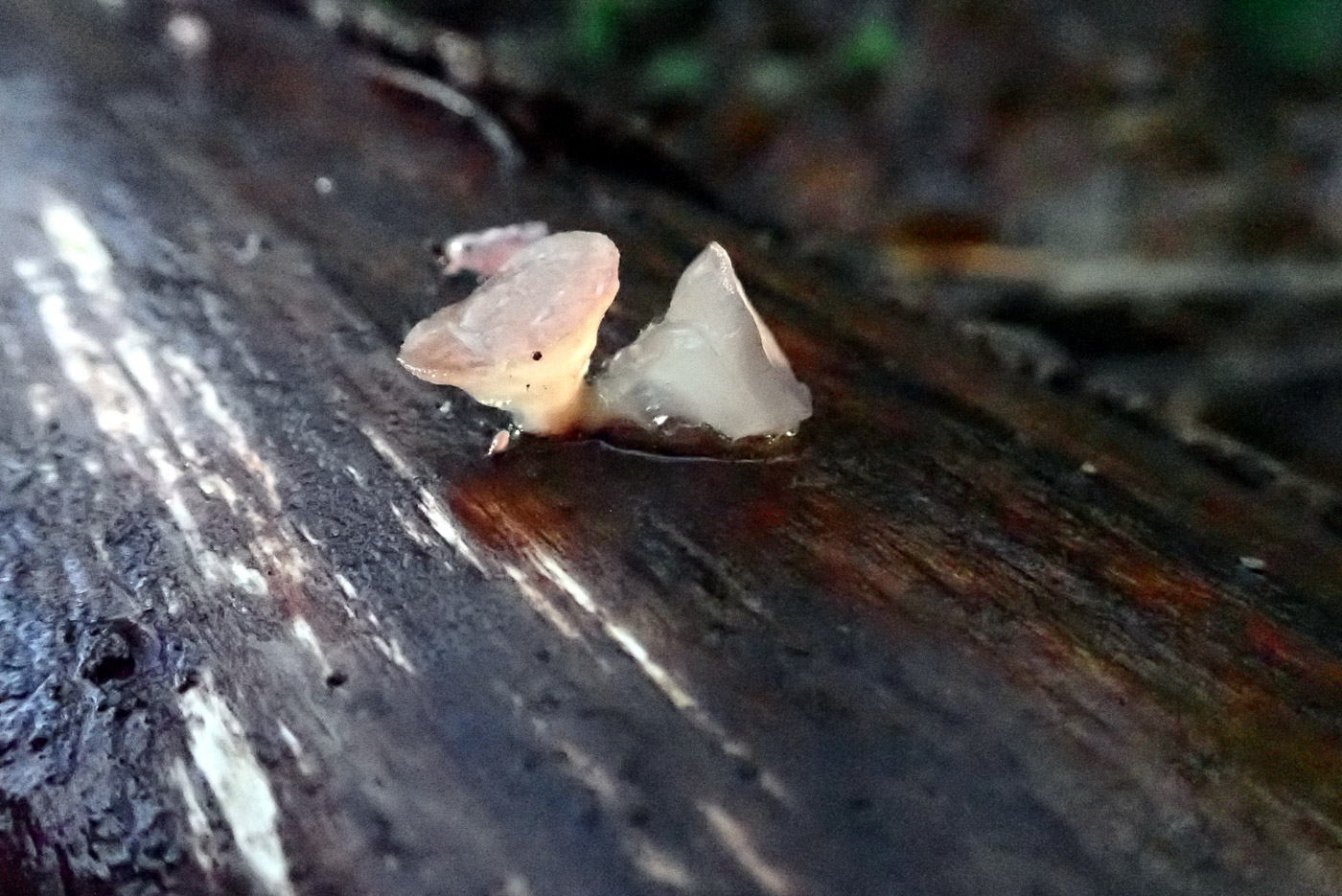 |
January 17th Neobulgaria pura (Beech Jellydisc)
On a fallen Beech trunk in Burnham Beeches Penny found some still slightly frosted but easily recognisable specimens of this common gelatinous ascomycete. For more notes and images see in Finds 2020 October 12th, also 2021 August 23rd & October 5th.
|
 |
January 17th Ascocoryne cylichnium (a Purple Jellydisc look-alike)
On a bare patch on a fallen rotting Birch trunk in Burnham Beeches Penny noticed several clusters of this small reddish-purple gelatinous ascomycete and as it appeared to be forming small cups she took it home to check whether it was the more commonly recorded A. sarcoides (Purple Jellydisc) or the possibly equally common but sometimes probably misnamed A. cylichnium. The two are described as more or less identical in the field, separable only by the markedly larger spores of today's species, but if it grows bigger and becomes cup-shaped it often seems to turn out to have the larger spores as did today's collection. See examples of A. sarcoides in Finds 2020 October 06, 18 & November 16, also 2021 November 17th (though this last was not checked and looks quite possibly like A. cylichnium!)
|
January 16th 2022
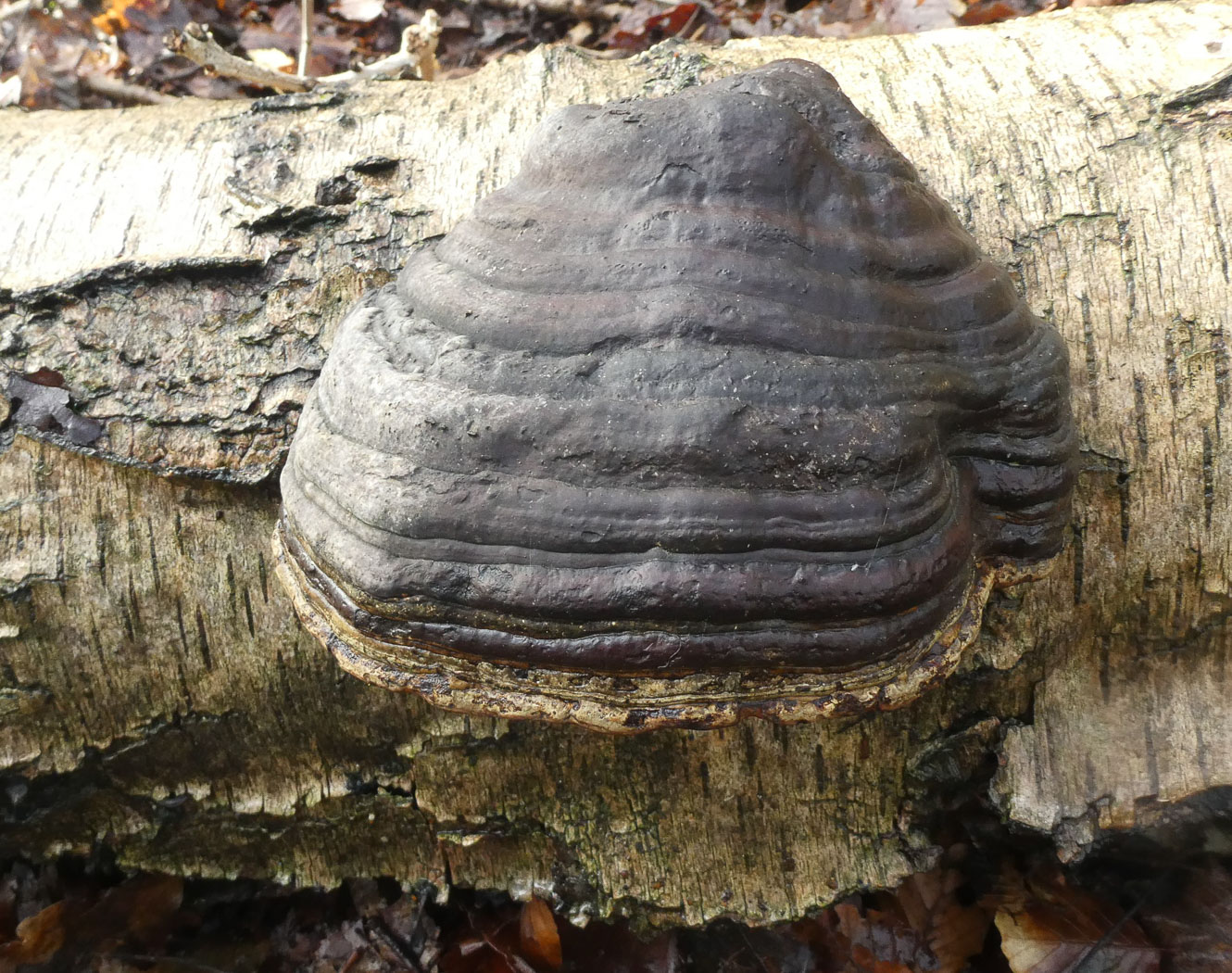
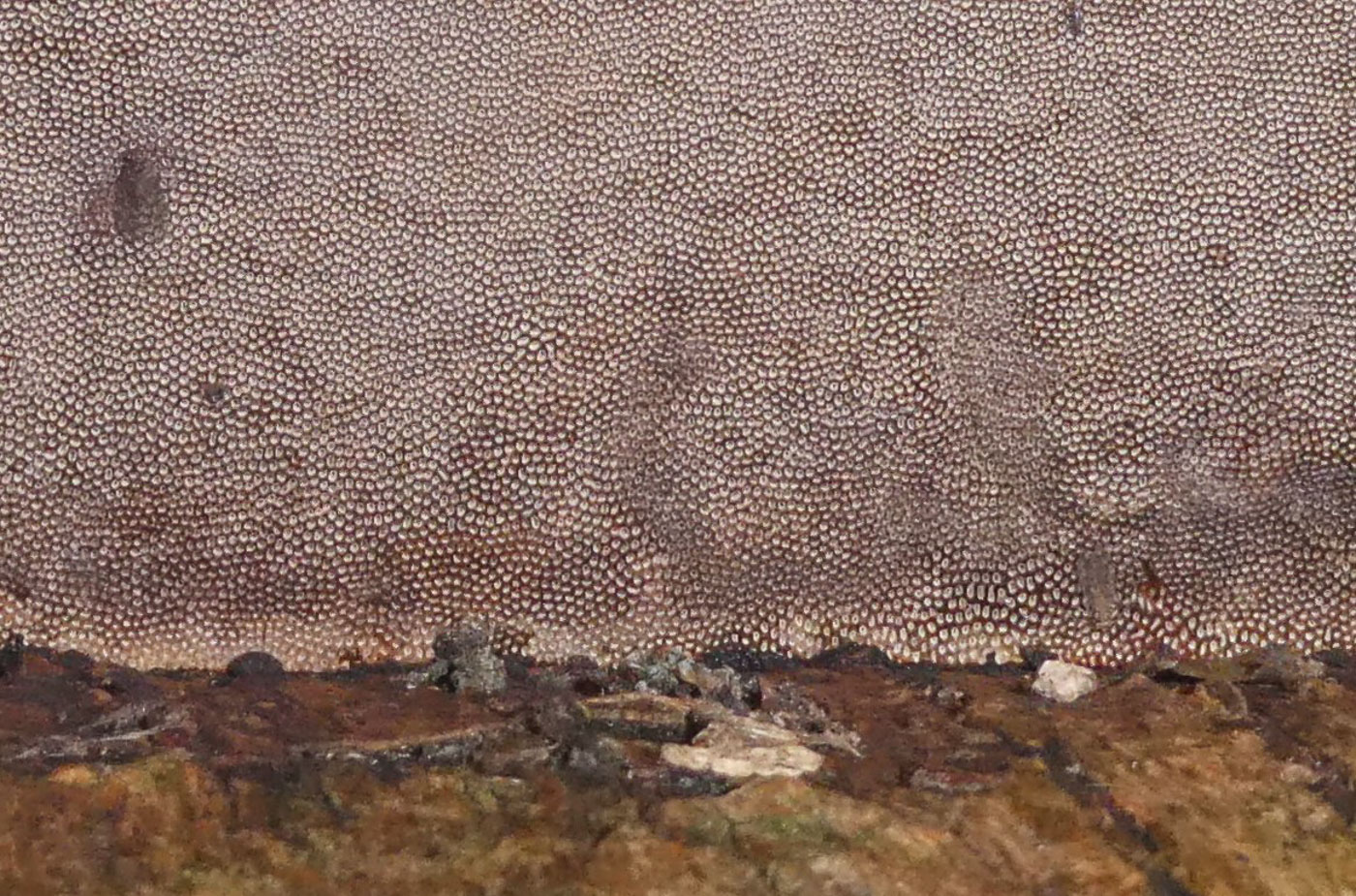
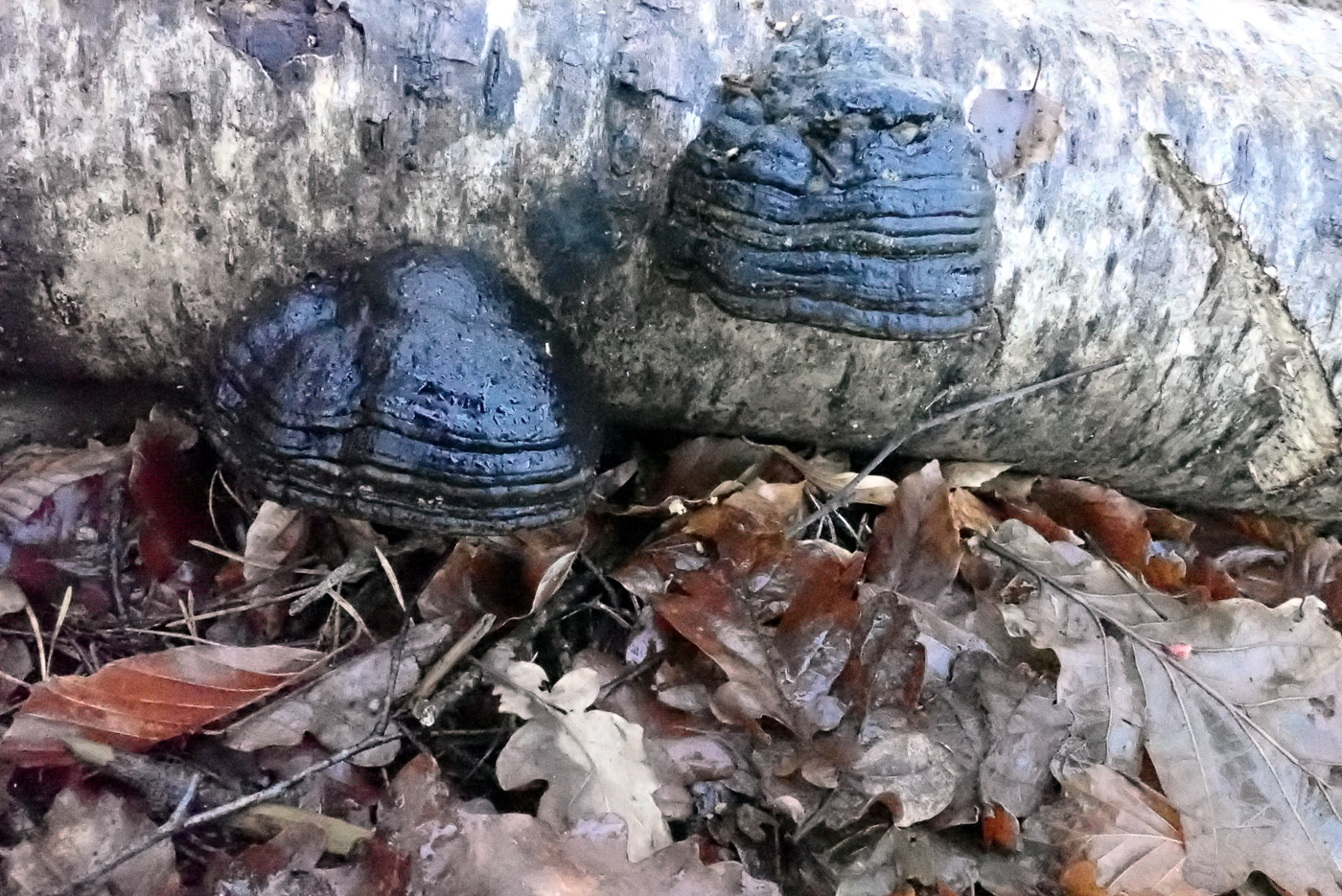 |
January 16th Fomes fomentarius (Hoof Fungus)
In Hodgemoor Woods Jim Wills noticed this distinctive bracket on quite a few Birch trunks both standing and fallen, commenting that on one trunk there were 40 specimens! Photo 2 shows its pore surface underneath. Photo 3 was taken by Penny at Burnham Beeches the following day, also on fallen Birch where the species now appears to be almost as common as Fomitopsis betulina (Birch Bracket). Interestingly Jim also reports this fungus on Red Maple in Chalfont St. Peter. See also Finds 2020 September 15th and November 30th.
|
January 15th 2022
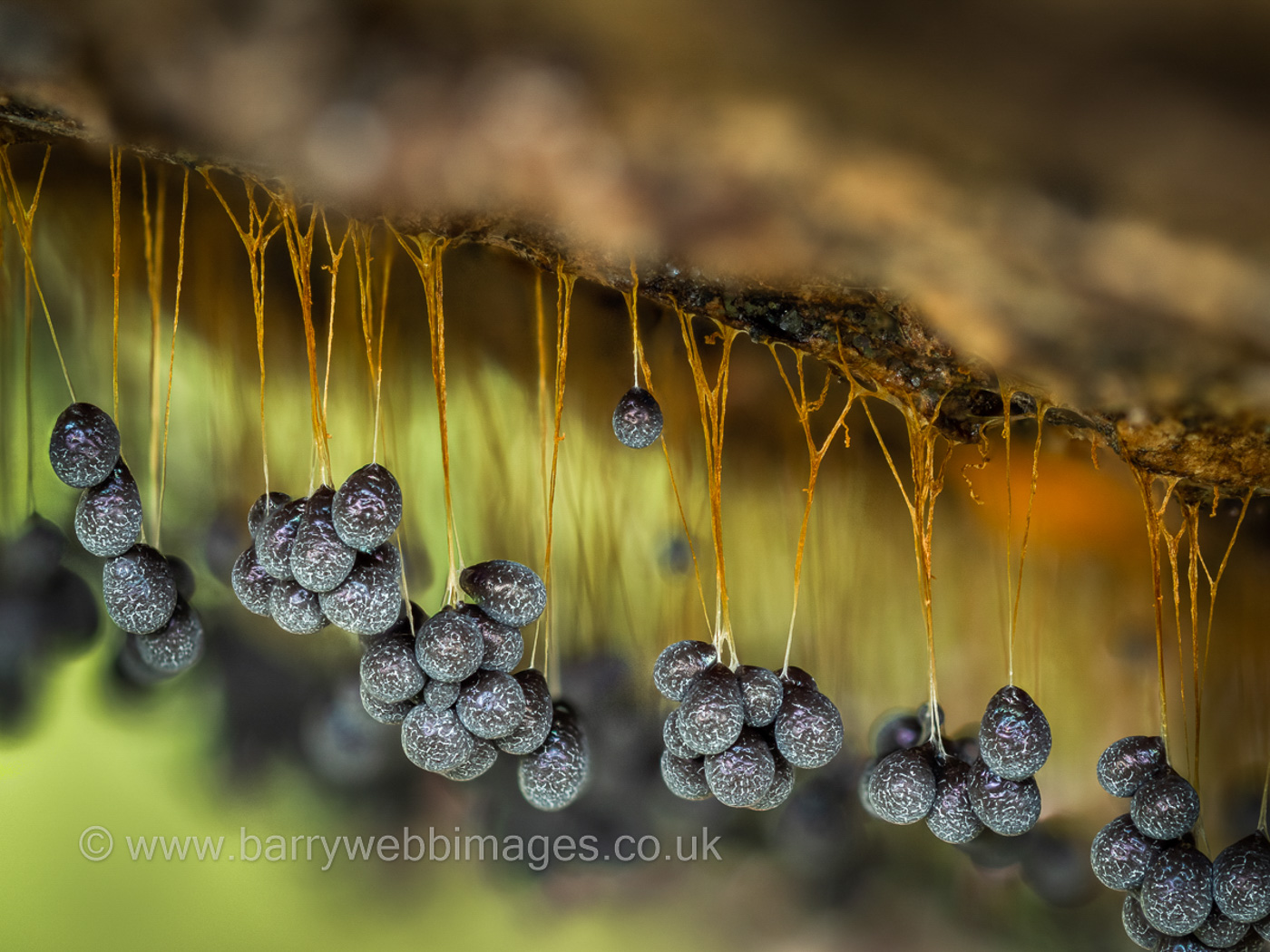 |
January 15th Badhamia utricularis (a Slime Mould with no common name)
In Penn Wood on fallen Beech Barry Webb found this interesting and distinctive common species - one for which we have just a handful of records. No, the photo is not up-side-down (as Penny at first suspected)! Apparently the species typically hangs down just like this with clusters of blotchy marbled sporangia suspended on bright orange 'strings'. (For more examples go to Barry's separate page on Finds.)
|
January 13th 2022
 |
January 13th Tremella foliacea (Leafy Brain)
In Hills Wood, south of Frieth, Andrew and Lisa Dodd noticed this large gelatinous lump at head height on a deciduous trunk and wondered what it was. Recognisable from Andrew's photo, this is quite a common jelly fungus, several different species of which have been found recently and seem to be fruiting happily at present. See also on Finds 2020, October 11th.
|
January 12th 2022
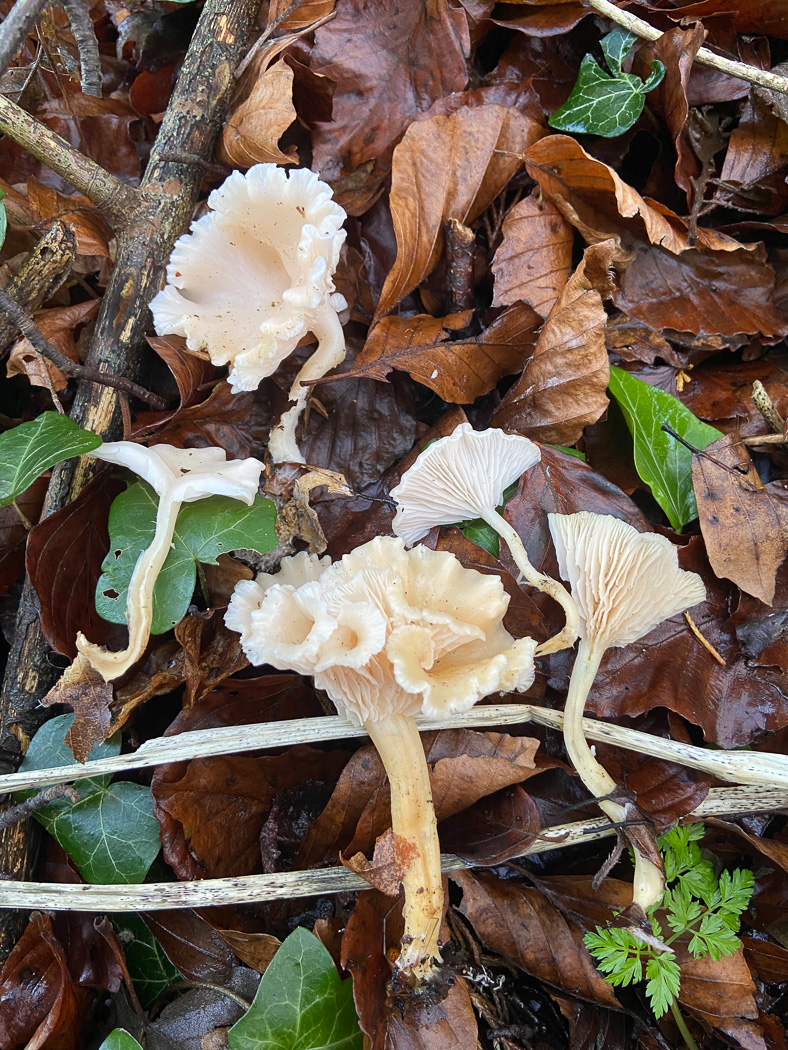

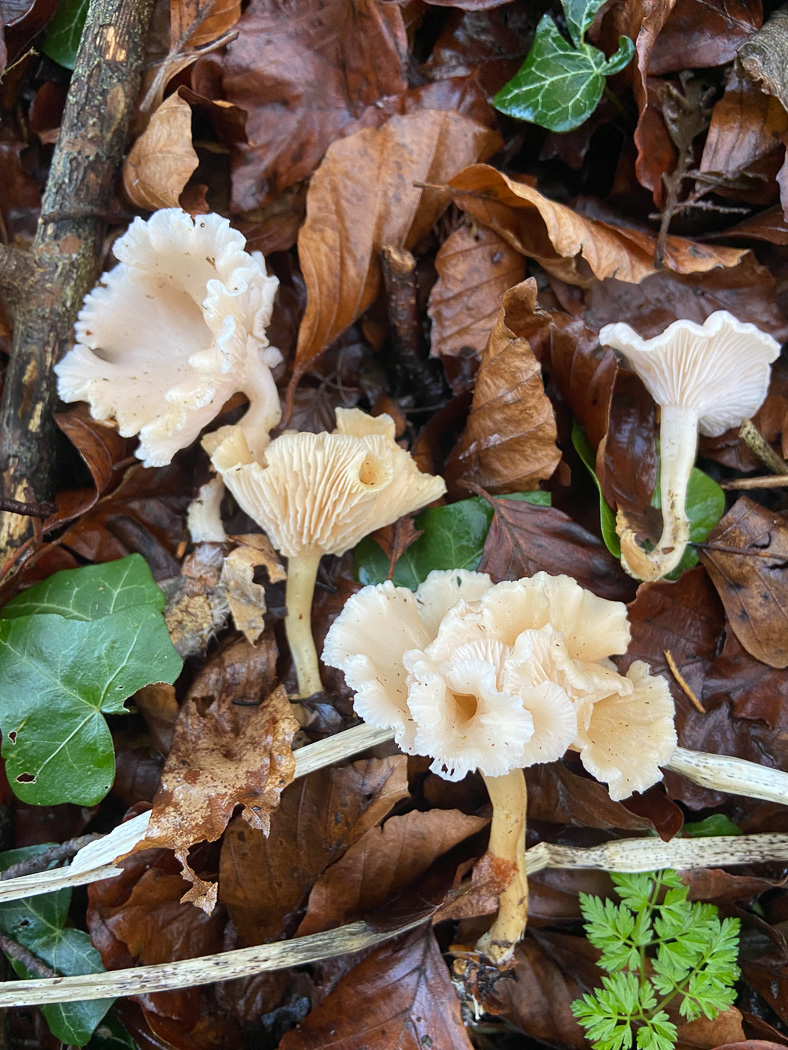 |
January 12th Leucocybe houghtonii (a Funnel with no common name) 
In deciduous litter adjacent to a footpath near Loosley Row Sarah Ebdon chanced upon this collection of mushrooms and was baffled by them. On seeing her photo Penny suggested that she should see if - when she squashed the gills a bit - it developed a smell of tomato leaves as it dried out! Sure enough it did (though apparently it didn't last long) and the spores and white spore print helped to confirm it. This unusual species, previously in Clitocybe, is a smallish Funnel which has rather a fluted cap edge and strongly decurrent gills, but the best characters to note are the pink shade to both cap and gills and, of course, its remarkable smell. Anyone who's grown or handled tomato plants will recognise it straight away, but it often needs bruising and then a little time for it to be detectable. Smells can be fickle especially late season with frosts around, so it-s no surprise that this should have faded here. We have about ten sites for the species with records for October and November, but none for January!
|
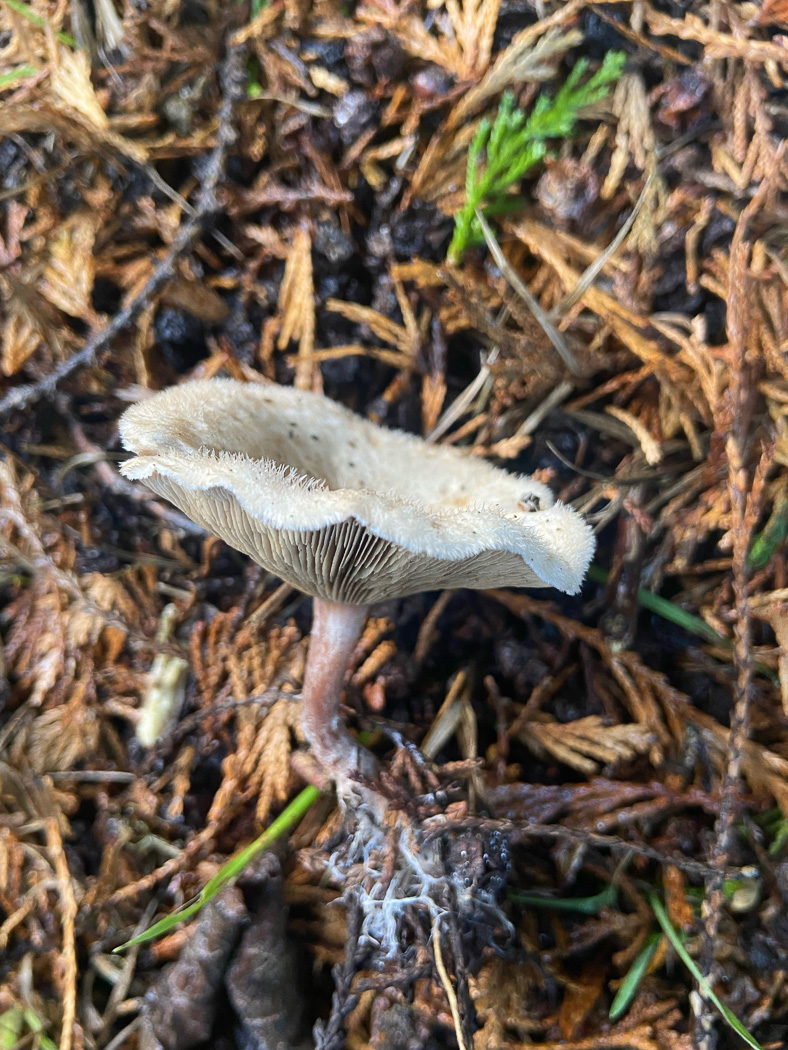
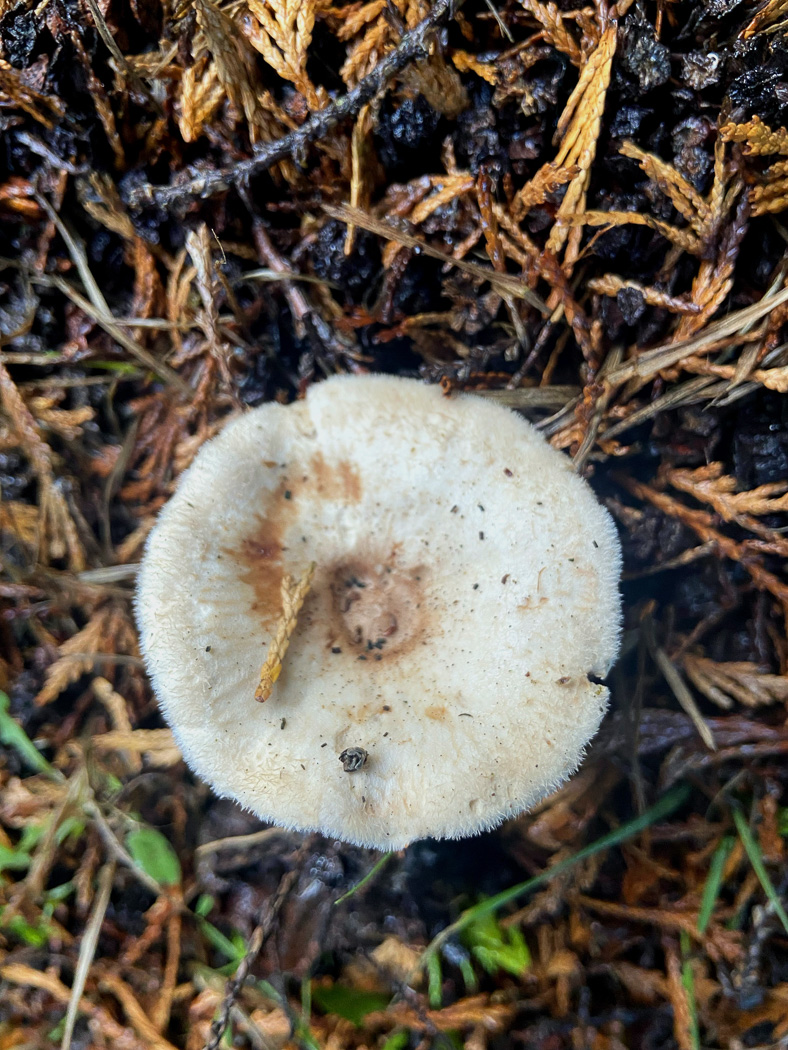 |
January 12th Ripartites tricholoma (Bearded Seamine) 
At Lacey Green Churchyard Sarah Ebdon found just this singleton in conifer litter, took it home to work on, then tentatively (and correctly) suggested to Penny this name. Somewhat similar to a smallish Clitocybe species (for which it is most likely often mistaken) the gills are a bit too coloured for that genus and the cap is somewhat hairy - though Sarah noted that this feature became much less apparent a few hours after collection. The confirmation, however, comes from its small roundish and clearly but finely spiny spores (hence its common name) - not found in Clitocybe. We have extremely few records of this species. See also in the report for Bittam's Wood, October 31st 2021.
|
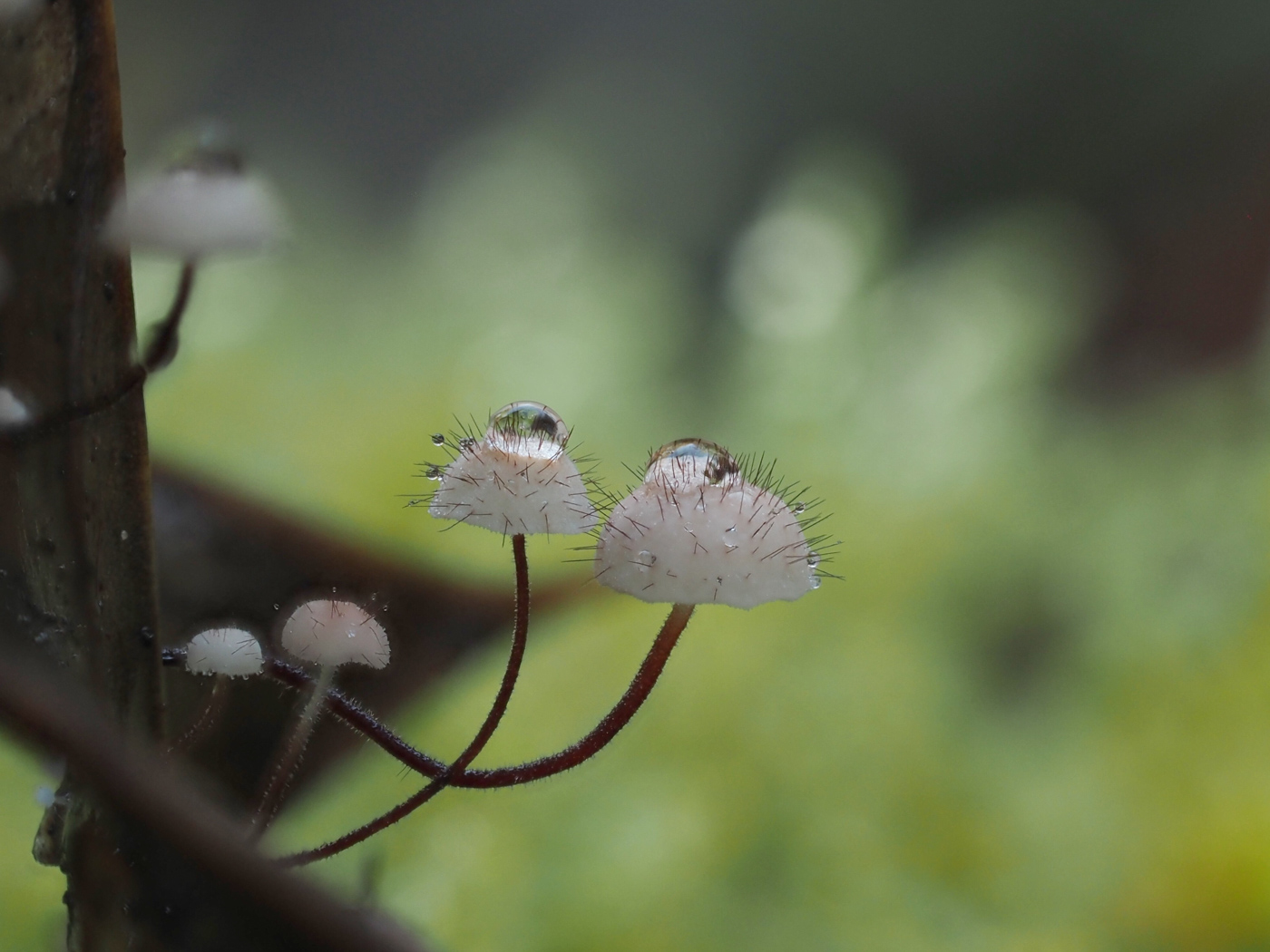
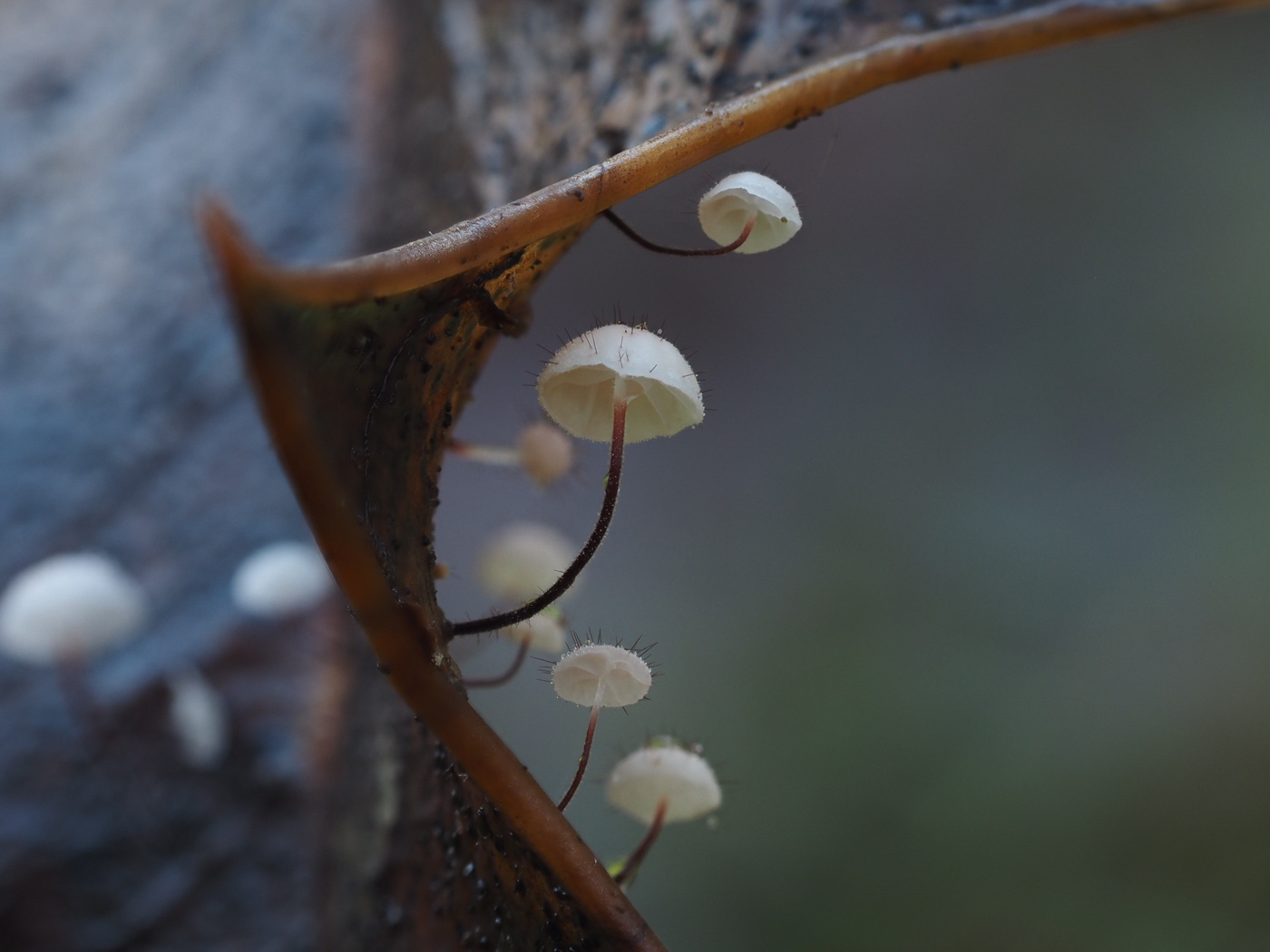 |
January 12th Marasmius hudsonii (Holly Parachute)
This unusual and intriguing little mushroom was found independently at two sites today (though only a few miles apart): at Lacey Green Churchyard by Sarah Ebdon and Penny, also at Naphill Common by Claire Williams (the photographer here) with Barry Webb and Gill Ferguson. With a handlens it is instantly recognisable from the tiny brown-red bristles covering the cap, but only occurs on soggy rotting Holly leaves. It's clearly a late season fruiter (see also in Finds 2021 dated December 30th) and has a distinctive horsehair-like black stem, paler and reddish at the apex. It never gets much bigger than 5mm across and is usually much smaller than that. Definitely one to look out for under Holly at the moment.
|
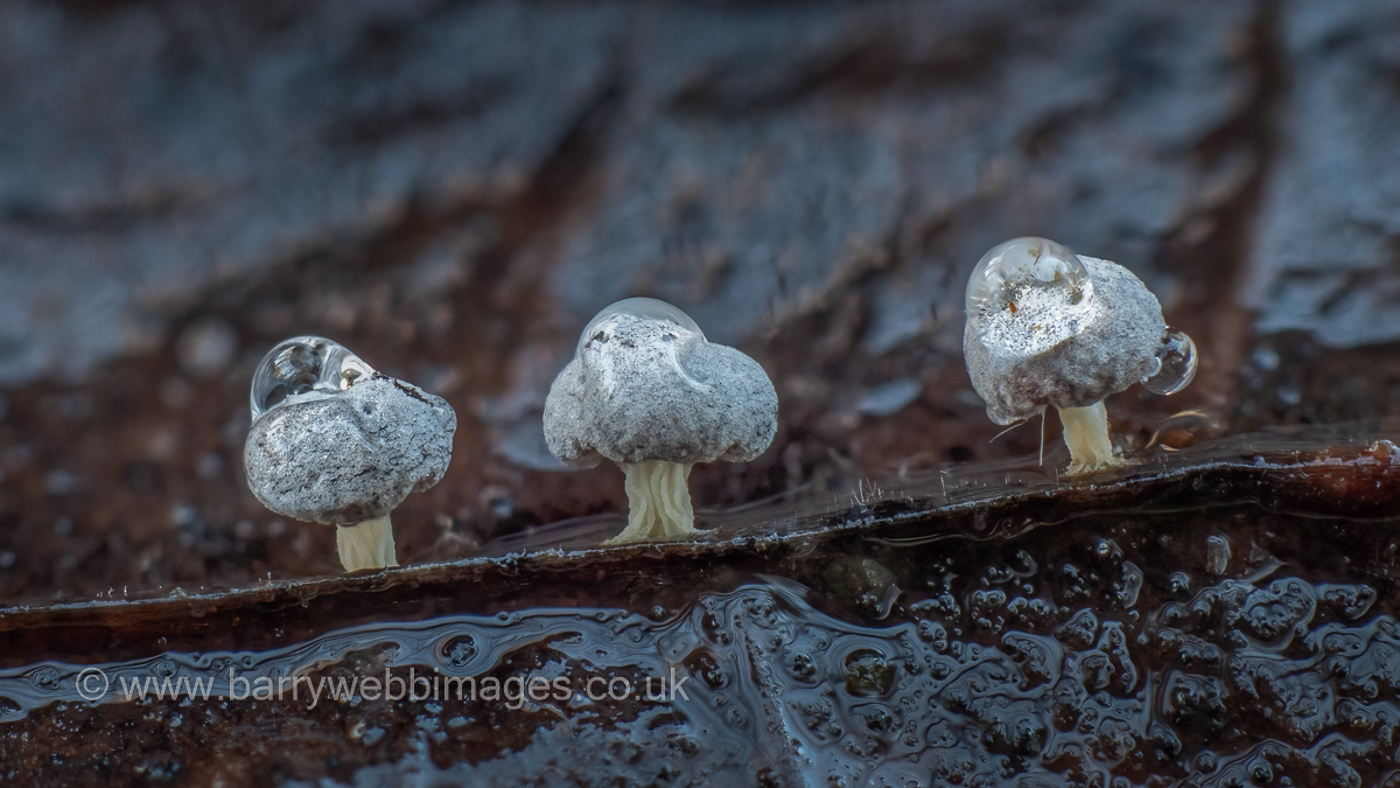 |
January 12th Didymium squamulosum (a Slime Mould with no common name)
In Naphill Common on the 'Great Beech' Barry found several different 'Myxos' of which this was one of the commoner species though it's new for the site. See Barry's page on Finds for more images and information, also Finds 2021 December 30th.
|
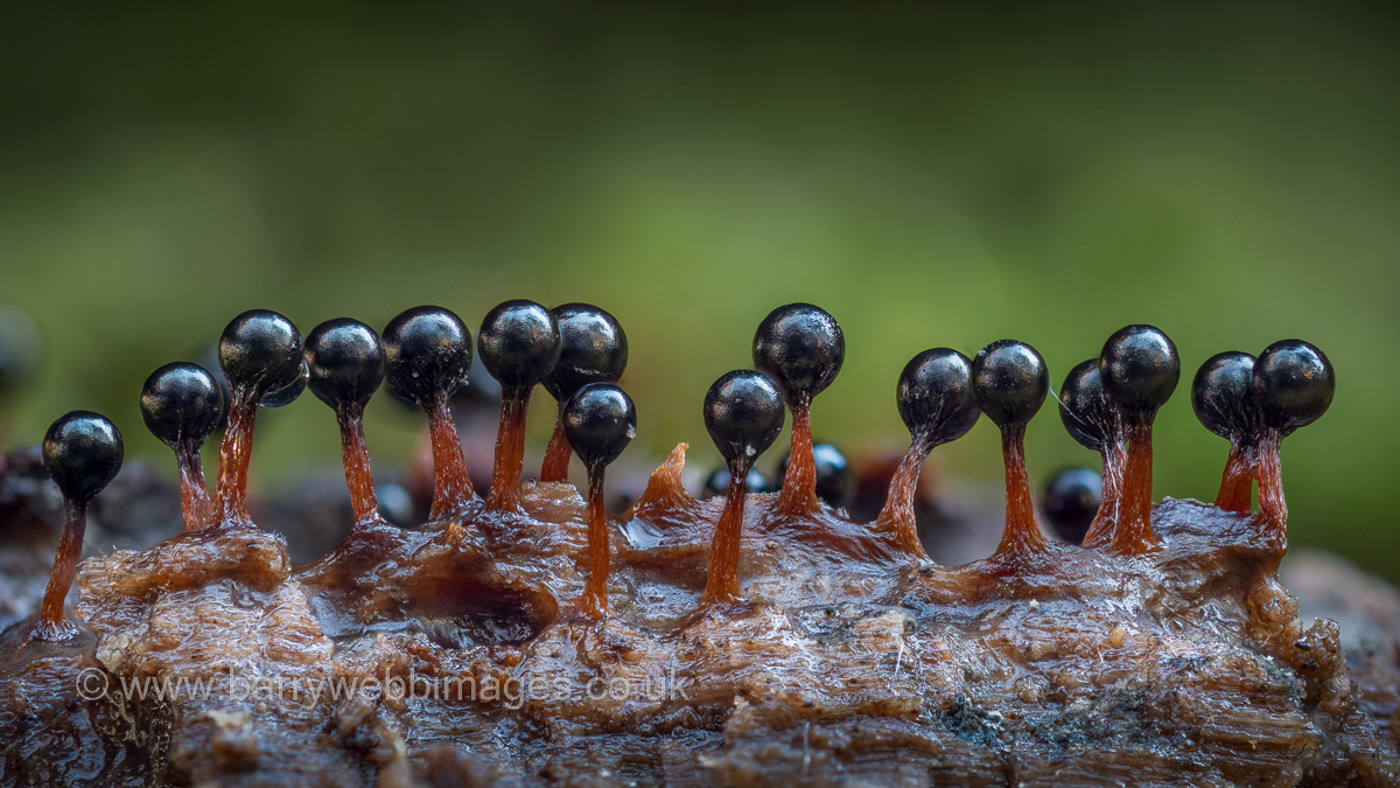 |
January 12th Metatrichia floriformis (a Slime Mould with no common name)
In Naphill Common on the 'Great Beech' Barry found several different 'Myxos' of which this was another of the commoner species and again is new to the site. See Barry's page on Finds for more images and information, also Finds 2021 January 12th(!) and Finds 2020 October 17th.
|
 |
January 12th Abortiporus biennis (Blushing Rosette)
In Naphill Common Gill Ferguson was intrigued by these strange droplets oozing out of some white resupinate fungus on fallen Beech. On seeing her close-up photo Penny at first thought this must be the very common Schizopora paradoxa (Split Porecrust) though could find no reference to it producing droplets. Then, when she recalled exactly where Gill had said she'd found it in Naphill near the Great Beech, Penny realised what it must be. This is a regular species on the fallen Beech there, and is also one which can be confusing to identify because it regularly doesn't form the typical rosette shape which gives it its common name. What it often produces when conditions are moist enough, however, is droplets of coloured liquid! See also Finds 2021 October 26th which is an amazing example showing both the droplets, the white 'toothlike' pored surface and the lack of rosette shape! Two further examples showing the Rosette shape - both from the same spot in Naphill Common as here - can be found in Finds 2020, September 25th and October 28th
|
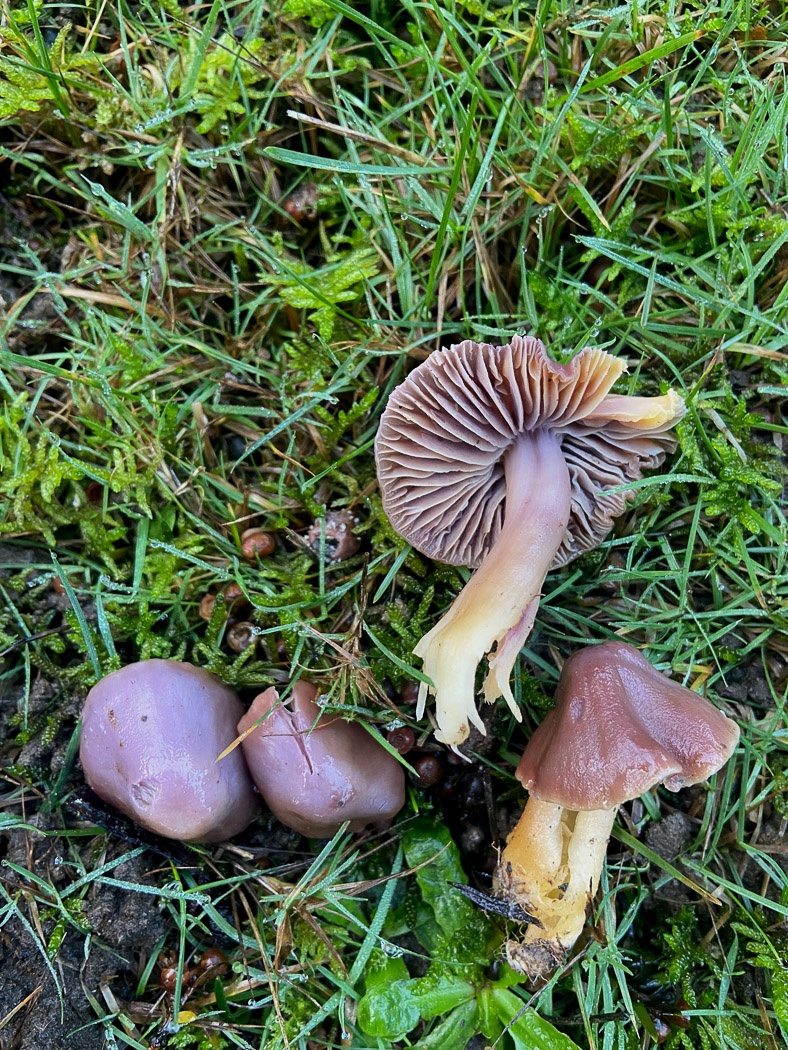
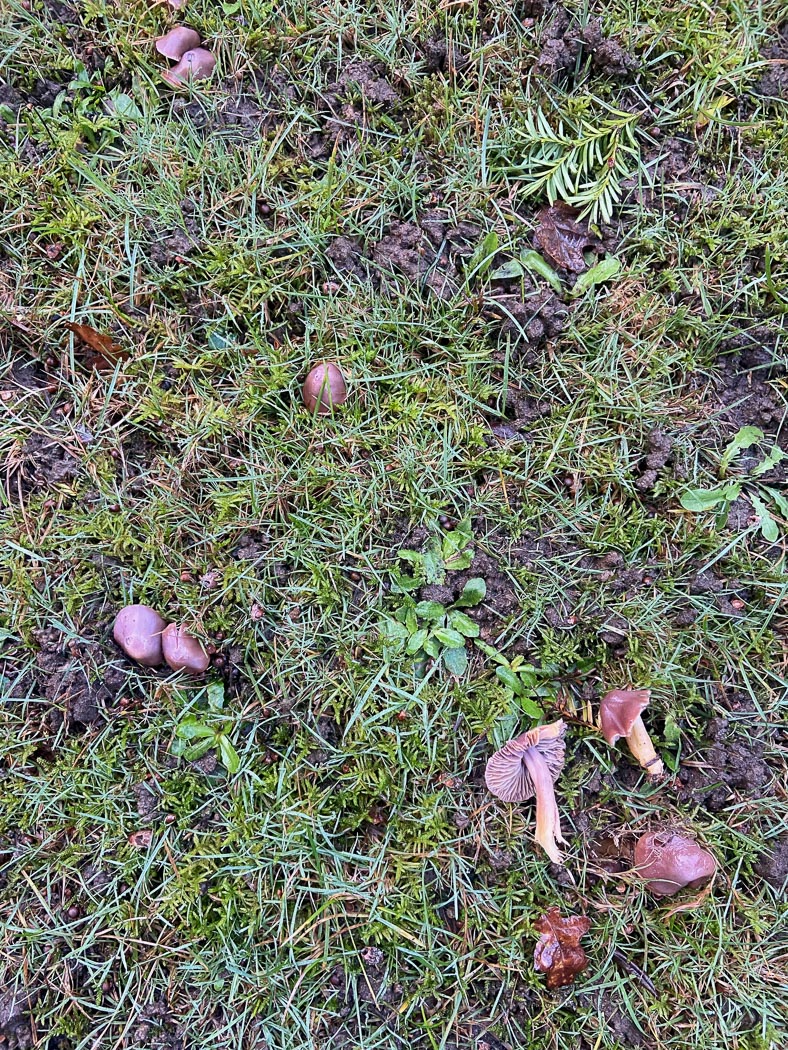 |
January 12th Gliophorus reginae (Jubilee Waxcap)
In Lacey Green Churchyard Sarah Ebdon was excited to find maybe ten specimens of this very rare Waxcap (closely related to G. psittacinus) pushing up through the mossy ground. On hearing about this and never having seen it before, Penny couldn't resist coming to see it and was suitably impressed. This was in fact the third spot in this churchyard where Sarah's found it in the last few weeks (see also Finds 2021 December 15th). When Kew expert Martyn Ainsworth (co-author of the species when described 10 years ago in honour of the Queen - another Jubilee year!) was informed by Penny of today's remarkable crop of fruitbodies, he responded 'It doesn't seem to mind winter as much as some of its relatives ........ it was often seen after Christmas in the field which became the type locality and it was late Jan when I first saw it there for myself.' The photos here are all Sarah's, the final two are of a further collection from a fourth spot at this site made on January 17th.
|

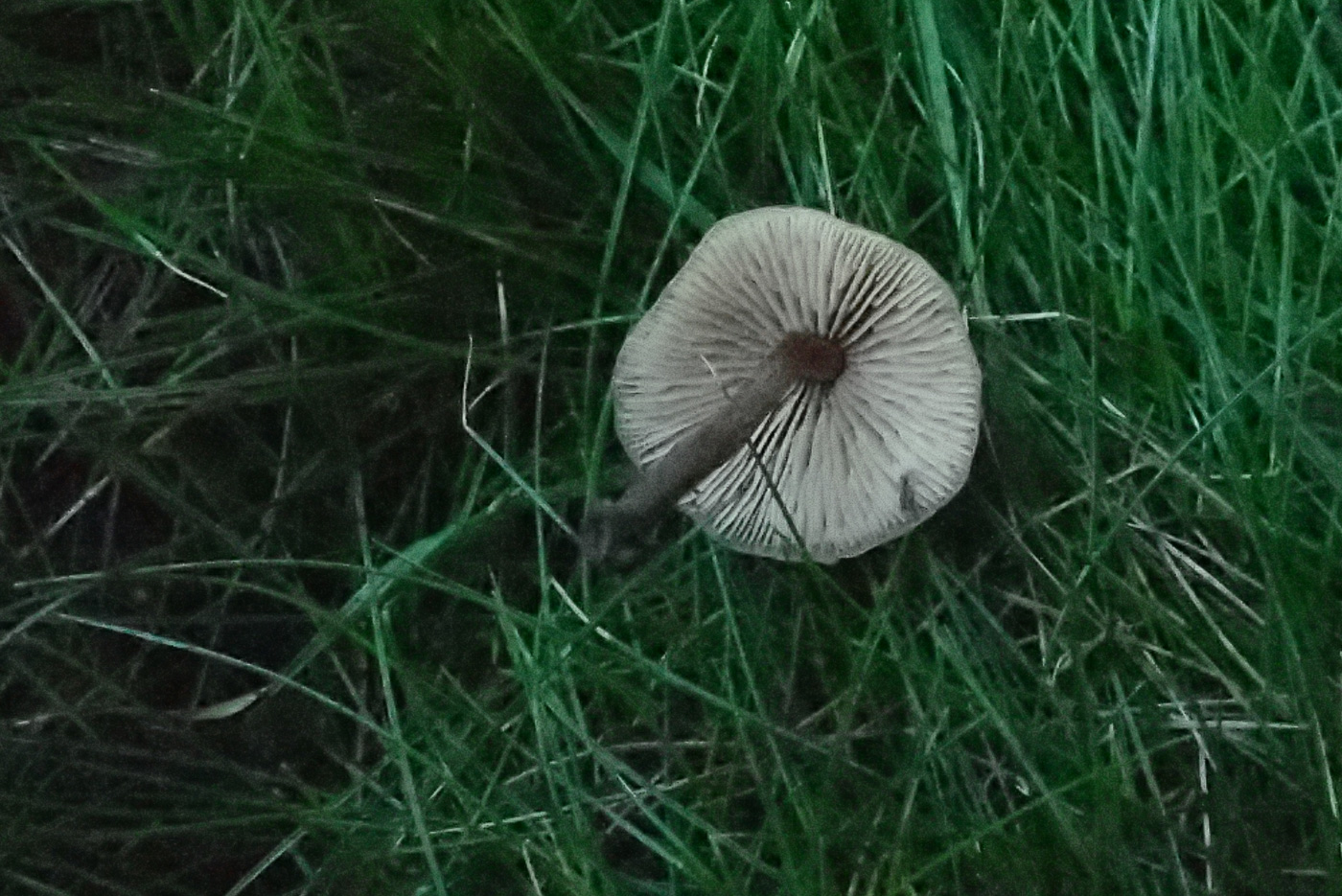 |
January 12th Macrocystidia cucumis (Cucumber Cap)
In Bradenham Churchyard under Yew Penny spotted this quite distinctive mushroom - just a singleton here though often it can be found in large numbers. (See also in Finds 2021 October 25th for more information and also a better photo!).
|
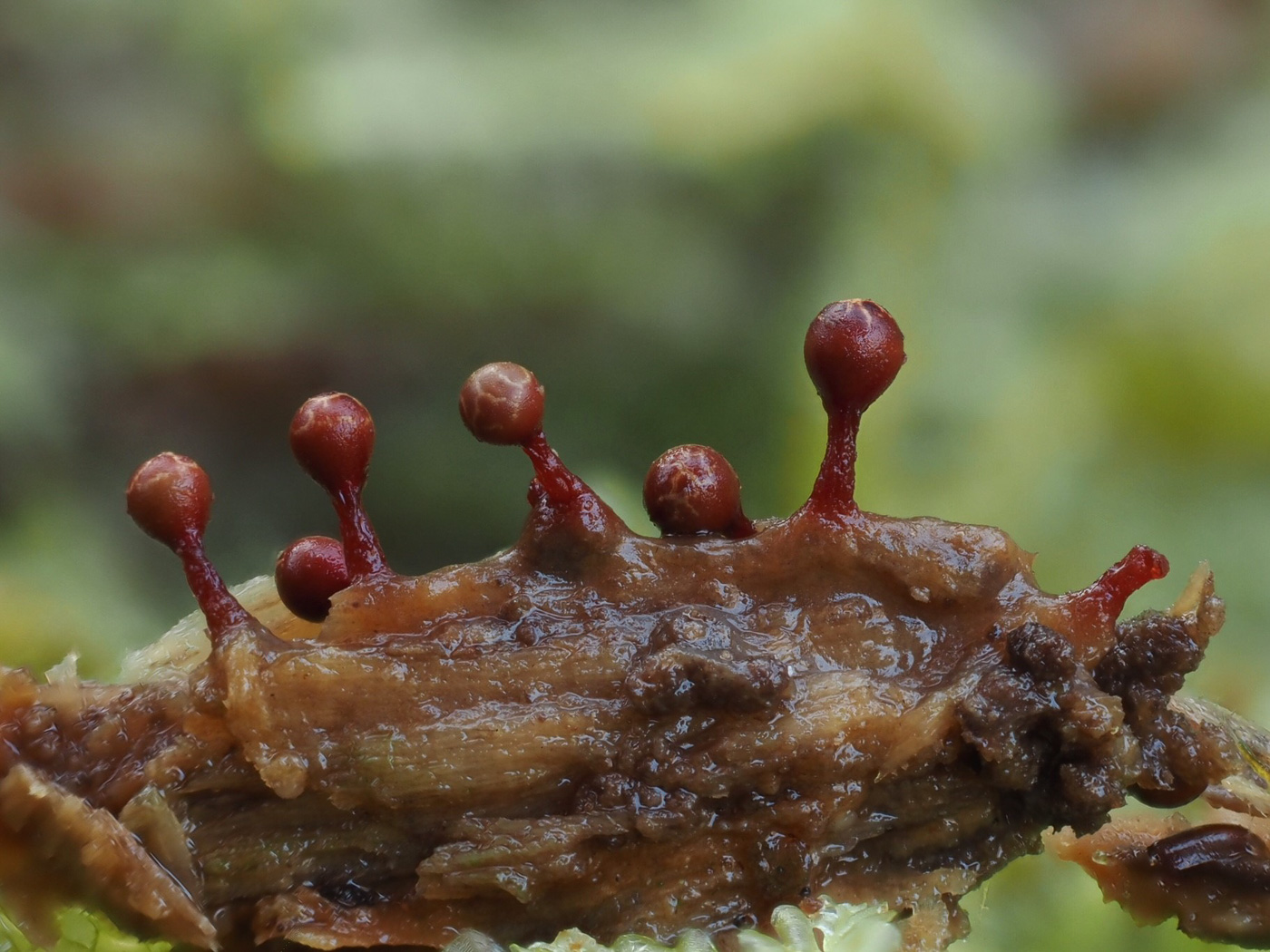

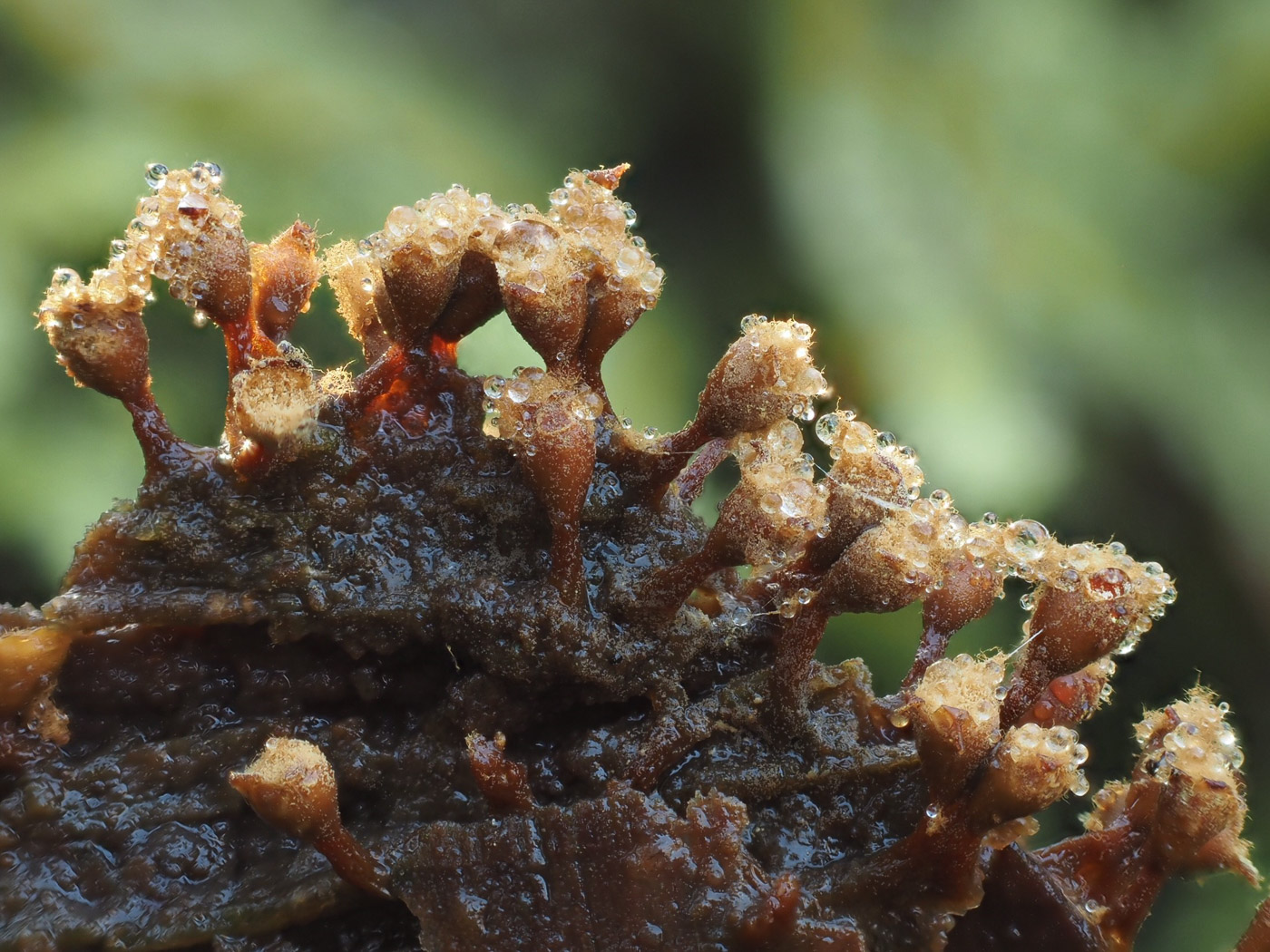 |
January 12th Trichia botrytis (a Slime Mould with no common name)
In Naphill Common Barry Webb found this tiny slime mould on fallen wood (the photo is by Claire Williams).The photos show three stages of development - this not being unusual to find occurring together in one colony of slime moulds. See also on Barry's page in Finds.
|
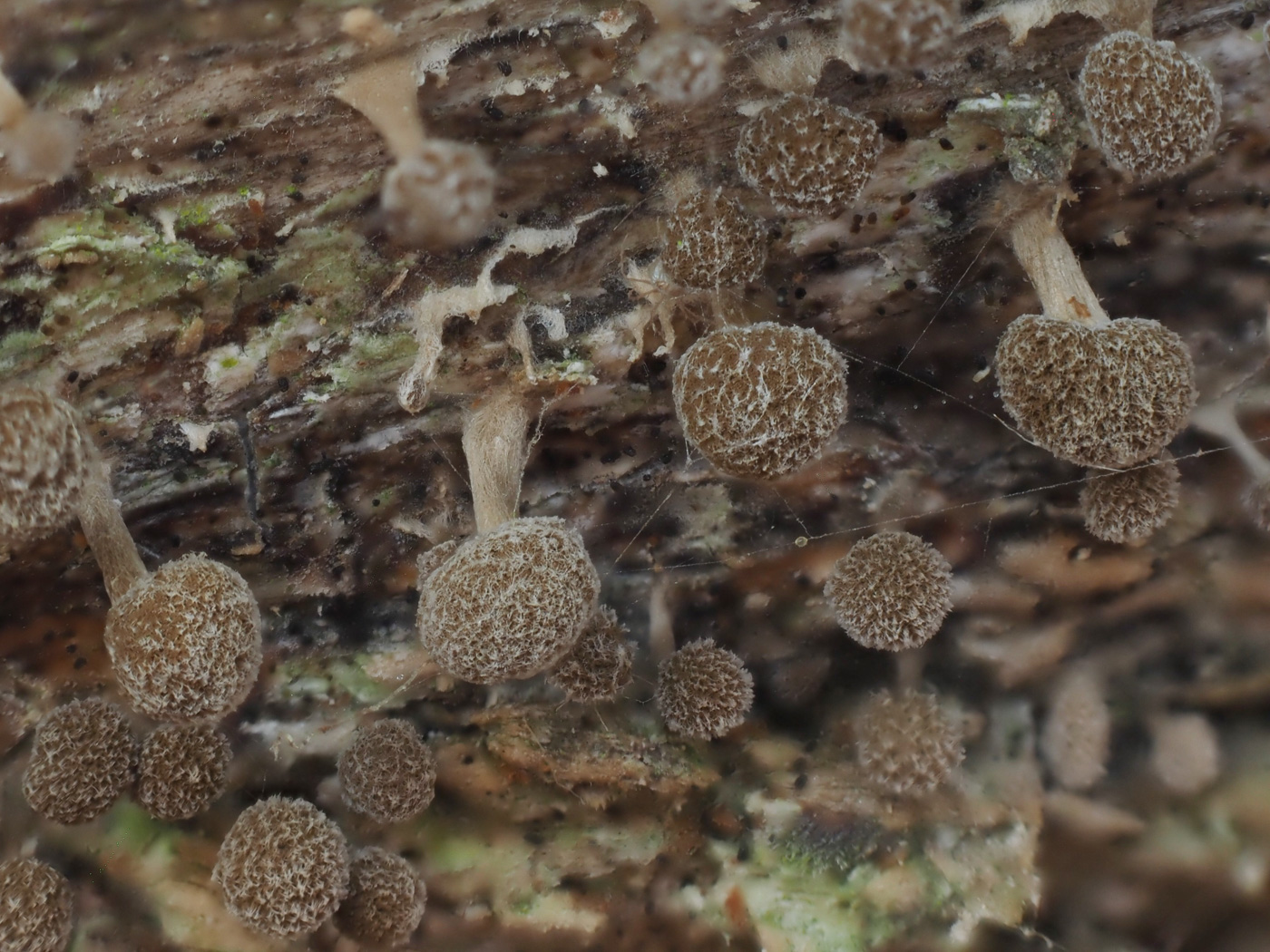 |
January 12th Phleogena faginea (Fenugreek Stalkball)
In Naphill Common Barry Webb found this unusual and very small species on fallen wood (the photo is by Claire Williams), one which looks amazingly like a species of Physarum (a slime mould) but is in fact a Basidiomycete and more closely related to the Puffballs. It develops a remarkably persistent 'curry' smell as it dries once collected. See also in Finds 2021 dated Jan 28th.
|
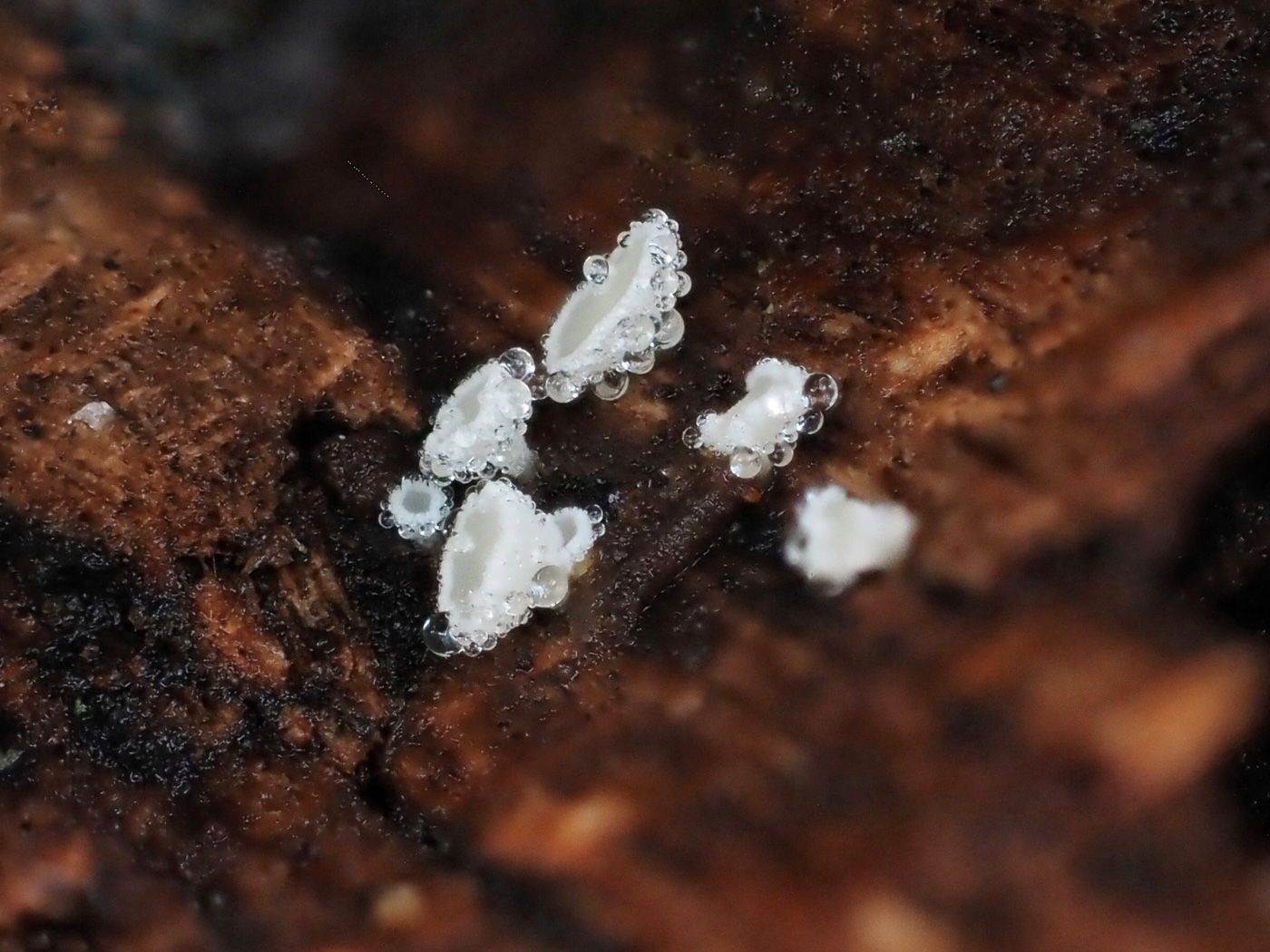 |
January 12th Dasyscyphella nivea (a white disco with no common name)
In Naphill Common Barry Webb found these tiny hairy white discos on fallen wood (the photo is by Claire Williams), and from the photo Penny surmises this is not Lachnum virgineum as suggested but D. nivea (previously also in Lachnum) owing to the lack of a longish stem to the discs and also the plentiful droplets trapped within the hairs and typical of this equally common species. (See also in the report for Rushbeds Wood, November 20th 2021.)
|
January 10th 2022
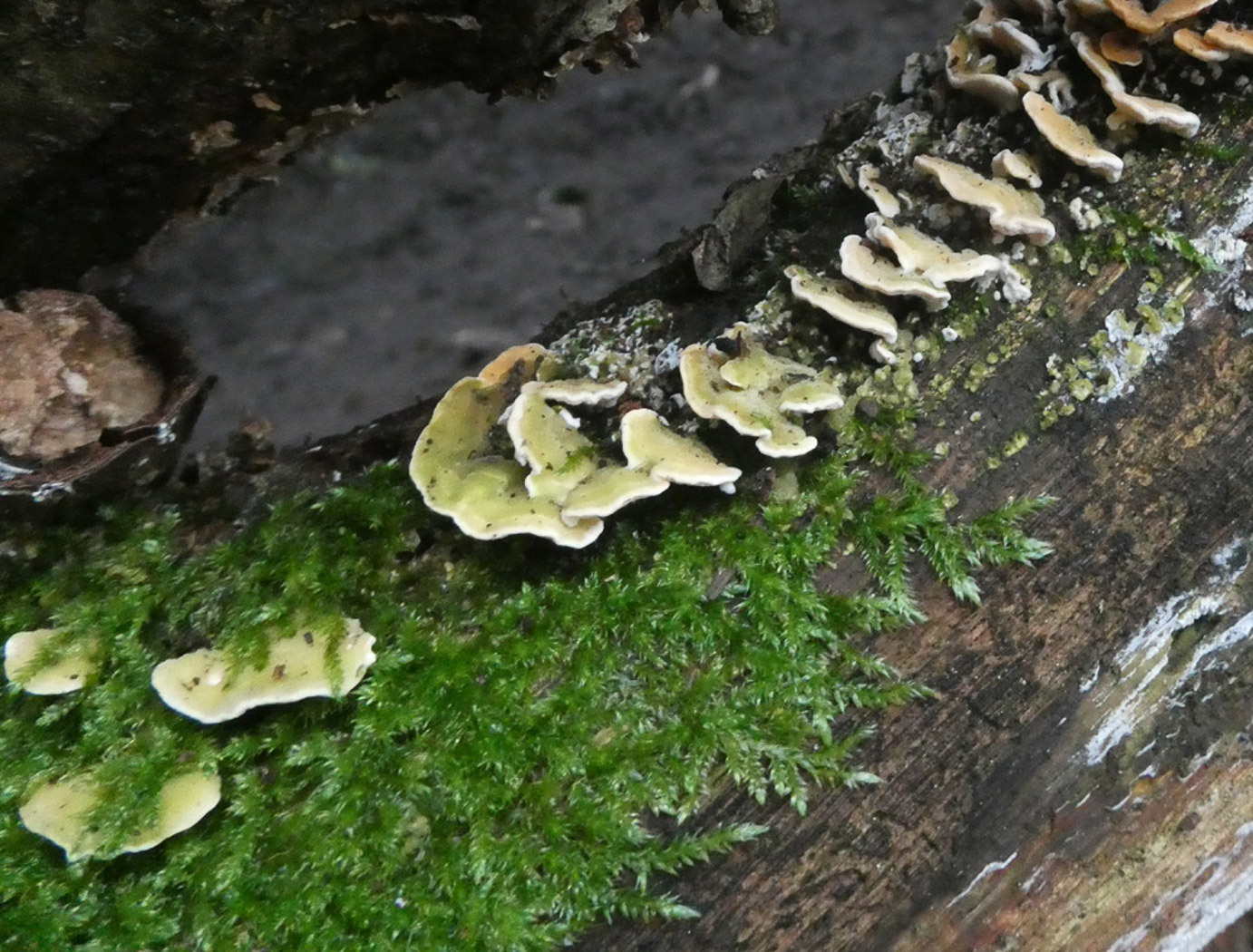

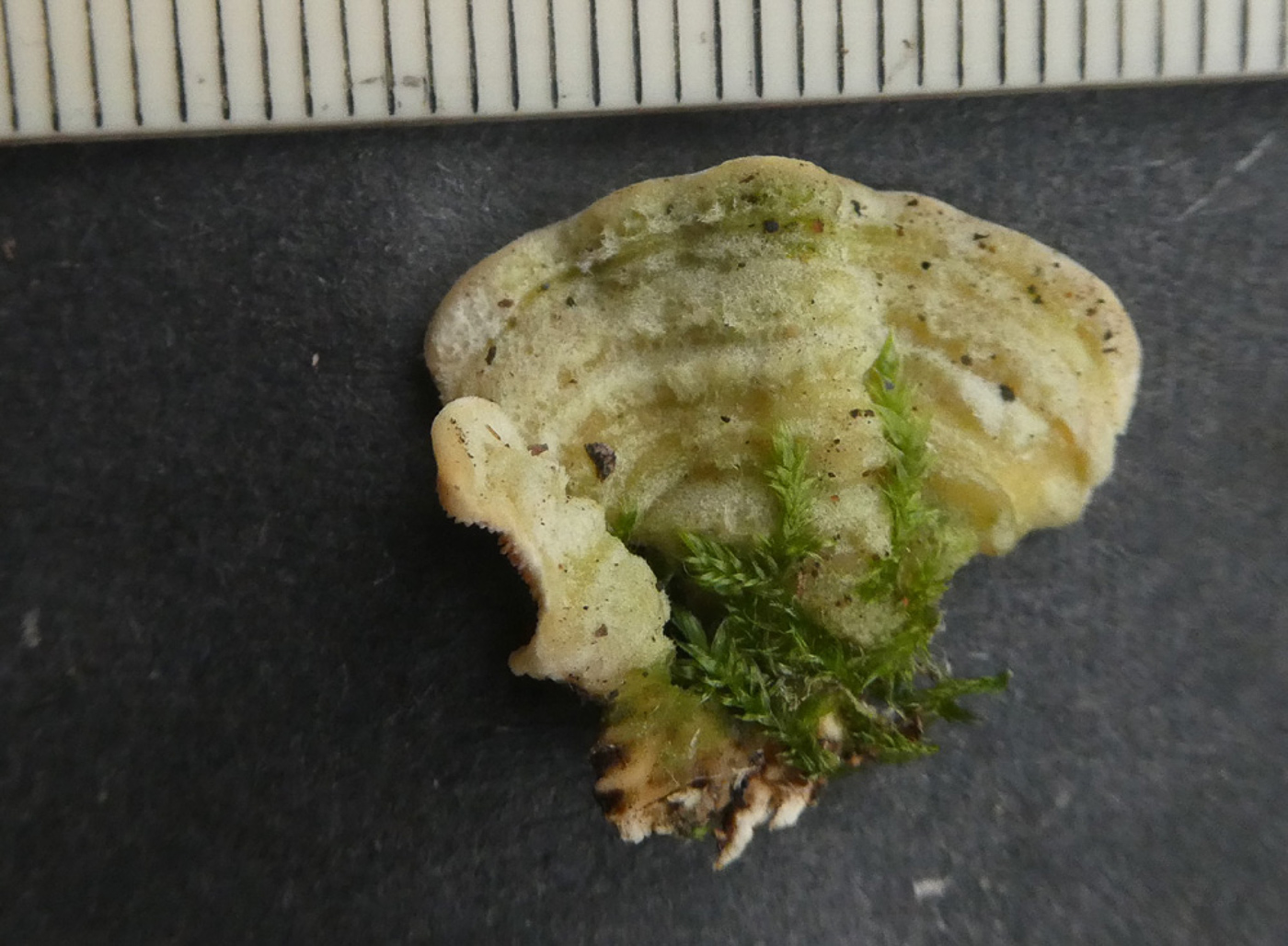 |
January 10th Steccherinum ochraceum (Ochre Spreading Tooth)
In a wood near Chalfont St. Peter Jim Wills noticed this line of small brackets on a fallen branch, possibly Oak. Turning one over he noticed the unusual 'peg-like' orange underside so took it home to try and work out what it could be, coming up correctly with this name as a possibility. After comparing his photos with various images and descriptions online and elsewhere, Penny is happy to confirm his identification though at first she was unsure. Described mainly as a fully resupinate species (the form with which she was familiar), it can apparently also form small brackets as here, which are zoned and often green with moss / algi, also as here. This is an occasional species for which we have about a dozen records.
|


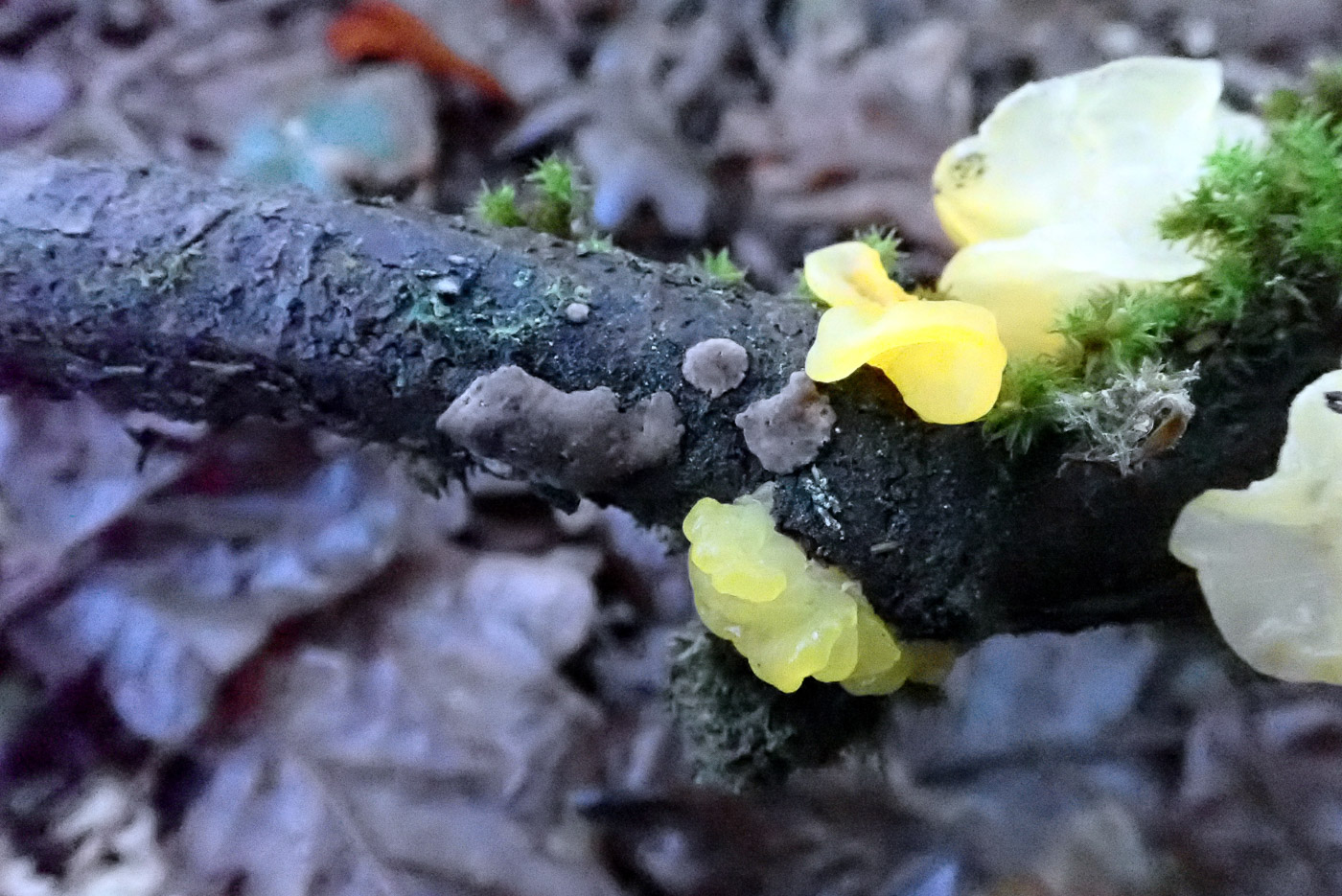 |
January 10th Tremella mesentrica (Yellow Brain) 
On a fallen deciduous branch in Brill Common Joanna spotted this gelatinous yellow lump which, as it looked a bit different from usual to her, she took home and checked. She then discovered that the species is parasitic on the mycelium of the corticioid genus Peniophora (though the fruiting body not always visible) and sure enough there is indeed some dried up Peniophora nearby in her photo. Photos 2 and 3 are of Penny's collection on fallen Oak in Burnham Beeches a week later where also some Peniophora is visible nearby. (See also Finds 2021 dated July 8th.) It is worth noting that if you find this species growing on Stereum hirsutum rather than on Peniophora, you may have the very similar but rarely recorded Tremella aurantia!
|
January 8th 2022

 |
January 8th Pleurotus ostreatus (Oyster Mushroom) 
At Stampwell Farm on a dying Elder trunk Jackie Ewan noticed this large 'bracket' growing out of a fault. It measured an amazing 26 cm across but was clearly gilled underneath with an eccentric stem, pointing to the genus Pleurotus. On checking the spores she realised that they were too small for either P. dryinus or cornucopiae, so despite its remarkable size and the fact that it was single and not clustered she reckoned it must be the common P. ostreatus. Penny was at first somewhat doubtful about this but is now in agreement, taking into account not only the spore size but also the smooth cap surface Jackie had noted together with the surprisingly large size range quoted for this species in several books. Though more familiar to us when smaller and forming large clusters on fallen wood, it can obviously become really large like this when all its energy goes into just one rather than several fruitbodies.
|
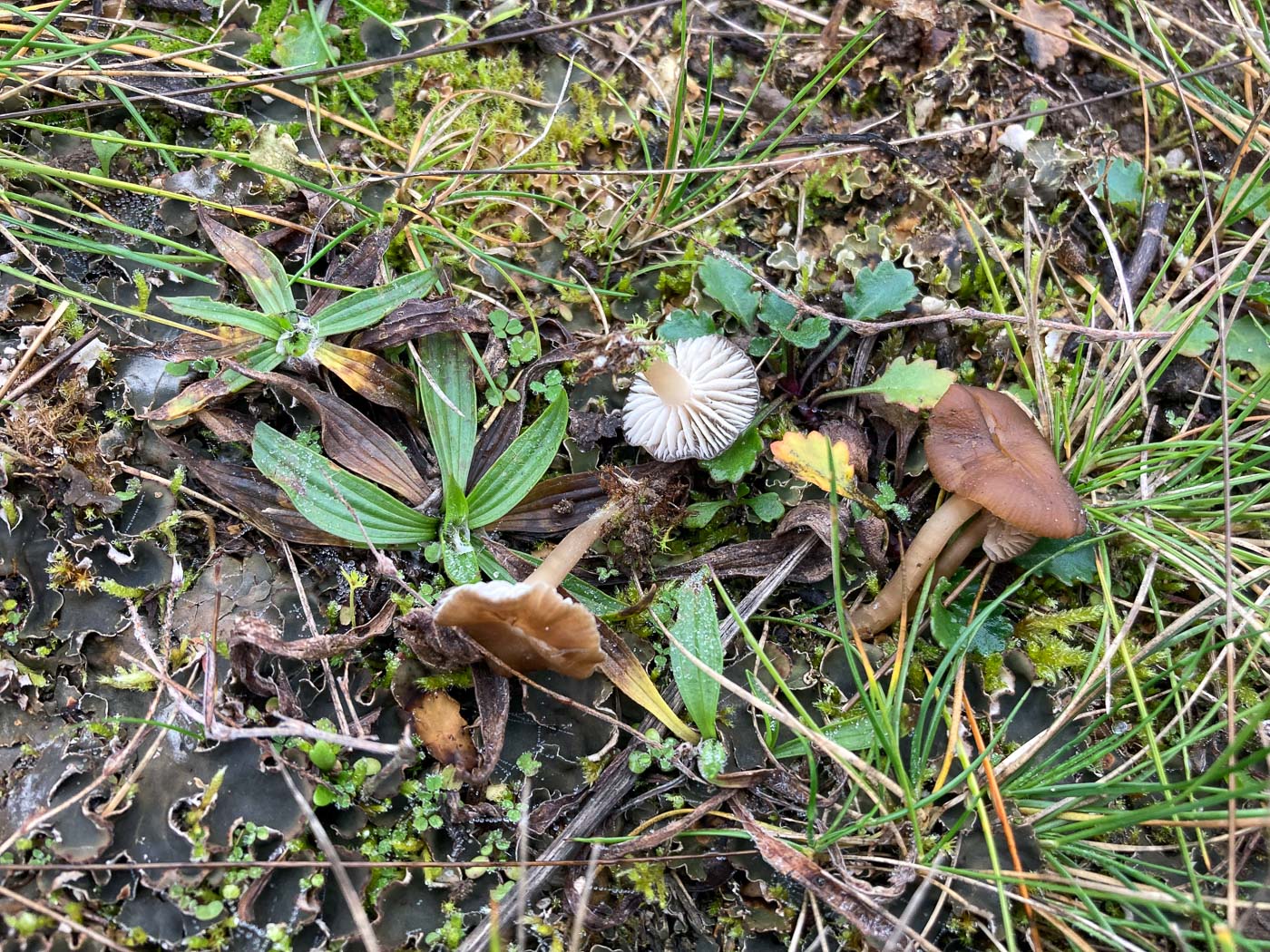

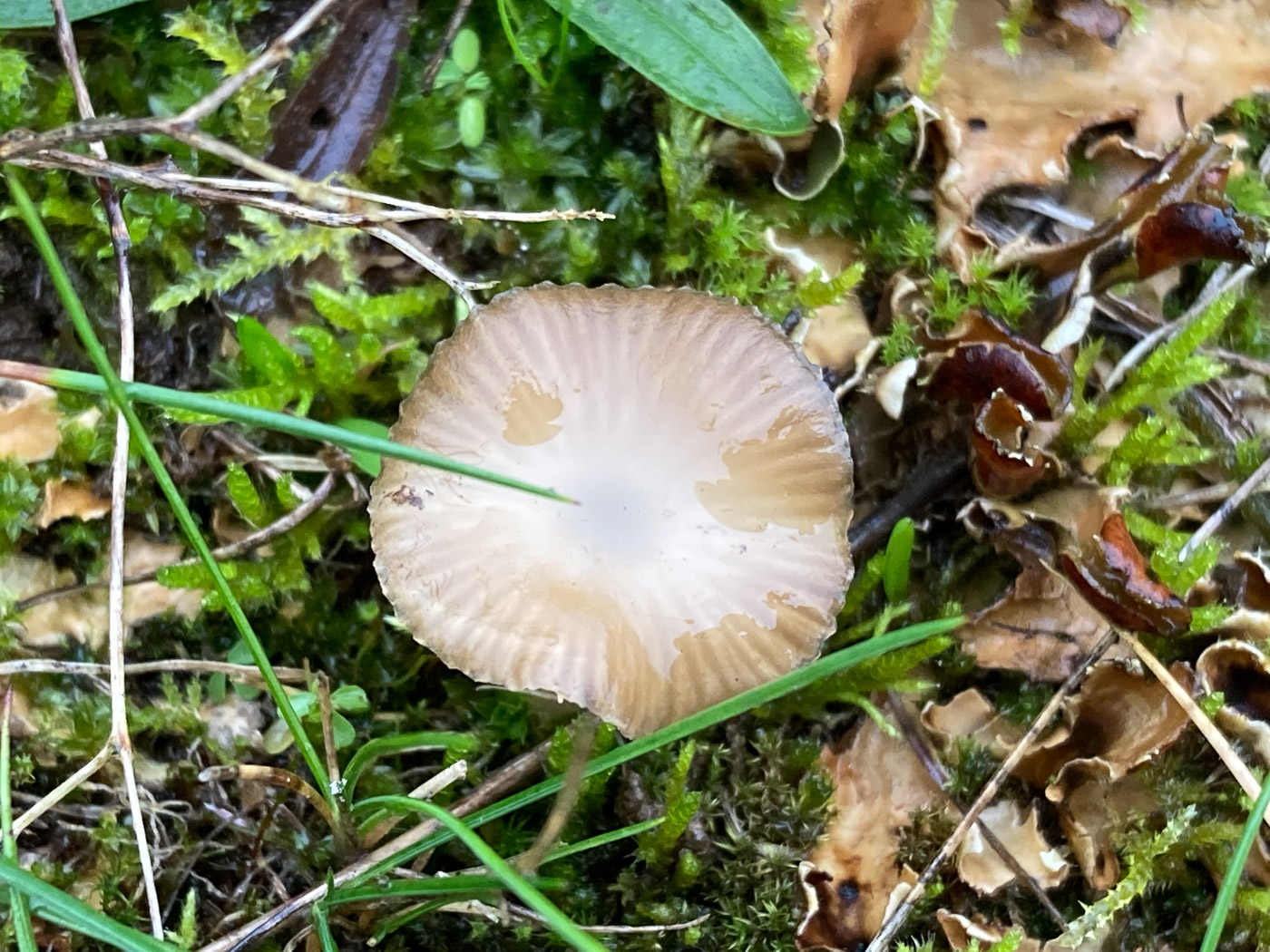 |
January 8th Gamundia striatula (Lined Meadowcap) 
In December at Dorney Wetlands Russell Ness found some interesting little mushrooms growing amongst gravelly moss and dog lichen. Working on them later he concluded they were probably this species but could not see the tiny spines on the spores necessary to confirm the identification. Finding the species again today he tried again and this time with success: viewing them x 1000 in KOH did the trick! Photo 1 is of his December collection, photos 2 and 3 are today's. This is a rare little LBJ, not often recorded and a first for the county, so an exciting find.
|
January 7th 2022
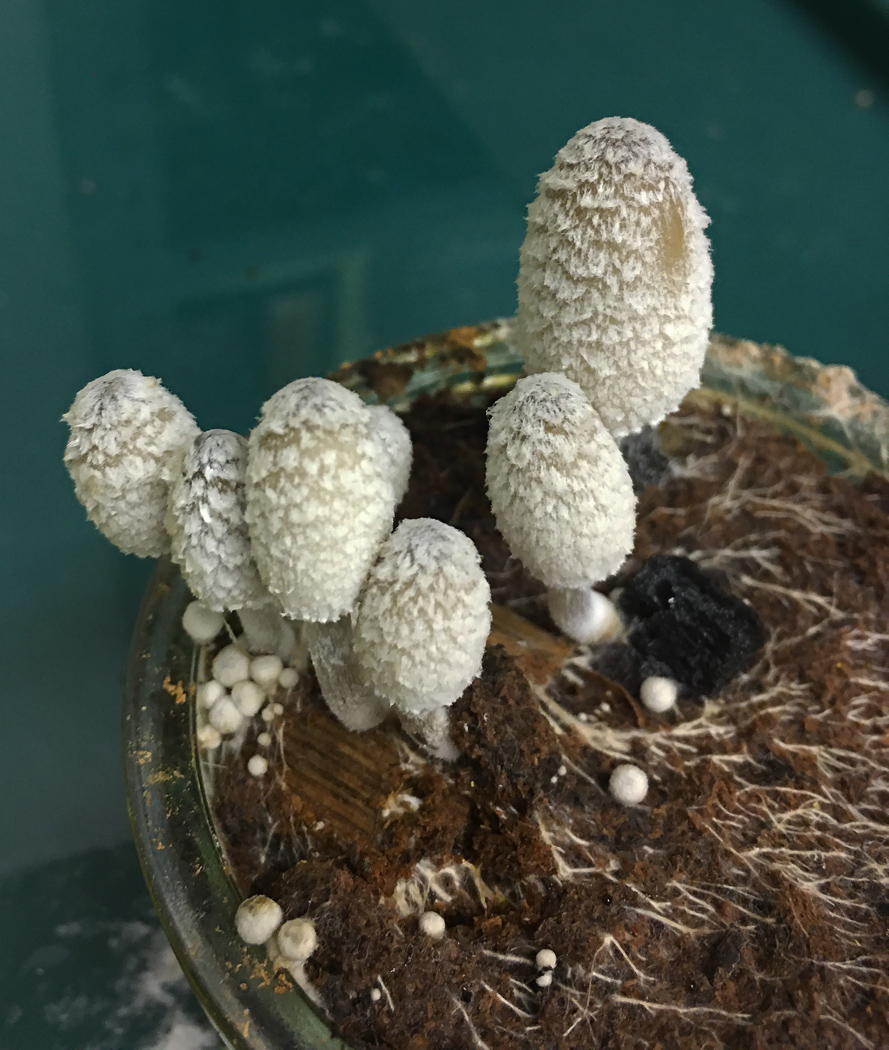
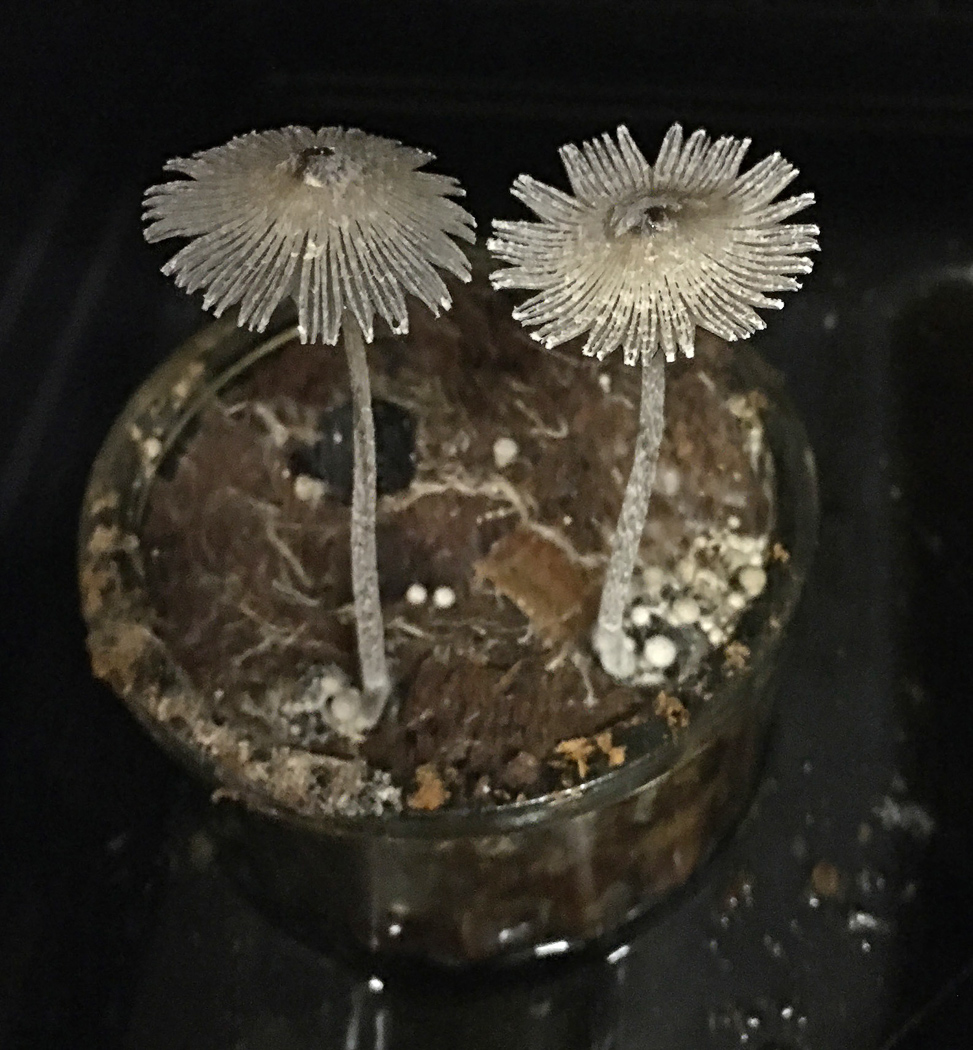
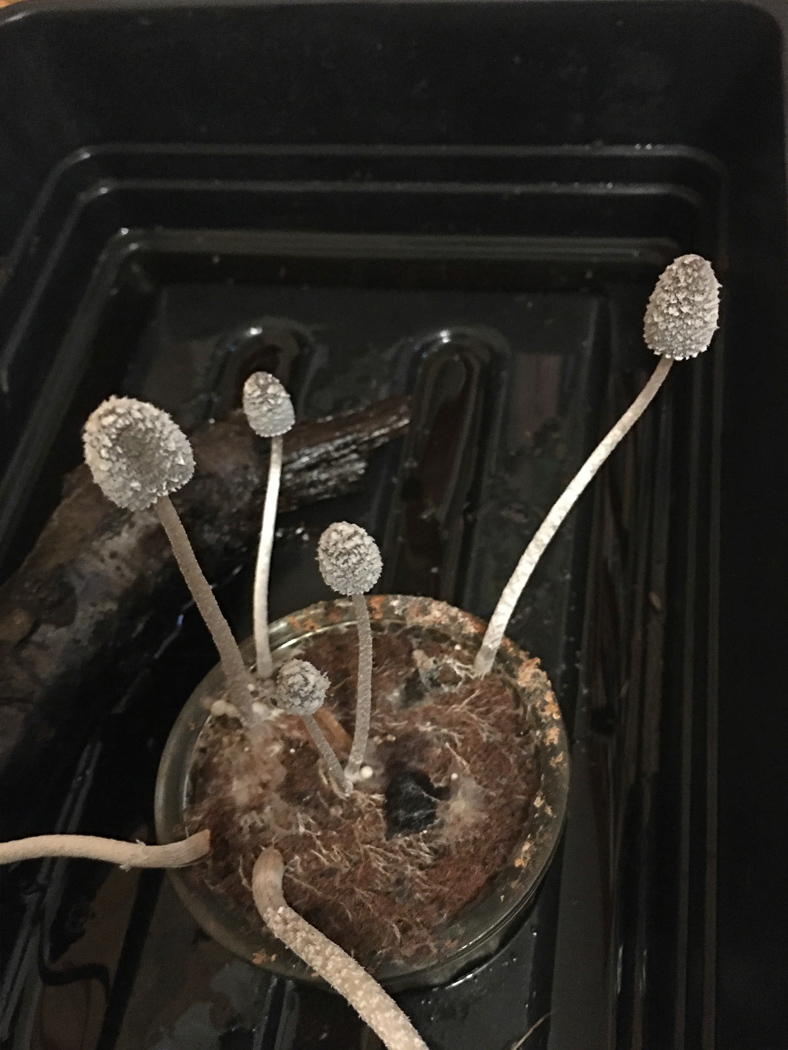 |
January 7th Coprinopsis echinospora (Warty Inkcap) 
On our Naphill Common Walk back in October this species was collected and identified by Derek, who then inoculated some sterilised woodchip with the remnants of the specimen in the hope of producing more fruitbodies. Nothing happened for two months but he was rewarded with fruiting throughout December (photos 1-3). He says it has just about finished now but he is hopeful that more (or something different) might appear at any time!This is not a common Inkcap with only two previous records prior to the find at Naphill. The common name refers to its very unusual warty spores which, however, make it an easy Inckap to identify with a scope.
|
January 6th 2022

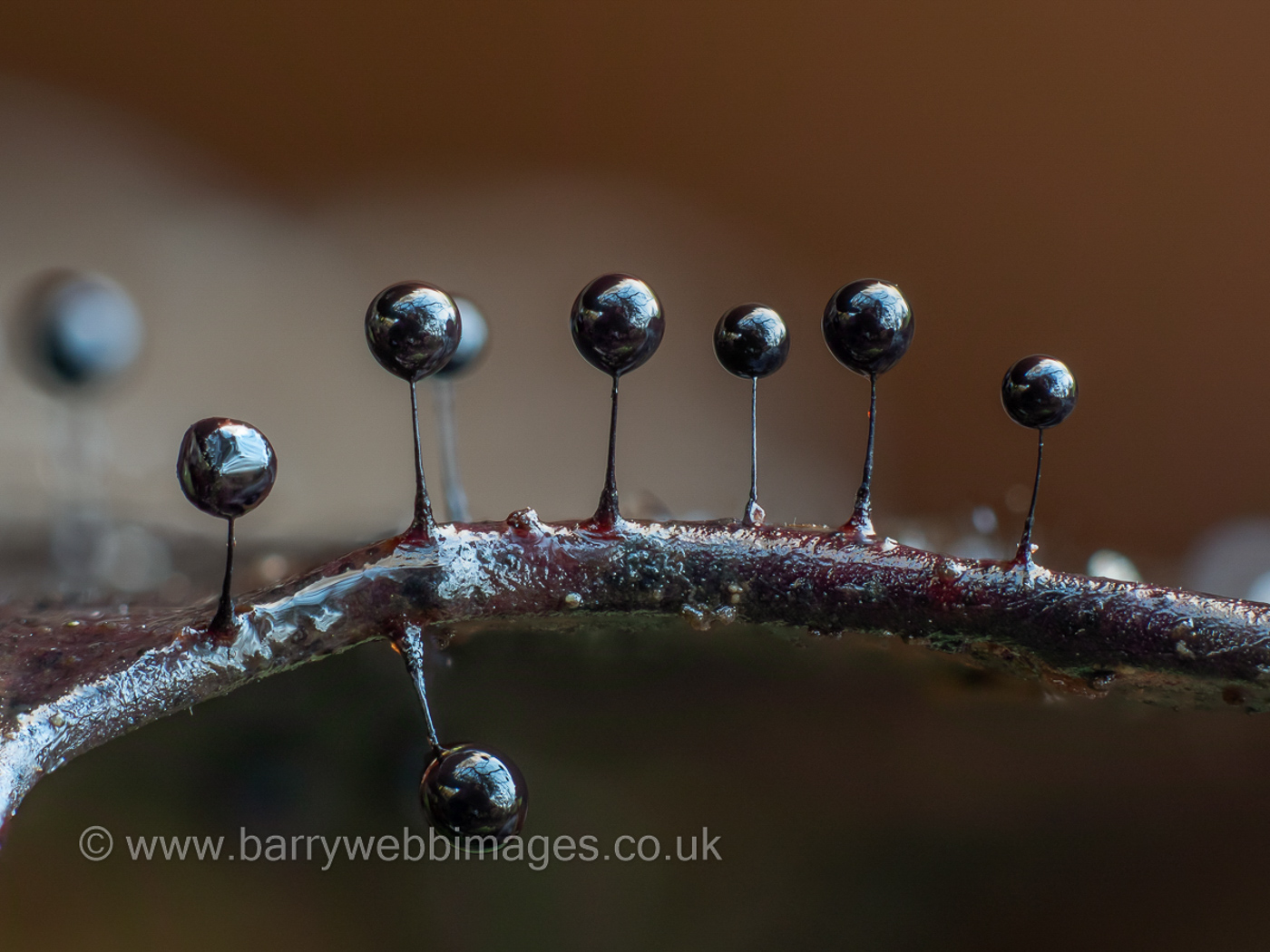
 |
January 6th Collaria rubens (a rare Slime Mould with no common name)
In Hodgemoor Woods Barry Webb found no less than six different species (all slime moulds except for Marasmius hudsonii) within one foot of each other under a Holly bush when looking for the Marasmius. C. rubens was the most interesting of them but he was unsure of its identification until Myxo expert Edvin Johannesen confirmed it from Barry's exquisite photos. He then found this rare species again in Naphill Common a week later. Photo1 (Hodgemoor) shows the tiny collar just under the sporangia typical of the species. Photos 2 and 3 (Naphill) show both immature and mature specimens. The species is described as occurring in leaf litter, especially Ivy and Holly as here. This is yet another Slime Mould new to the county. (For more examples of the genus go to Barry's separate page on Finds.)
|
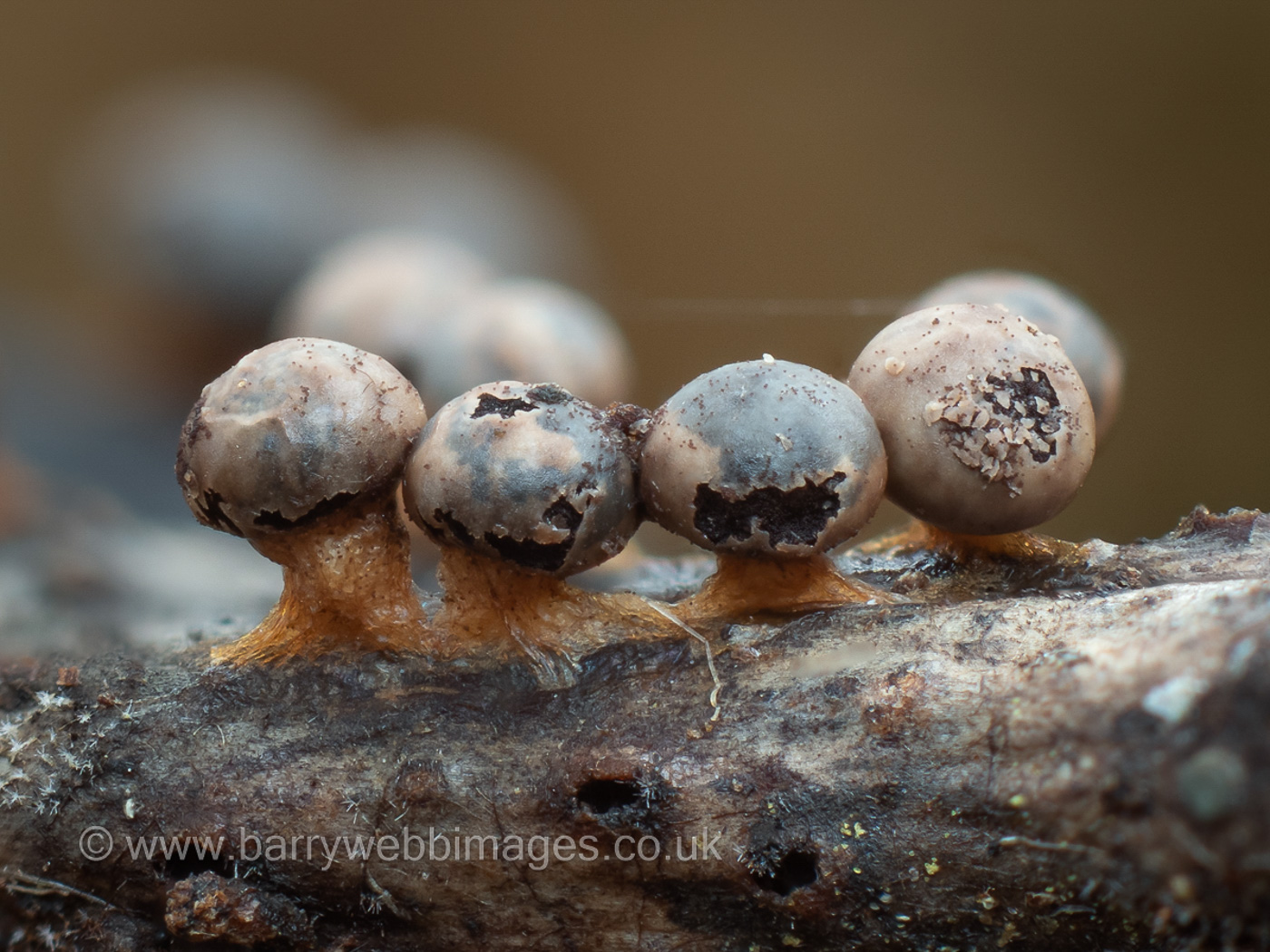 |
January 6th Diderma umbilicatum (a Slime Mould with no common name)
In Hodgemoor Woods Barry Webb found this species - not rare but still new to the county - on an oak twig in leaf litter. Diderma is a large genus of 70 odd species characterised by their crusty coating of lime crystals. Today's species is quite large for a slime mould - up to 1.3 mm across(!) - with pale shiny heads and a thick short orange umbilicate stalk beneath. (For more examples of the genus go to Barry's separate page on Finds.)
|
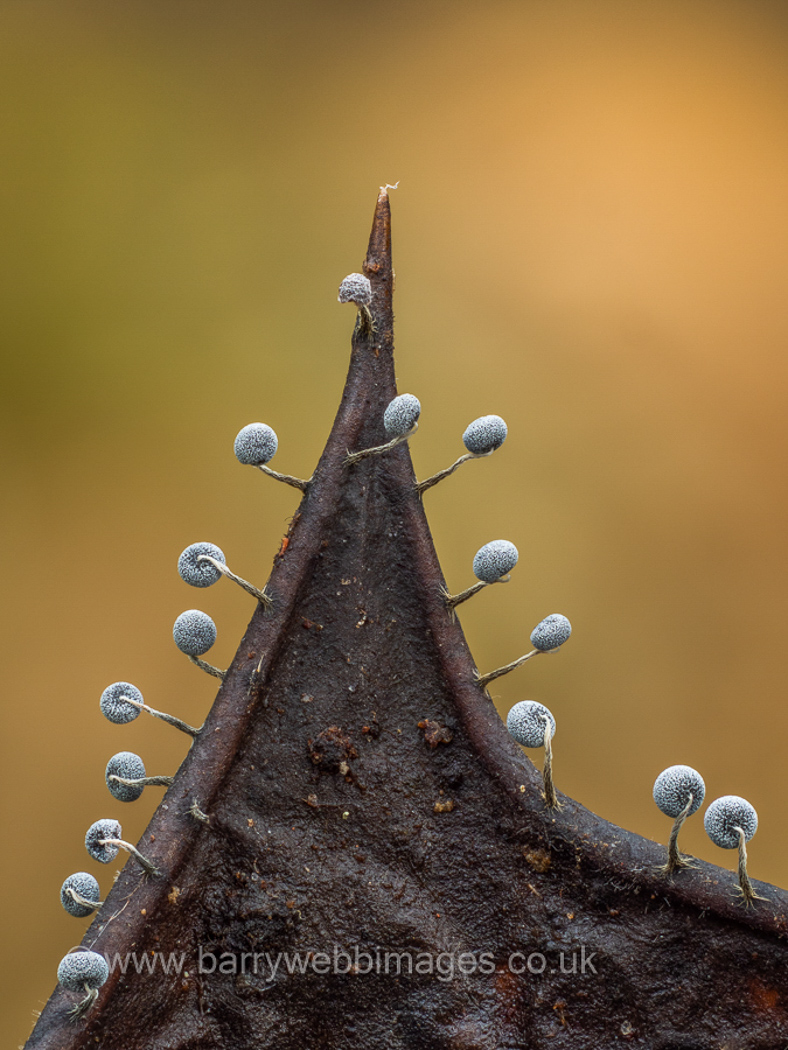 |
January 6th Physarum album (a Slime Mould with no common name)
In Hodgemoor Woods Barry found this really photogenic example of quite a common Myxo on a curled up dead Holly leaf. Previously known as P. nutans (meaning nodding), when mature the heads of this species usually dip over as can be seen here. It is more often found on dead wood or bark, less often in moss or leaf litter as here. (For more examples of the genus go to Barry's separate page on Finds.)
|
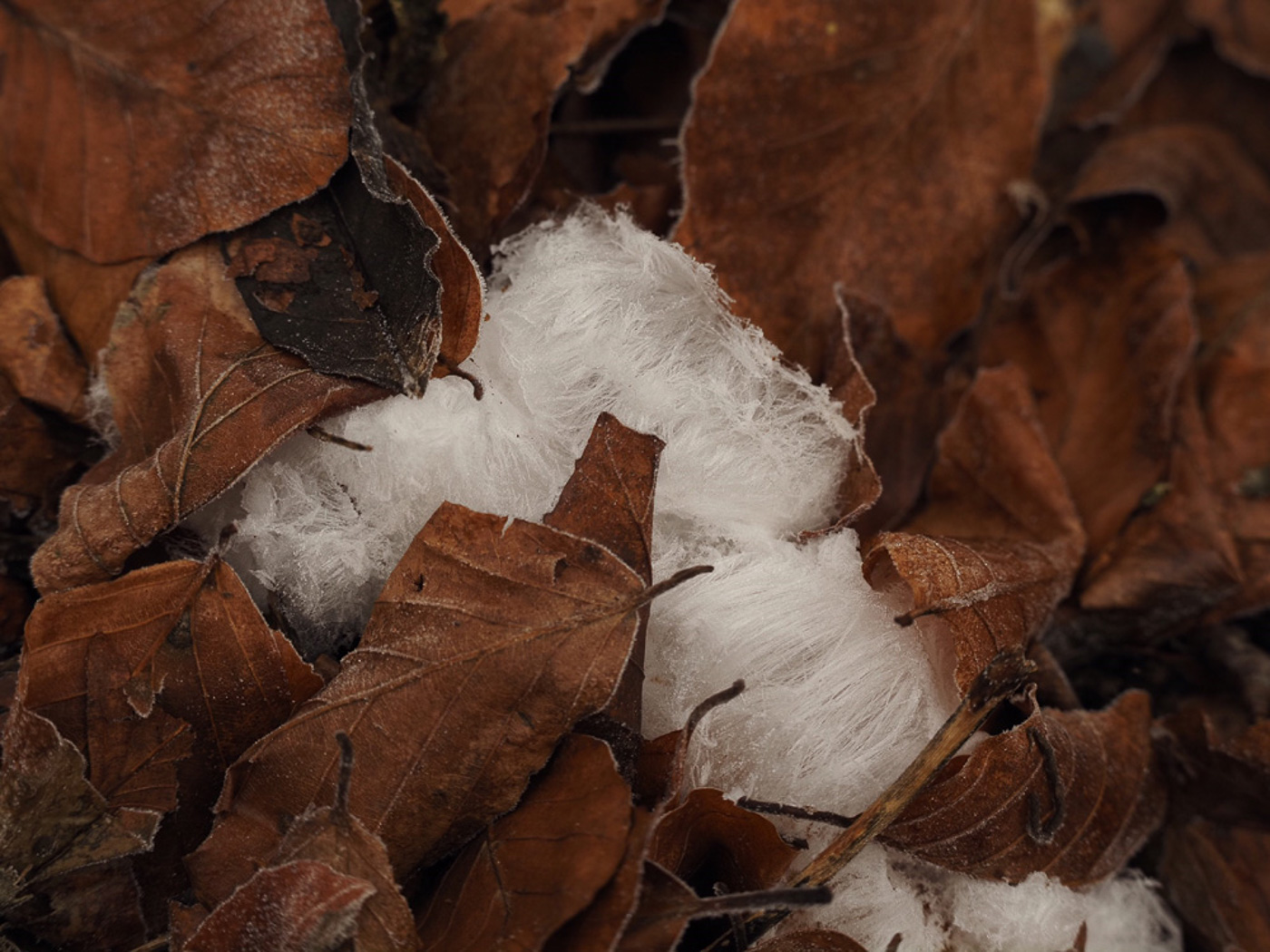

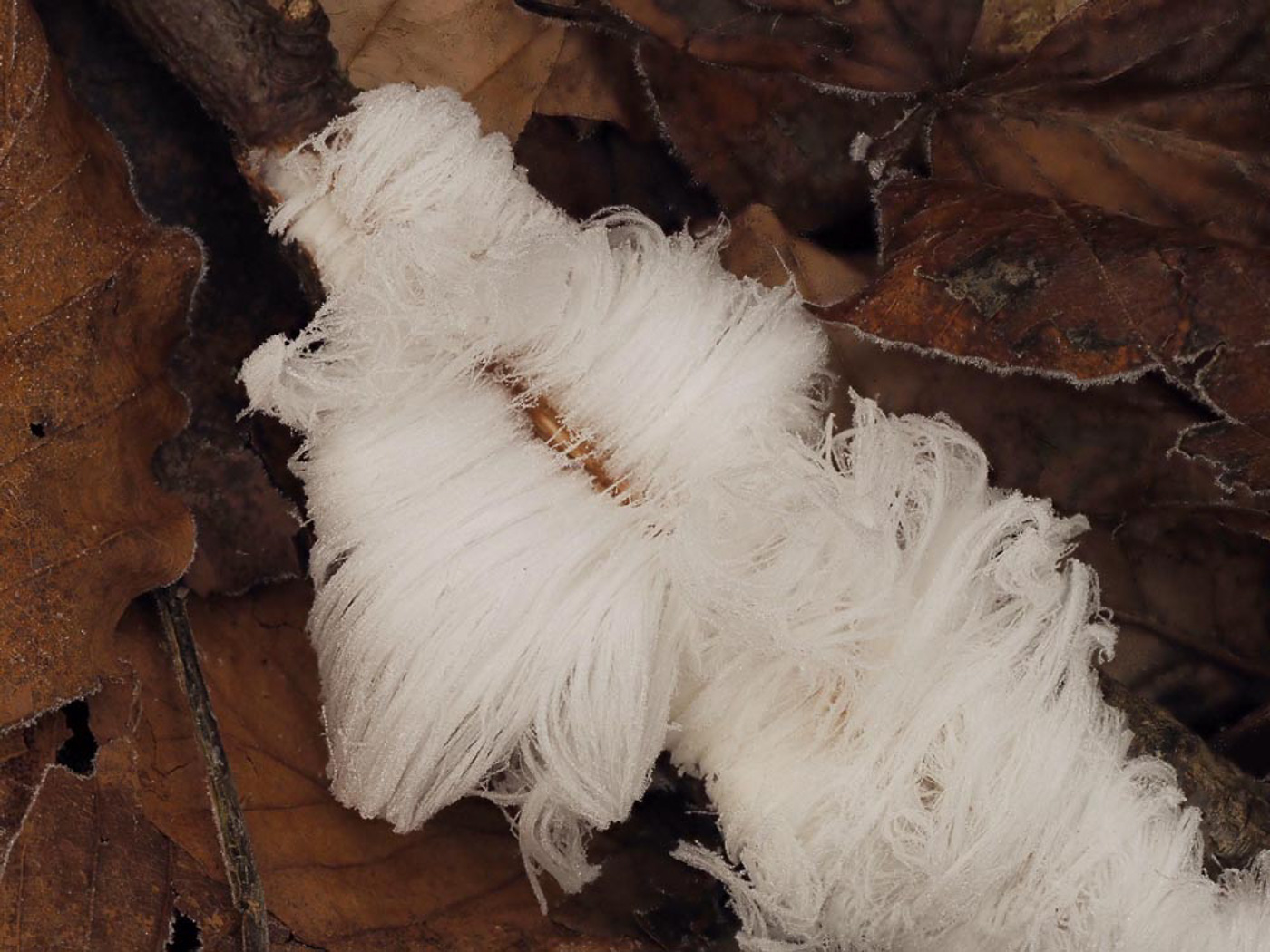

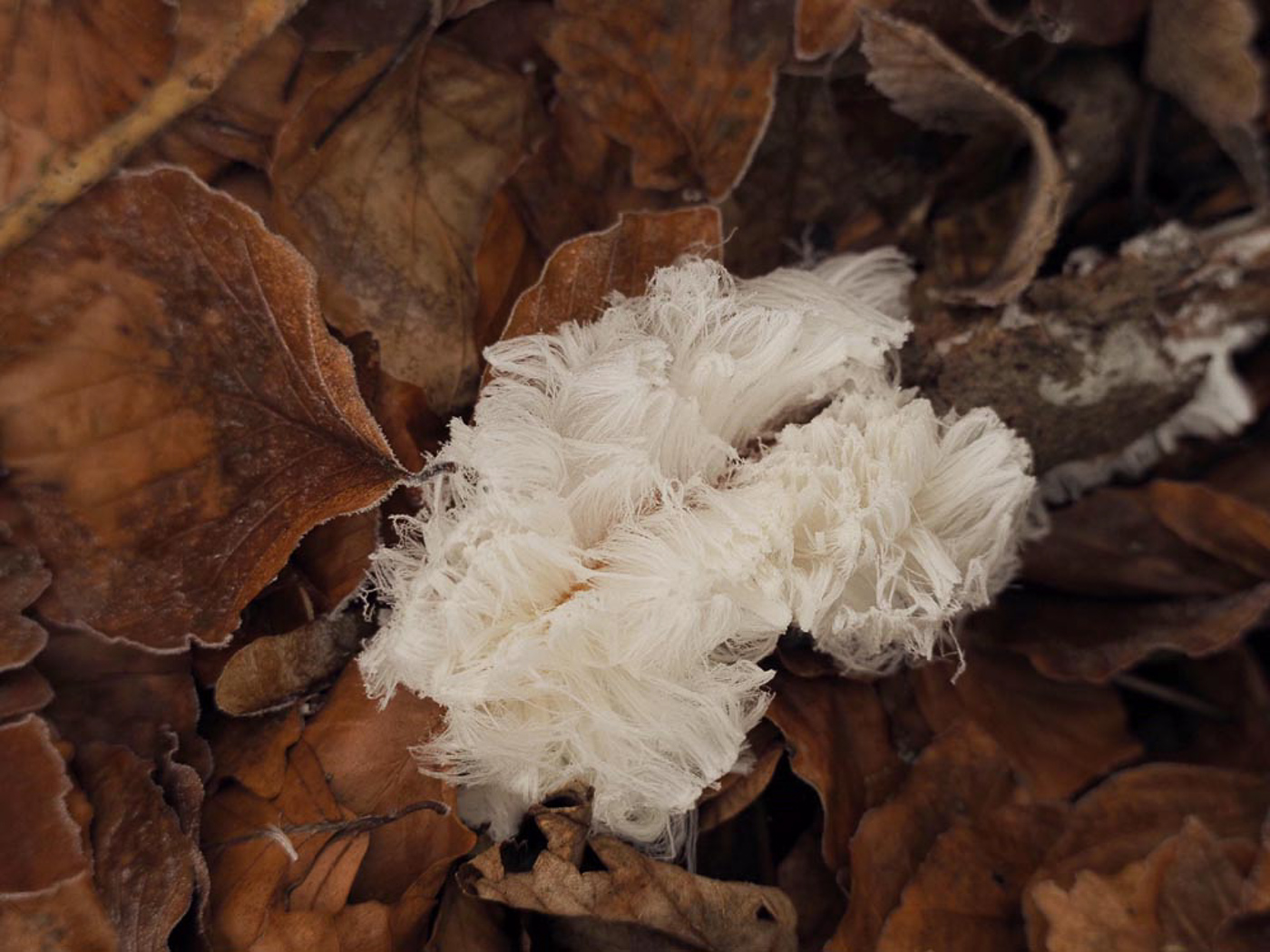 |
January 6th Exidiopsis effusa (the jelly fungus responsible for causing the phenomenon HAIR ICE)
In Lane End Claire Williams took these fabulous photos of what is known as Hair Ice, a rare phenomenon which can form on fallen sticks in frosty weather when conditions are perfect for its formation as they clearly were last night! See also her photo when she found it here last year in Finds 2021 dated Jan 8th. Photo 2 here shows how the bark of the twig has been lifted off by the ice as it forms. Also it's worth taking a look at member John Tyler's article entitled 'The strange case of the ice-making fungus' on the Articles page on our website, written several years ago, which sheds more light on it. There is much more online about it as well. One can't see the actual fungus within the wood but as it is now proven that it is responsible for causing this beautiful white moustache-like icy growth, it must be present!
|
January 4th 2022

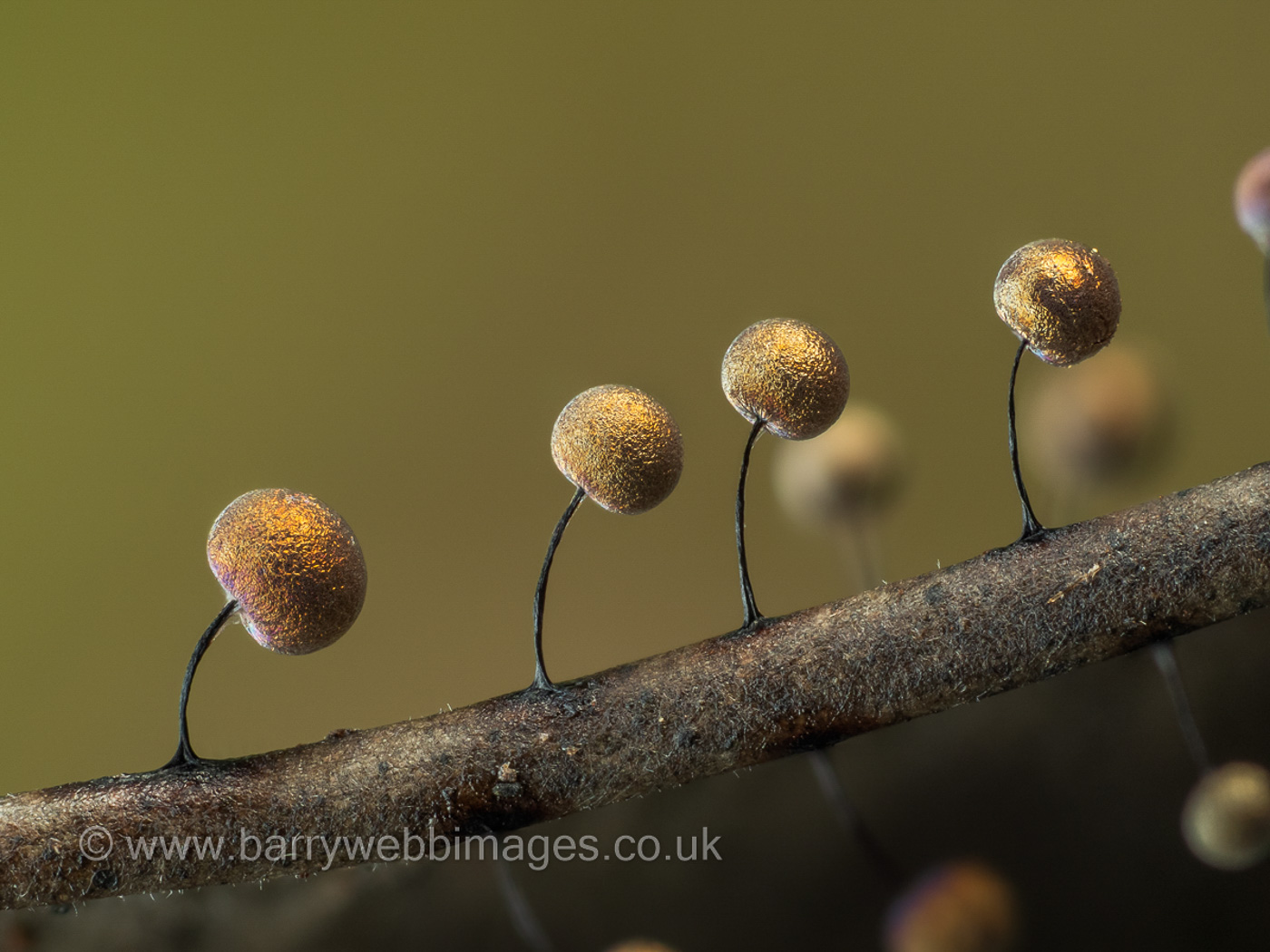

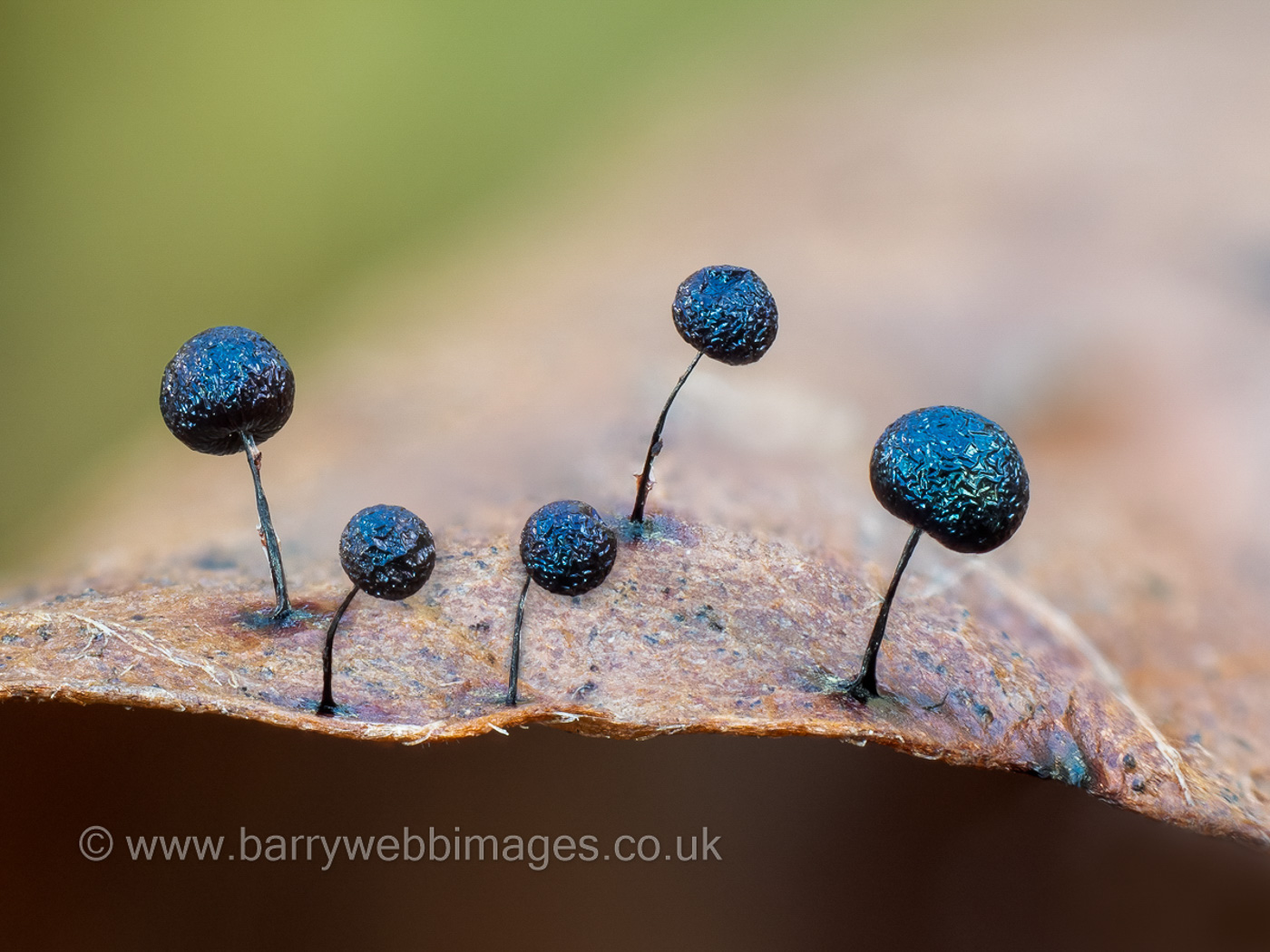
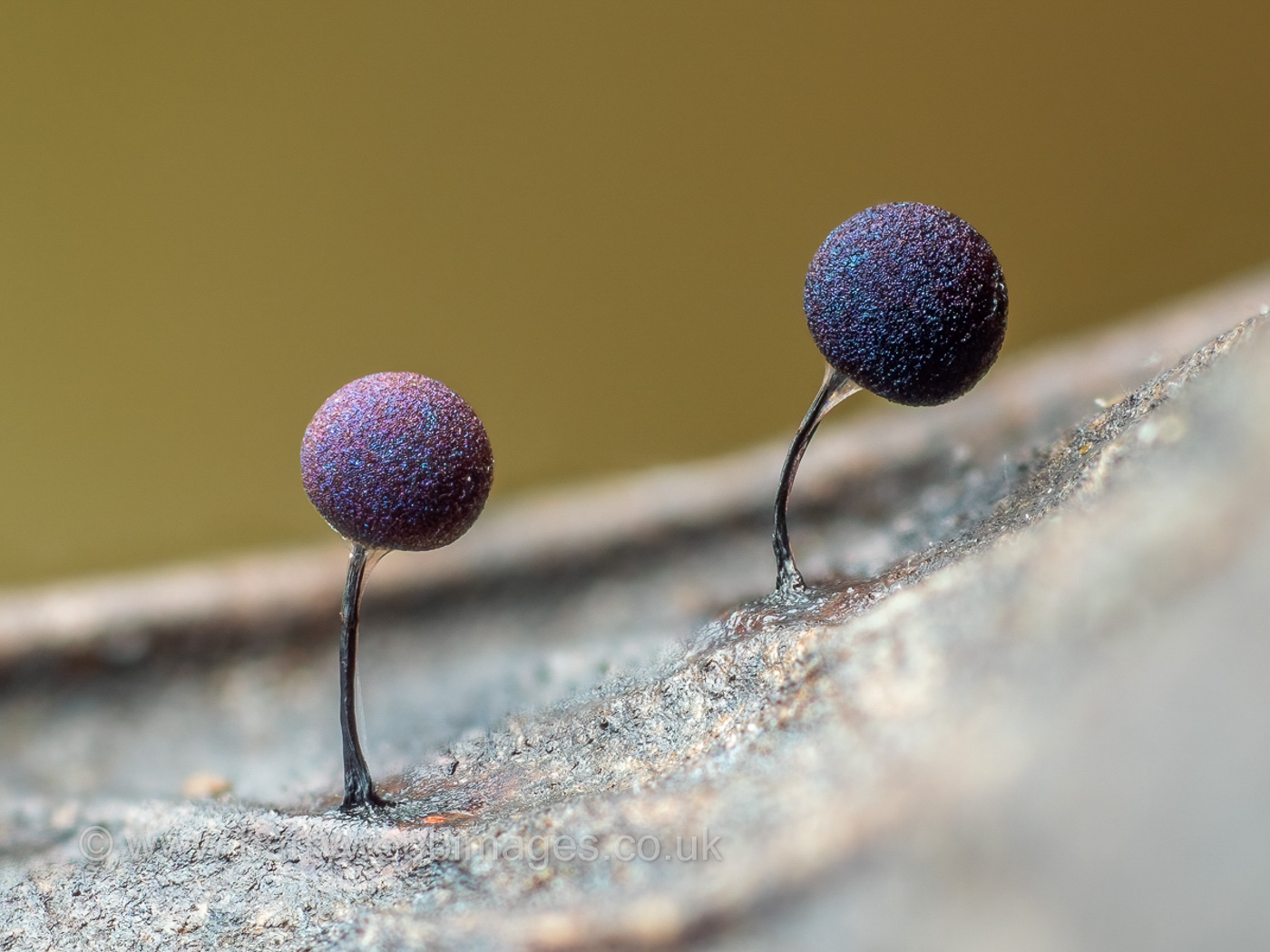 |
January 4th Lamproderma scintillans (a Slime Mould with no common name)
When in Hodgemoor Woods a week or so ago when Barry Webb and Gill found the delectable Marasmius hudsonii (see 2021 dated Dec 30th), Barry collected the Holly leaf on which that fungus was fruiting and - as is his habit - kept it in his greenhouse to see what else might appear. Lo and behold and to his delight, today's lovely species is what appeared! These little glistening iridescent gems are less than 1mm tall and occur on old rotting leaves, particularly of Holly and also ferns. Photos 2 and 3 were taken over the next couple of days from the same collection showing the variation in colour typical of the species as it matures. Photos 4 and 5 are from when he found it again at Naphill Common on January 12th. See more details and an image of our only other county record on Barry's separate page on Finds, also on Finds 2020 dated Dec 24th.
|
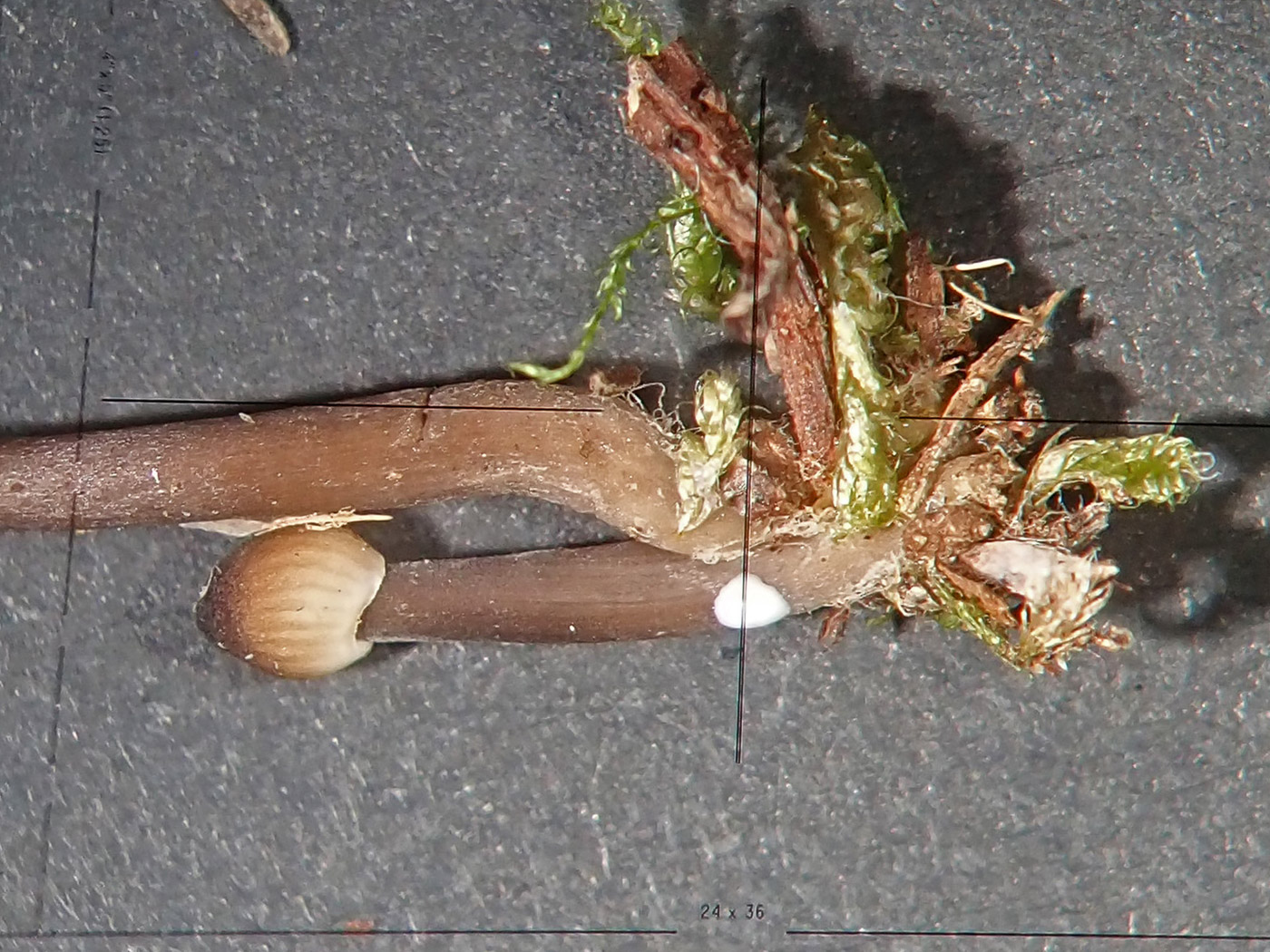 |
January 4th Mycena galopus (Common)
Following his find of the rare Marasmiellus tricolor at Stoke Common yesterday, Jim Wills returned today and hoped he'd collected more material of the same species. However, when examined by Derek Schafer it turned out to be not the same at all but the common M. galopus! (Note the large drop of 'milk' on the stem of this tiny specimen - Derek's photo.) It is interesting that of our 250 odd county records of this species we have a handful from January but all found either in 1998 or 2001 which, checking online, were pretty well frost free and damp in the south for much of that month.
|

 |
January 4th Entoloma conferendum (Star Pinkgill) 
In a grassy area at Stampwell Farm Jackie Ewan noticed this singleton LBJ and turning it over realised the gills were suitably pink making it an Entoloma species. Luckily this is not only one of the commonest grassland Pinkgills but also about the easiest to identify, having very distinctive and unique star-shaped spores (hence its common name). For more see Finds 2020 dated Oct 30th.
|
 |
January 4th Xylaria hypoxylon (Candlesnuff)
At Stampwell Farm on a fallen deciduous stick Jackie Ewan noticed this common species still looking quite fresh. For more see Finds 2020 dated Oct 20th, also 2021 dated Nov 13th.
|
January 3rd 2022

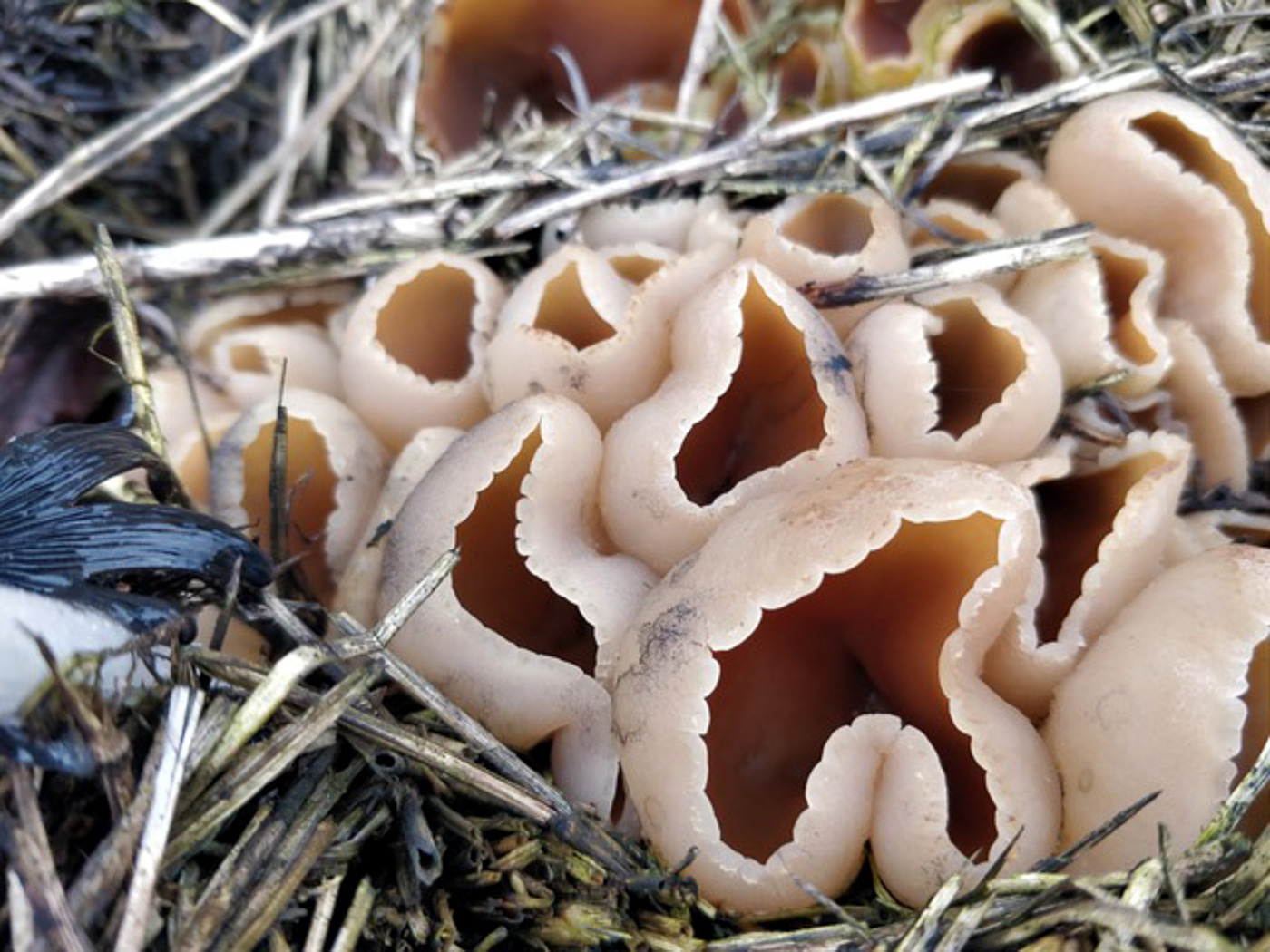
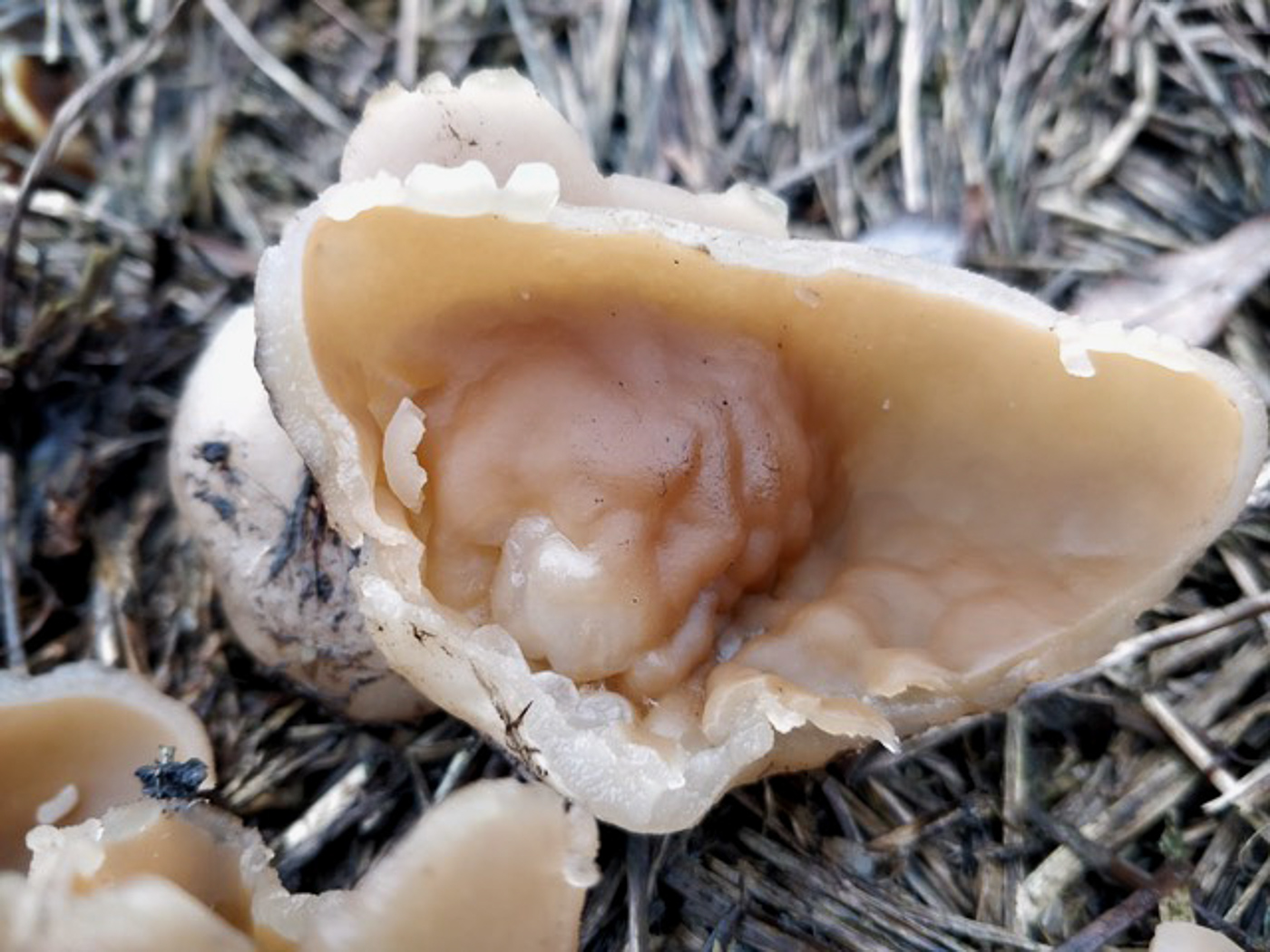 |
January 3rd Peziza vesiculosa (Blistered Cup) 
On a bale of hay in Weasel's Lane nr Milton Keynes a neighbour of Bob Simpson's noticed this tight cluster of cups and sent him a photo. After much deliberation and discussion over its identity we are now quite sure that this is Peziza vesiculosa (confirmed by expert Kerry Robinson) despite the lack of blue tips when viewed in Melzers reagent with a scope! Everything else fits like a glove including the wrinkled inner surface (seen in photo 3), the fluted edges to the crowded cups and the unusual substrate. The genus mostly occurs on fallen wood or soil but this species occurs all year round on dung heaps with straw and hay, also on bales and piles of rotting grass etc. We have good numbers of county records but none since 2014 and only two in January though Kerry says the species withstands wintry conditions well. We reckon the recent hard frosts account for the lack of reaction to Melzers here.
|
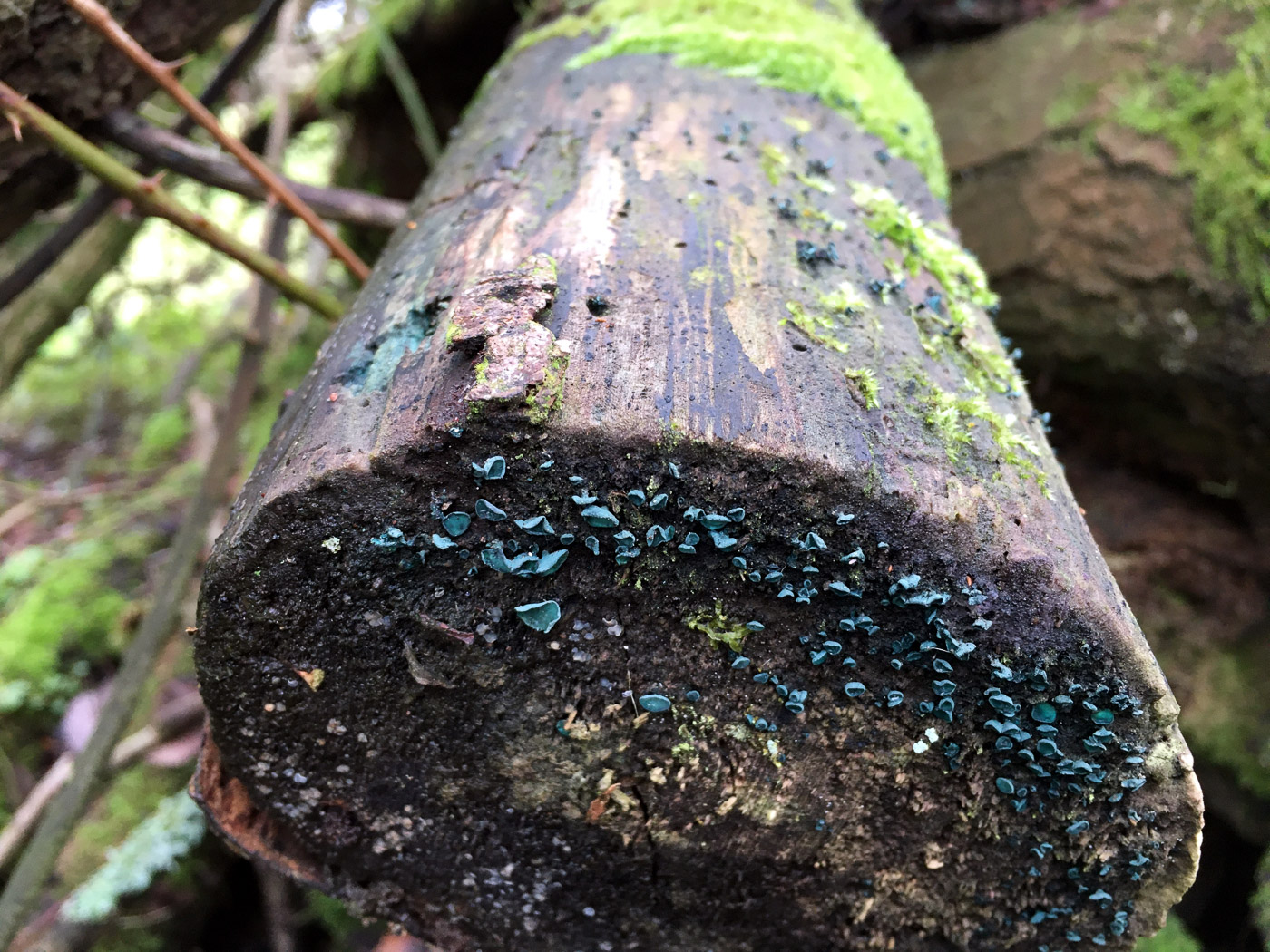
 |
January 3rd Chlorociboria aeruginascens (Green Elfcup)
On a felled deciduous trunk in Brill Common Joanna Dodsworth found this large colony of cups. What is unusual about this find is not just that it's so late in the season but also that the species is commonly found on twigs and smallish fallen deciduous branches, not sawn off ends of large trunks as here! See also Finds 2020 dated Oct 12th, also 2021 dated Sept 1st.
|
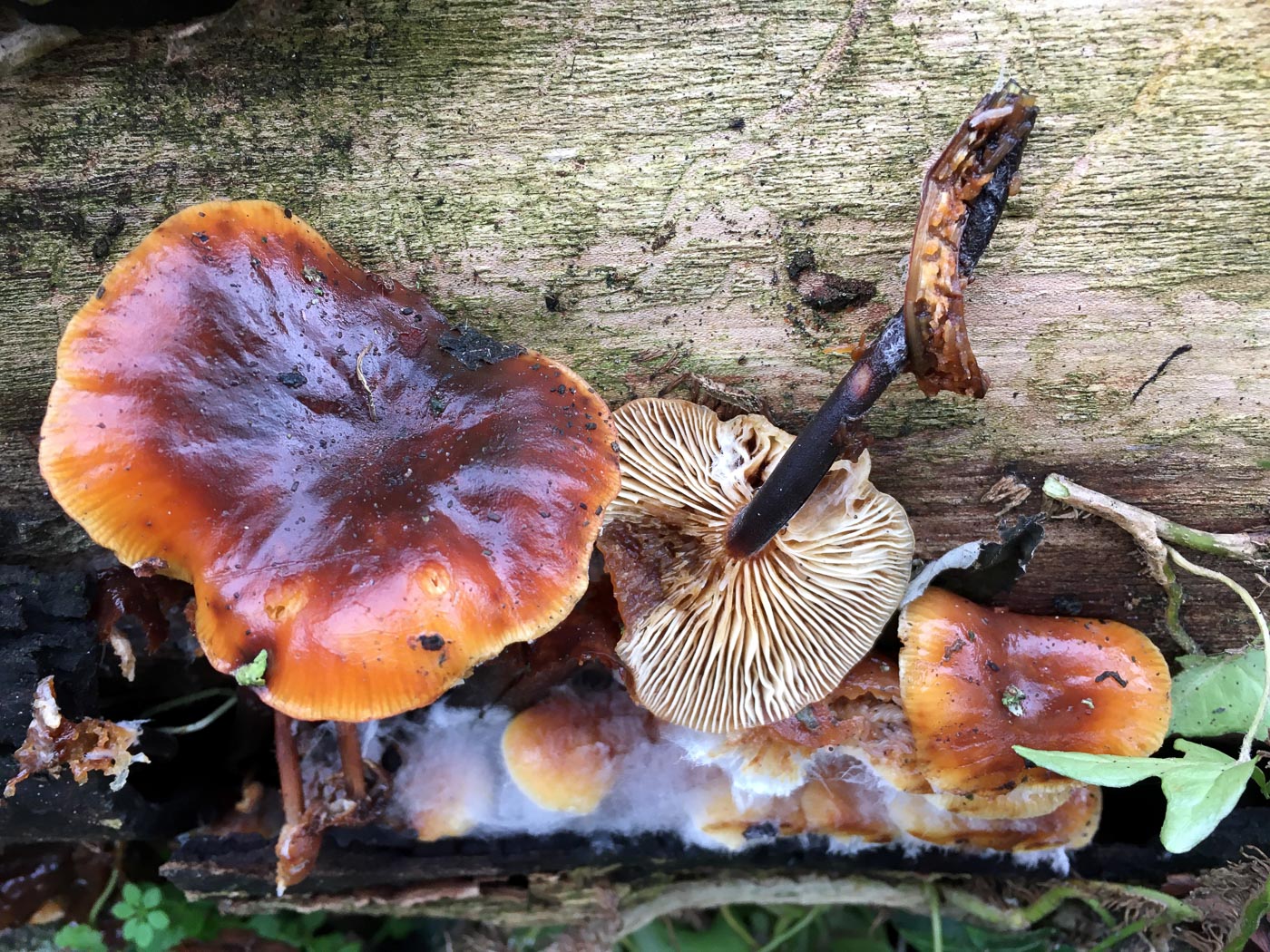
 |
January 3rd Flammulina velutipes (Velvet Shank)
In Brill Common on a deciduous log Joanna Dodsworth found this typical late season species - one that often doesn't make an appearance until after the first frosts and can even be found in really wintry weather. It forms tight clumps on fallen deciduous wood, both standing and fallen, and occasionally occurs on conifer. Photo 2 is a magnificent clump of the same species found by Jackie Ewan at Stampwell Farm on a standing Ash trunk the next day. (No coincidence, this! Our Finds entries since 2020 are full of examples of this happening.)
|
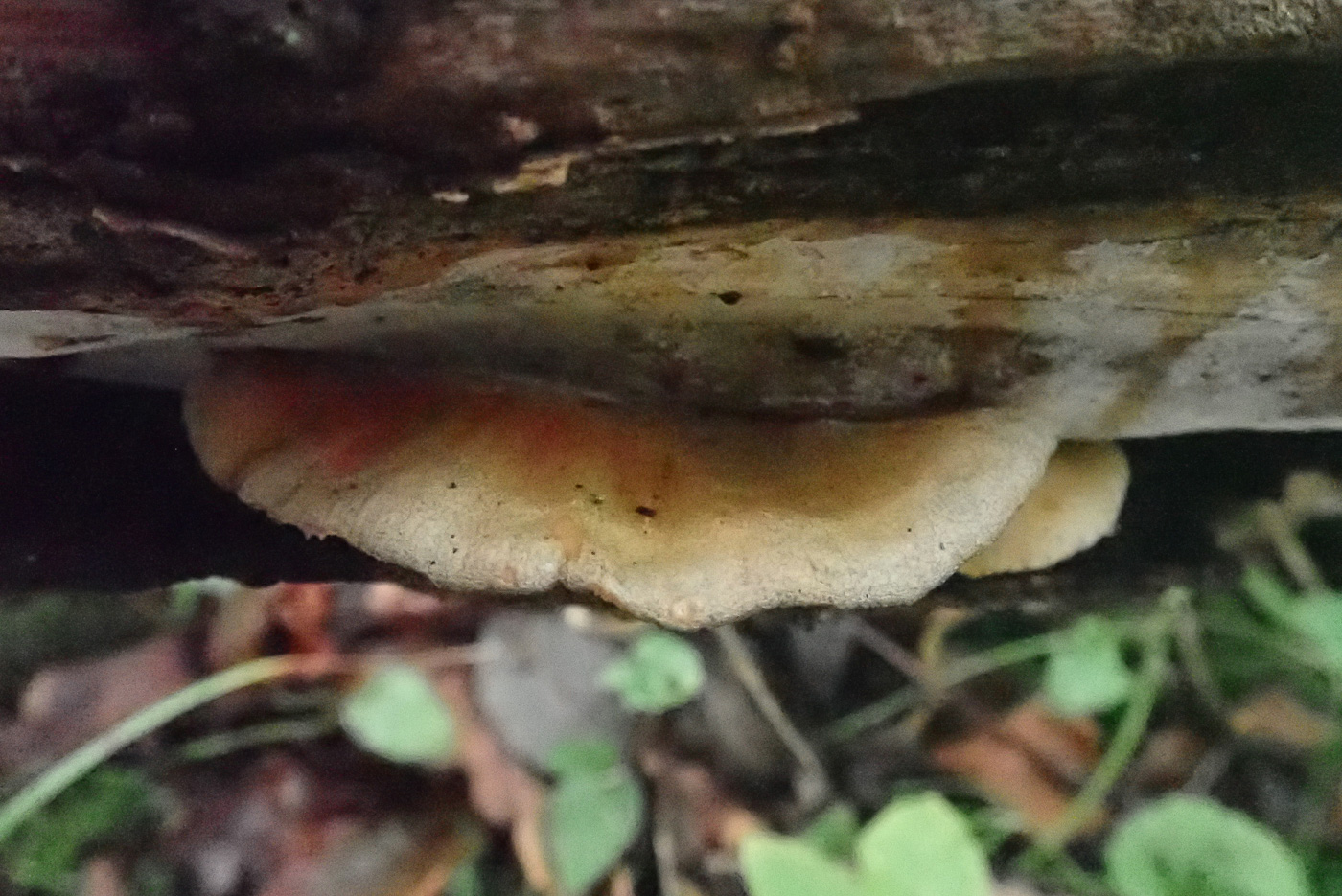

 |
January 3rd Sarcomyxa serotina (Olive Oysterling) 
On the underside a fallen Willow trunk in Rushbeds Wood Penny noticed this 'Pleurotoid' species (photo 1) but had to break several of the brackets off to be able to view it properly. The yellowish eccentric stem was a strong clue to the species though the dull brown cap colour could have belonged to several other species but at home the scope revealed tiny allantoid (sausage-shaped) spores and also the flesh was extremely gelatinous - all good pointers to this unusual but not rare species (previously known as Panellus serotinus, the species name meaning late season). When fresh and at its best the caps are olive greenish but this colour usually fades quickly. We have quite a few sites in the county where it's been recorded but it was new to Rushbeds Wood today.
|
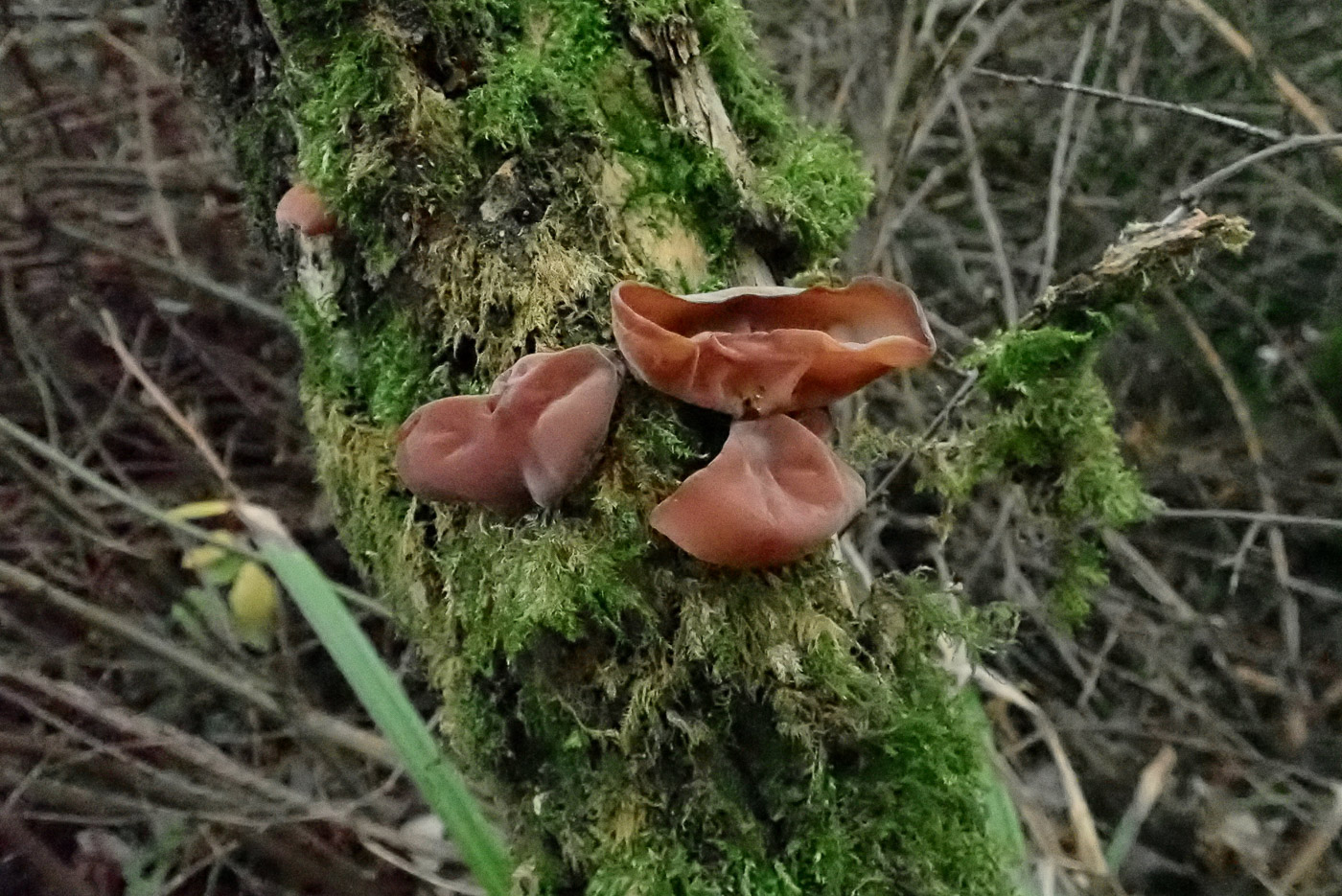 |
January 3rd Auricularia auricula-judae (Jelly Ear)
On a living Elder trunk in Rushbeds Wood Penny found a few species of this species fruiting. See Finds 2021 dated Oct 5th for more notes and images.
|
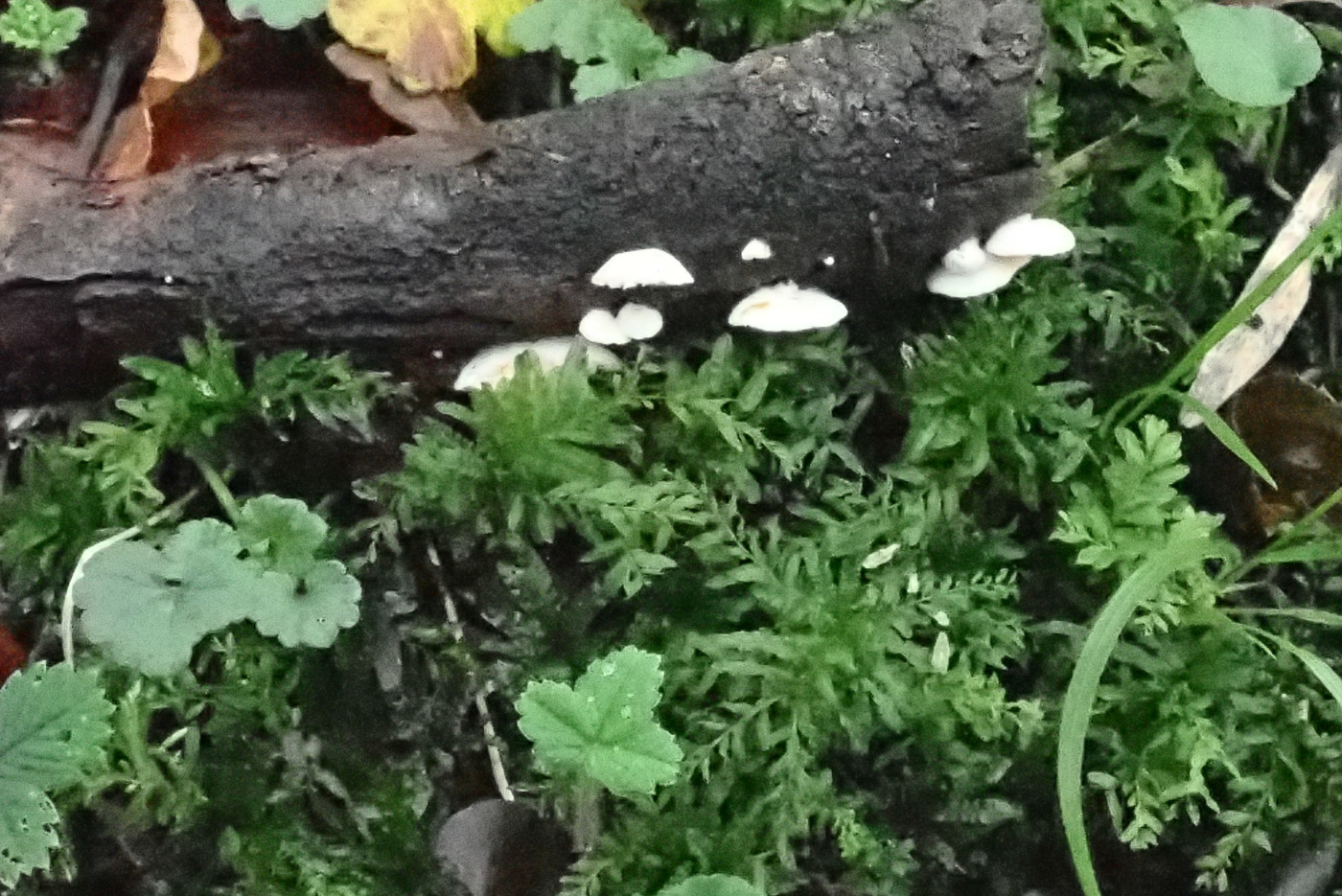
 |
January 3rd Crepidotus cesatii (Round-spored Oysterling) 
In Rushbeds Wood Penny saw several twigs / stick with small specimens of this genus, then eventually found an example worth illustrating. There are two particularly common species on twigs which are virtually impossible to separate unless one looks at the spores: C. variabilis and C. cesatii. Today's had round spores whereas C. variabilis has cylindrical spores though both have spores with a fine ornamentation.
|

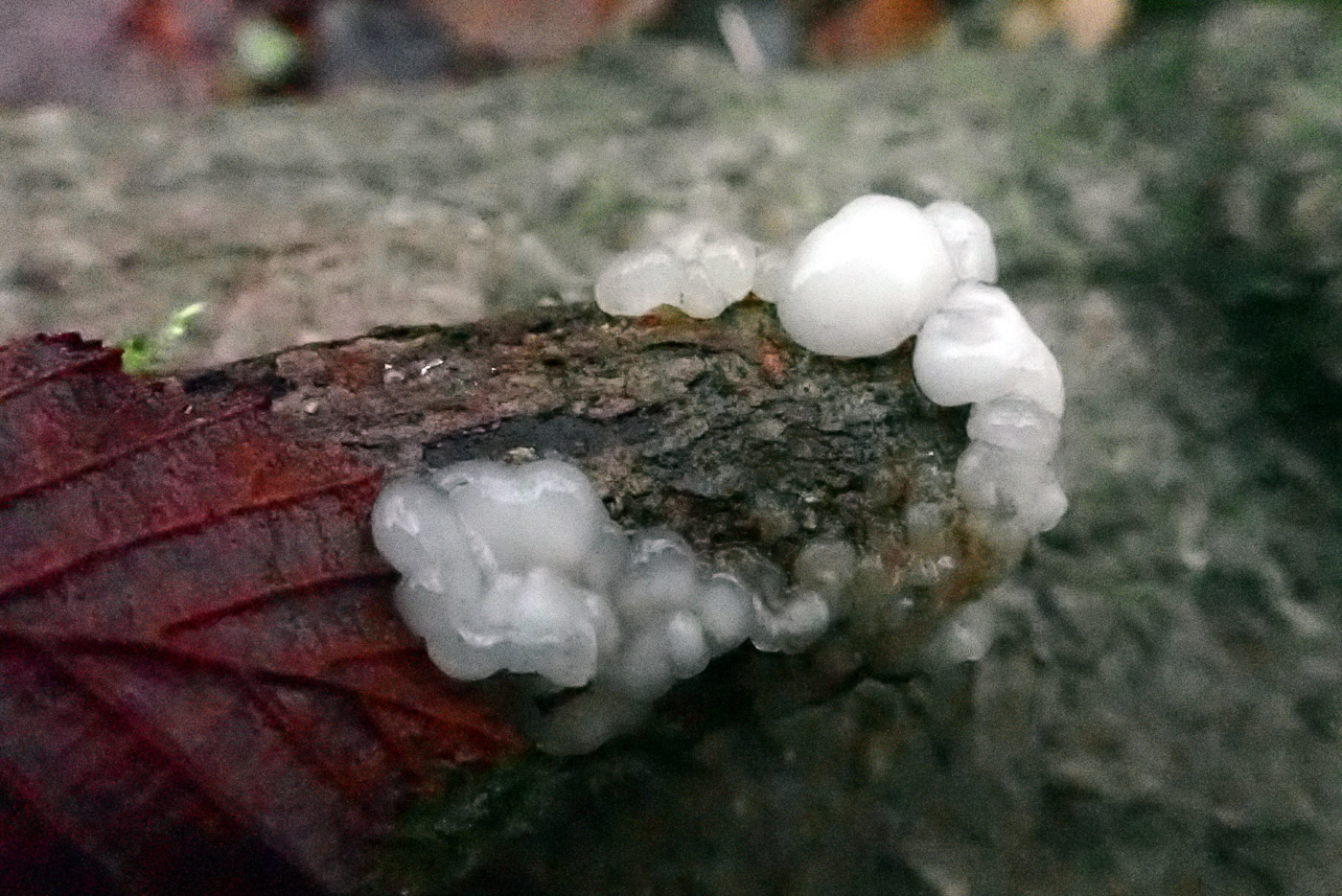
 |
January 3rd Exidia nucleata (Crystal Brain)
On deciduous sticks, probably Oak, in Rushbeds Wood Penny spotted several collections of this jelly-like fungus. The small white gelatinous blobs are quite distinctive and one can often see the hard white tiny 'nucleus' within which characterises the species (just about visible in photo 2). See also Finds 2020 dated Nov 5th.
|

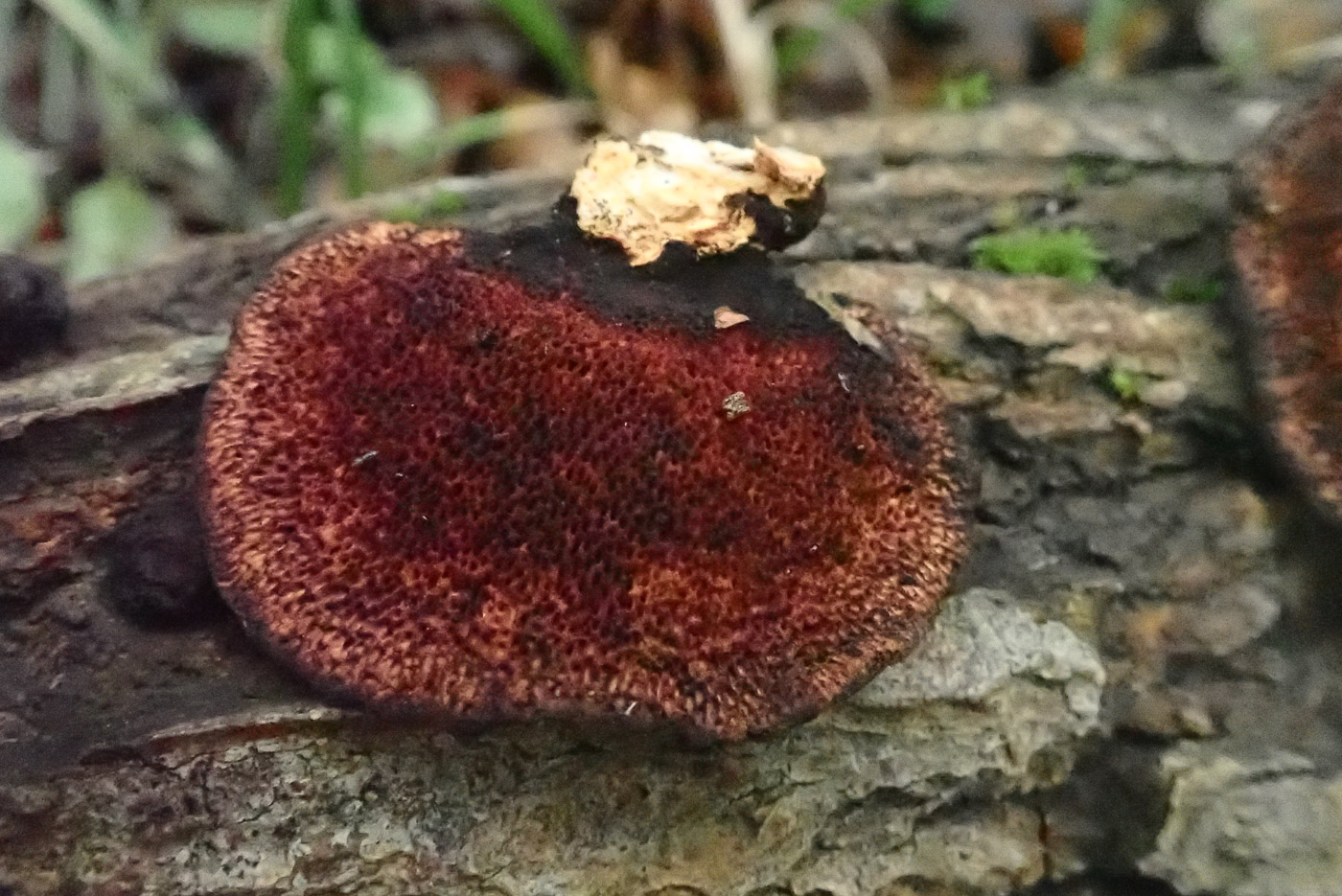 |
January 3rd Daedaleopsis confragosa (Blushing Bracket)
On fallen Willow in Rushbeds Wood Penny found good numbers of this very common species though none were fresh and all were turning dark reddish brown on top with hard dry pores underneath which don't 'blush' when pressed. When in this old dry state the species can confuse people but the red colour, half-moon shape and hard unblushing pores are typical. It is really common on fallen Birch and Willow. See Finds 2021 dated Sept 1st, also 2020 dated Sept 20th & Oct 8th for more examples.
|

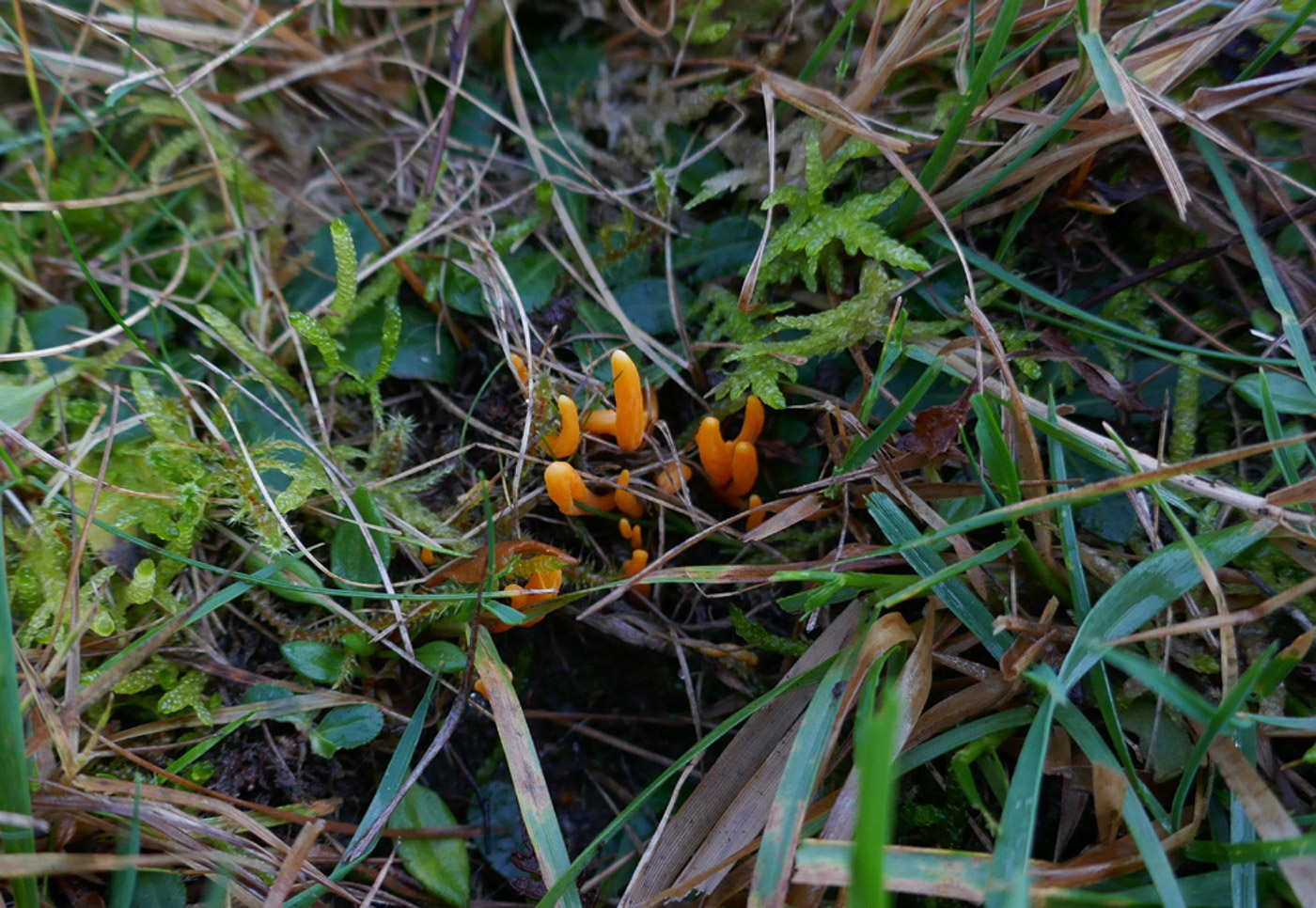 |
January 3rd Clavulinopsis luteoalba (Apricot Club) 
In a mossy woodland glade in Rushbeds Wood Penny noticed these brightly coloured clubs standing out. Yes, it is late in the season to be finding these but not that unusual for them to appear in woodland despite the fact that they are thought of a grassland species. (On our Rushbeds Walk in late November we found 4 species of Waxcap which also surprised some people.) However today's species appears to be new to the site. Photo 2 is of a further collection made by Jackie Ewan at Stampwell Farm the next day, proving yet again how species are triggered to fruit at the same time across a wide area.
|
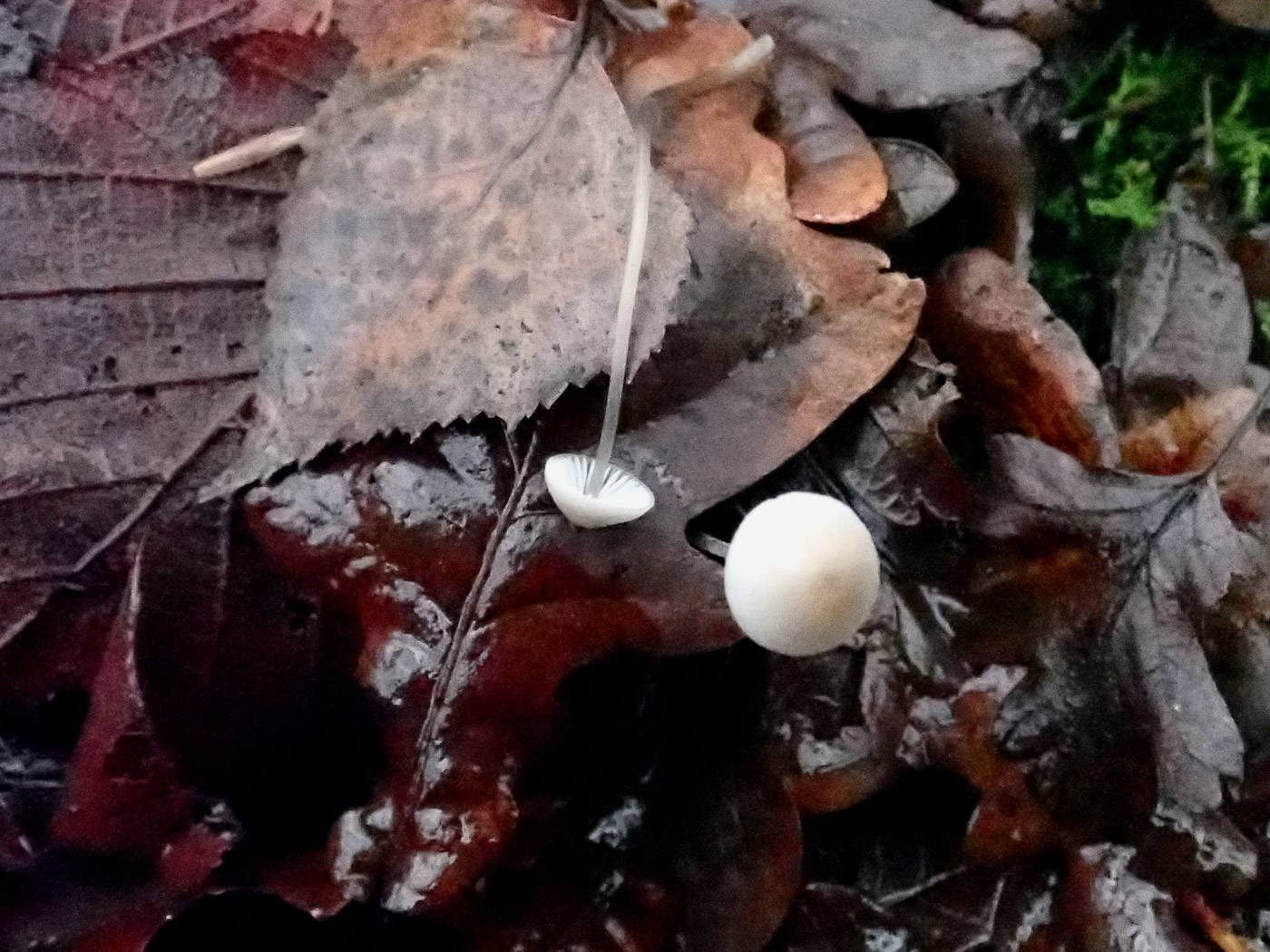 |
January 3rd Mycena filopes (Iodine Bonnet) 
On her muddy winter stroll in Rushbeds Wood Penny, to her surprise, found two species of Bonnet - this one needing a scope to identify. This is a typical nondescript smallish to middle-sized Bonnet found very commonly in woodland litter and not nameable to species with any certainty without a scope. It could just as easily have been M. vitilis (Snapping Bonnet) especially as its iodine smell is often faint and at best takes time in a pot to develop. The method of waving the specimen about to see if the stem snaps as it breaks is proven not to be reliable, so neither of the common names are particularly useful!
|
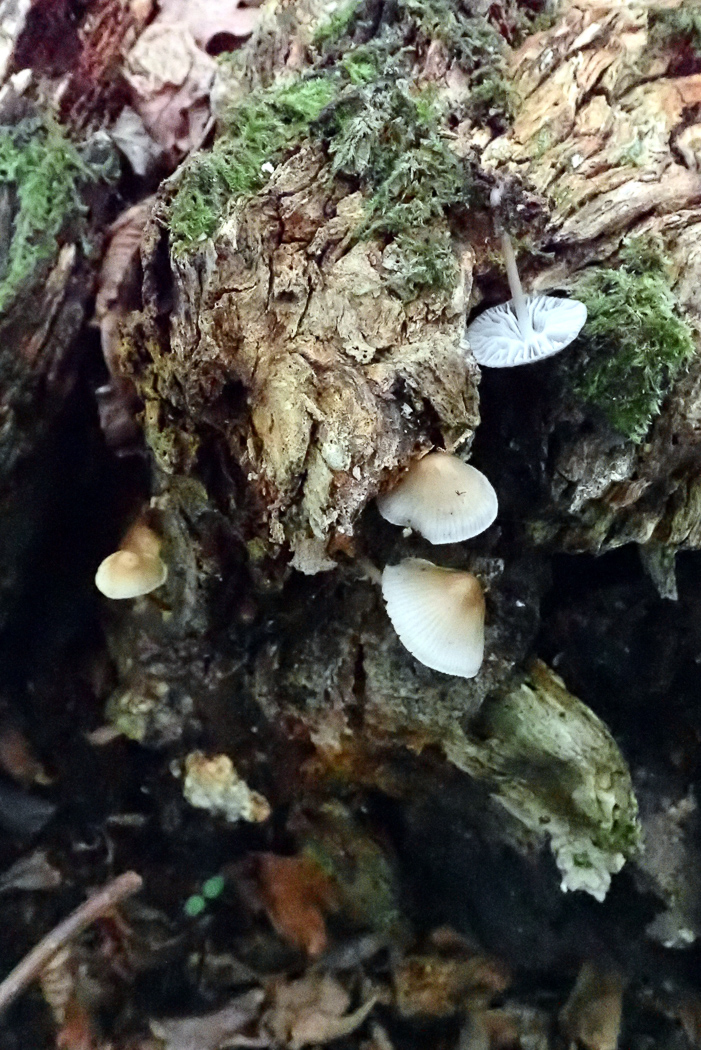
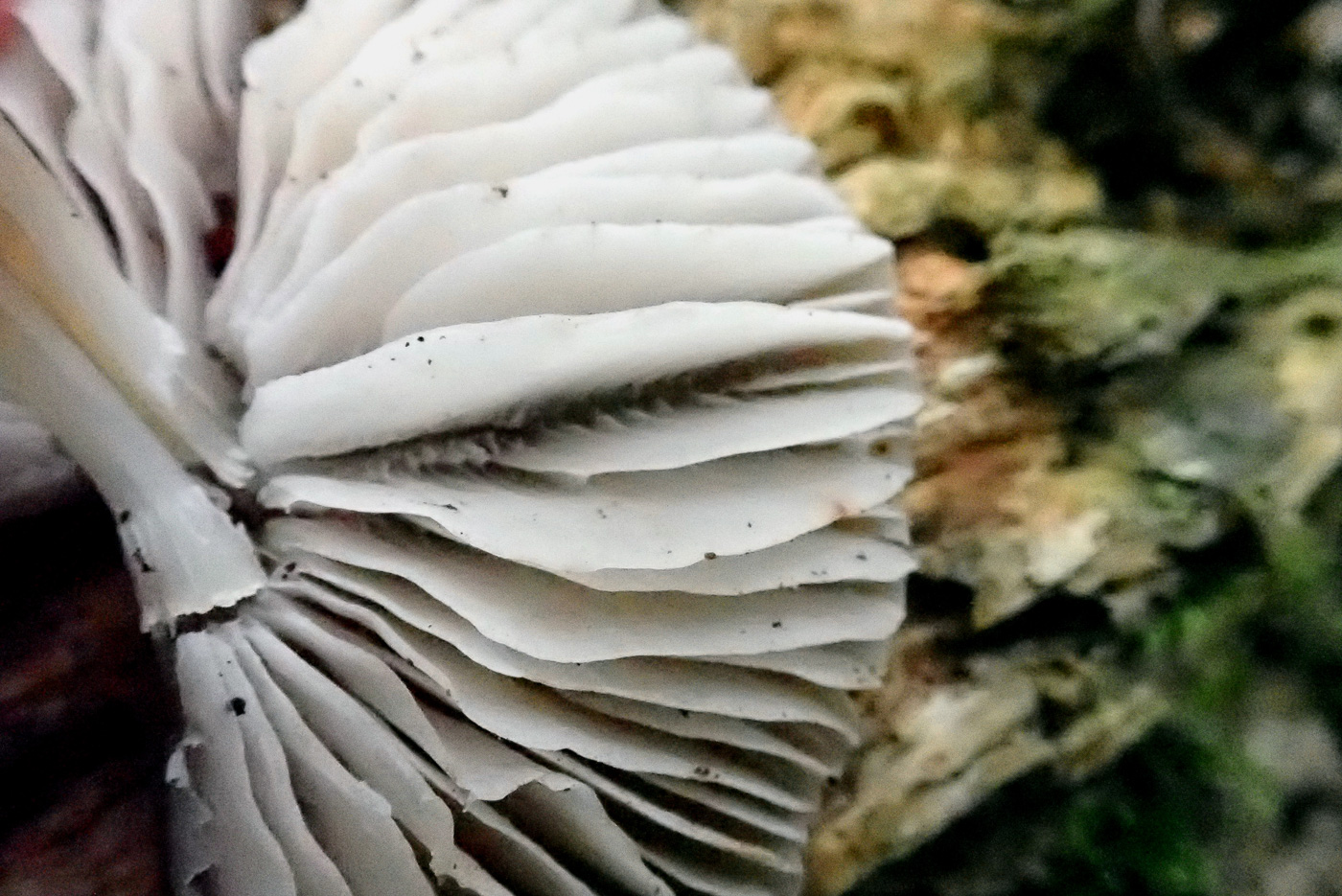
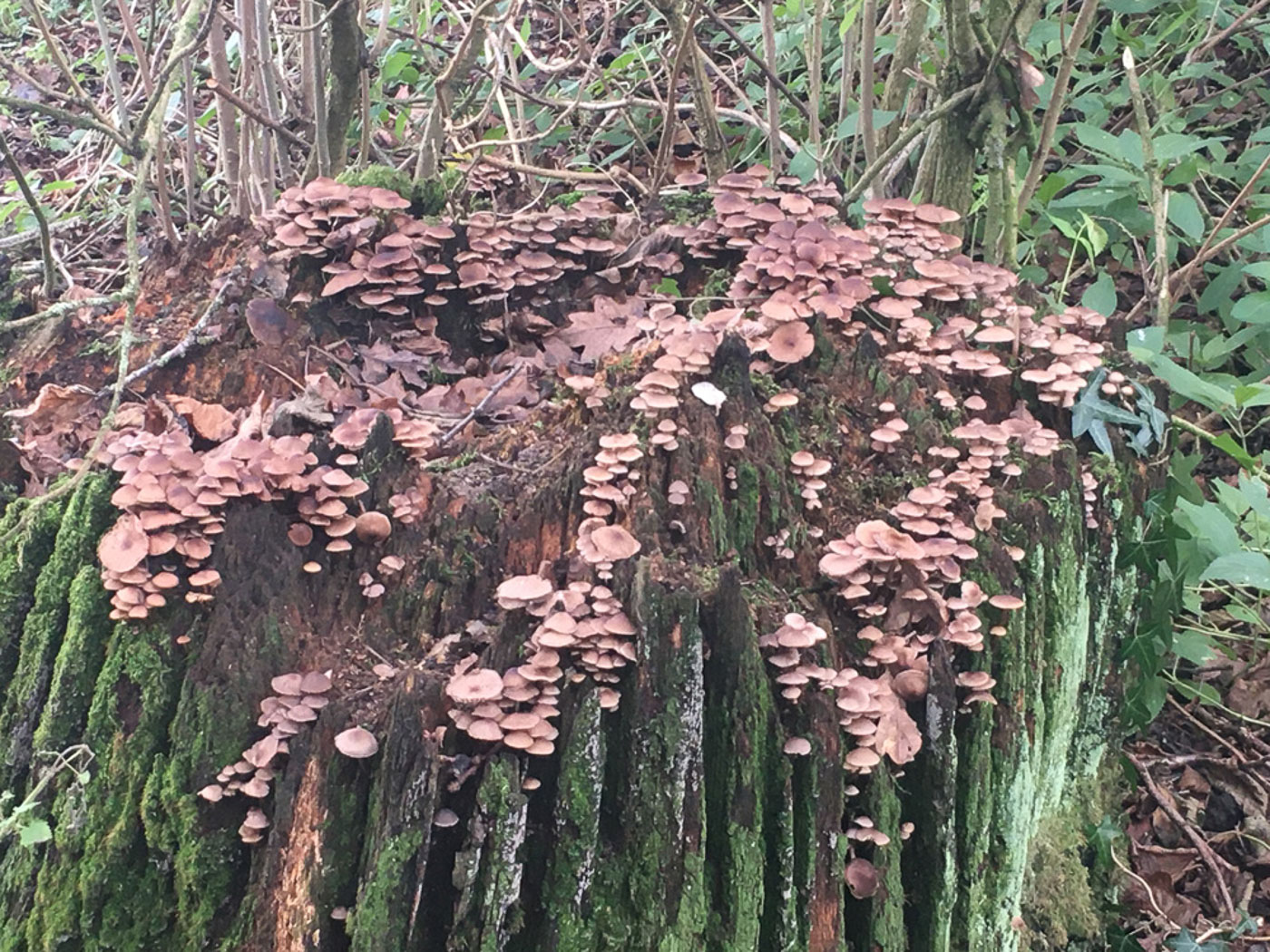
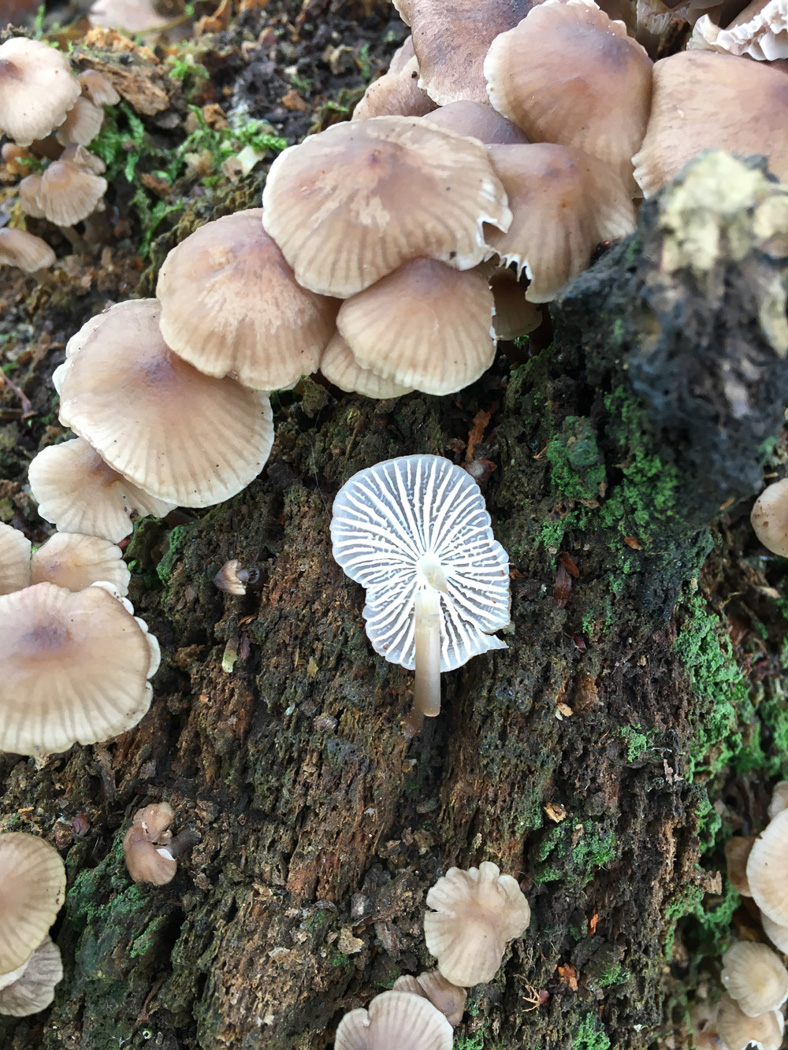 |
January 3rd Mycena galericulata (Common Bonnet)
This was the second unseasonal species of Bonnet Penny found in Rushbeds Wood - this one growing on a deciduous stump and recognisable in the field. Photo 2 shows the largest cap upturned and the gills opened out to reveal the telltale cross-ridges (galleries) which confirm the species. It is a large grey-brown capped Bonnet found only on deciduous wood on which it is firmly rooted - on collection one nearly always snaps the stem base off as a result. Photos 3 and 4 were sent in by Joanna Dodsworth from Brill Common, found on the same day (and only a mile away!) and rather putting Penny's photos in the shade - what a bumper crop!
|
January 1st 2022

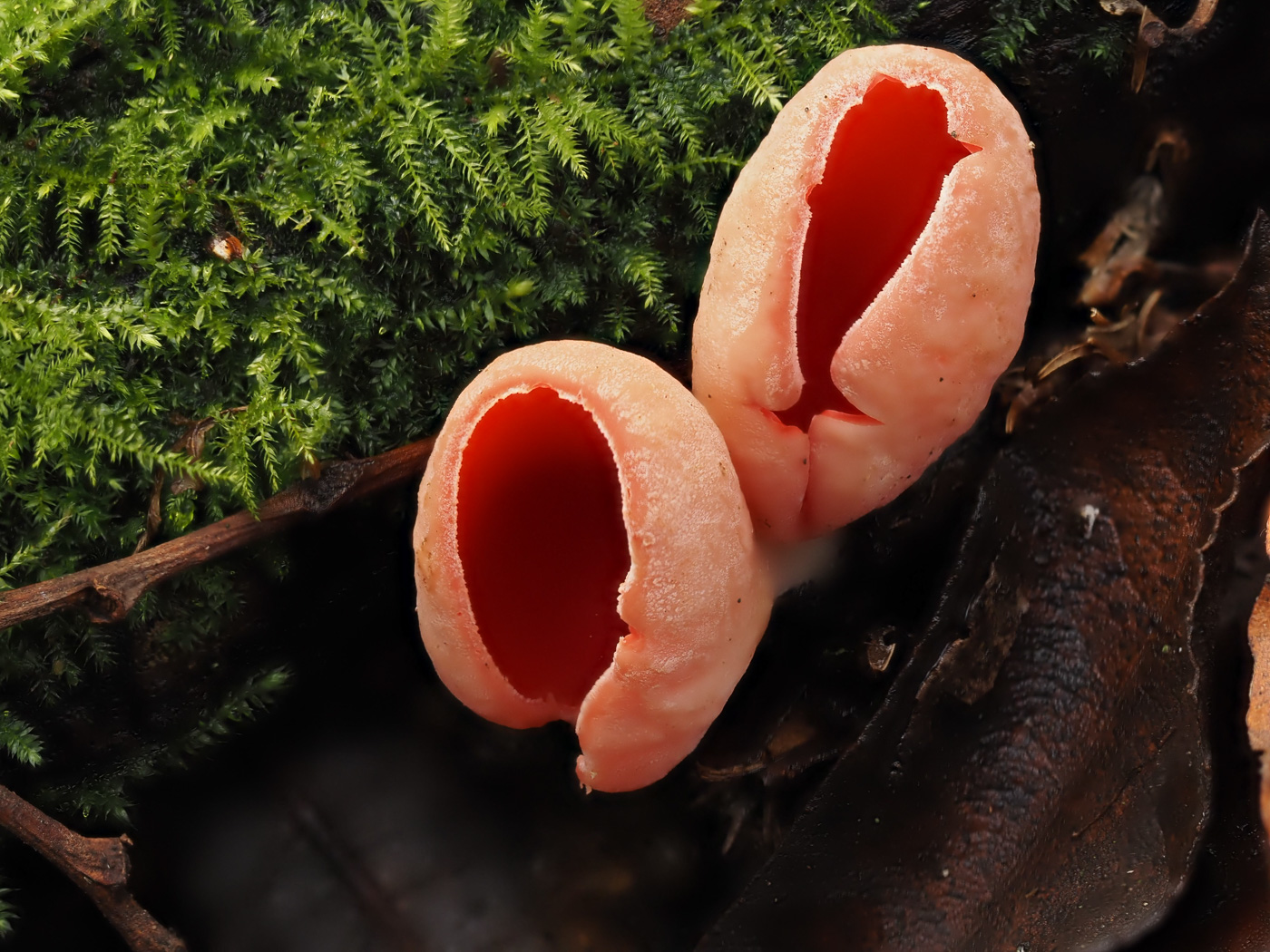
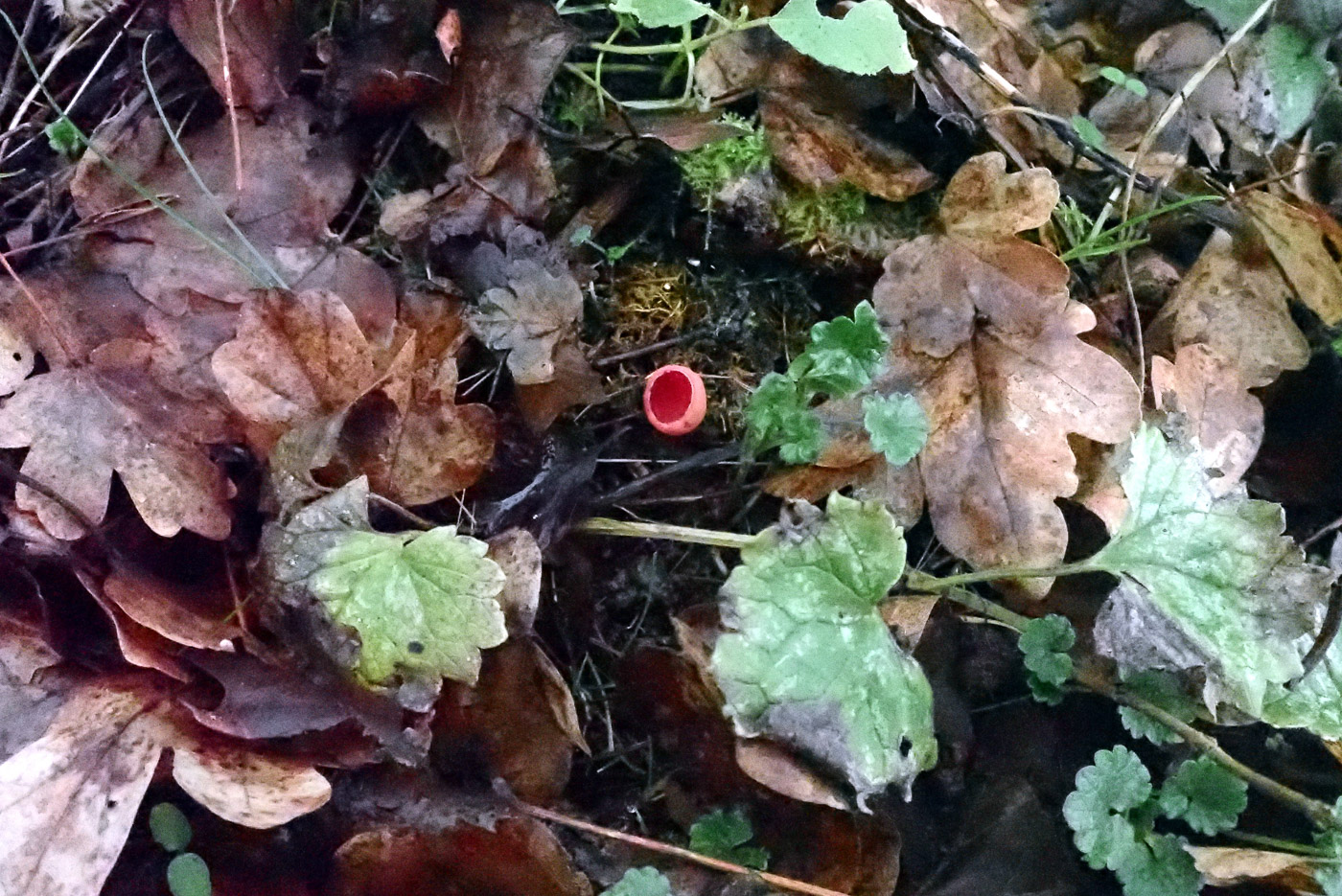 |
January 1st Sarcoscypha austriaca (Scarlet Elfcup)
The perfect way to start off our 2022 photos! On New Year's Eve Claire Williams noticed this little beauty just opening out on fallen rotting deciduous wood in Downley Common (photo 1), then went back today to check various other spots in Downley where she's seen this species in previous years. She reports 13 sightings! Photo 2 was the best of them. This is a typical springtime Cup Fungus and one which is easy to recognise too, so is certainly one to be looking out for now in damp deciduous woodland, particularly on fallen Willow where the wood is in contact with the soil. Penny is not surprised it's around now, having found signs of it starting (tiny little 'buds' of pink) back in November on our walk at Rushbeds - another regular site for it. If ever there was proof of the value of getting to know your local patch where many species reappear year after year, this is surely it! (Photo 3 is of a tiny specimen just emerging in woody litter, taken by Penny in Rushbeds Wood on Jan 3rd.)
|
 |
January 1st Arrhenia retiruga (Small Moss Oysterling) 
In her mossy lawn at home in Brill Joanna found good numbers of this unusual species which seems to be having a bumper fruiting season. For more see Finds dated Dec 3rd.
|
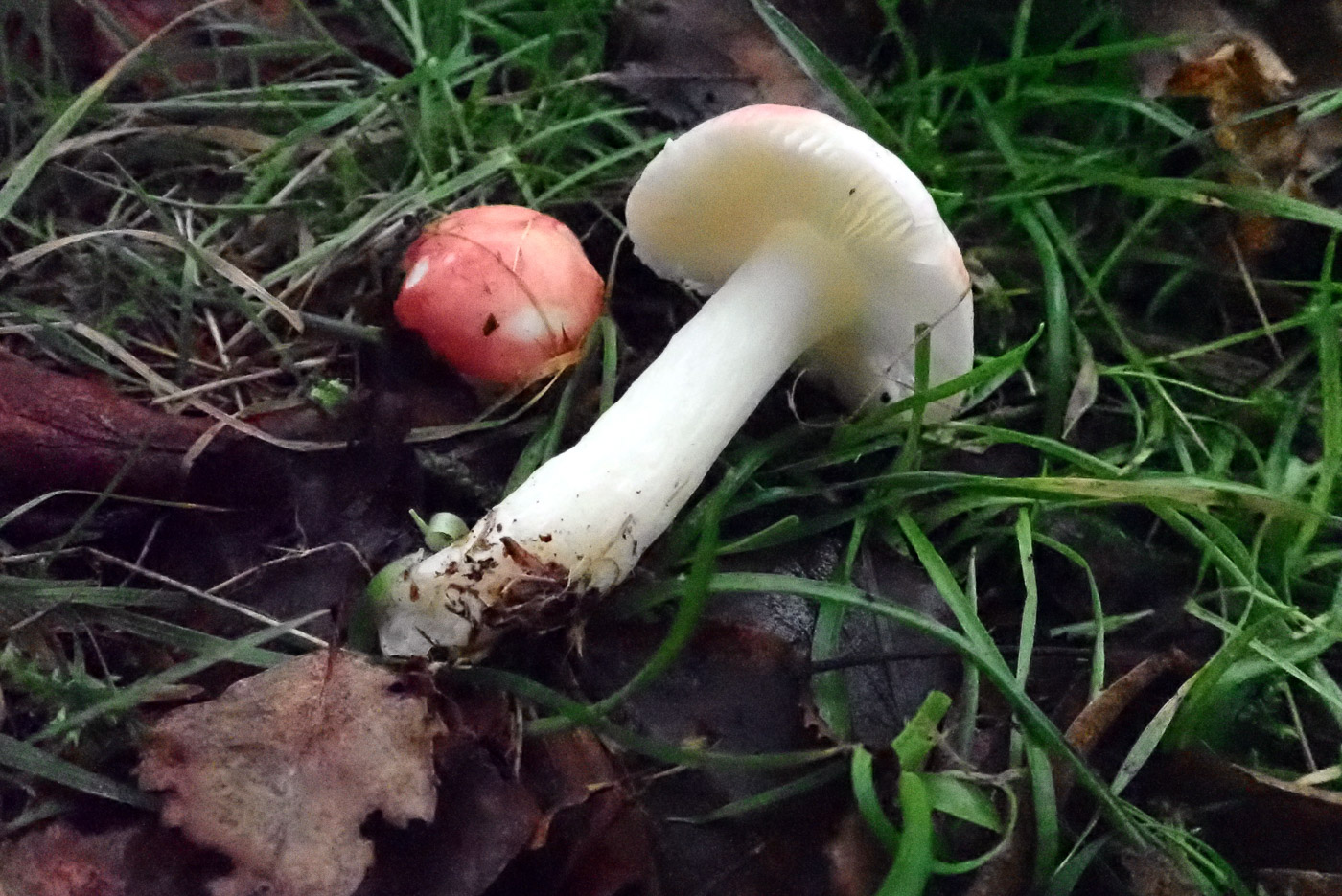 |
January 1st Russula betularum (Birch Brittlegill)
At Turville Heath in grassy litter under Birch Penny was somewhat surprised to find this species fruiting so late in the season - in fact this was her first January Brittlegill that she can remember! For more see Finds 2021 dated Sept 1st and Nov 13th.
|

 |
January 1st Strobilurus esculentus (Sprucecone Cap) 
Under a large Spruce at Turville Heath Penny found just the one specimen of this rather Mycenoid species which can mislead. One look at the very distinctive gill cells is enough to confirm its identity, however. For more see Finds 2021 dated Nov 13th.
|

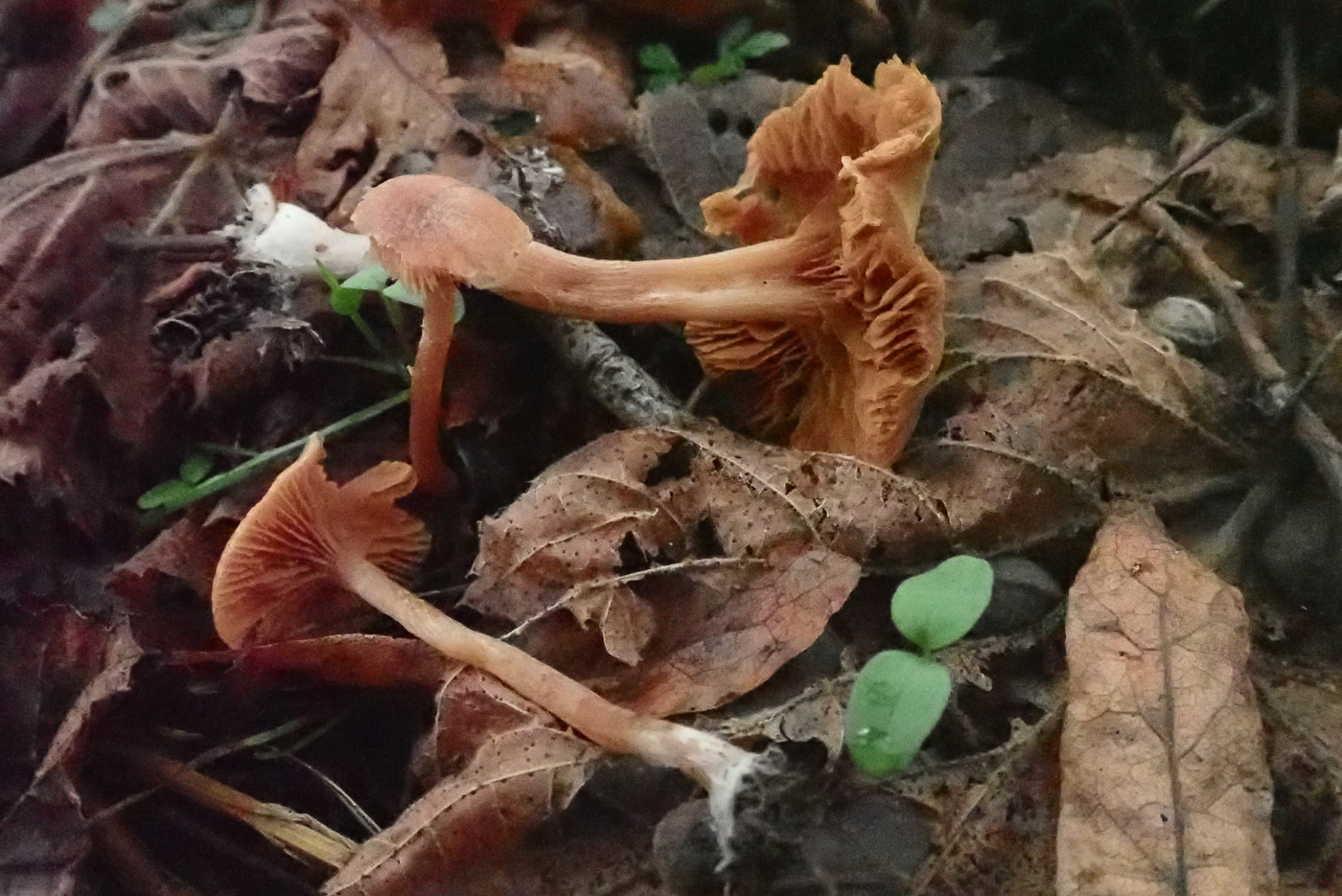 |
January 1st Tubaria furfuracea (Scurfy Twiglet)
Under various deciduous trees in woody litter at Turville Heath Penny found several specimens of this common little LBJ which often confuses people. For more see Finds 2020 dated Oct 3rd.
|
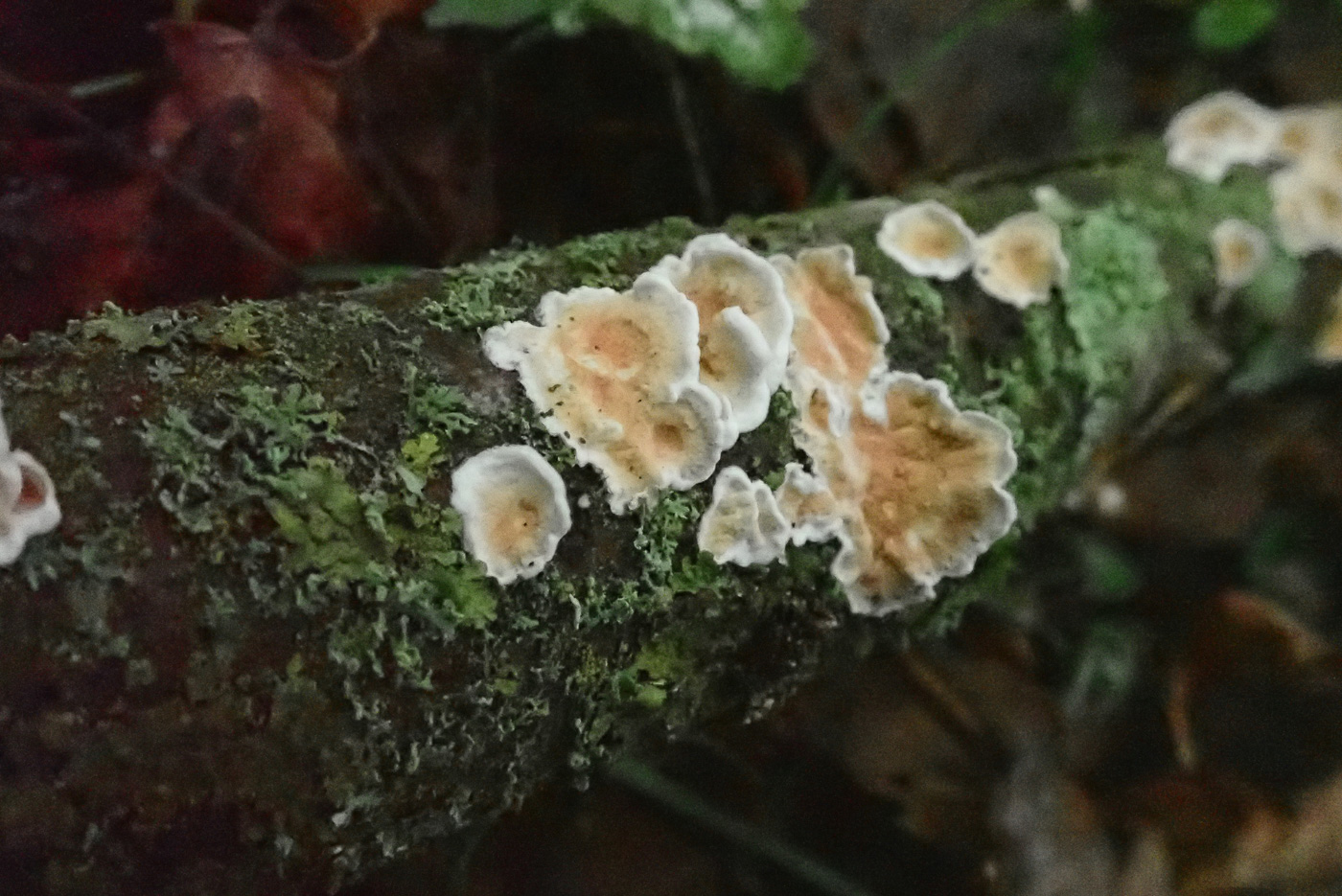
 |
January 1st Cylindrobasidium laeve (Tear Dropper) 
On a fallen deciduous stick at Turville Heath Penny noticed this brightly coloured Corticioid patch which looked to her similar to maybe Stereum rameale or S. rugosum. However, noting that it didn't redden when damaged eliminated the latter, then noting that it peeled readily away from its substrate suggested this species rather than the other Stereum. At home the large tear-drop-shaped spores confirmed it. The white margin of this very common Corticioid is another typical feature to look for in the field.
|
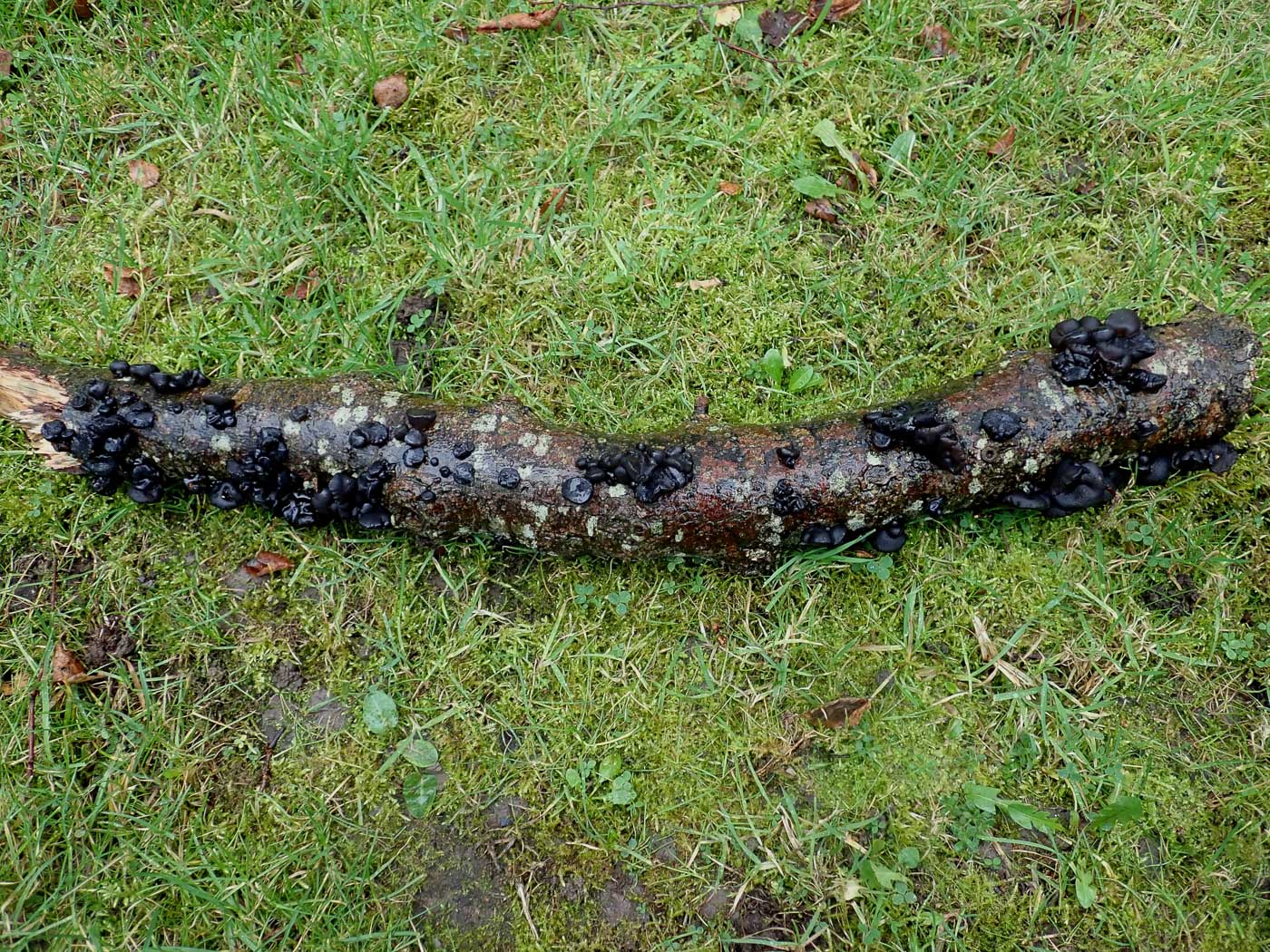
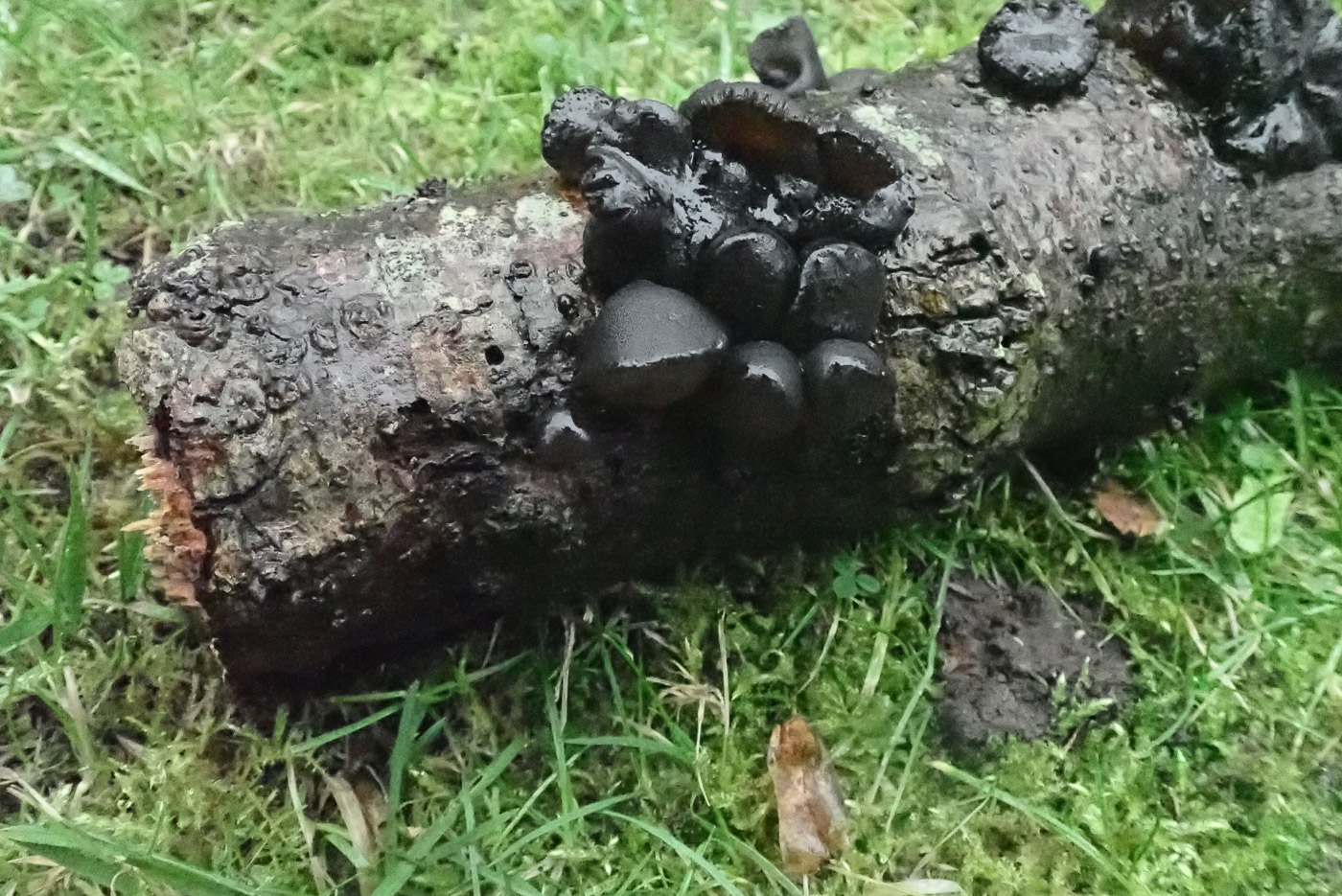 |
January 1st Exidia glandulosa (Witches’ Butter) 
On fallen Lime branches at Turville Heath Penny found good numbers of examples of this black jelly-like species. She checked that the black did not stain her finger when the top surface was rubbed - a pointer to the similar but unrelated Bulgaria inquinans which is an Asco rather than a Basidiomycete as here - then noted the finely bumpy undersurface which is a feature of both this species and the very similar E. plana - often confused with it. Then at home the larger spores of this particular species confirmed the determination.
|
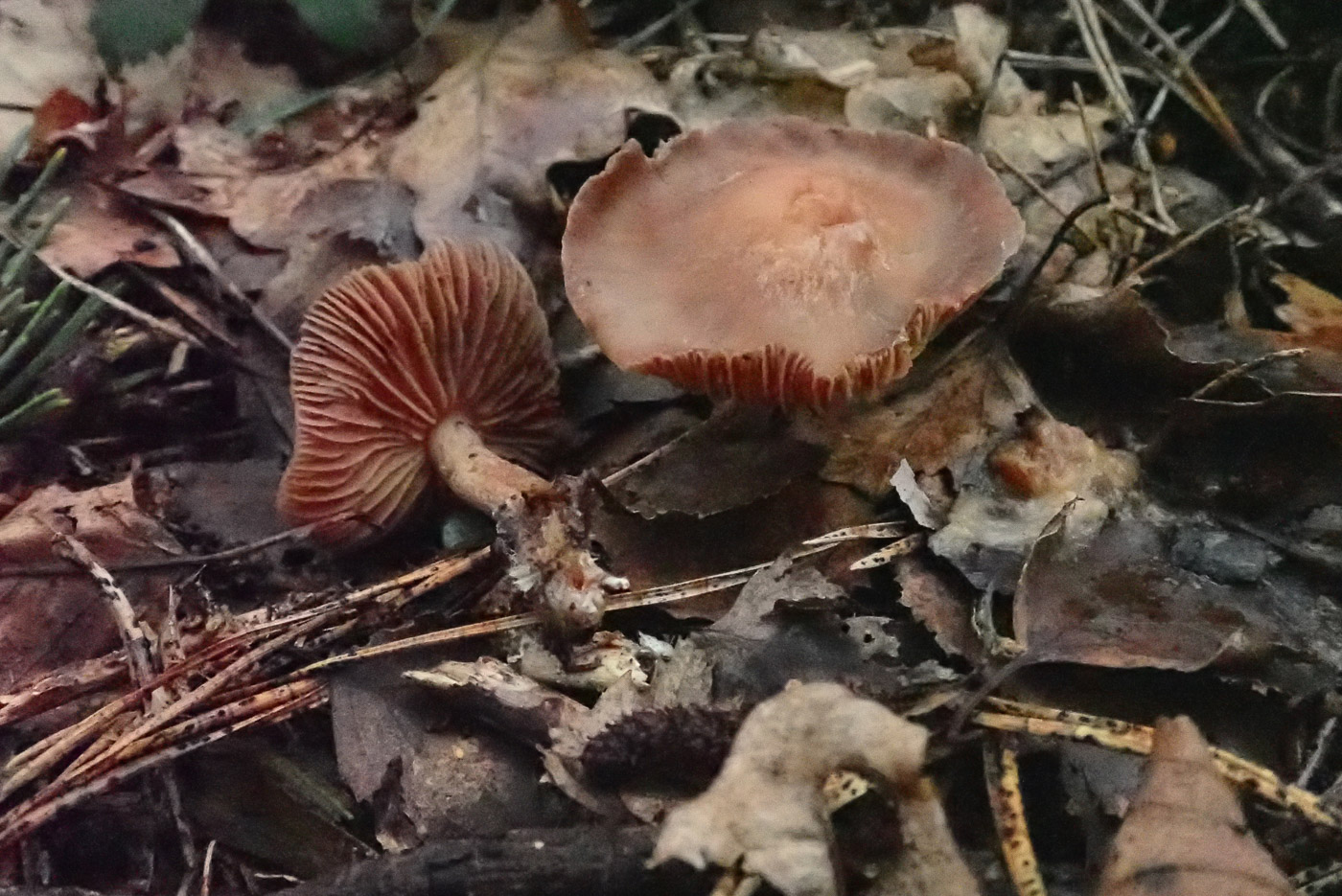 |
January 1st Gymnopus peronatus (Wood Woollyfoot)
At Turville Heath Penny found these two rather past-their-best specimens still fruiting under the same Pine where she took a previous photo. For more see Finds 2021 dated Nov 13th.
|
 |
January 1st Rhodocollybia butyracea (Butter Cap)
At Turville Heath in grassy litter under Birch Penny found just this one rather atypical clump and was in doubt as to its identity till she felt the greasy cap surface and saw the white gills with the correct attachment for this common late season species. For more see Finds 2021 dated Nov 13th.
|

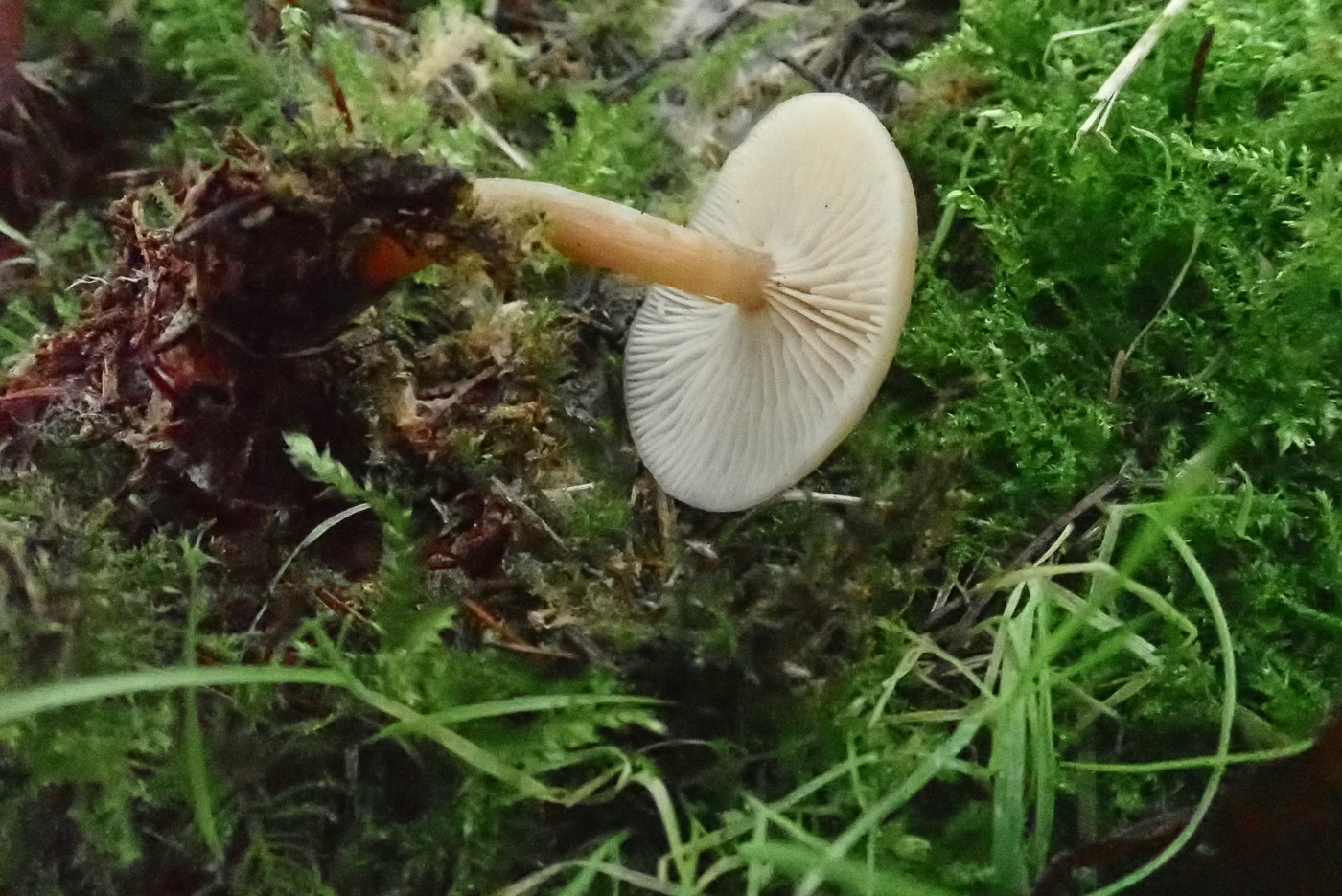
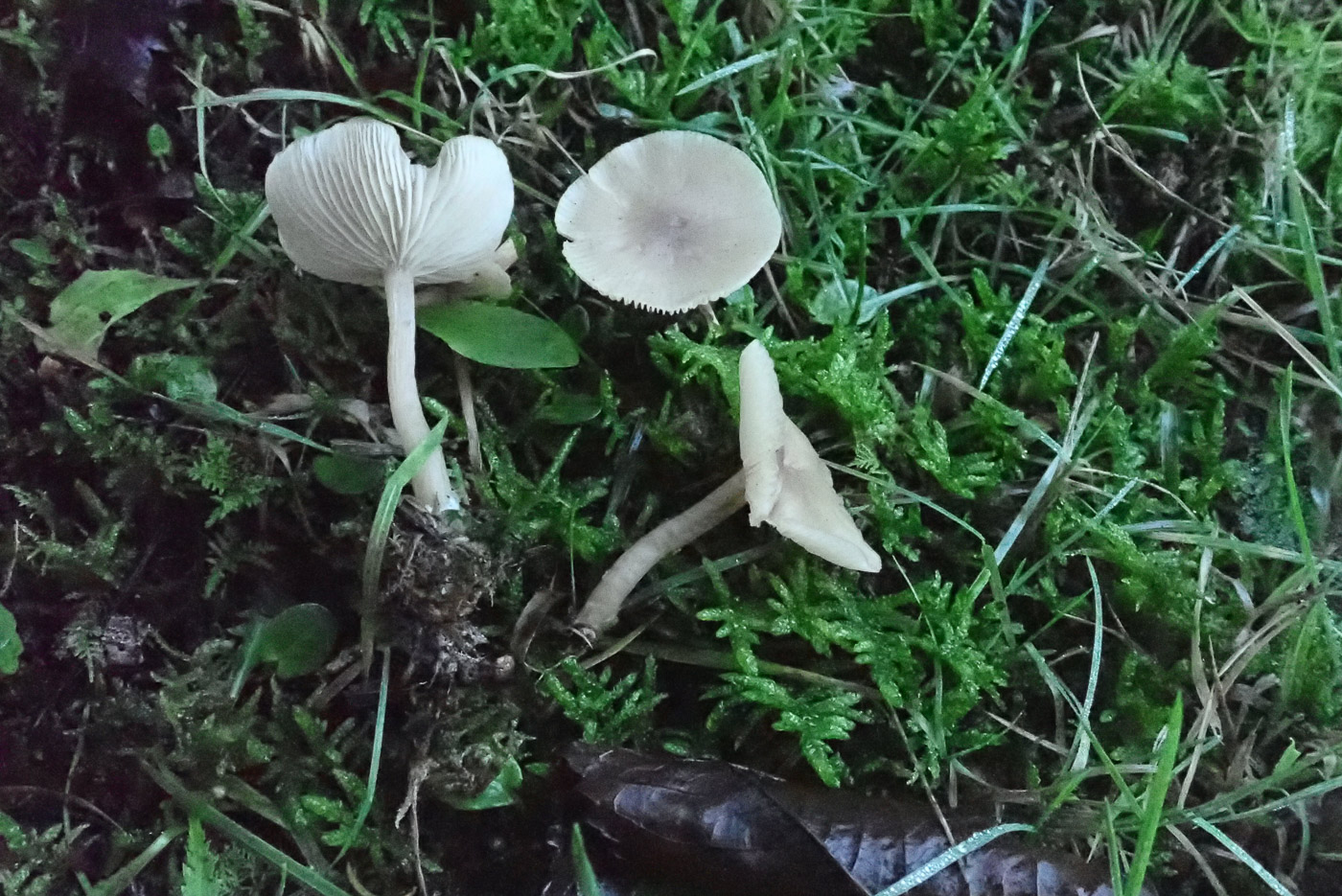 |
January 1st Clitocybe fragrans (Fragrant Funnel)
Penny found quite a few examples of this common Funnel still fruiting (and still smelling sweet) at Turville Heath in grassy litter under mixed deciduous and conifer trees. Photo 3 is of a yet further collection made by Penny and Sarah Ebdon on Jan 12th at Lacey Green Churchyard. For more see Finds 2021 dated November18th.
|
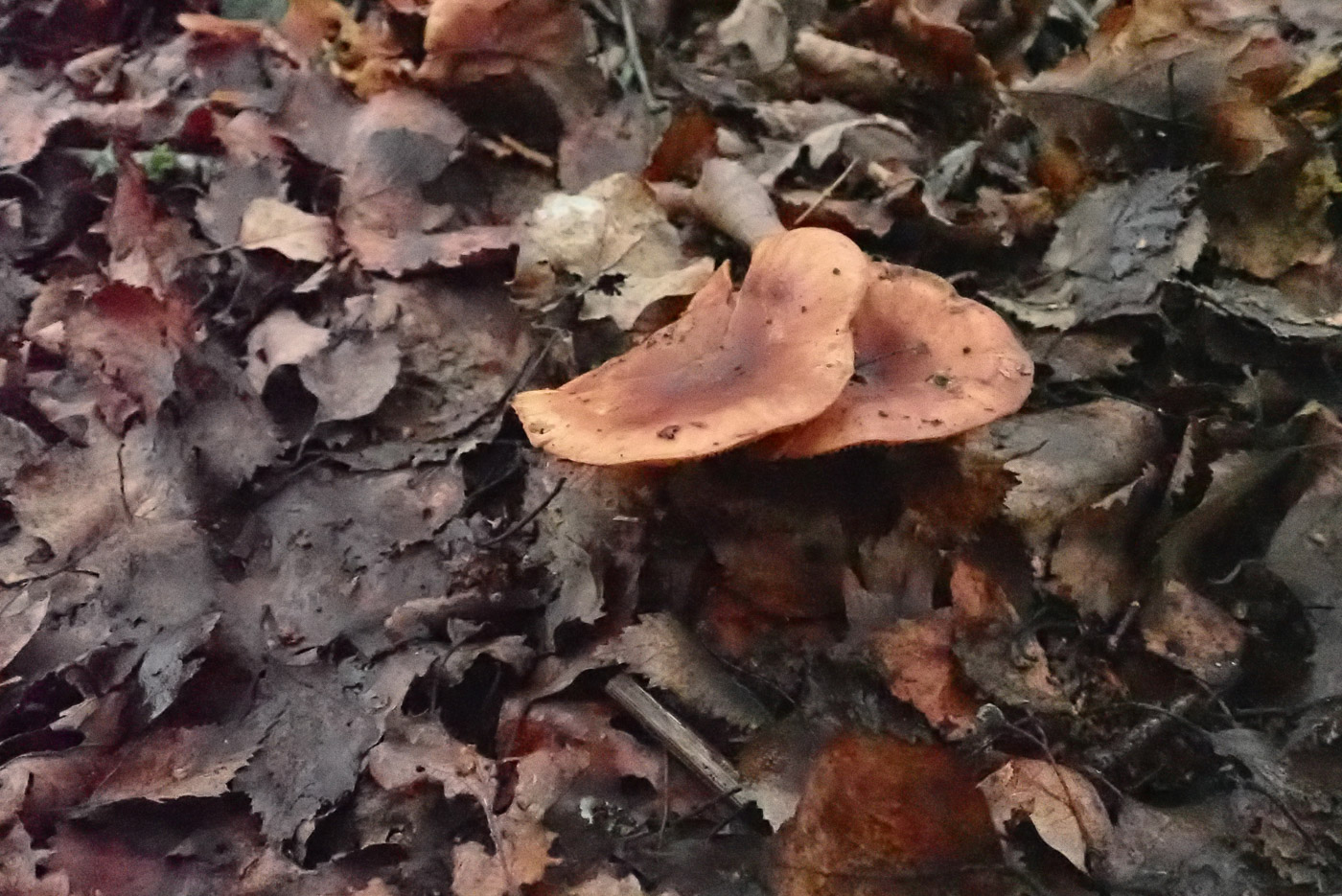
 |
January 1st Paralepista flaccida (Tawny Funnel)
Under the same Birch where Penny found it previously at Turville Heath, this species (more familiar as Lepista flaccida) was still fruiting and recognisable today. For more see Finds 2021 dated Nov 13th.
|
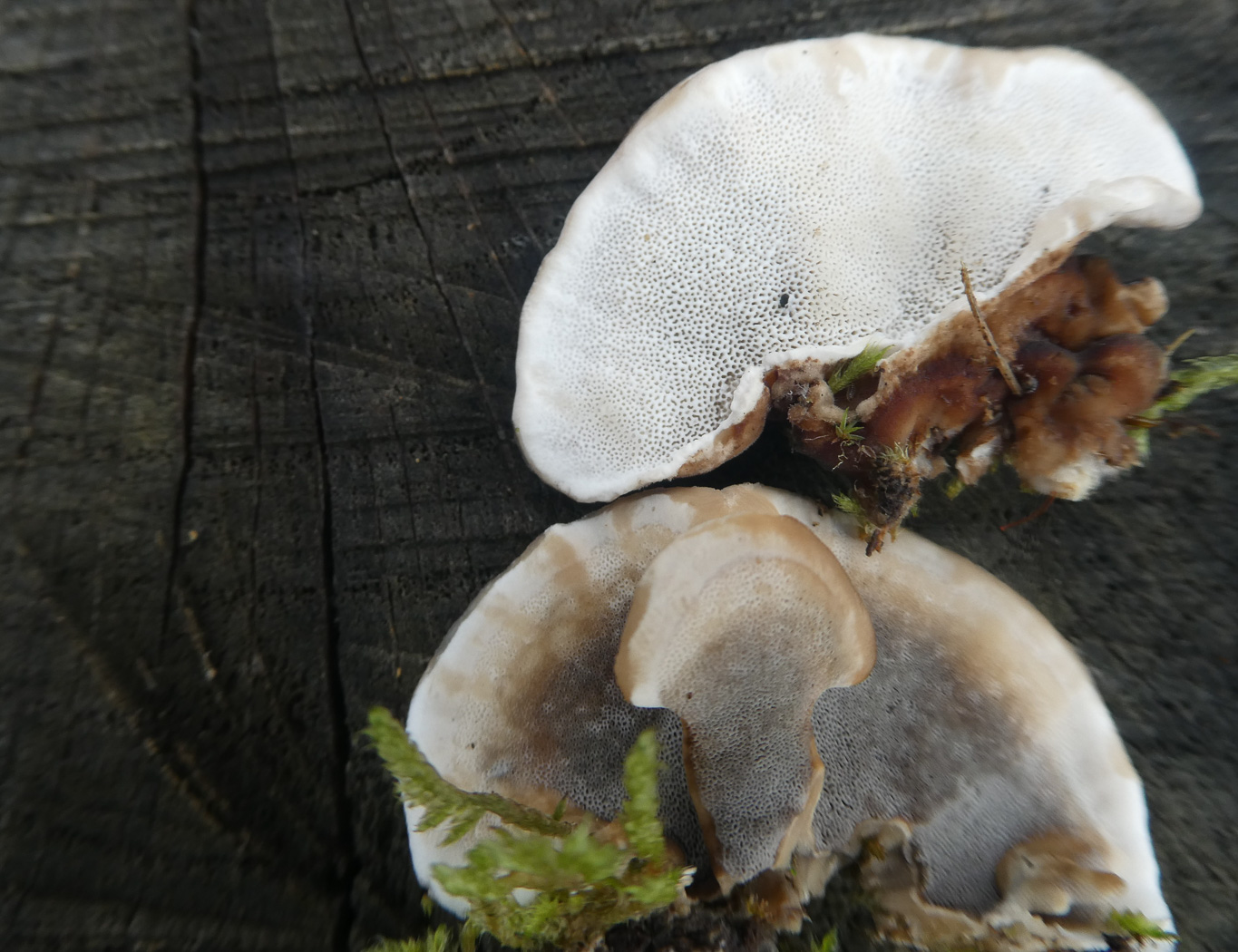 |
January 1st Trametes versicolor versus Bjerkandera adusta (Turkeytail versus Smoky Bracket)
On fallen Oak at Stoke Common Jim Wills noticed these two species quite close together and was able to make a comparison of their pored surfaces underneath - this being the best way to tell them apart as their top surfaces can look extremely similar. Above is the plain creamy white finely pored undersurface of T. versicolor and below is the equally pored but grey undersurface of B. adusta showing its diagnostic white rim. The third species which is equally common to these two and can look very similar above is Stereum hirsutum, but this has an almost smooth orange underside.
|
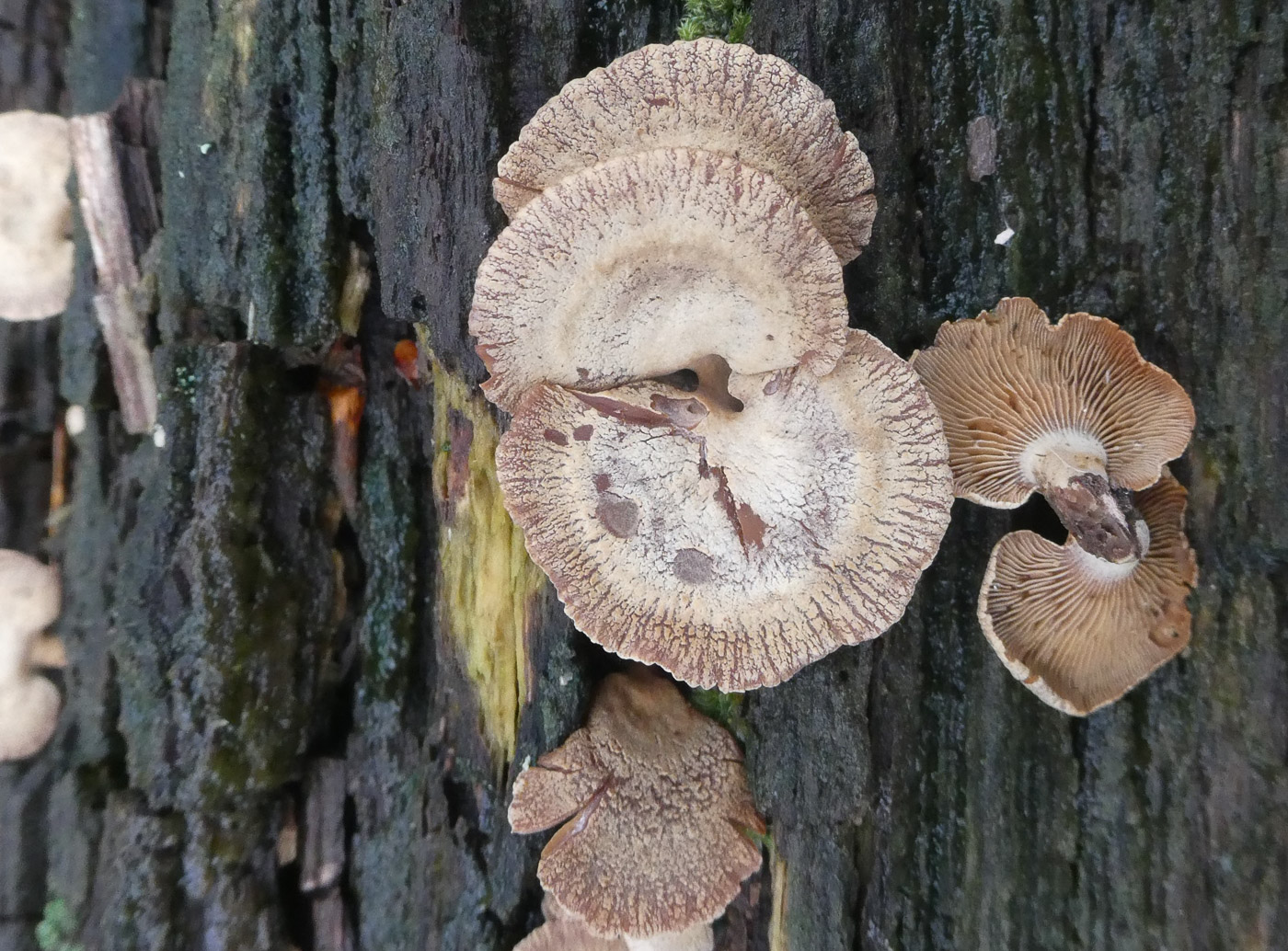 |
January 1st Panellus stipticus (Bitter Oysterling)
On a deciduous log at Stoke Common Jim Wills found this small bracket-like species which has gills but an eccentric stem. See Finds 2020 dated Oct 3rd, also 2021 dated Nov 17th & Dec 22nd for more notes and images.
|
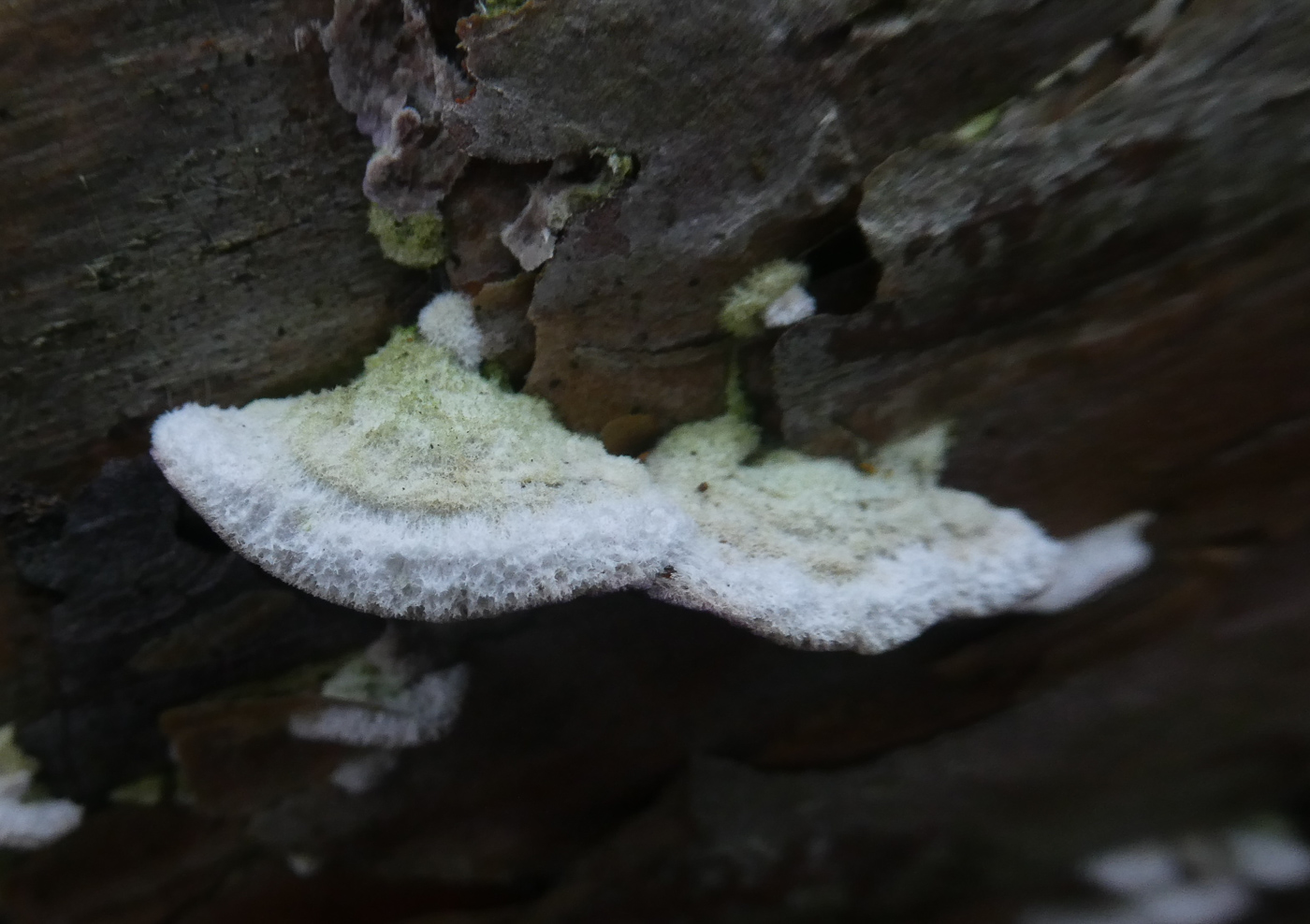
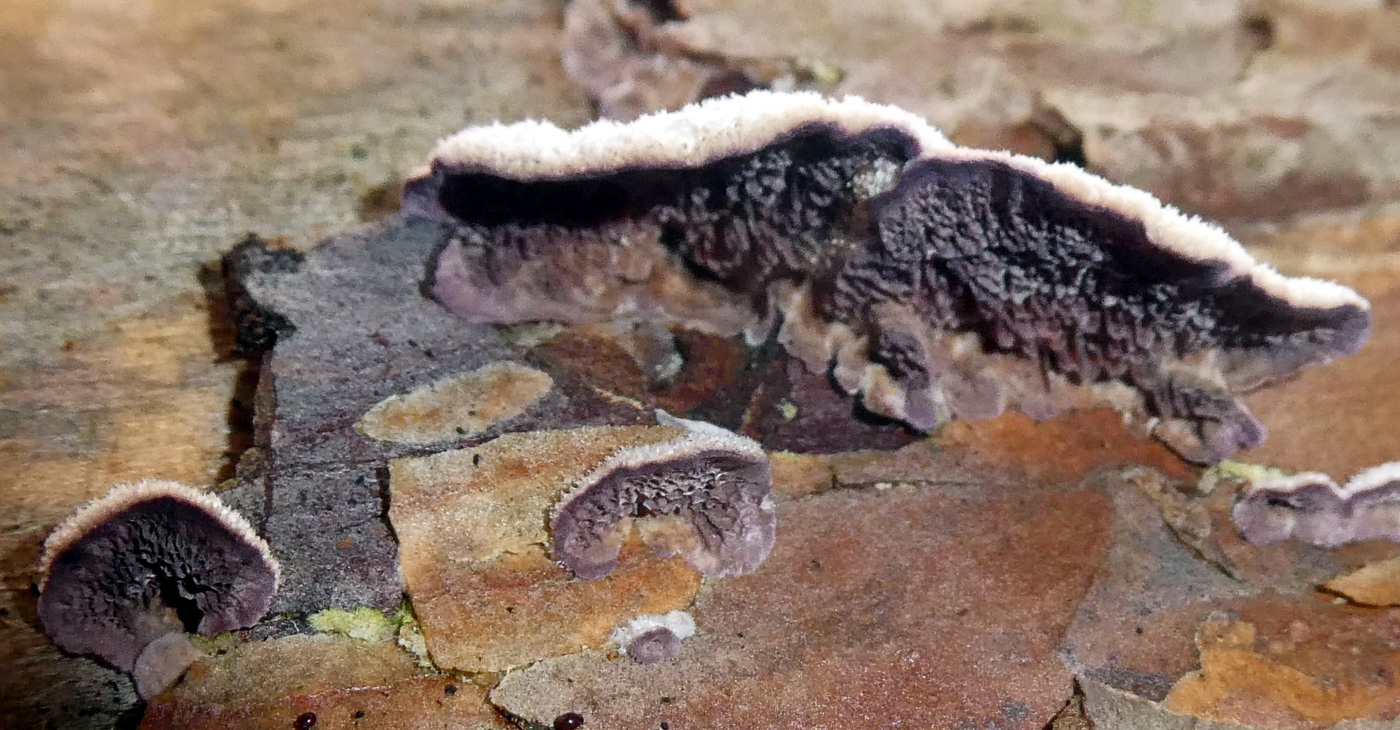 |
January 1st Trichaptum abietinum (Purplepore Bracket)
At Stoke Common Jim Wills found this common small bracket which grows on fallen conifer. See Finds 2020 dated Nov 7th for more notes and images.
|
![]() Only entries marked with this symbol have been microscopically examined. There is no guarantee on identifications made of entries lacking this symbol though all photos are checked and selected by Penny to the best of her ability. Basic accompanying notes are also Penny's.
Only entries marked with this symbol have been microscopically examined. There is no guarantee on identifications made of entries lacking this symbol though all photos are checked and selected by Penny to the best of her ability. Basic accompanying notes are also Penny's. ![]() Entries marked with this symbol have been confirmed or identified using DNA sequencing.
Entries marked with this symbol have been confirmed or identified using DNA sequencing. 










